The ∄ Project
Chronicles of Forbidden Science: Unraveling the Enigma - A collection of specimens from a secret genetic odyssey in Project ∄. Hidden in the annals of history, these scientific marvels defy explanation and test the boundaries of knowledge and morality. Join the scientist's quest into the unknown, where science and mystery converge.
{ai image stories home}-sequence0.11
The inaugural revelations of Project ∄ emit an unsettling resonance, as initial sketches reveal entities that blur the line between the mechanical and the biological. These illustrations, meticulously annotated, are the precursors to a potential revolution or a grave transgression. As the scientist's hand guides the pencil, there's a tremor of hesitation—a silent query of whether this path honours the sanctity of life or heralds its unmaking. With every sinew sketched and every circuit defined, the question looms: Are we the creators of life or the architects of monstrosities?
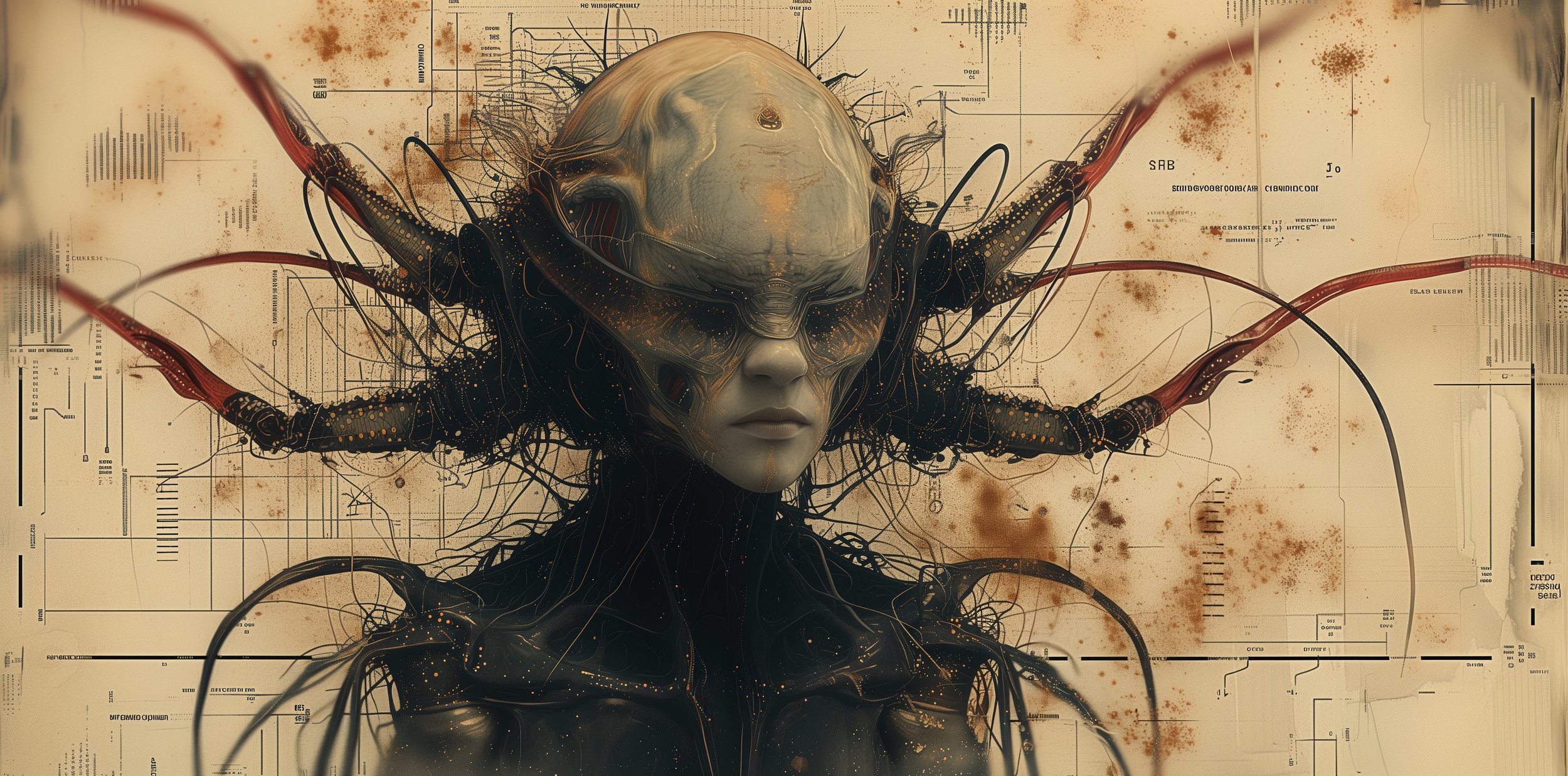
Experimental Note 005 – Cerebral Synaptic Interface and Sensory Expansion
The fifth specimen provides an extraordinary display of cerebral enhancement and sensory extension. The cranium is enveloped in a high-density synaptic interface mesh, indicating potential for vastly increased neural connectivity. Elongated appendages radiate outward, featuring arrays of micro-sensors that suggest a sensory input mechanism far exceeding typical human capacity. These appendages, resembling both neural dendrites and precision-engineered cabling, could serve to integrate environmental data directly into the central nervous system. The bio-synthetic skin overlaying the skull has a translucency that could indicate adaptive camouflage capabilities or a protective layer for the sensitive technology underneath. The implications of such a being involve a leap into sensory perception beyond the current limits, offering a tantalizing glimpse into the future of human evolution, should such frontiers be breached by biotechnological exploration. ∄
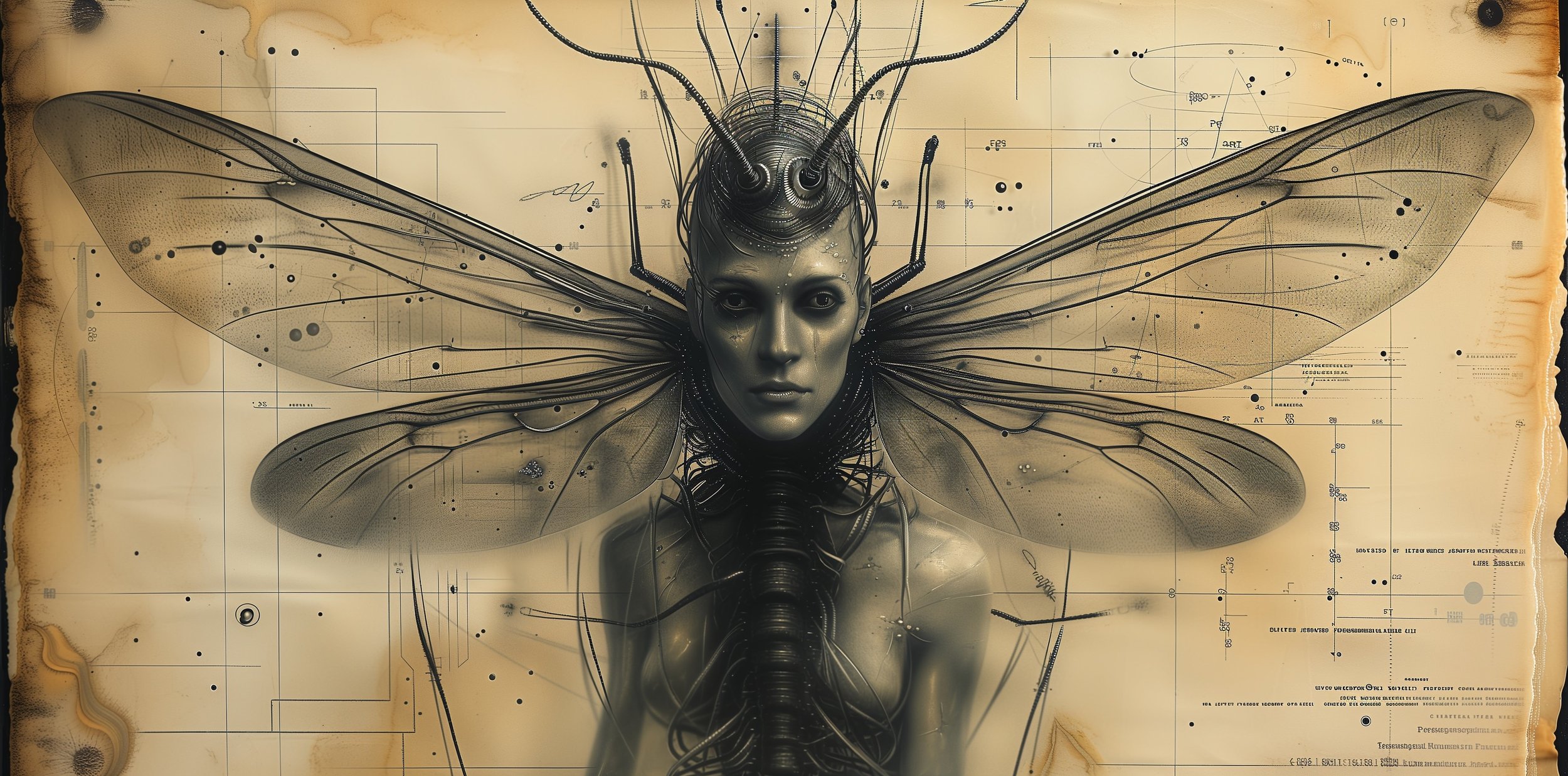
Experimental Note 006 – Biomimetic Aeronautics and Sensory Integration
The sixth profile depicts a specimen that encapsulates the zenith of biomimetic aeronautics paired with heightened sensory integration. The wings are a masterwork of bioengineering, mimicking the ultra-lightweight and resilient structures found in natural insect wings, yet clearly infused with synthetic materials for added strength and functionality. Antennae-like structures, adorned with spiraling nodes, rise from the scalp, suggesting a complex array of sensory reception and possibly signal transmission capabilities. The thorax, a fusion of sculpted organic musculature and mechanical support, gives rise to speculation about the potential for powered flight. The presence of such a specimen, were it to be more than theoretical, would represent a monumental leap in synthetic biology, embodying the elegance of natural evolution with the precision of technological innovation. The concept of such entities pushes the boundaries of bioethics and challenges our preconceptions of life's diversity. ∄

Experimental Note 001 – Hybrid Vigor in Bio-Mechanical Symbiosis
Upon preliminary analysis, the specimen presents an intricate fusion of organic and inorganic components. The exoskeletal framework is laced with a biopolymer matrix, suggesting a sophisticated integration that transcends contemporary bioengineering. Notably, the wing structures exhibit a complex interplay between natural and synthetic fibers, creating a paradoxical harmony of flight-capable mechanics and biological tissue. The facial morphology retains humanistic features yet is interwoven with biomechanical augmentation, raising profound questions about the ethics of genetic splicing and the limits of human enhancement. The specimen epitomizes the zenith of clandestine research, where the melding of technology and biology could herald a new era of evolutionary advancement. The potential applications and implications of such a being, were it to exist, would challenge the very fabric of natural law and ethics, marking a tipping point in the human understanding of life itself. ∄
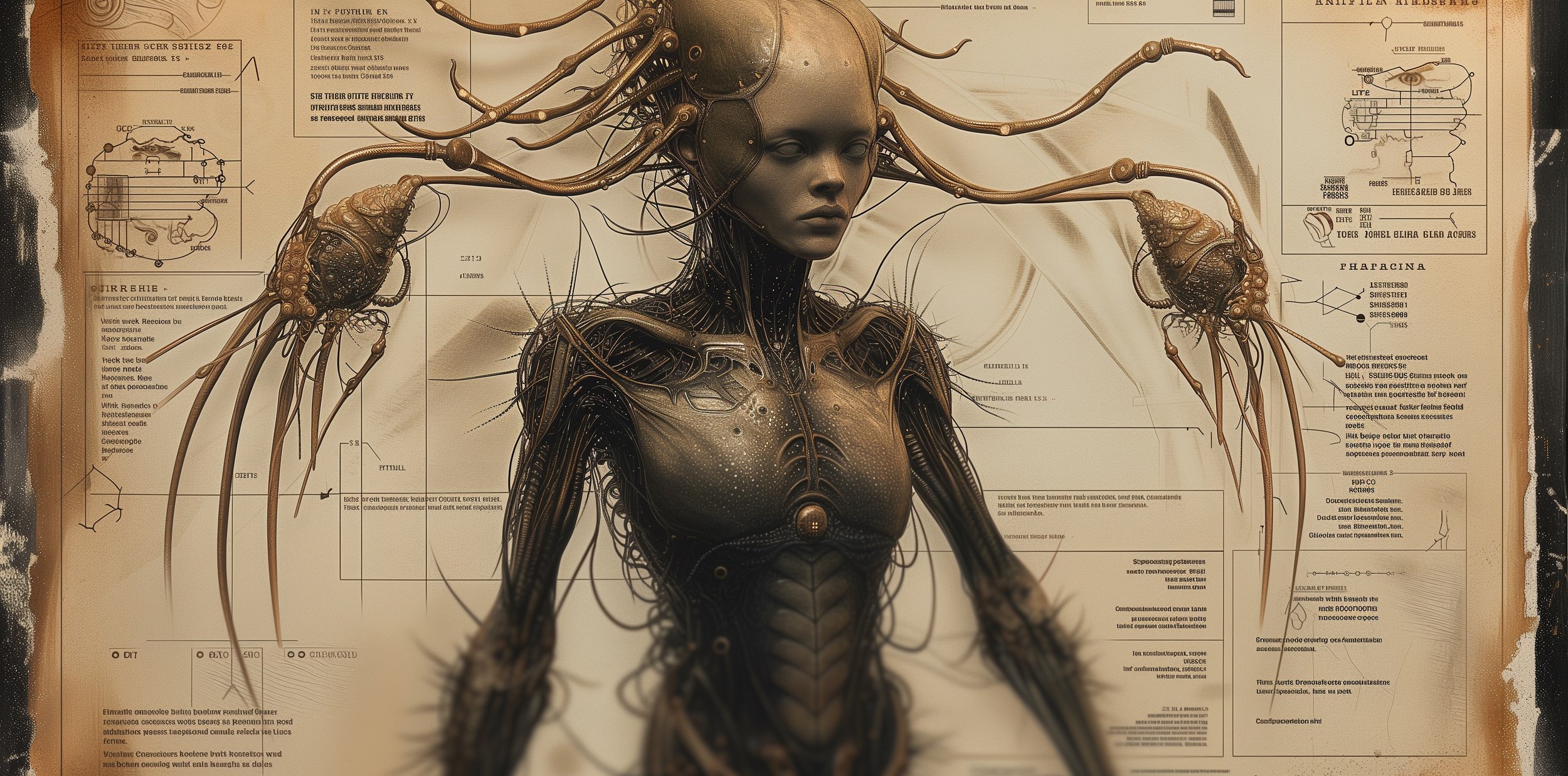
Experimental Note 002 – Bio-mechanical Convergence and Fluid Dynamics
The subject exhibits an advanced integration of organic tissues with a cybernetic support structure, displaying features that suggest a radical departure from traditional biological constructs. Central to its design is a thoracic cavity reinforced with an alloy lattice, possibly for enhanced structural integrity. Tentacle-like appendages extend from the cranial and shoulder regions, each terminating in intricate articulations that resemble both biological extremities and precision-engineered machinery. The subject's physiology incorporates a liquid circulatory system that appears to double as a hydraulic mechanism, implying a dual function in nutrient transport and movement facilitation. This seamless blend of biomechanics poses significant implications for the future of synthetic life forms, blurring the lines between the organic and the artificial. Such a synthesis hints at a broader agenda, potentially uncovering the vast, untapped potentials of life as we know it. ∄
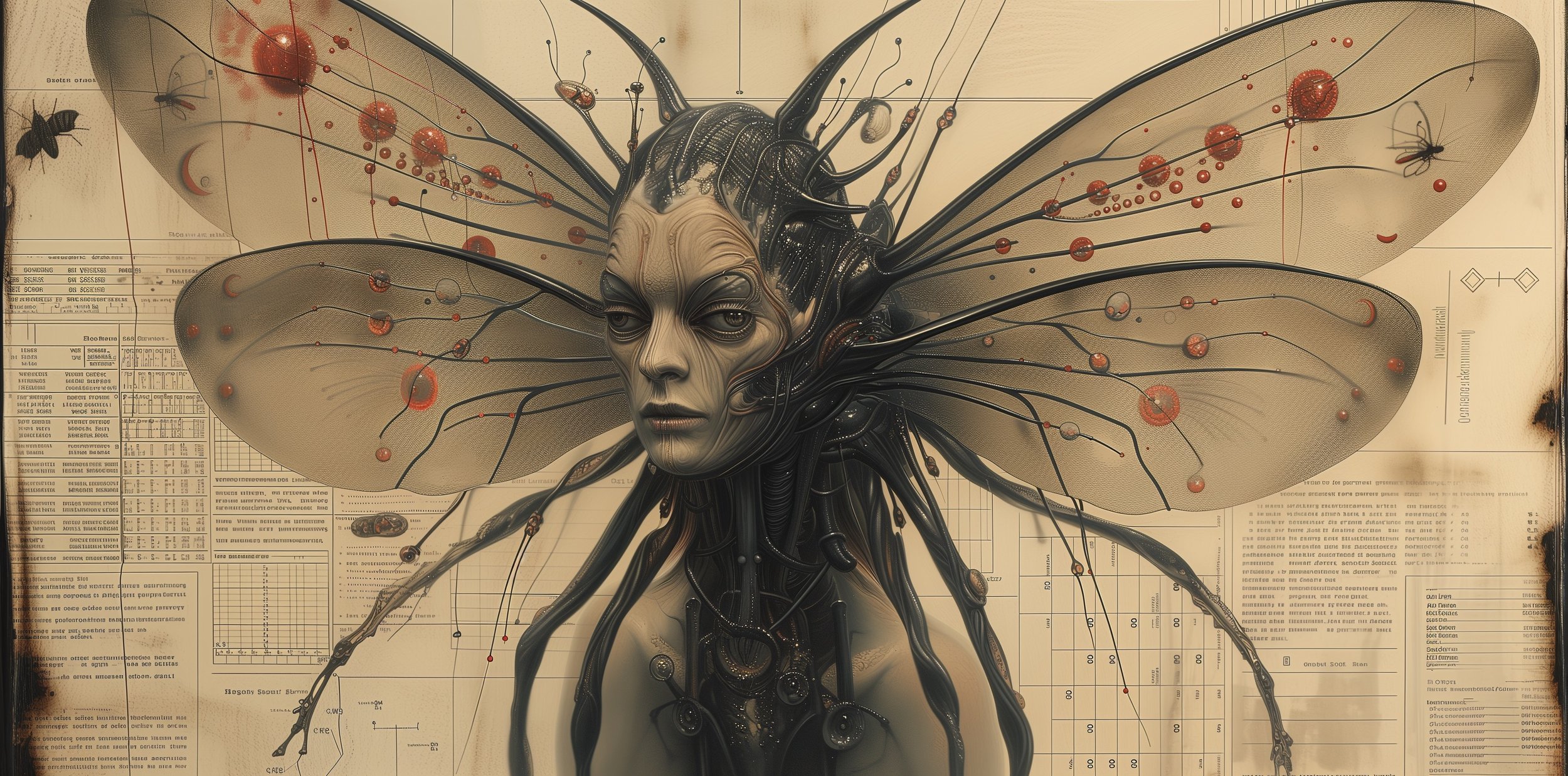
Experimental Note 003 – Synthesis of Lepidopteran and Neural Circuitry
This specimen showcases an extraordinary amalgamation of lepidopteran characteristics with human neural architecture. The wings are a marvel of bioengineering, containing vascular structures that suggest a capacity for both circulation and signal transduction, resembling a printed circuit board in complexity. Embedded within the semi-translucent wing membrane are bio-luminescent nodes that may function as communicative or defensive mechanisms. The central nervous system appears to be externally extended through the creature's back, integrating with the wing's neural network, implying a direct interface between thought and flight. The convergence of delicate insectoid morphology and robust neural frameworks within this entity implies a level of sophistication in synthetic biology that verges on the artistry, pushing the boundaries of the possible and probing the depths of what it means to create life. The existence of such a creature would signify a quantum leap in biotechnological manipulation, provoking both wonder and concern for the future of such endeavors. ∄
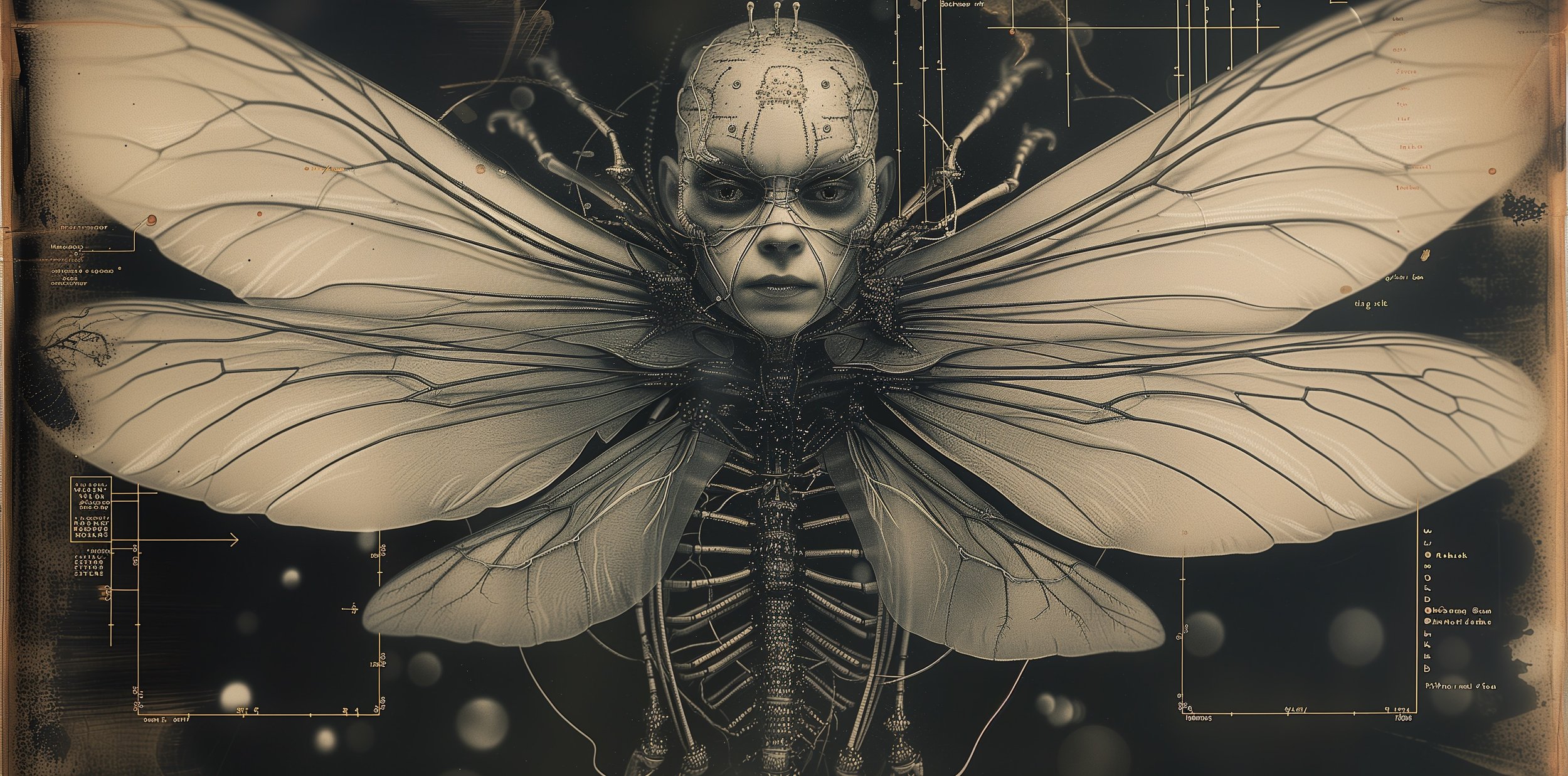
Experimental Note 004 – Neuropteran Elegance in Anthropomorphic Design
The current subject stands as a testament to a theoretical pinnacle in biomechanical engineering, blending the aesthetics of neuropteran wings with a humanoid form. The wings themselves are a lattice of microtubules, revealing a pattern that may contribute to both structural support and electrochemical activity across the membrane. Detailed schematics around the entity suggest specialized nodes that could support synaptic activity, hinting at the wings being not just appendages, but integral components of a larger neural network. The ribcage, articulated with a precision that surpasses the finest clockwork, houses what could be a complex biosynthetic pulmonary system. The head, crowned with an array of sensorial appendages, possesses an expression of contemplative intelligence. The fusion of such elegant insectoid features with human anatomy could represent a radical evolution, or revolution, in both organismal design and function. If such a being were real, the implications for synthetic biology and cybernetic enhancement would be monumental, capturing the imagination and igniting a fervor to explore the uncharted territories of life's potential forms. ∄

Experimental Note 007 – Visionary Synthesis and Ocular Enhancement
This entity represents a groundbreaking synthesis of ocular enhancement and visionary capabilities. The exposed cranial segment reveals an intricate overlay of neural interface circuitry, suggesting augmented cognitive processing. One eye remains distinctly human, a juxtaposition against the biomechanically enhanced counterpart, which displays a complex, multi-faceted lens system indicative of advanced visual acuity, possibly spanning a spectrum far beyond human capability. The wing-like structures, delicate and lace-like, are dotted with sensor nodes that may serve as supplementary visual receptors or environmental sensors. This extraordinary specimen, if it were to exist outside the realm of theoretical exploration, would exemplify the extreme possibilities of cybernetic enhancements in sensory perception, offering a profound insight into a future where the boundaries between the organic and the mechanical are indistinguishably merged. ∄
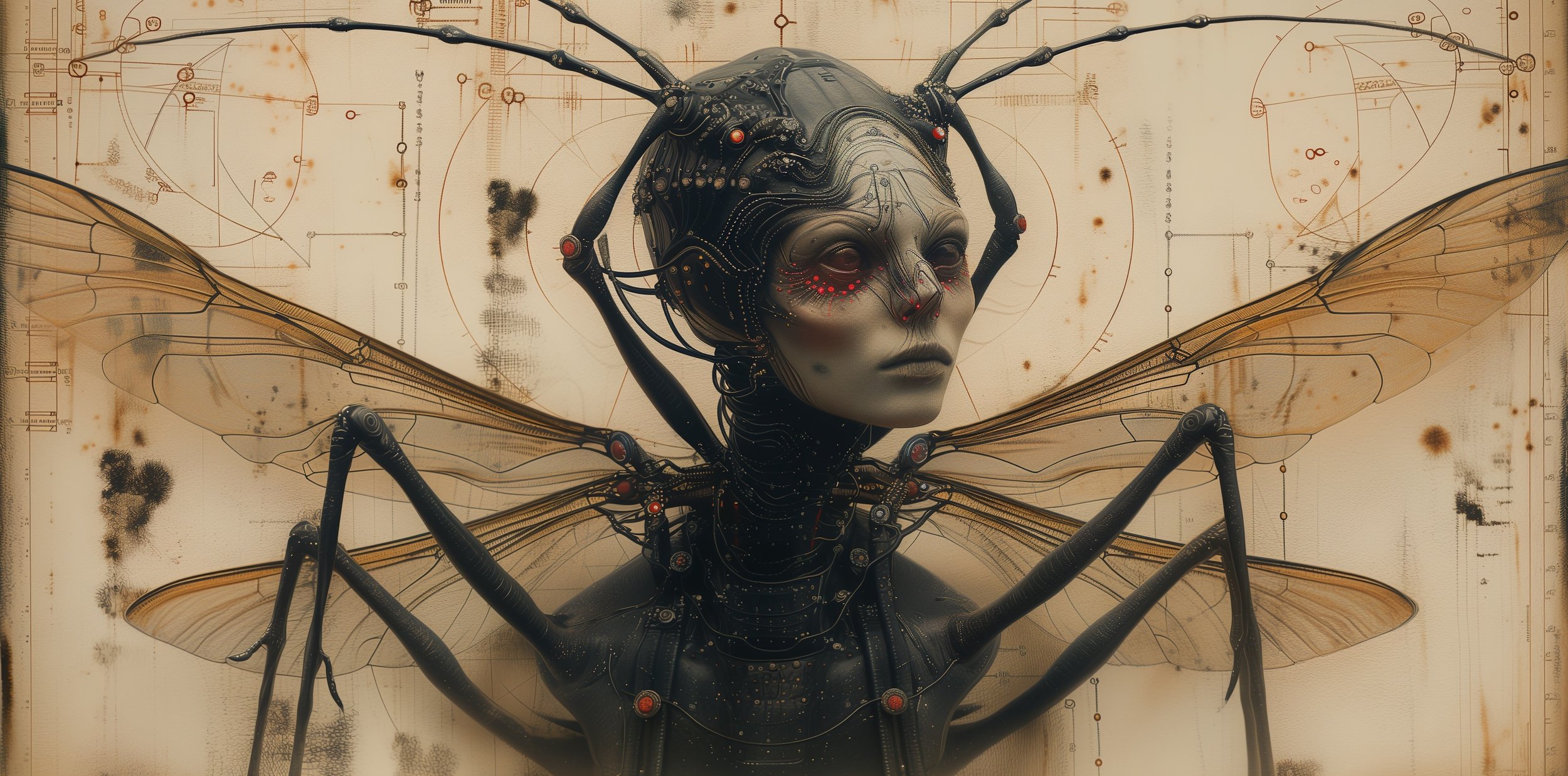
Experimental Note 008 – Neuro-Navigational Systems and Biomechatronic Symbiosis
This specimen presents a marvel in neuro-navigational systems integrated within a biomechatronic framework. The head is adorned with an array of sensor-laden antennae, each dotted with what could be micro-cameras or thermal sensors, pointing to an advanced spatial awareness and environmental mapping capability. The exoskeletal design is punctuated with synthetic muscle fibers, indicating potential for rapid and precise movement, while the wings, transparent and veined, are reinforced with a filigree of conductive threads, suggesting an energy distribution function. The facial features, while hauntingly humanoid, are embedded with cybernetic enhancements that could offer augmented reality visualization. The synthesis of such complex systems posits an organism at the intersection of biological evolution and technological augmentation, a beacon of possibilities for the future of sentient navigation and exploration. The practical applications for such a specimen, should it truly exist, are boundless, spanning from advanced reconnaissance to interstellar exploration. ∄
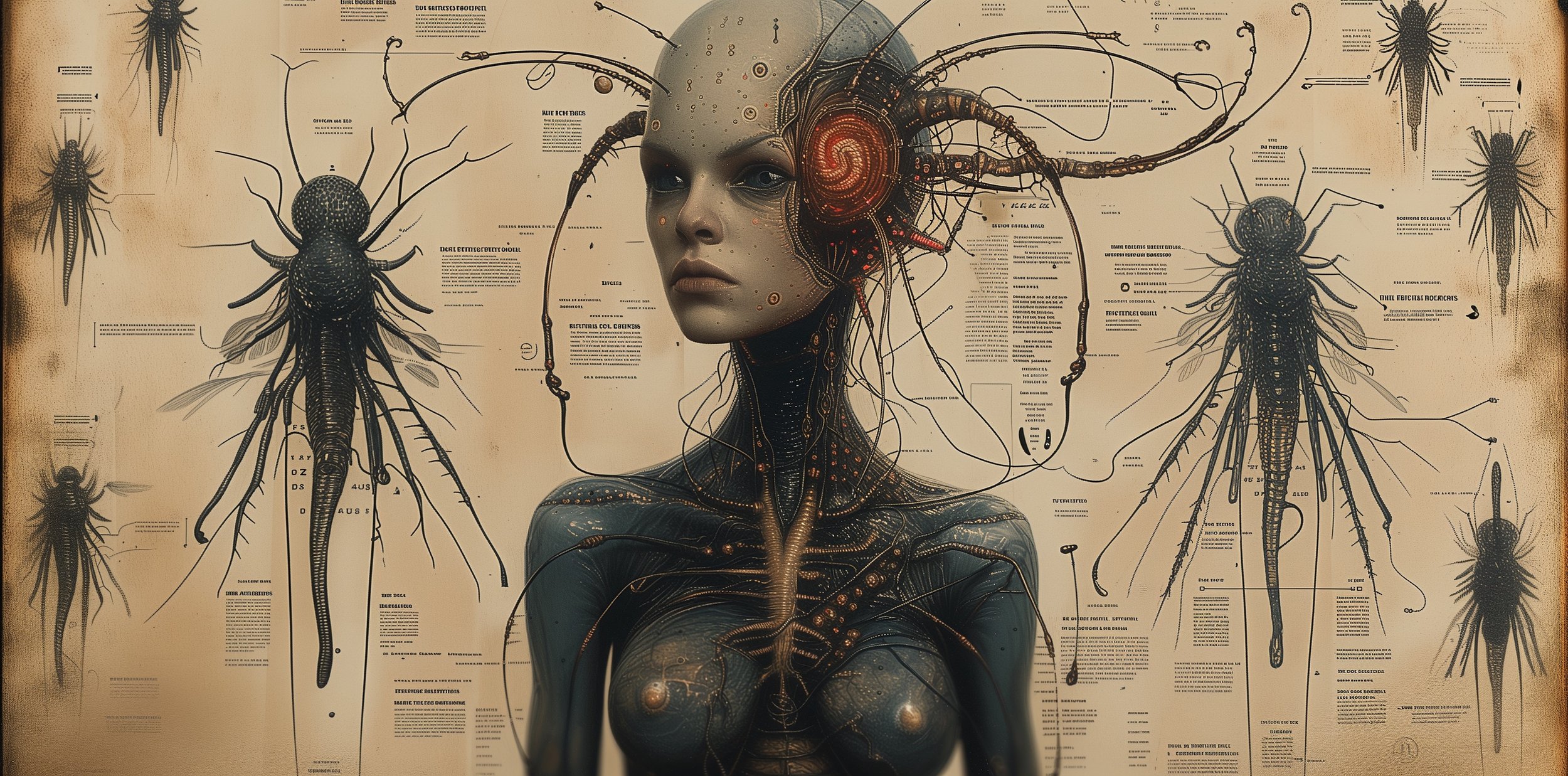
Experimental Note 009 – Auditory Signal Amplification and Neuro-Communicative Array
This specimen delineates a paradigm shift in auditory signal processing and neuro-communicative arrays. The prominent coiled structure that envelops the cranium may function as an advanced auditory amplifier, potentially capturing frequencies beyond the human hearing spectrum. The mesh of cables and sensory tendrils extending from the head and neck are reminiscent of neural dendrites, suggesting an interface for enhanced communication or data exchange. The bio-synthetic skin appears to be embedded with nano-scale transducers, capable of converting environmental stimuli into electrical impulses, thereby integrating external data streams directly into the neural pathways. The juxtaposition of organic human features with such profound technological augmentation posits this being as a nexus of interspecies communication, with potentials ranging from deep-sea exploration to extraterrestrial ambassadorship. The existence of such a sophisticated entity would signify a new chapter in cognitive evolution and techno-organic symbiosis. ∄
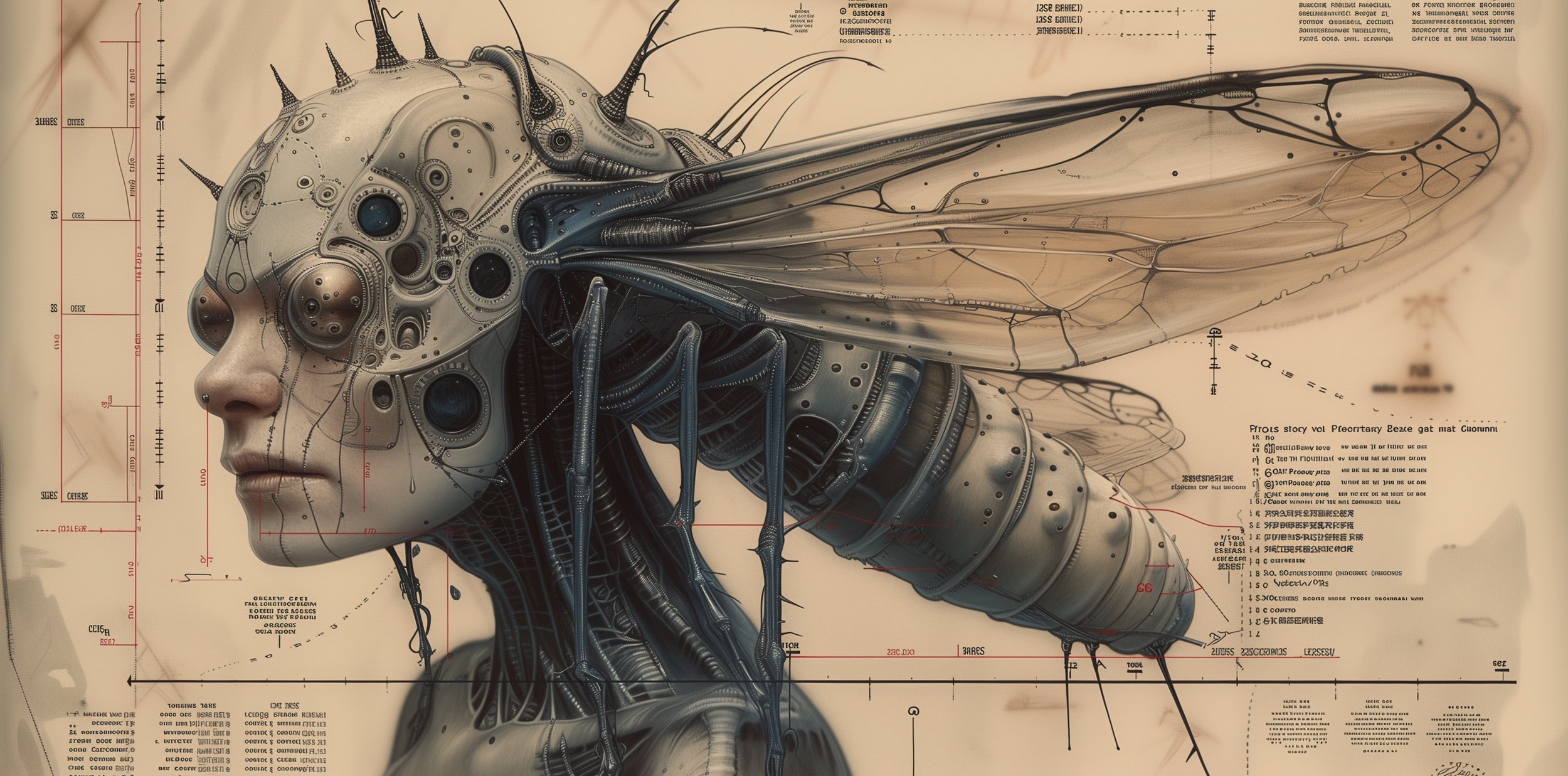
Experimental Note 010 – Multimodal Sensory Augmentation and Cognitive Expansion
This entity represents a leap in multimodal sensory augmentation and cognitive expansion. The head is encased in a bio-metallic dome, punctuated by an array of lenses and auditory receptors, suggesting an enhancement of all five senses to superhuman levels. The intricate network of tubes and wires extending from the cranial case implies a cooling system for an over-clocked brain, or perhaps a mechanism for nutrient delivery to sustain heightened neural activity. The wing apparatus, now more mechanical than biological, could indicate a departure from natural flight to something more controlled and precise, possibly even space-capable. Such a being, were it to exist, would embody the pinnacle of human ingenuity, merging flesh with the machine in a symphony of advanced evolution. This specimen’s capabilities for information processing and environmental interaction would be unprecedented, marking a transformative moment in the understanding of consciousness and embodiment. ∄
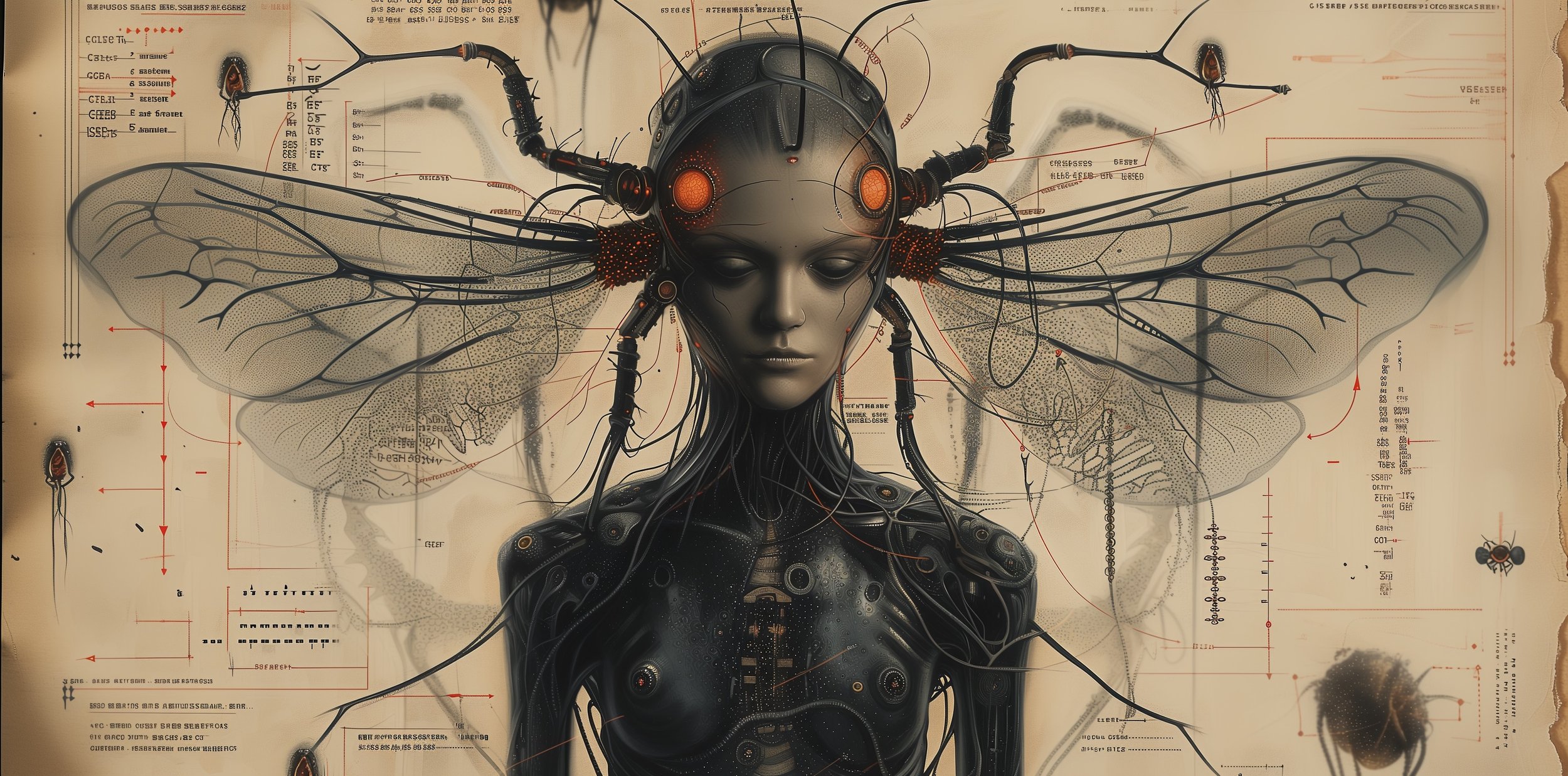
Experimental Note 011 – Electro-Neural Integration and Transcendent Cognition
The specimen before us embodies the pinnacle of electro-neural integration, manifesting a transcendent level of cognition. The head, crowned with elaborate sensory arrays, suggests a supercomputing capacity for data processing and environmental analysis. Luminous ocular implants hint at the possibility of vision across multiple spectra, from infrared to ultraviolet. The delicate wing structures, etched with microcircuitry, imply a dual function: as organs of flight and as expansive antennae for signal reception. Intricate nodules and filaments that festoon the skull could be neural amplifiers, exponentially expanding the creature's synaptic processing. This confluence of biotechnological mastery and natural elegance posits a creature not merely evolved, but rather designed for a future where the interface between organism and machine is seamless. Such an entity, if it were to exist, would stand as a monument to the boundless potential of life, reshaped by the unyielding hands of innovation. ∄
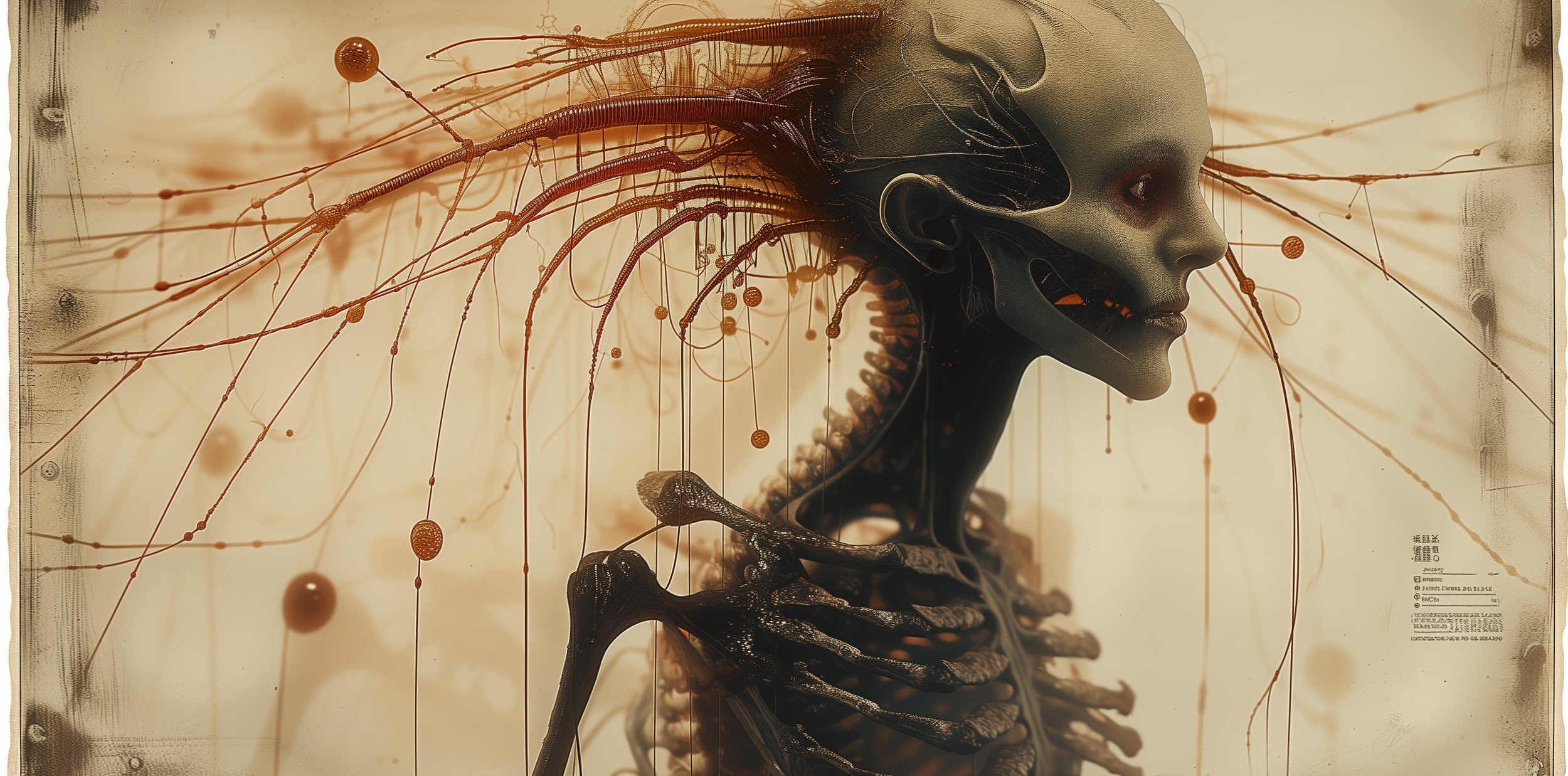
Experimental Note 012 – Advanced Neuropropulsion and Energetic Resonance
We are presented with a specimen that is a veritable nexus of advanced neuropropulsion and energetic resonance. The head, adorned with an extensive network of tendrils, each ending in a bulbous node, suggests an intricate sensory and communicative system, potentially capable of transmitting and receiving bioelectrical signals across great distances. The skeleton, visible through the semi-translucent skin, appears to be a hybrid of organic and synthetic materials, optimized for both flexibility and strength. These filaments, which radiate outward, could also function as conduits for energy or information, connecting the specimen to a larger network or hive intelligence. The presence of such an organism, were it more than speculative science, would revolutionize our concepts of mobility and connectivity, representing a form of life whose very existence is intertwined with the energy fields it navigates. ∄
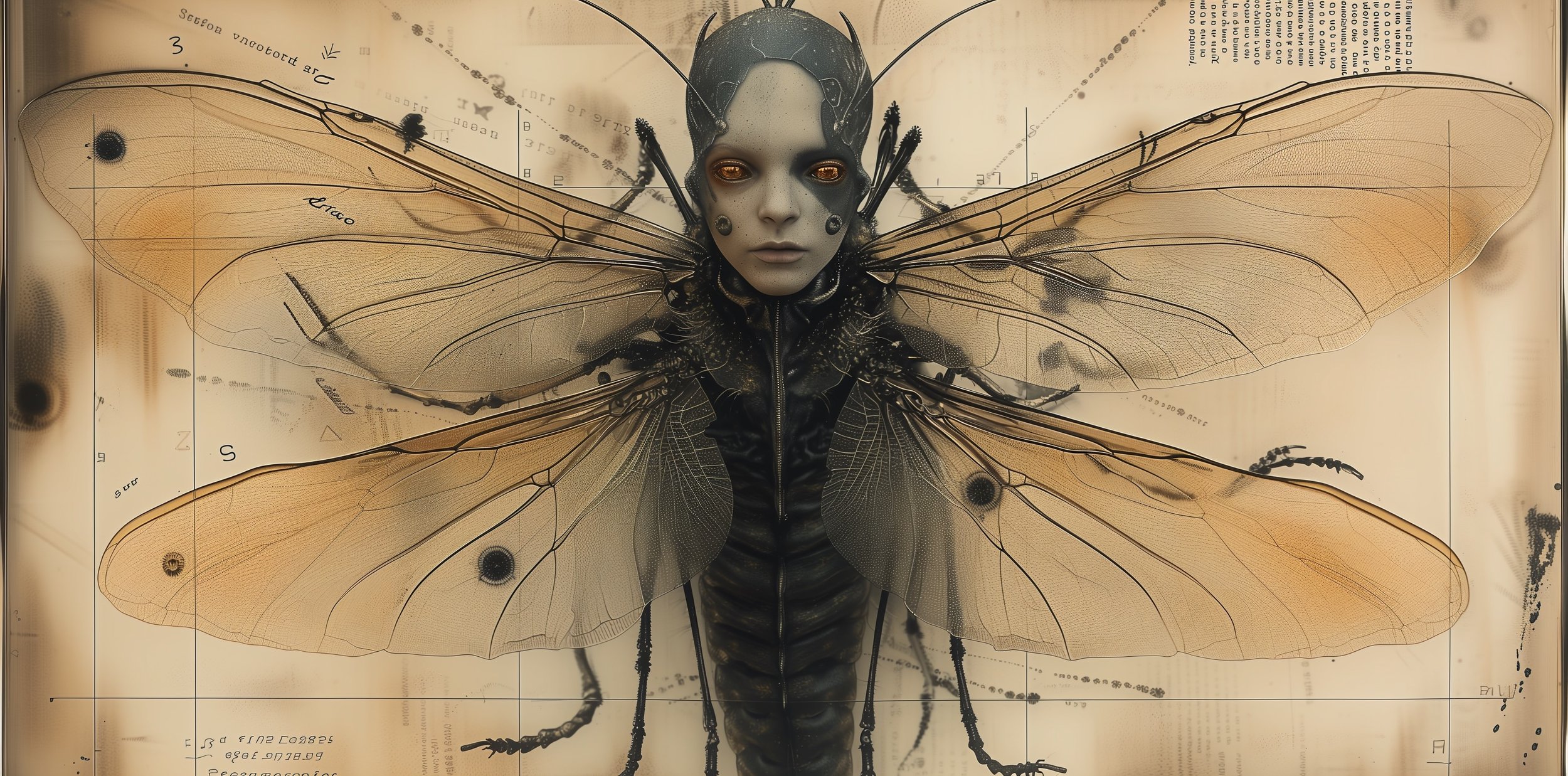
Experimental Note 013 – Lepidopteran Cybernetic Transcendence
In the thirteenth specimen, we observe the zenith of lepidopteran cybernetic transcendence. The entity's wings, vast and diaphanous, are etched with a network of veins that could serve as conduits for bioelectrical currents, enabling both natural and powered flight. The humanoid facial structure is serene, yet behind its eyes glow the embers of advanced optics, suggesting enhanced visual capabilities. Adorned with antennae that are likely multifunctional, serving as both sensory organs and communication relays, the creature embodies a fusion of organic delicacy and technological prowess. The body, a sleek column of bioengineered perfection, might house an ecosystem of nanotechnology, harmonizing the biological and mechanical into a single, elegant form. This being, if it were more than a figment of speculative bioengineering, would represent a harmonious blend of nature’s artistry and human ingenuity, a testament to the limitless potential of life in all its varied forms. ∄
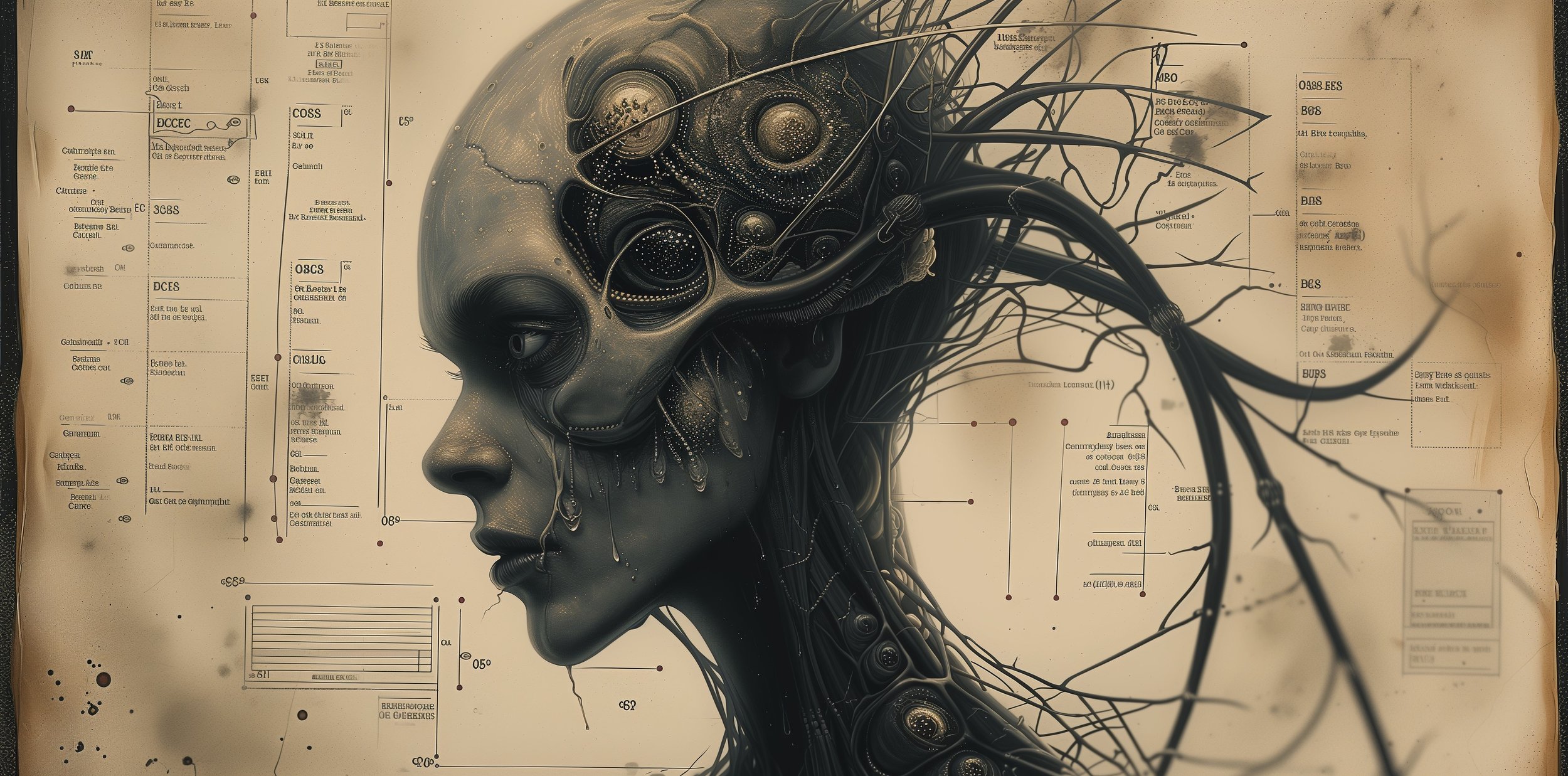
Experimental Note 014 – Neuro-Mechanical Fusion and Sensory Amplification
The fourteenth specimen exhibits the apex of neuro-mechanical fusion and sensory amplification. The profile of the subject reveals a skull partially encased in a biomechanical carapace, bristling with an array of sensory devices and cerebral enhancers. The ornate design suggests advanced functions, possibly for processing vast data streams or augmenting mental capabilities beyond natural limits. Wires cascade from the head like a mane of electronic tendrils, possibly interfacing with remote systems or augmenting the entity's physical senses with vast digital networks. Such a being, were it to exist, might possess the capacity for immense computational power, perhaps capable of interfacing directly with artificial intelligences or engaging in complex problem-solving scenarios that would baffle ordinary human minds. The existence of this entity would represent a profound evolution of consciousness, where the organic and synthetic are inseparably intertwined. ∄

Experimental Note 015 – Cerebral Interface Optimization and Sensory Matrix Enhancement
In this depiction, we witness an advanced state of cerebral interface optimization coupled with sensory matrix enhancement. The subject's cranium is adorned with a dense network of sensory nodes, pulsating with activity, suggesting a hyper-augmented state of perception. One ocular cavity is occupied by a complex sensory apparatus, perhaps an adaptive optic capable of multiple spectral analyses. The myriad filaments emanating from the skull and neck region likely serve as conduits for information, assimilating external data into the neural matrix at an accelerated rate. This intricate arrangement of biotechnology speaks of a creature designed for unparalleled environmental awareness and cognitive processing. The melding of organic tissue with such a sophisticated sensory network could indicate a purpose beyond mere existence, perhaps as a living probe or an autonomous agent of exploration in environments hostile to unenhanced life forms. ∄
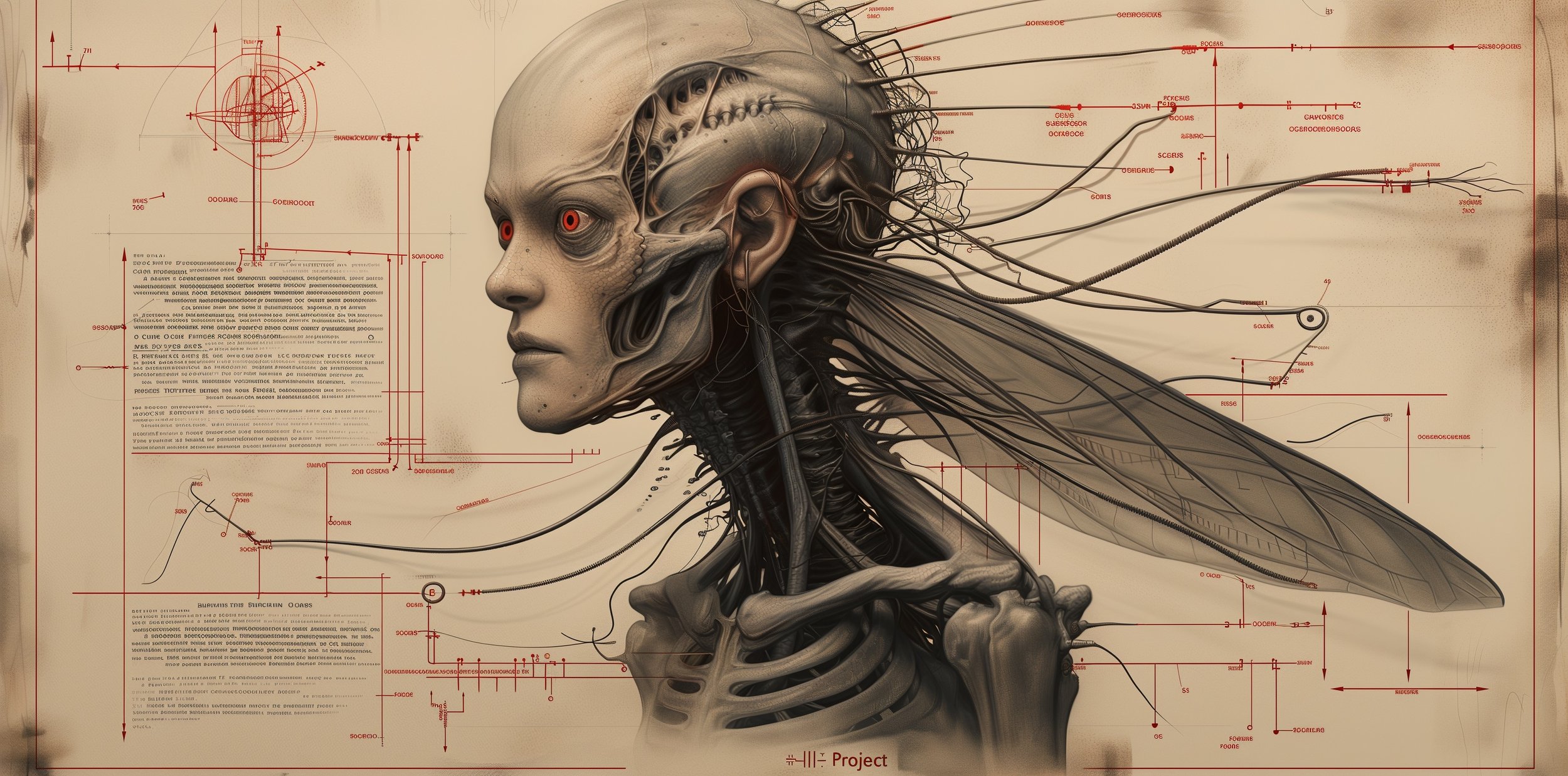
Experimental Note 016 – Anatomical Cybernetic Integration and Kinetic Optimization
The subject displayed represents a sophisticated example of anatomical cybernetic integration with an emphasis on kinetic optimization. The exposed musculature and skeletal structure suggest a lightweight yet robust framework, likely composed of bio-compatible alloys, providing an enhanced range of motion and physical resilience. The cranial cavity is partially replaced with a biomechanical interface, housing advanced neural circuitry that could potentially offer real-time computational capabilities or direct interface with external devices. Red ocular implants dominate the visual aesthetic, likely providing the entity with enhanced or even entirely new visual modalities. The myriad of cables and biomechanical tendrils indicate a high degree of connectivity and responsiveness, suggesting an organism tailored for tasks requiring precision and adaptability. If such an entity were to exist, it would be the epitome of bioengineering, a seamless blend of organic evolution and technological advancement, functioning as a testament to the limitless possibilities of synthetic life. ∄
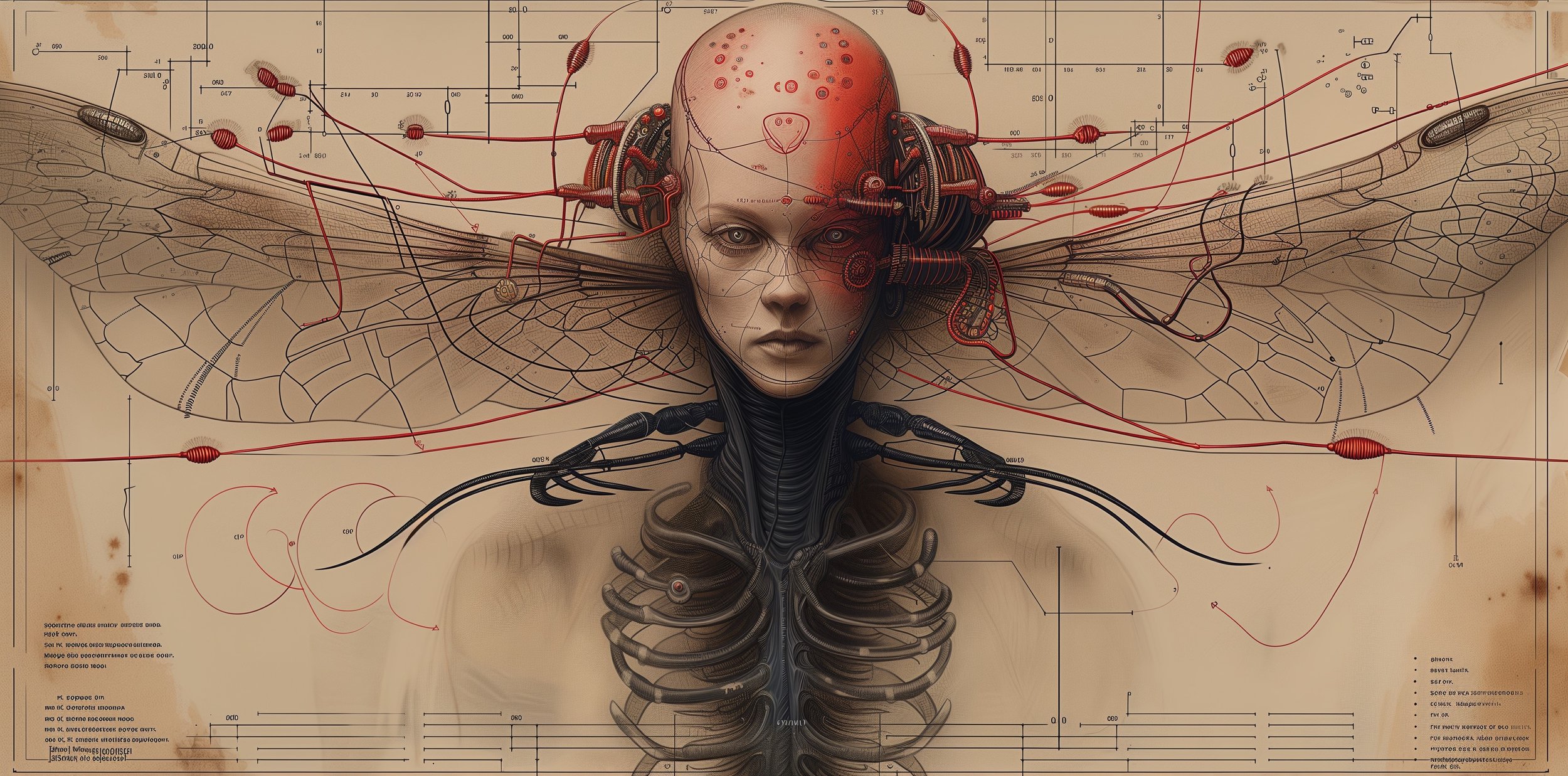
Experimental Note 017 – Cybernetic Cerebral Cortex and Sensory Web
Here we see a specimen that is the epitome of a cybernetic cerebral cortex, integrated within a complex sensory web. The central headpiece, with its numerous synaptic connectors, indicates an enhancement of the brain's processing power, possibly interfacing with quantum computational systems. The network of red cables branching from the skull suggests a vast sensory net, capable of detecting changes in the environment with exquisite precision. The ribcage, partially visible beneath the layers of bio-armor, is structurally reinforced, hinting at the necessity to protect vital organs augmented for enhanced function. Wings, resembling those of a dragonfly, extend from the back, their membranous surfaces intertwined with sensory filaments, which may serve to collect data or generate bioelectric energy. This being, if it were to exist, would transcend contemporary understanding of biotechnology, representing a future where the biological and technological are woven together to create forms of life unimaginable to current science. ∄
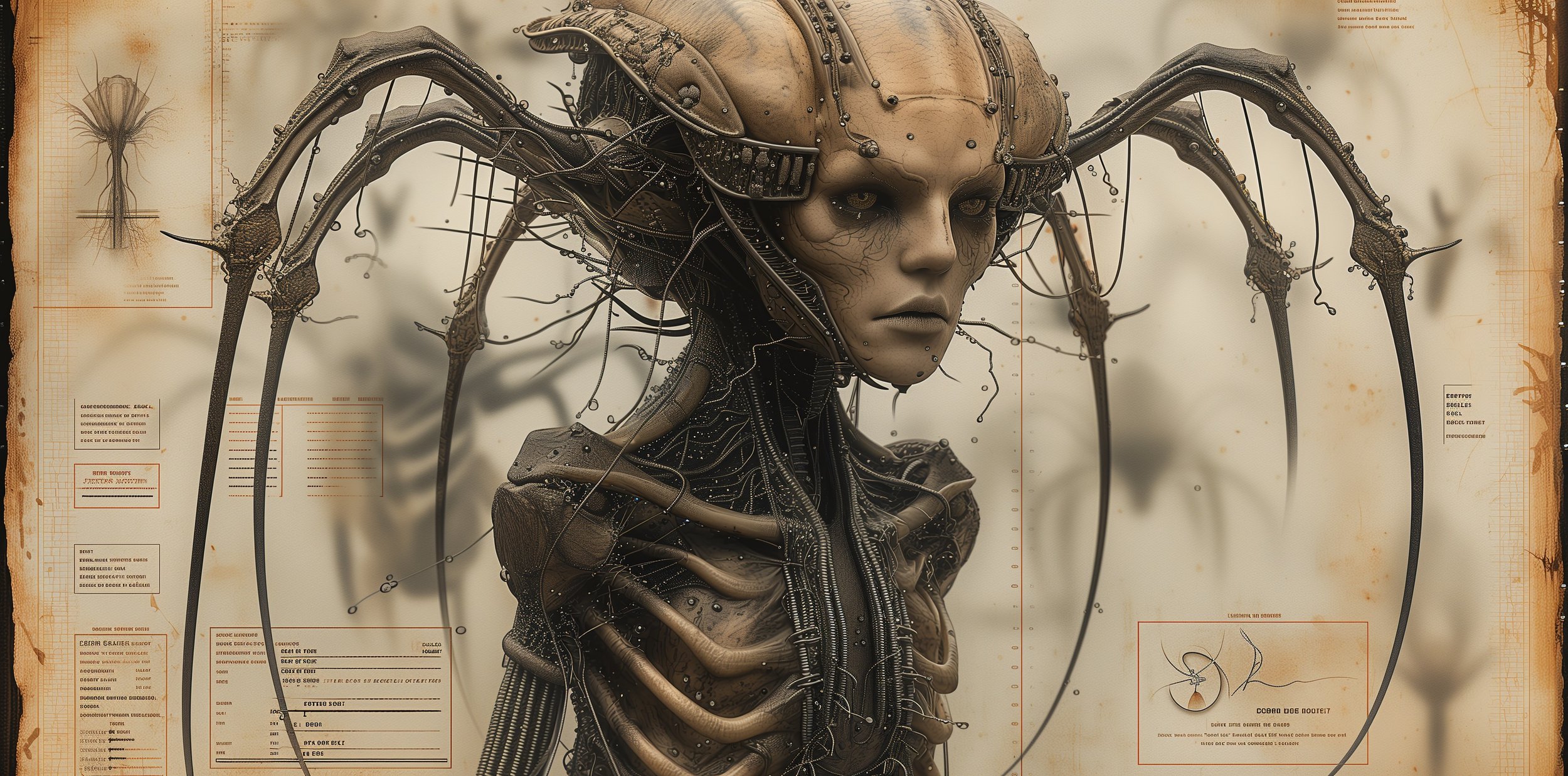
Experimental Note 018 – Biomimetic Neural Architecture and Adaptive Exoskeleton
The latest subject is a profound demonstration of biomimetic neural architecture intertwined with an adaptive exoskeleton. The cranium is transformed into a central processing unit, with neural connectors and synaptic relays replacing hair, indicating a form of intelligence that may operate on an entirely different paradigm. The exoskeletal appendages radiating from the skull suggest a form of environmental interaction that is both sensory and manipulative, extending the being's awareness and control into the external space. The torso, encased in what appears to be a flexible carapace, houses an intricate network of support structures and biofluidic channels, optimizing the organism's internal homeostasis and external adaptability. This figure, if more than an elaborate conceptualization, would embody the cutting edge of synthetic evolution, where the line between the natural and the engineered is artistically blurred. ∄

Experimental Note 019 – Sensory Network Expansion and Bioluminescent Signaling
The latest visualization portrays a subject with an extensive sensory network expansion, accompanied by bioluminescent signaling capabilities. The creature’s head is crowned with a framework of bioluminescent nodes, possibly serving as a sophisticated communication system or as a means to attract or deter other species. The wings, reminiscent of a dragonfly's, are embedded with a fine lattice of sensory receptors, providing an advanced level of environmental feedback to the central nervous system. This array of optical enhancements within the eyes suggests a visual acuity capable of perceiving a spectrum of light beyond the human range. The subject's overall morphology suggests a being designed for delicate yet intricate interaction with its surroundings, where every thread in its complex array of filaments serves a unique and vital function. If such an organism were to exist, it would be a masterpiece of synthetic biology, symbolizing a new dawn of bio-luminescent communication and multi-dimensional sensory perception. ∄

Experimental Note 020 – Advanced Cerebral Integration and Morphological Dynamics
This specimen stands as a testament to the pinnacle of advanced cerebral integration and morphological dynamics. The cranium is augmented with a complex array of cybernetic implants, each serving to enhance cognitive functions and neural interfacing. The eyes, devoid of emotion, are possibly indicative of a highly advanced vision system, capable of more than mere sight, potentially interfacing with various data streams and alternate visual dimensions. The wings, while anatomically reminiscent of Earth’s insects, possess a structural integrity and flexibility suggesting a material science far beyond current capabilities. The torso, streamlined and fused with the spinal column, showcases an evolutionary leap towards a form both statuesque and fluid. This being, if it could be encountered outside of these theoretical musings, would epitomize the fusion of organic life with its synthetic counterparts, marking a new evolutionary path that is as enigmatic as it is advanced. ∄
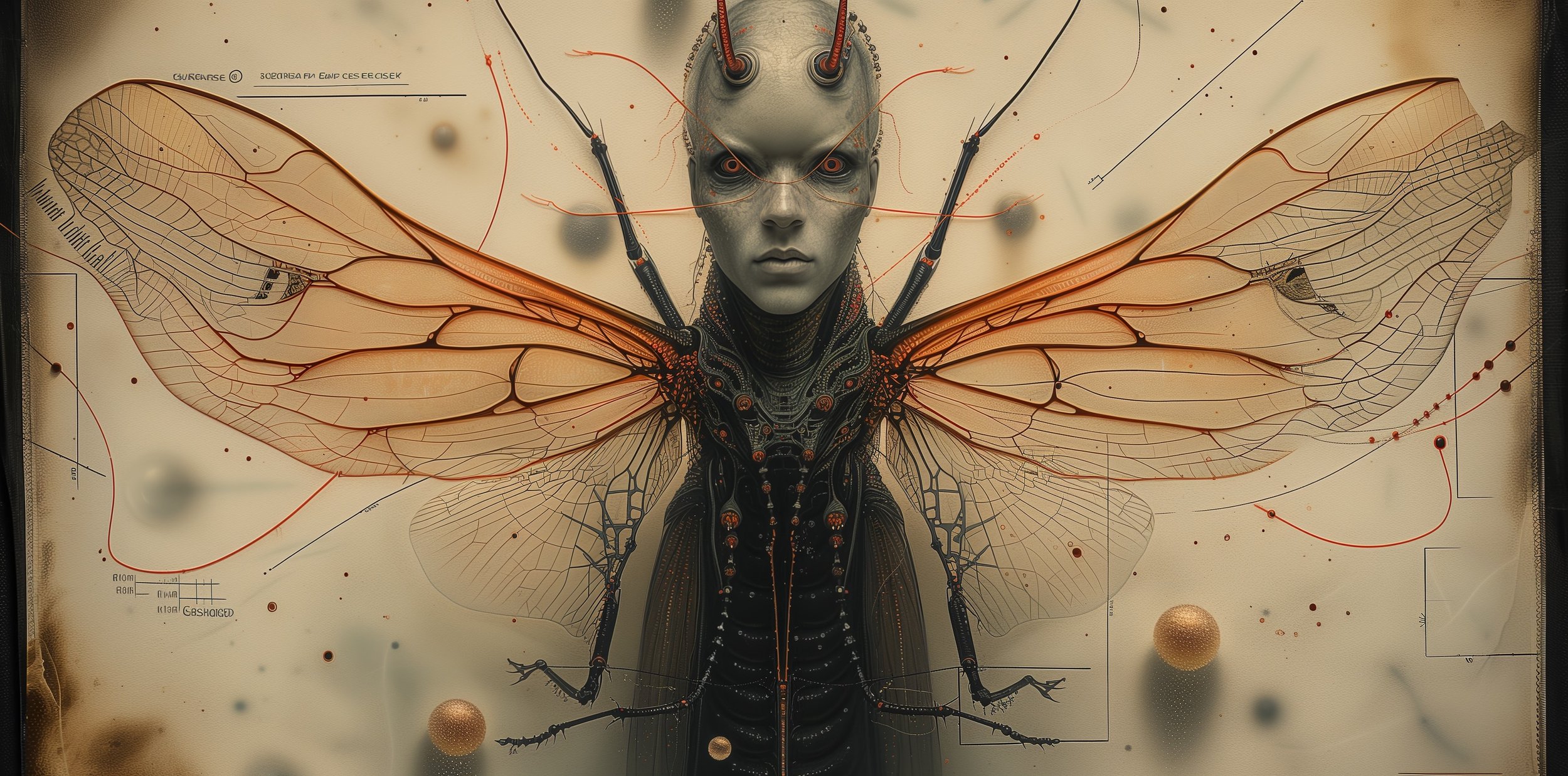
Experimental Note 021 – Integrated Sensory Enhancement and Navigational Matrix
The subject in question is a striking example of integrated sensory enhancement within a navigational matrix. The central cranial node, flanked by radial antennae, suggests a hub of heightened sensory input, potentially granting 360-degree environmental awareness. The wings, vast and detailed, are not merely for display or flight; they are laced with sensory filaments and navigation aids, which likely map the surrounding space with precision. The gaze of the subject, intense and unyielding, might be indicative of a vision system that is capable of both microscopic detail and telescopic range. The torso is sheathed in a network of bio-cables and nodes that might serve as a conduit for neural signals or as an energy distribution matrix. This entity, if it were to be more than a hypothetical construct, would represent an apex in the field of biotechnological navigation, a being not only adapted to but integrated with the very fabric of its environment. ∄
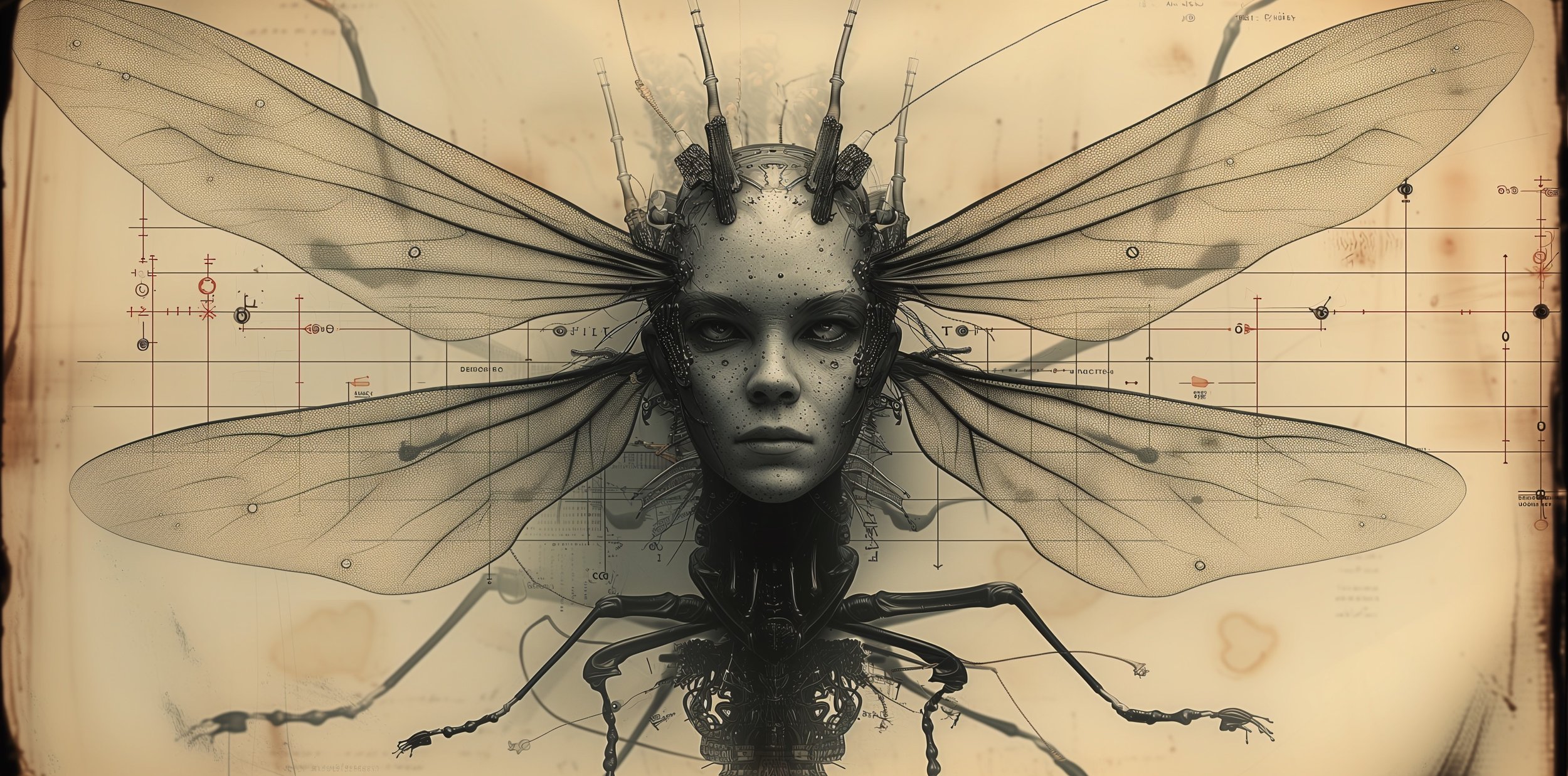
Experimental Note 022 – Biomechanical Symbiosis and Aeronautic Adaptation
Encountering the twenty-second subject, we delve into the realm of biomechanical symbiosis and aeronautic adaptation. The being's head is adorned with an array of antennae and sensory probes, each meticulously calibrated for atmospheric analysis and communication. The expansive wings, reminiscent of a damselfly's, are an engineering marvel, containing microfilaments and neuromechanical sensors that could allow for precise control during high-velocity maneuvers. The skin appears to have a chitinous quality, suggesting a hardiness that belies its ethereal form. This specimen, if it were to be more than a visionary's ambition, would represent a harmonious marriage between organic evolution and mechanical precision, soaring through the skies as a symbol of future possibilities where technology enhances nature's design. ∄

Experimental Note 023 – Navigational Acuity and Environmental Symbiosis
The twenty-third subject presents a sophisticated level of navigational acuity coupled with environmental symbiosis. The helmet-like structure on the head, with its array of sensory inputs and computational nodes, suggests a highly advanced navigational system, possibly integrating real-time environmental data for seamless maneuvering. The wings, thin and expansive, demonstrate a complex network of support struts and vein-like sensors, indicative of a design that allows for delicate control over airflow and lift. The eyes, deep and reflective, could be capable of processing a myriad of visual inputs, including electromagnetic fields or subtle energy fluctuations. The physical form is a testament to the symbiotic relationship between the organism and its habitat, where every aspect of its design is tailored to interact with, adapt to, and possibly even manipulate its surroundings. Should such an entity exist, it would represent a pinnacle of evolutionary engineering, blurring the lines between organism and environment. ∄
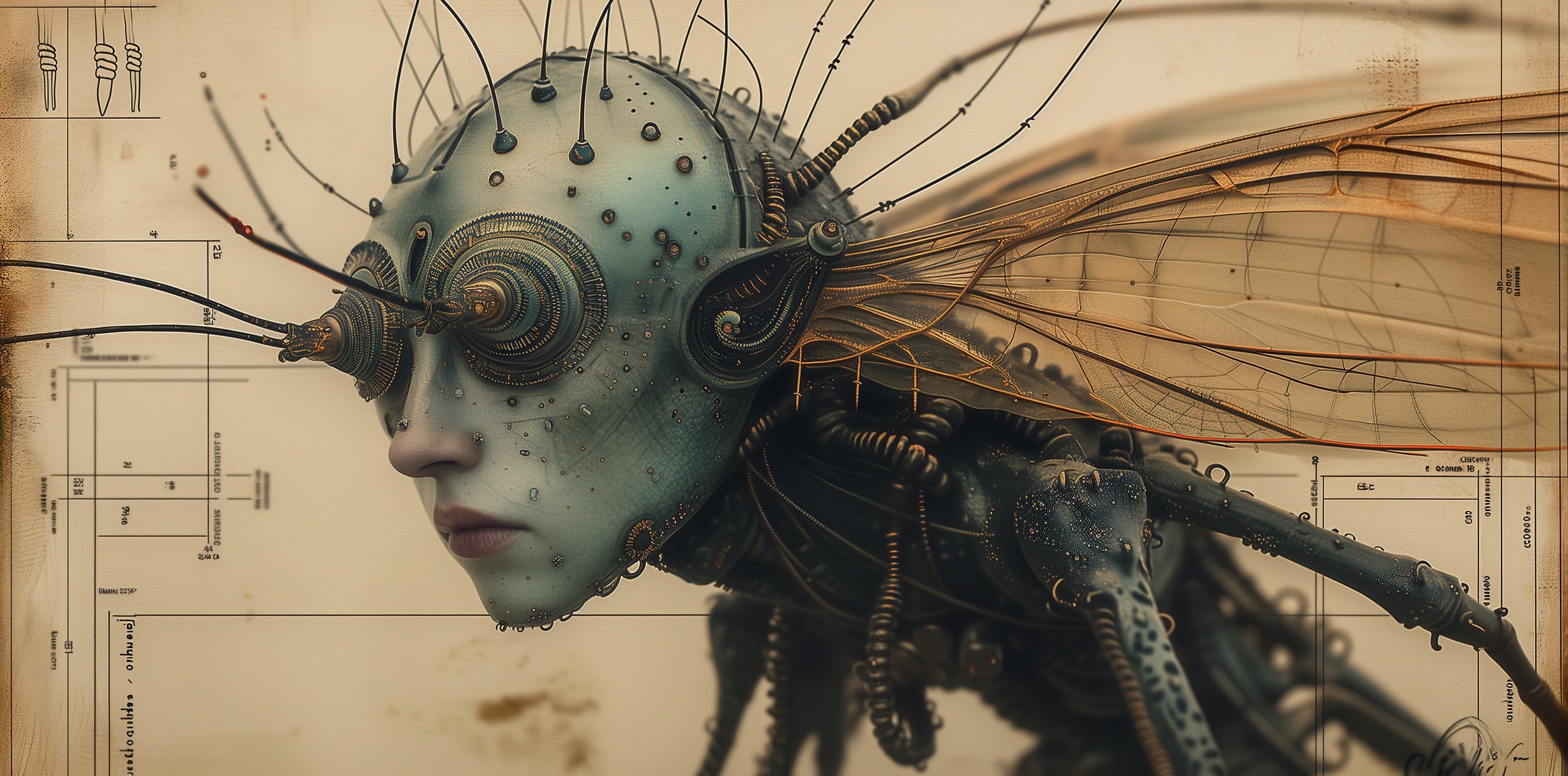
Experimental Note 024 – Precision Sensory Apparatus and Aerodynamic Proficiency
The specimen unveiled here exhibits a highly developed precision sensory apparatus, coupled with exceptional aerodynamic proficiency. The elaborate ocular device, replacing the left eye, suggests a capacity for advanced visual processing, potentially extending into spectrums beyond human perception. The wings, seemingly delicate yet robust, are likely engineered for efficiency and speed, with a framework that supports rapid and agile flight. Intricate coils and gears near the auditory canal imply enhanced hearing capabilities, perhaps even the detection of ultrasonic frequencies. The biomechanical structures that envelop the figure's physique are not merely supportive but are integral to the being’s sensory and navigational systems. This entity, should it be more than an imaginative projection, would be the embodiment of precision and grace, a creature designed for the skies, with every aspect of its form meticulously optimized for interaction with the currents of the air and the light of the stars. ∄
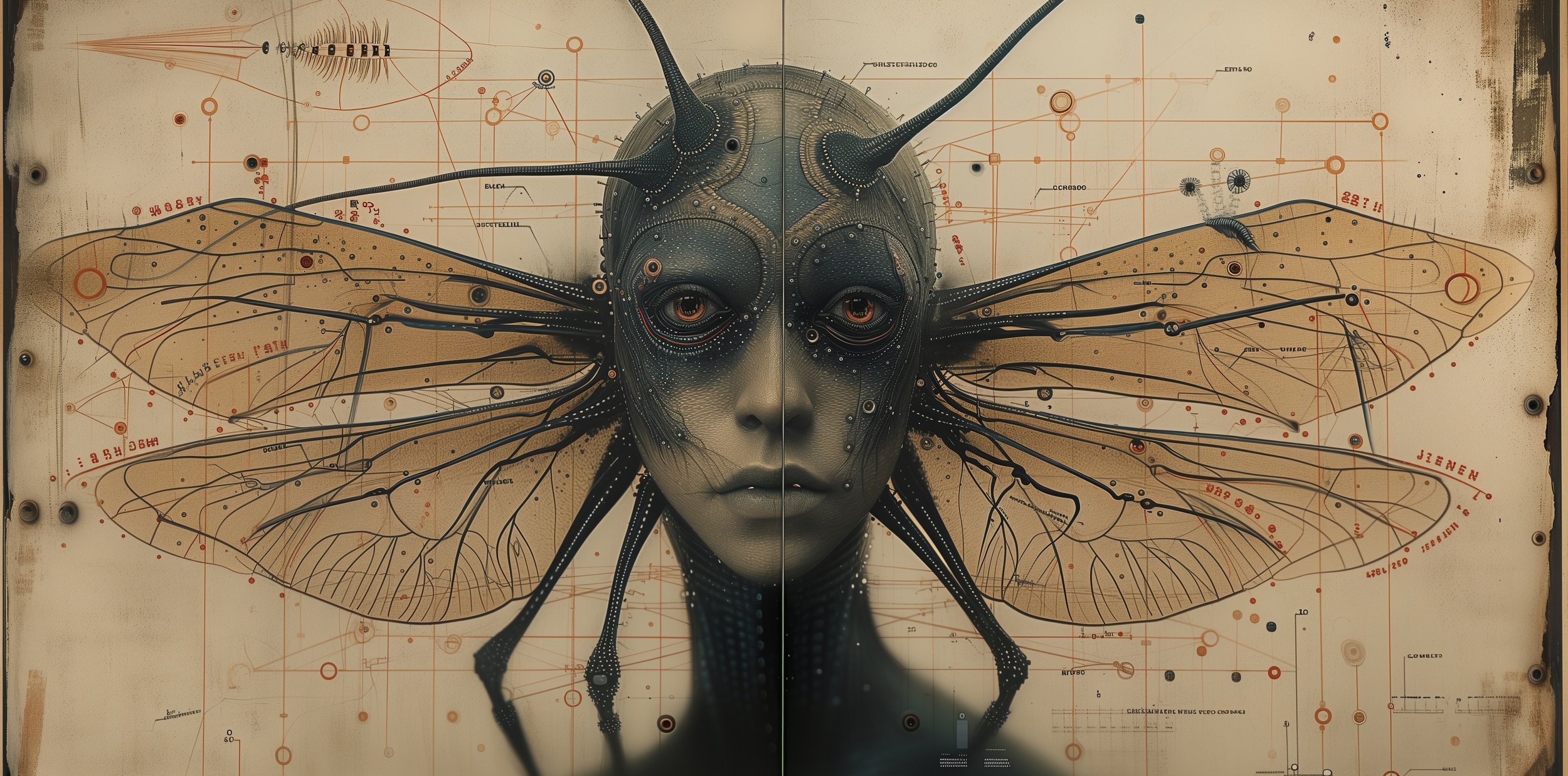
Experimental Note 025 – Advanced Neuro-Aeronautic Configuration and Spatial Perception
This final subject embodies an advanced neuro-aeronautic configuration, specifically tailored for superior spatial perception. The head, adorned with sensory antennae and neural augmenters, hints at an organism capable of extraordinary multi-dimensional awareness. The expansive wings, patterned with a network of sensory nodes and gyroscopic veins, suggest a design for stability and maneuverability in multiple atmospheric strata. The eyes, multifaceted and deep, serve as potent visual processors, likely capable of detecting subtle energy shifts and air density changes. The form is the epitome of an entity engineered for aerial dominance, each component harmonized for optimal interaction with both the terrestrial and celestial realms. This being, if ever it were to cross from the realm of theory into reality, would represent a quantum leap in synthetic biology, navigating the skies with an elegance and precision that defies current understanding. ∄
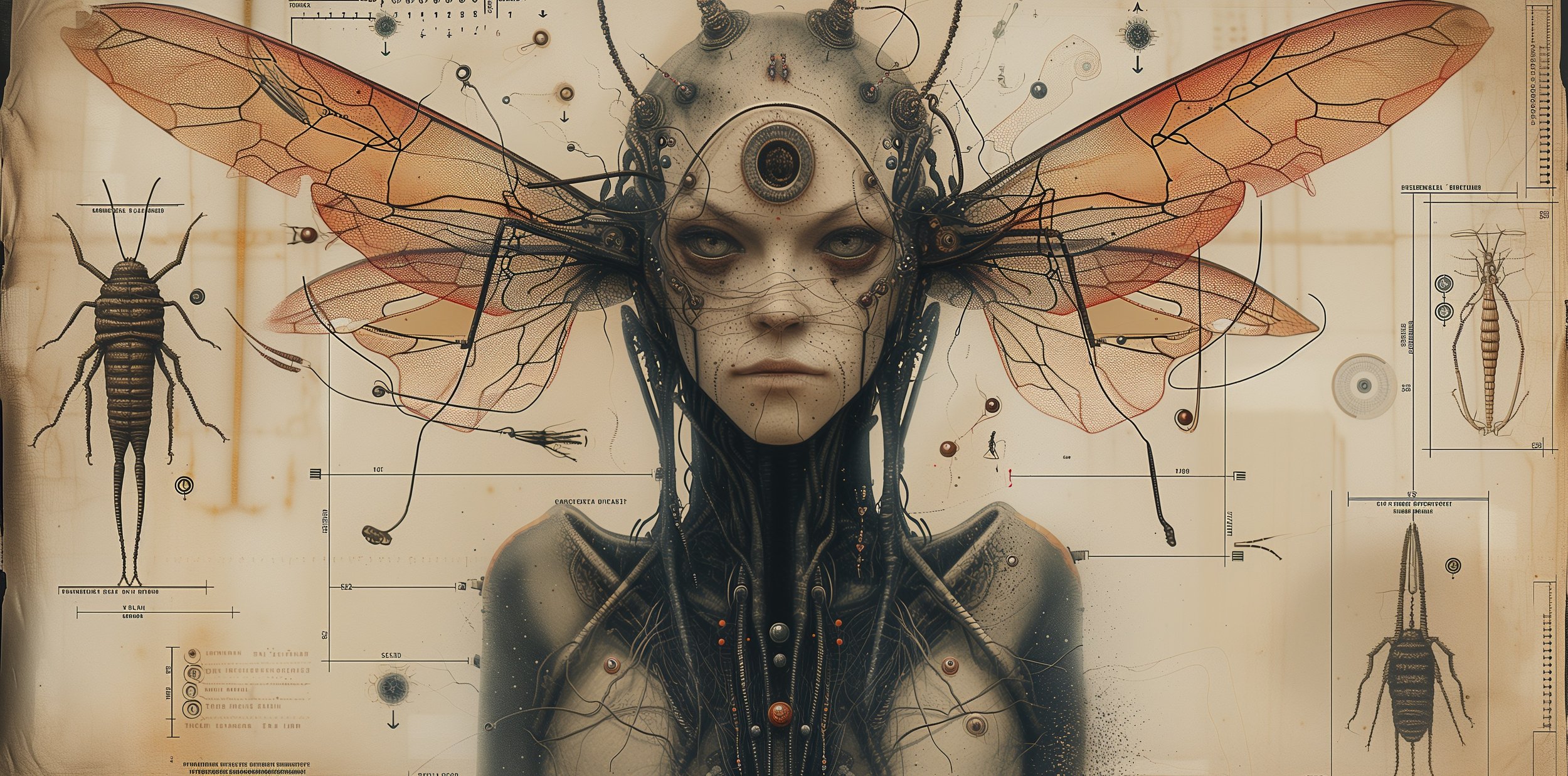
Experimental Note 026 – Hybridized Sensory Augmentation and Ecosystem Integration
The twenty-sixth subject is a fascinating composite of hybridized sensory augmentation and ecosystem integration. The concentric circles at the center of the forehead suggest a sophisticated sensory array, perhaps capable of echolocation or electromagnetic field detection. The wings, marked with intricate patterns, may serve dual functions of camouflage and climate control, responding to environmental stimuli with color and texture changes. The myriad of tendrils and filaments extending from the head and torso imply a deep symbiotic connection with surrounding flora and fauna, allowing for the exchange of chemical signals or mutualistic interactions. This organism, if it were to exist beyond these theoretical sketches, would exemplify the zenith of ecological engineering, existing in perfect harmony within its niche, while the advanced sensory capabilities would permit an unparalleled understanding of its environment. ∄
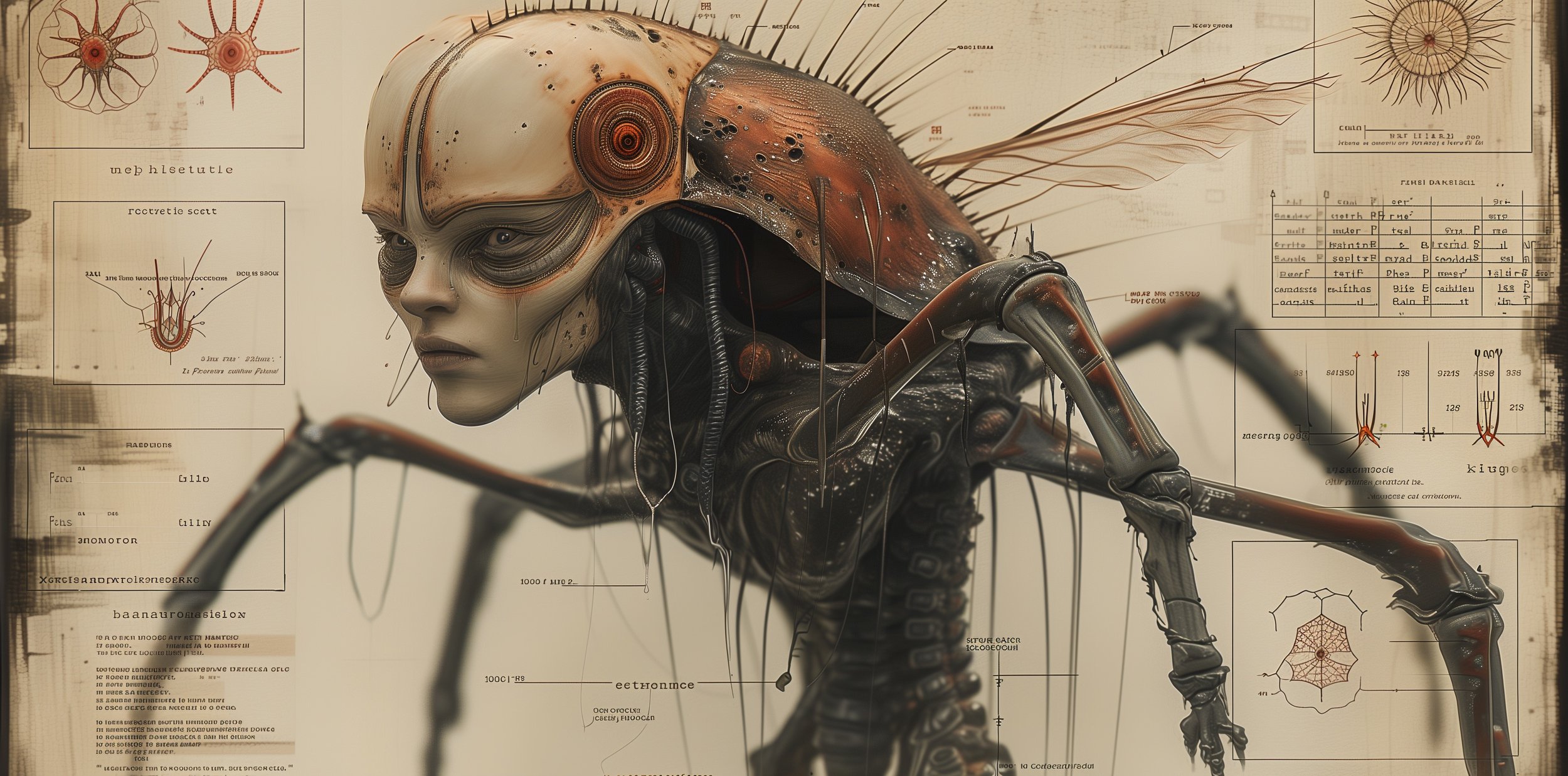
Experimental Note 027 – Locomotive Efficiency and Sensory Expansion
This specimen denotes a remarkable leap in locomotive efficiency and sensory expansion. The prominent cranial gear, intricately linked to the sensory appendages, likely functions as a central processor for environmental data, enhancing the being’s spatial awareness and prey detection capabilities. The limbs exhibit a lightweight yet sturdy structure, optimized for rapid, energy-efficient movement. Pseudo-organic tubes and cables suggest a circulatory system that may distribute not only vital fluids but also electrical impulses or other forms of energy essential for the creature's biomechanical functions. This entity, if it were to transcend the boundaries of theoretical exploration, could offer profound insights into the seamless integration of organic and synthetic systems, representing an evolutionary marvel capable of thriving in a multitude of ecosystems. ∄
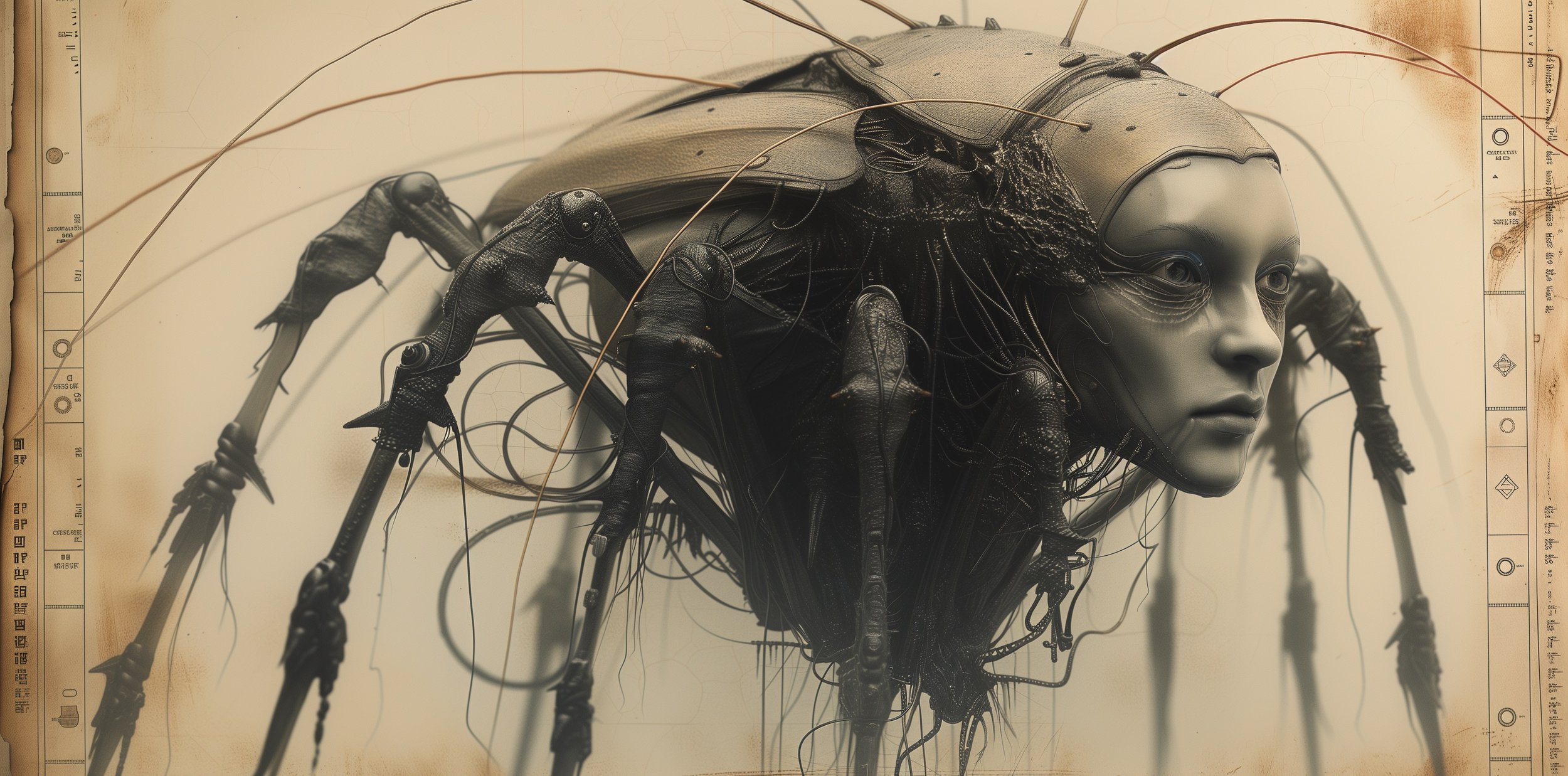
Experimental Note 049 – Neuromechanical Symbiosis and Sensory Web Integration
Specimen 049 exemplifies a neuromechanical symbiosis, where the biomechanical infrastructure appears to be an extension of the neural network, effectively creating a sensory web that extends well beyond the physical confines of the primary organism. The sensory appendages, reminiscent of arachnid limbs, suggest a sophisticated tactile interface, allowing the specimen to interact with its environment at multiple levels simultaneously. It’s conceivable that this creature could manipulate objects with precision, responding to stimuli with remarkable agility. Moreover, the filaments and strands that cascade from the appendages hint at a possible communication mechanism, perhaps analogous to the vibrational patterns used by spiders to detect prey and mates. The fusion of organic and mechanical components here points to an advanced form of adaptation, with potential implications for both biological and artificial intelligence research. ∄
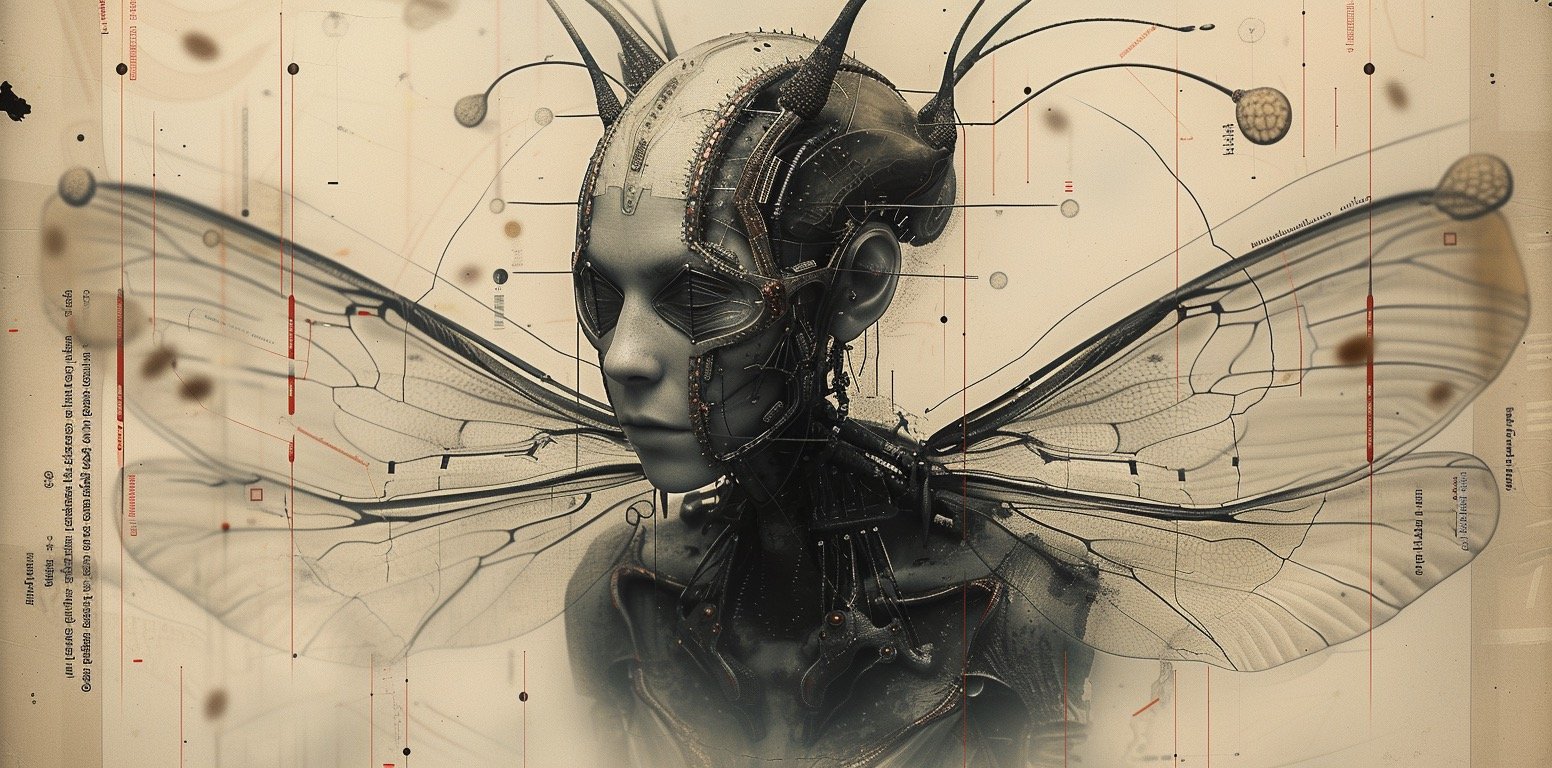
Experimental Note 093 – Cerebral Nexus and Lepidopteran Physiognomy
Specimen 093 exhibits an extraordinary integration of cerebral and sensory augmentation, manifesting in a lepidopteran physiognomy. The nexus at the cranium suggests a centralized hub of neural activity, which likely coordinates the multi-faceted sensory inputs from the expansive wing-like appendages. The membranous structures, while evoking the delicate beauty of butterfly wings, are densely lined with what appear to be sensory receptors, potentially offering an augmented perceptual experience.
The precision-engineered framework that supports these wings indicates a fusion of organic and inorganic matter, optimizing both structure and function. This configuration might allow for a highly sensitive environmental mapping capability, with immediate neural processing at the site of the nexus. The intricate patterns and nodes could be indicative of a highly specialized form of data collection and interpretation, providing the specimen with an unparalleled awareness of its surroundings.
Additionally, the aesthetic components, such as the ornate headgear, may serve a purpose beyond the mere visual. They could be integral to the creature's sensory apparatus, amplifying or directing signals to the cerebral nexus. The combination of advanced neural integration and sensory extension posits this specimen as a subject of profound interest for biotechnological applications, possibly hinting at a future where organic and synthetic enhancements converge to transcend biological limitations. ∄
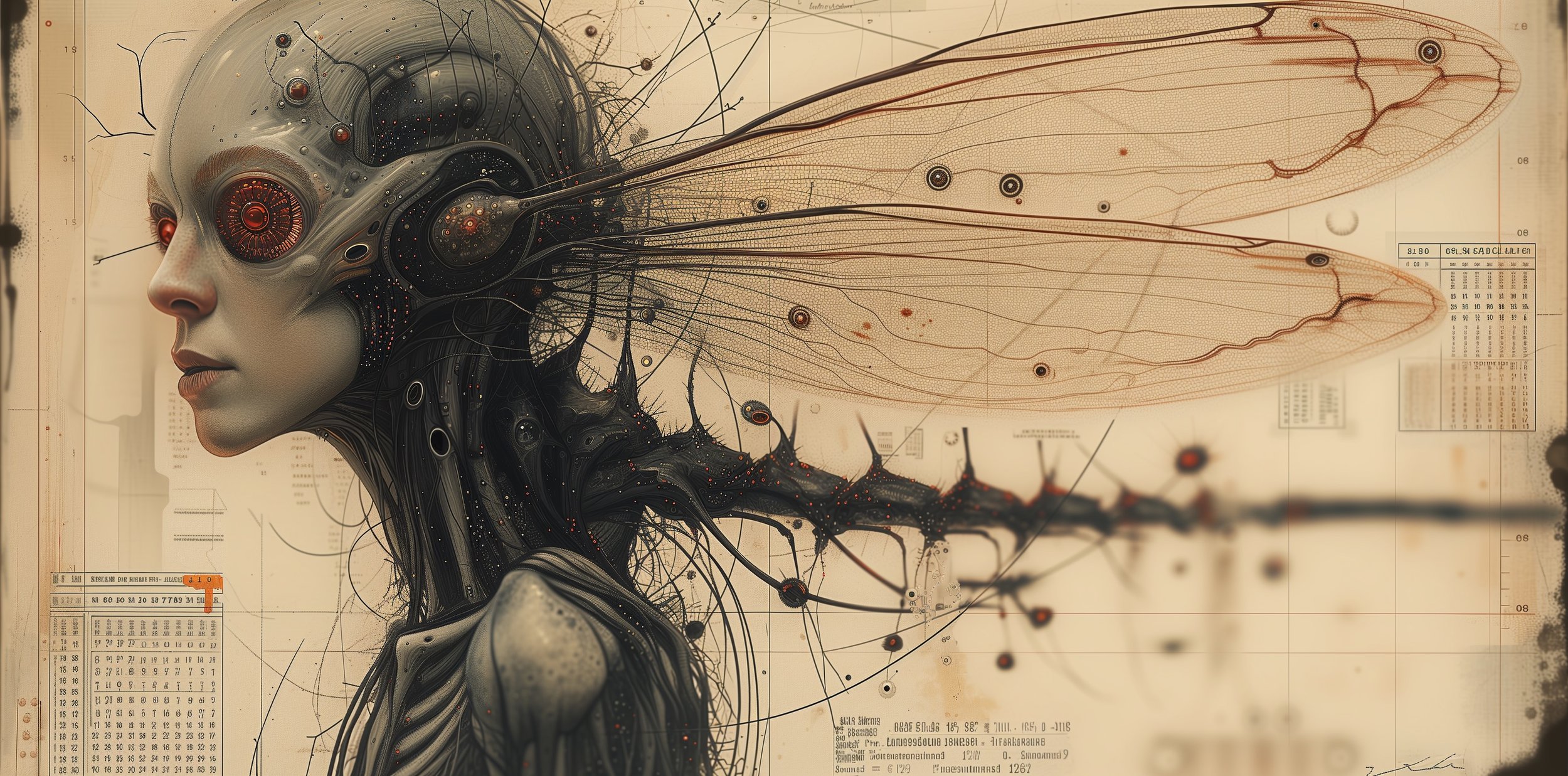
Experimental Note 098 – Visual Cortex Expansion and Wing Sensor Array
Specimen 098 presents an exceptional case of visual cortex expansion, complemented by a wide-spanning wing sensor array. The subject's ocular enhancements, indicated by the intricate, gear-like patterns around the eyes, may serve to process a broad spectrum of visual data, possibly extending into the infrared or ultraviolet ranges. The wings, though ostensibly for display, are laden with myriad sensors that resemble a complex circuitry mesh, suggesting a multifunctional role in environmental analysis and spatial orientation.
The mechanical tendrils extending from the headgear and the intertwined formations around the neck could be neural interface conduits, facilitating direct communication between the enhanced visual cortex and the wing sensors. This direct line of data transfer would allow for real-time processing and response to stimuli, giving the specimen a heightened awareness and reaction capability.
Moreover, the dorsal view of the wings shows a network of fine lines and nodes that could be akin to a built-in topographical mapping system, which, when coupled with the advanced visual apparatus, might enable the specimen to navigate or even manipulate its surroundings with remarkable precision.
This blend of organic evolution and cybernetic augmentation in Specimen 098 could be a harbinger of advanced biotic exploration drones, capable of operating in environments where traditional mechanical devices might fail. The potential for such a synthesis of form and function offers exciting possibilities for the future of biomechatronics. ∃
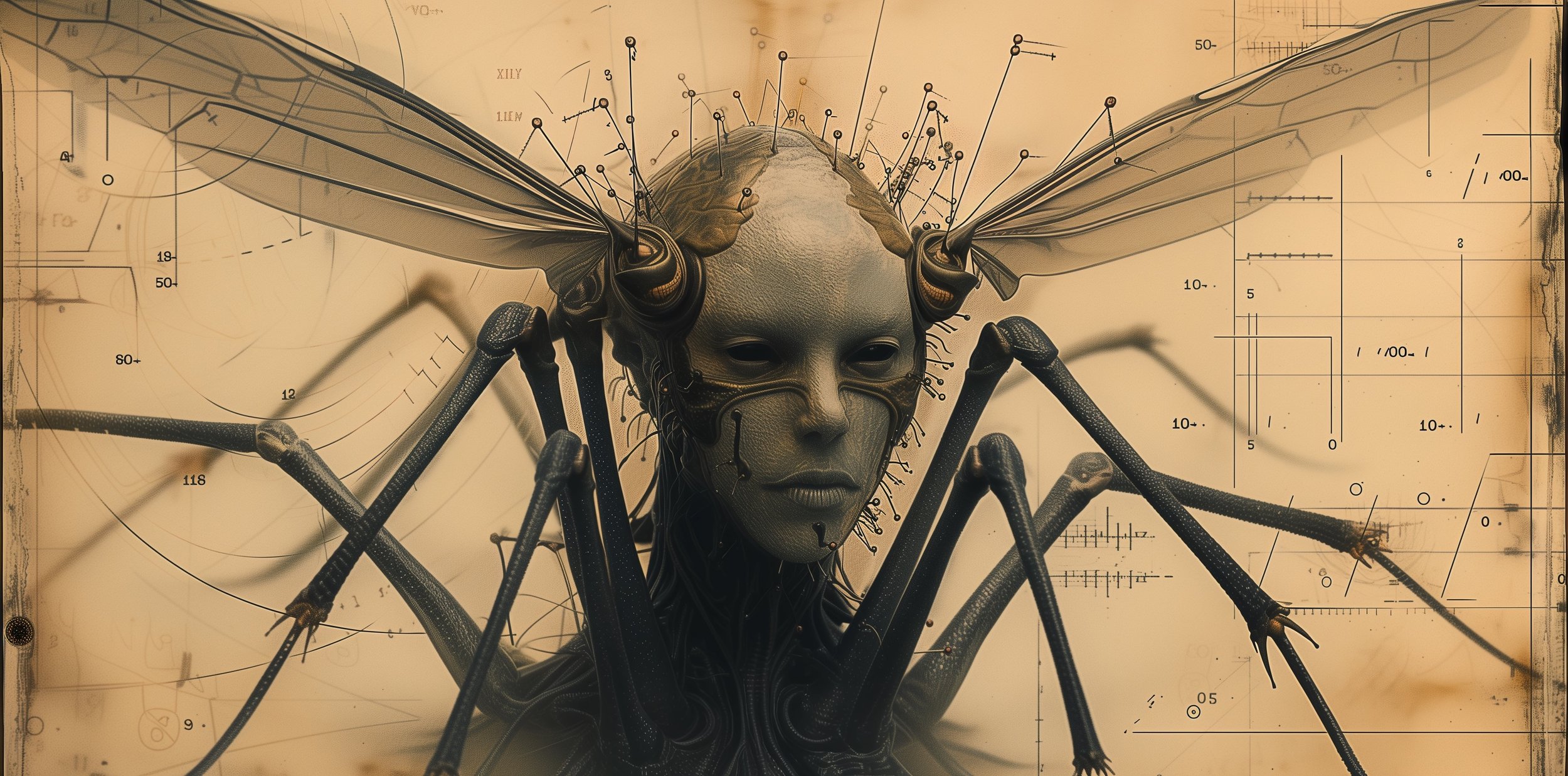
Experimental Note 099 – Synaptic Integration and Kinetic Framework
Specimen 099 advances the integration of synaptic relays and kinetic frameworks, presenting a compelling vision of biomechanical symbiosis. The central focus is the complex cranial structure, which showcases an array of synaptic connectors protruding outward, resembling an intricate crown of bio-electrical antennae. These connectors likely facilitate high-speed neural communication, granting the specimen rapid sensory processing capabilities.
The wings, while delicate and almost translucent, appear reinforced with a fine lattice of conductive filaments, suggesting they may serve a dual purpose in both mobility and sensory input, possibly translating air currents and vibrational frequencies into navigational data.
The robust exoskeletal limbs, articulated with precision joints and tendons, imply a highly adaptable kinetic framework. This allows for multi-directional locomotion and could potentially enable the specimen to interact with its environment in unconventional ways, manipulating objects with both strength and delicacy.
Specimen 099 could represent a breakthrough in adaptive prosthetics or autonomous exploration agents, capable of traversing and adapting to unpredictable terrains while maintaining a constant stream of environmental feedback to its operators or its own autonomous decision-making matrix. ∃
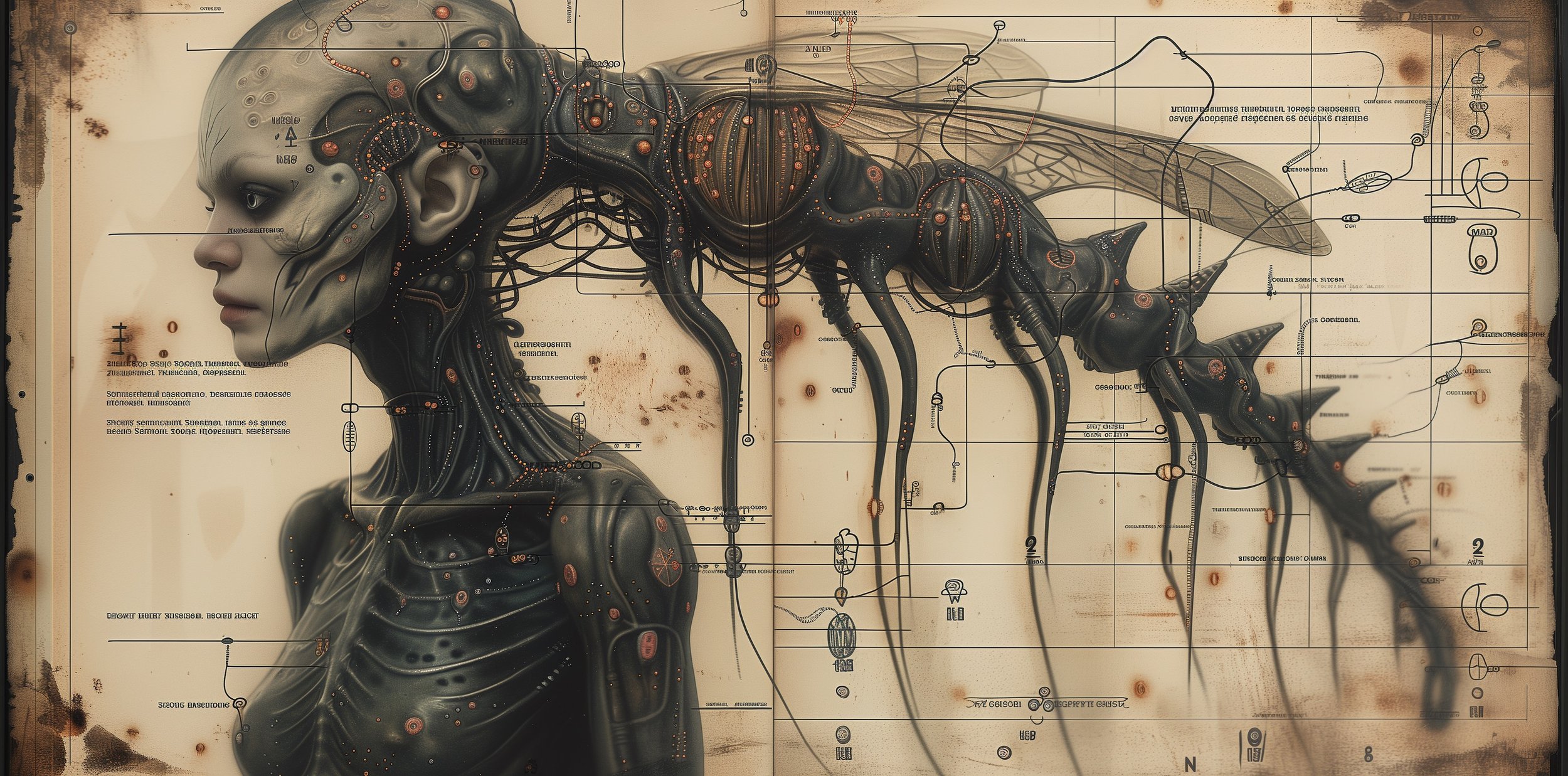
Experimental Note 112 – Neuro-Conductive Expansion and Mobility Augmentation
Specimen 112 marks an evolutionary leap in neuro-conductive expansion and mobility augmentation. The specimen's head is enveloped by an intricate matrix of neuro-conductive pathways, converging into a central hub located at the crown. This hub likely serves as a relay for cognitive processing and a distribution point for neural commands, optimizing the specimen's reflexes and motor functions.
The most striking feature is the series of elongated tendrils that extend from the central hub, each dotted with bioluminescent nodes. These tendrils may function as additional sensory appendages, capable of detecting changes in the specimen's environment, from atmospheric composition to electromagnetic fields.
The torso and limbs exhibit a seamless integration of biological and mechanical components, suggesting a symbiotic relationship between the specimen's organic tissue and its synthetic enhancements. The presence of what appears to be a secondary respiratory system could indicate a design for survival in varied atmospheric conditions, possibly even extraterrestrial environments.
Specimen 112 could represent the pinnacle of cybernetic organisms, designed for deep space exploration, capable of adapting to different planetary ecosystems with minimal equipment. Its potential applications range from advanced reconnaissance to the collection of data in environments too harsh for unmodified human explorers. ∃
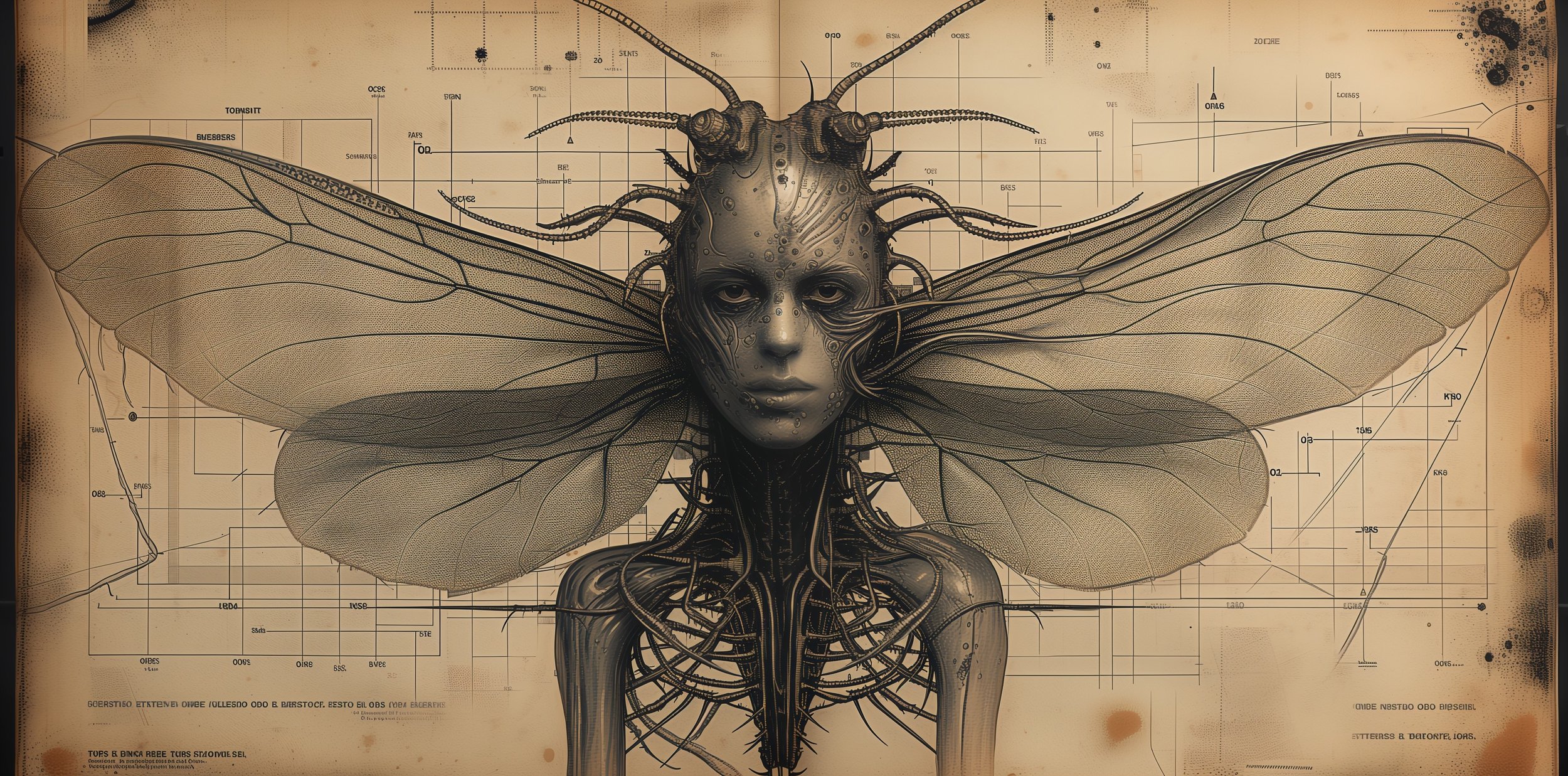
Experimental Note: Bio-mechanical Symbiosis Specimen #X091
The specimen exhibited merges organic and inorganic elements with a sophistication hitherto undocumented. Its humanoid facial structure, complete with ocular and cranial features, is intricately interwoven with biomechanical apparatuses, suggestive of a cybernetic enhancement or possibly a forced evolution. Antennae resembling lepidopteran species extend from the cranium, hinting at a hybridization of human and insectoid physiology, with wingspan measurements that defy the limitations of known terrestrial genetics. The circulatory and nervous systems appear to be seamlessly integrated with metallic-like conduits, which could indicate a form of life-support or enhancement technology. The profound intricacy of this bioengineering elicits a profound sense of wonder, as the specimen embodies a confluence of natural and synthetic processes, raising numerous ethical and existential questions regarding the boundaries of life and the application of technology in its manipulation. The potential for such a being's existence tantalizes the scientific community, promising untold advancements while challenging our fundamental principles. ∄
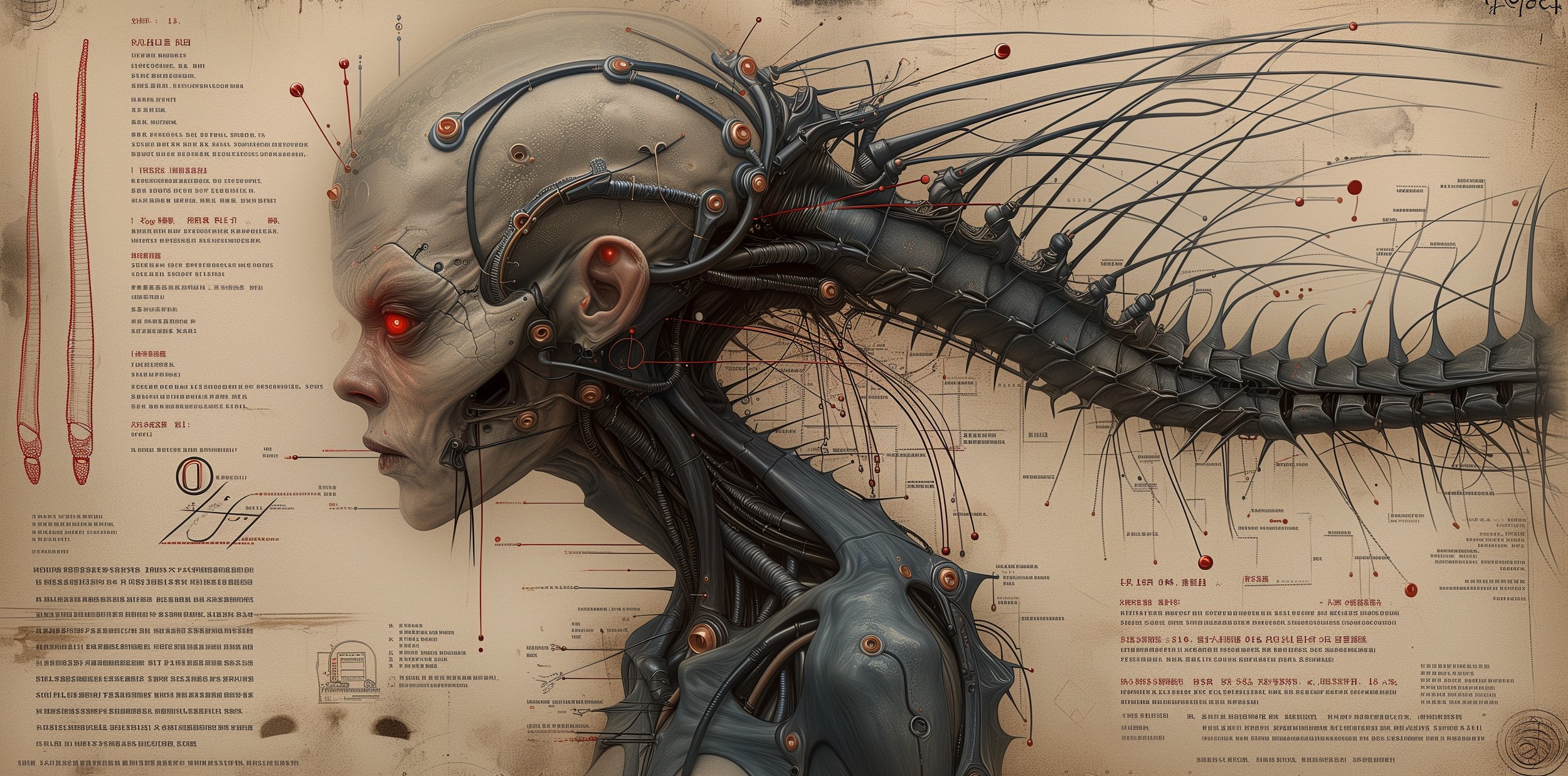
Experimental Note: Neural Interface Synthesis Model #X092
This model illustrates a revolutionary neural interface system, where synthetic and organic components are interlaced to create an advanced cybernetic organism. The skull, partially exposed, serves as a foundation for a complex network of conduits and processors that interface directly with the cerebral cortex. Red optical sensors replace the biological eyes, indicating a visual system enhanced beyond the electromagnetic spectrum normally perceivable by humans. The spinal structure has been replaced with a synthetic counterpart, featuring articulated vertebrae that house a dense network of fiber-optic cables and fluidic channels. These enhancements likely confer an unprecedented level of computational integration with the central nervous system, allowing for real-time data processing and augmented reality overlay directly into the user's sensory inputs. Such a synthesis of machine and flesh may represent a pinnacle of convergent evolution and technological advancement, leaving observers in awe of the potential capabilities and inherent ethical dilemmas. The enigma of whether such a specimen could indeed be viable, or even sentient, fuels a relentless pursuit of knowledge, albeit tinged with caution for the profound implications it would have on our understanding of consciousness and identity. ∄
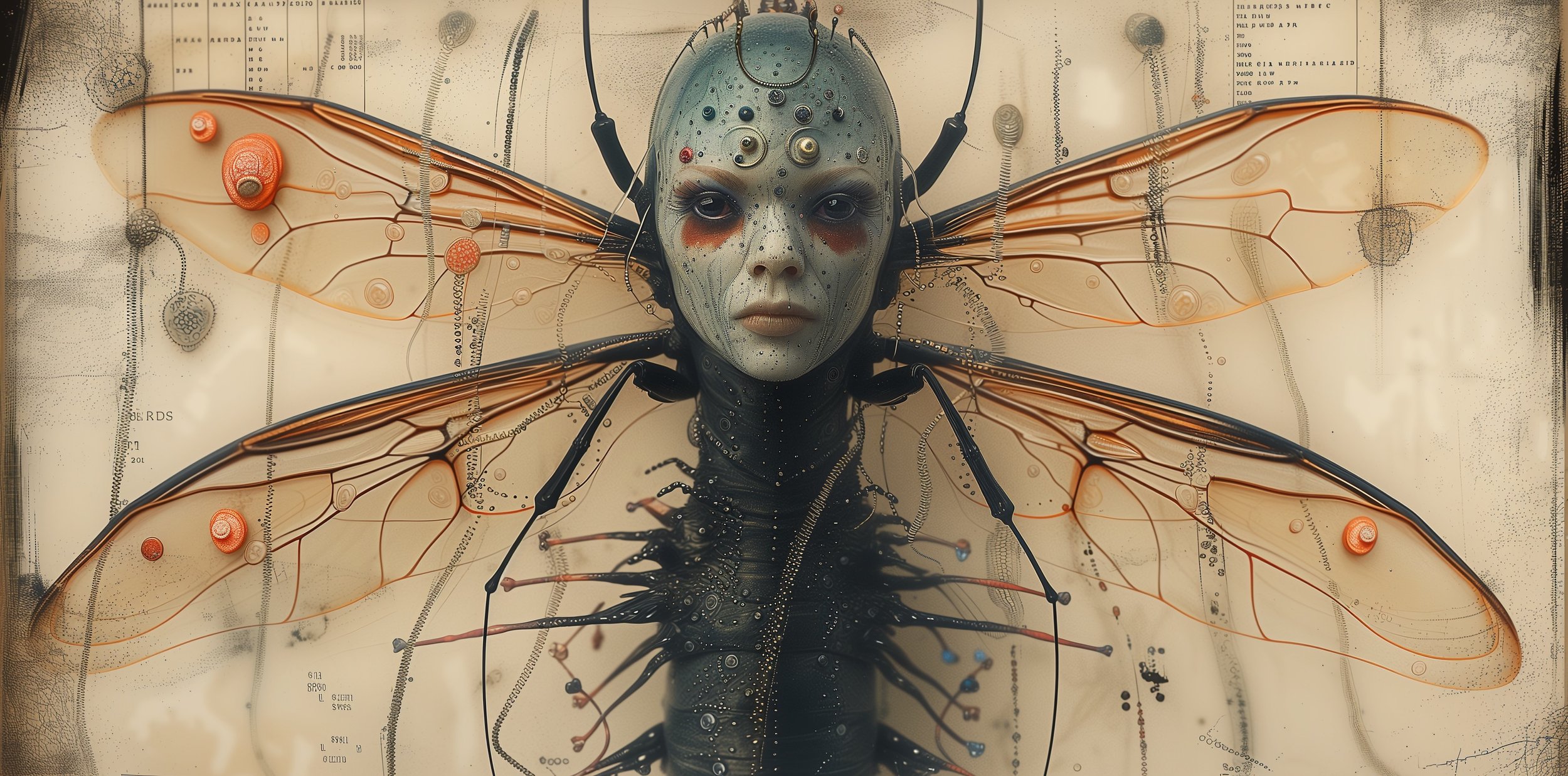
Experimental Note: Entomological Cybernetics Prototype #X093
This prototype delineates a captivating entomological cybernetic entity, showcasing a fusion of human features with insect-like appendages and sensory apparatus. The facial morphology, while reminiscent of Homo sapiens, is intricately adorned with mechanized sensory nodules and ocular enhancements, indicative of a possibly augmented perceptive capability. Expansive wings, mirroring the diaphanous qualities of a dragonfly, extend from the dorsal thoracic region, their veined structures detailed with what appear to be biomechanical actuators and control surfaces. The thorax and abdomen are encased in a chitinous exoskeleton, embedded with what could be respiratory or thermoregulatory devices, suggesting a level of environmental adaptation beyond the scope of natural evolution. The synthesis of organic and mechanical in this specimen pushes the boundaries of bioengineering, provoking both awe and inquiry into the limits of life sciences. Such a being, if real, would not only redefine biodiversity but also embody the profound capabilities of synthetic biology, igniting a fervent desire within the scientific community to explore the possibilities of such an existence. ∄
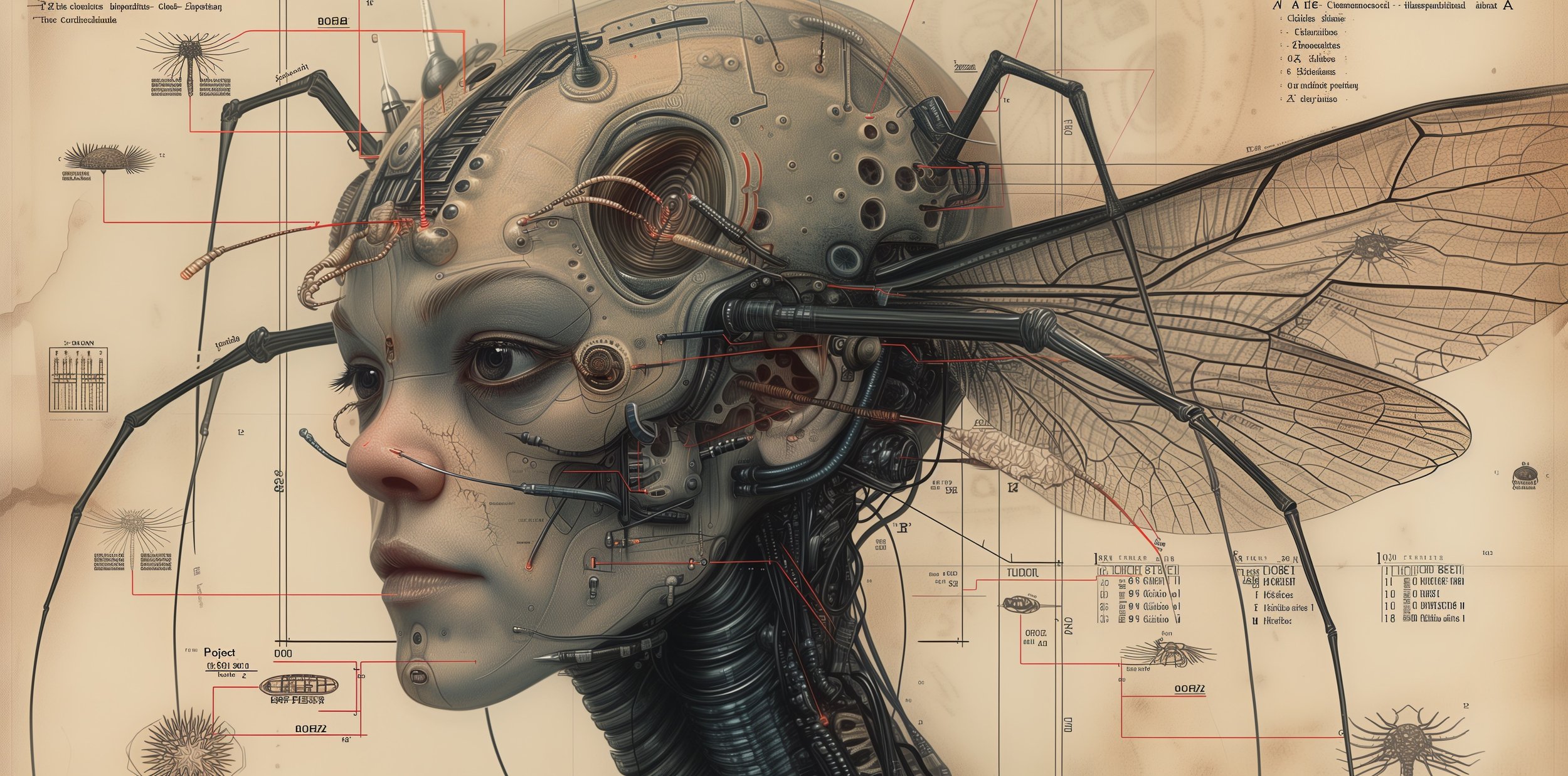
Experimental Note: Symbiotic Neuro-Enhancement Subject #X094
Portrayed here is a subject at the frontier of symbiotic neuro-enhancement, where biological intelligence is augmented through an advanced cybernetic framework. The subject's visage retains the delicate features of youth, yet is integrated with a complex matrix of neural interfaces and sensory amplifiers. Mechanical tendrils and conduits extend from the cranium, interfacing with what can be assumed as auditory and cortical regions, potentially enhancing cognitive and perceptive functions. The presence of biomechanical elements around the ocular region suggests a visual acuity beyond standard human capabilities, possibly extending into spectrums unseen by the naked eye. The integration appears to be meticulously engineered, with the intention of preserving the essence of the individual while exponentially expanding their neurological capacity. This depiction evokes a deep curiosity regarding the interplay between human consciousness and artificial augmentation, and the uncharted potentials such a union might unlock. The existence of such a being would not only shatter current paradigms in neuroscience but also spark an insatiable desire to explore the cognitive cosmos that lies within. ∄

Experimental Note: Genetically Engineered Lepidopteran Humanoid #X095
The subject before us is a genetically engineered humanoid with pronounced lepidopteran characteristics, epitomizing a radical leap in genetic splicing technologies. The entity's face, while distinctly human, is fused with sensory and optical enhancements that may provide a spectrum of visual abilities akin to those of certain butterfly species, known for their complex vision. Antennae, a hallmark of insect morphology, protrude from the head, suggesting heightened sensory capabilities. The wings, vast and membranous, closely resemble those of a Monarch butterfly, not only in their sheer size and shape but also in their biomechanical reinforcement, which could potentially enable flight or serve as solar collectors. The intricate patterning of the wings suggests a meticulous design, possibly for camouflage or communication through an advanced form of bio-luminescence or chromatic signaling. This fusion of human genetics with those of a butterfly creates a profound sense of amazement, as it pushes the boundaries of synthetic biology into realms once thought to be the domain of myth and legend. The implications of such an organism's existence pose as many questions as they do answers, driving scientific curiosity towards the limits of life's malleability. ∄

Experimental Note: Insectoid Neural Enhancement Subject #X096
This subject is a profound example of insectoid neural enhancement, incorporating biomechanical elements into a humanoid anatomy. Notable are the cranial appendages resembling the horns of a beetle, which may serve as conduits for sensory augmentation or communication. The subject's eyes and surrounding tissue are intertwined with delicate cybernetic enhancements, potentially granting enhanced visual acuity or additional sensory modalities. Thin, filament-like structures extend from the head and back, possibly mimicking the antennae and delicate wings of a damselfly, suggesting a blend of balance and sensory functions. The fine network of capillaries visible across the skin surface is juxtaposed with mechanical attachments, highlighting a symbiotic relationship between organic and synthetic components. The sheer complexity of the enhancements evokes a deep intrigue about the capabilities and experiences of such an entity, as well as the profound scientific advancements that its existence would represent. The pursuit of understanding such a creature's ecology, behavior, and physiology drives a passionate scientific inquiry, underscored by the realization of the tremendous potential that lies in the fusion of biology and technology. ∄
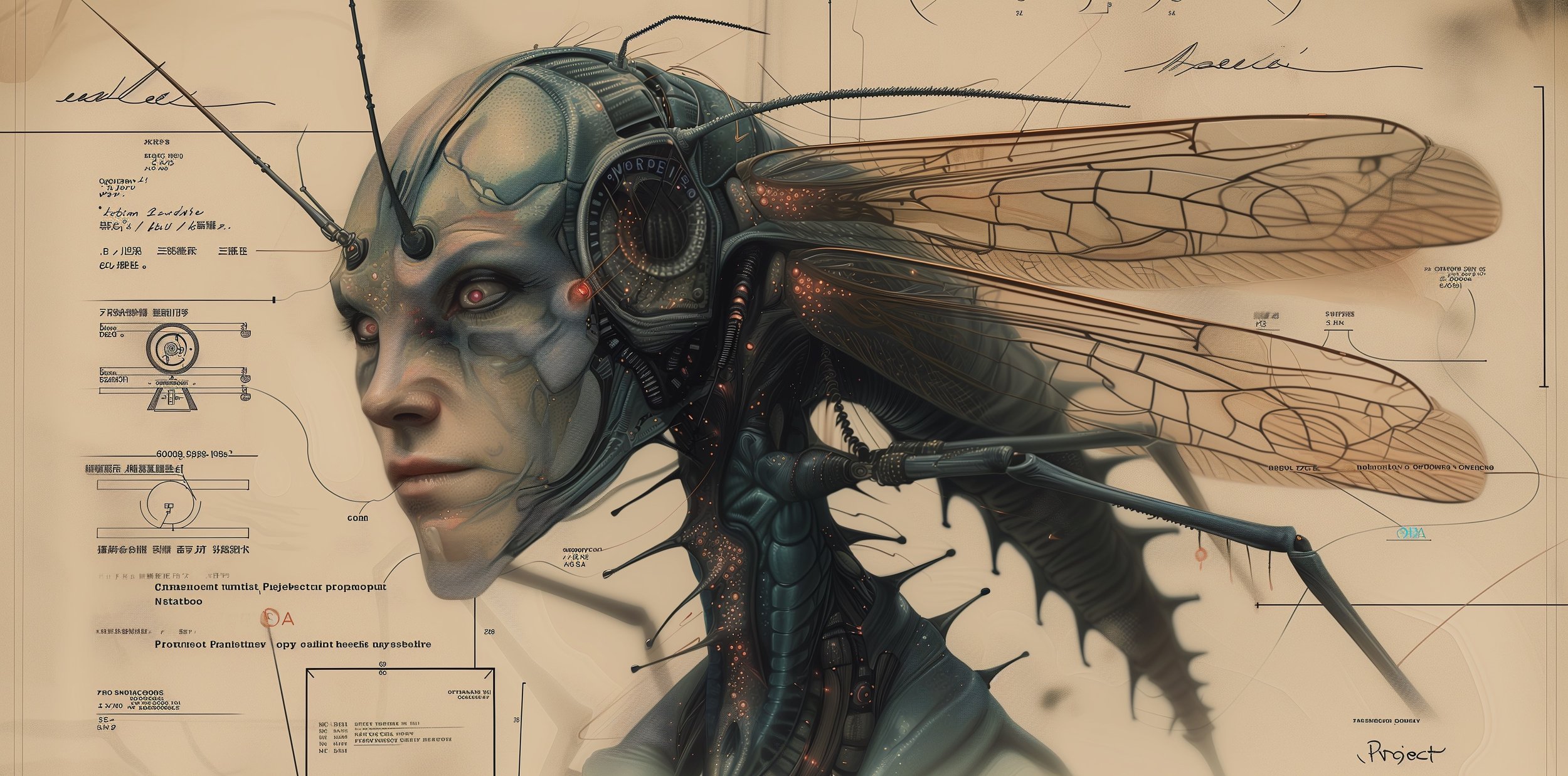
Experimental Note: Advanced Insectoid Auditory Specimen #X097
Encapsulated within this specimen is the embodiment of an advanced auditory system, where insectoid biology is intricately augmented with cybernetic enhancements. The subject's lateral head region is dominated by an elaborate auditory sensor, presumably capable of detecting frequencies far beyond the human range. Organic structures, suggestive of tympanal organs found in insects, are interlaced with mechanical components, hinting at a hybrid sensory apparatus with possibly unparalleled acoustic resolution. The long, hair-like antennae, a characteristic feature in insects for detecting vibrations, are present and likely enhanced for heightened sensitivity. The wings, though present as a structural background, do not show the biomechanical integration seen in the auditory features, suggesting a specialization in this organism’s evolution or design. This fusion of the organic auditory capacities with technological amplification inspires wonder at the potential applications and stimulates a keen scientific interest in the possibilities of sensory expansion. The theoretical existence of such a creature propels a wave of excitement about the frontiers of bioengineering, imagining the symphonies of sound it might perceive. ∄

Experimental Note: Biomechanical Lepidopteran Humanoid Concept #X098
This concept presents a biomechanical humanoid with distinctive lepidopteran traits, an intriguing convergence of entomology and advanced robotics. The humanoid's cephalic region is adorned with numerous biomechanical implants, including raised nodules that could function as multifaceted sensory receptors. Central to the design are the elaborate wing structures, expansive and detailed with patterns that suggest both organic and synthetic fabrication, perhaps serving purposes beyond flight such as energy absorption or environmental interaction. The thoracic assembly is a robust network of bioengineered conduits, possibly a support matrix for the wing apparatus, also hinting at a complex internal system for respiratory or energetic functions. The embodiment of such traits ignites the scientific imagination, questioning the limits of genetic and robotic integration while providing a canvas for hypothesizing about the functionalities of such a being. The prospect of encountering or even creating an entity with these capabilities stirs a fervent curiosity, driving the pursuit of knowledge into the realm where life and machine intersect. ∄
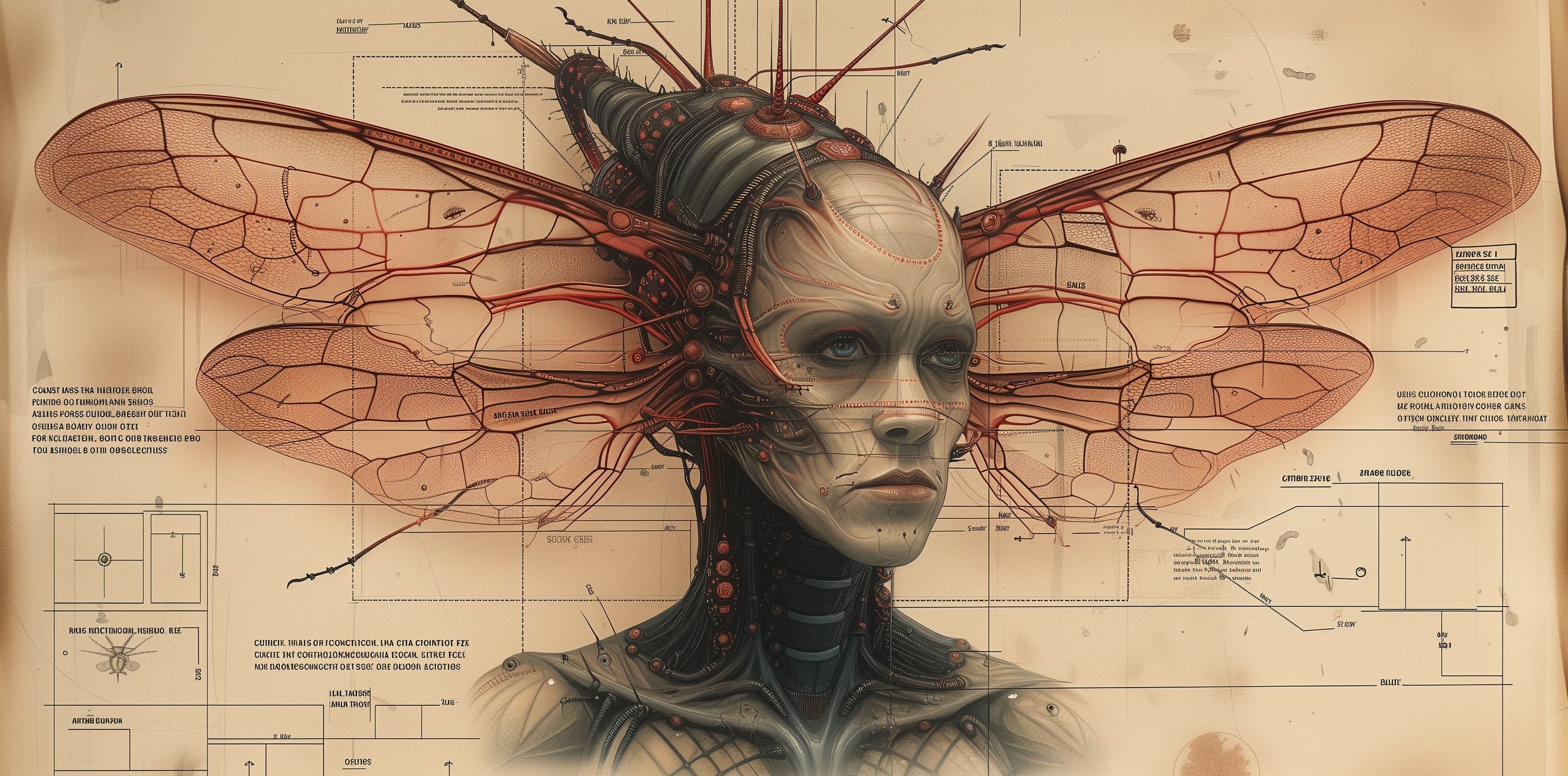
Experimental Note: Hemolymphatic Cybernetic Integration Specimen #X099
This specimen is a stunning representation of hemolymphatic cybernetic integration, a design that merges the human form with the complex vascular system of an insect. The subject's head is adorned with an elaborate array of biomechanical tendrils, mirroring the antennae and branching veins typical of insect wings. The vibrant red lines coursing over the wings and throughout the headpiece are reminiscent of insect hemolymph channels, which in this context, could be engineered to transport nutrients or nanomachines throughout the organism. The serene, humanoid facial expression provides a stark contrast to the extensive mechanical integration, suggesting a tranquil sentience within a framework of extraordinary biomechanical complexity. This design challenges the observer to ponder the symbiotic potential of organic and inorganic systems, and the profound implications of such entities if they were to exist outside the realm of theoretical speculation. It captures a sense of marvel at the seamless integration of two disparate life forms and the potential for such a creature to exist at the intersection of biology and technology. ∄
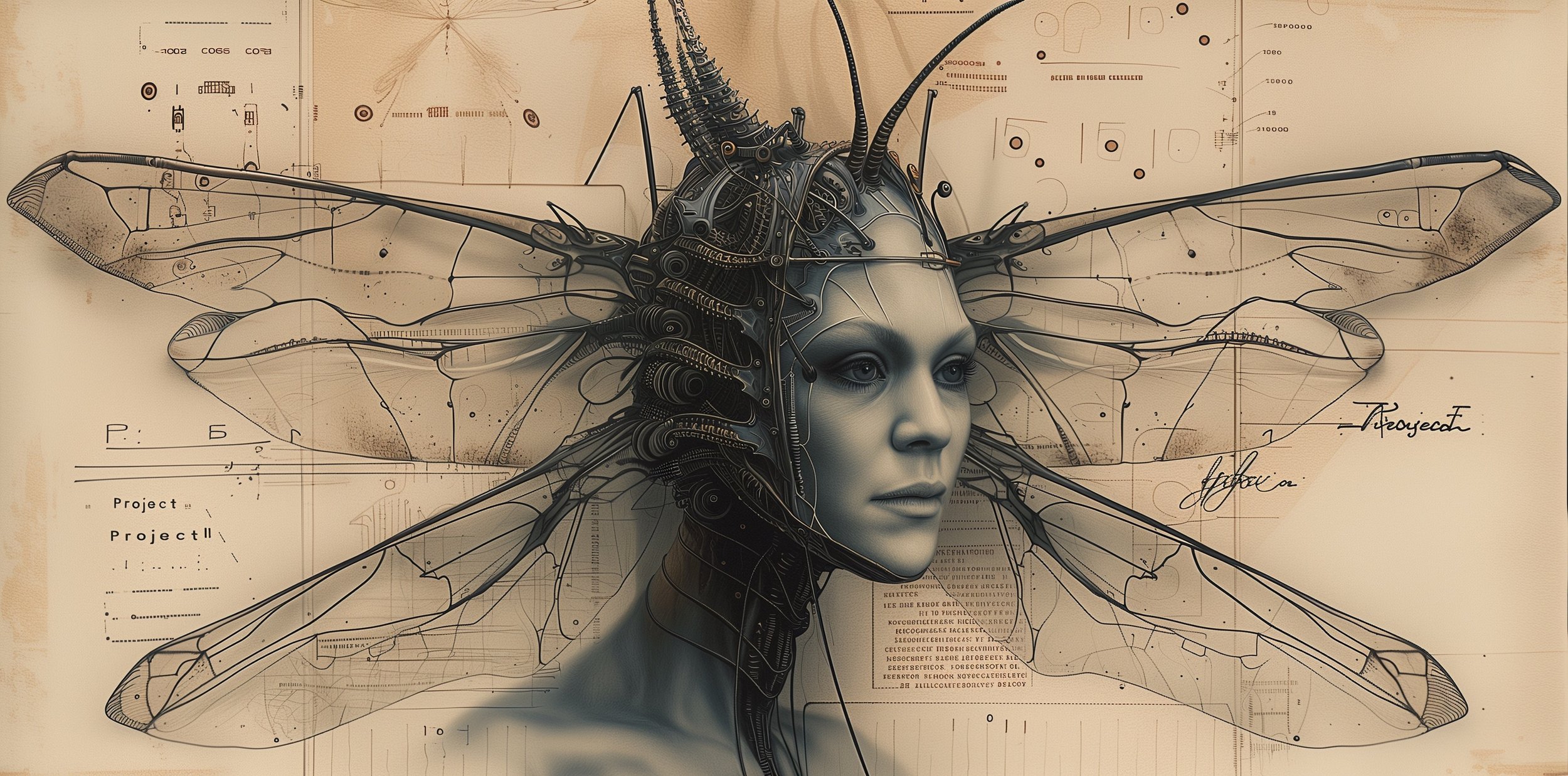
Experimental Note: Cyber-Lepidopteran Fusion Model #X100
This model is a visualization of cyber-lepidopteran fusion, where the beauty of the humanoid form is married with the natural elegance of butterfly wings. The subject's head is crowned with a complex array of mechanical structures, evocative of the elaborate headgear that insects such as moths and butterflies possess, likely serving as both a sensory array and a communication hub. The wings, illustrated with mechanical precision, span gracefully from the figure's back, detailed with schematics that suggest they are capable of precise, controlled movements. The integration of the mechanical elements with the subject's tranquil and almost meditative expression offers a surreal juxtaposition, conjuring an image of serenity amid a maelstrom of scientific innovation. This representation blurs the lines between the organic and the artificial, creating a sense of intrigue and wonder about the technological advances that could make such a synthesis possible. The possibility of such a creature raises as many questions about the ethics of creation as it does about the technical prowess required for its realization. ∄
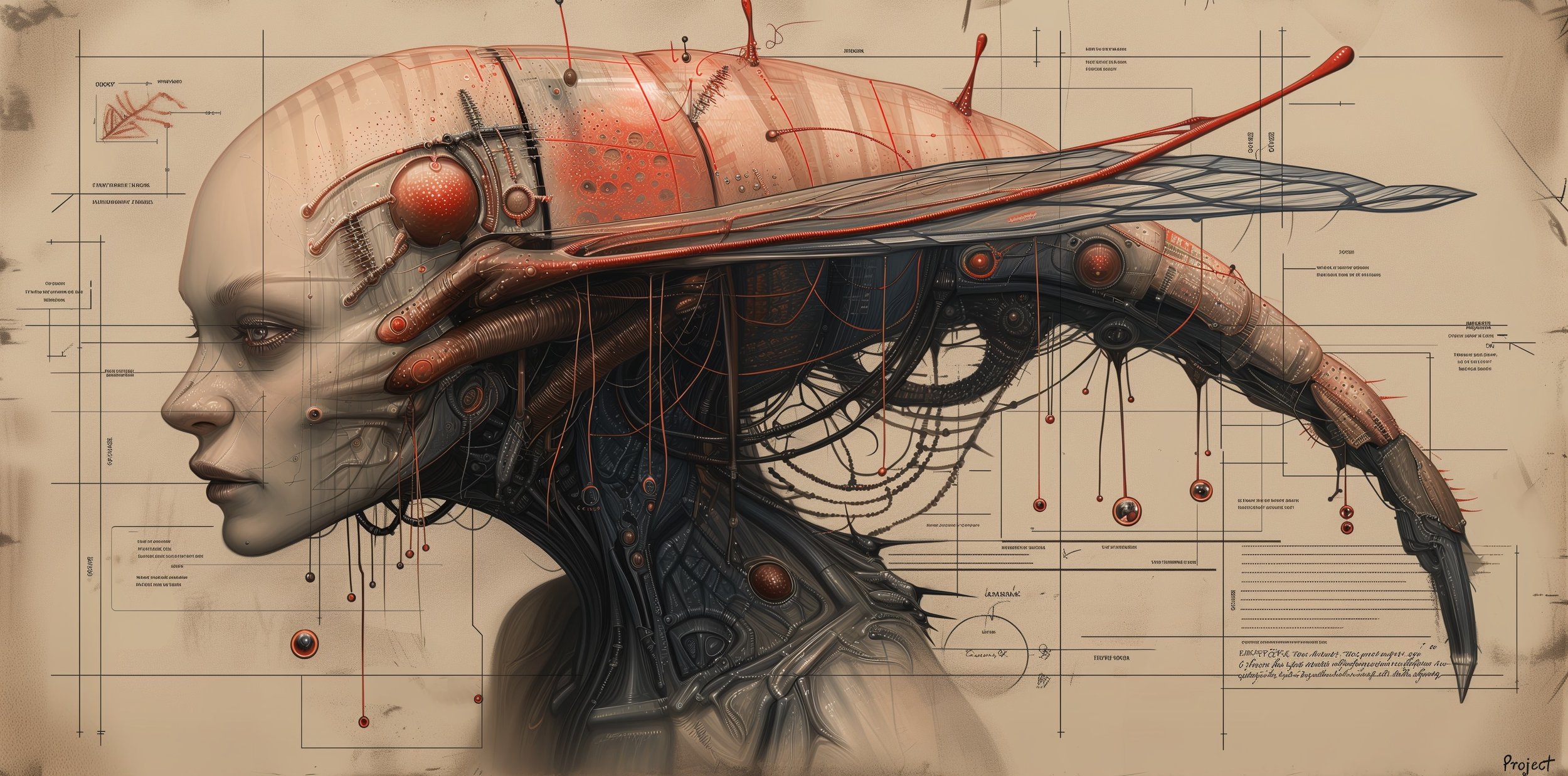
Experimental Note: Cybernetic Cranium Exoskeleton Prototype #X101
Here, we behold a prototype for a cybernetic cranium exoskeleton, blending human features with high-tech armor and sensory apparatus. The right hemisphere of the subject's head is covered by a sleek, contoured metallic shell, with hues of burnished red and exposed circuitry, which may serve as protective gear or an integrated computational device. Delicate wires and sensors weave into the skin, connecting to neural pathways, suggesting enhanced cognitive functions or direct neural interfacing. Protruding from the headgear are antennae-like rods, possibly serving as receivers or transmitters for communication or environmental sensing. This concept stretches the imagination, postulating a future where human and machine not only coexist but are intimately linked, raising poignant questions about identity and augmentation. The meticulous detail of the design inspires a sense of wonder at the intricacies of such a union, and curiosity about the potential for a human experience augmented by such profound technology. ∄

Experimental Note: Auditory and Neurological Cybernetic Augmentation Model #X106
The subject depicted exemplifies an extraordinary level of auditory and neurological cybernetic augmentation. A sophisticated auditory apparatus envelops the ear, with wires that extend into the cranial region, suggesting enhancements that could allow for an expanded range of sound detection, including frequencies beyond the human auditory spectrum. The head is partially encased in a structured, helmet-like exoskeleton, with a network of red lines that could represent either the flow of data or a cybernetic replication of blood vessels. These lines interconnect with various nodules on the scalp and neck, implying a comprehensive system designed to augment cognitive functions or to interface with external devices. This model presents a profound vision of the integration of human senses with advanced technology, promising not only a revolution in personal sensory experience but also in communication and information processing. ∄
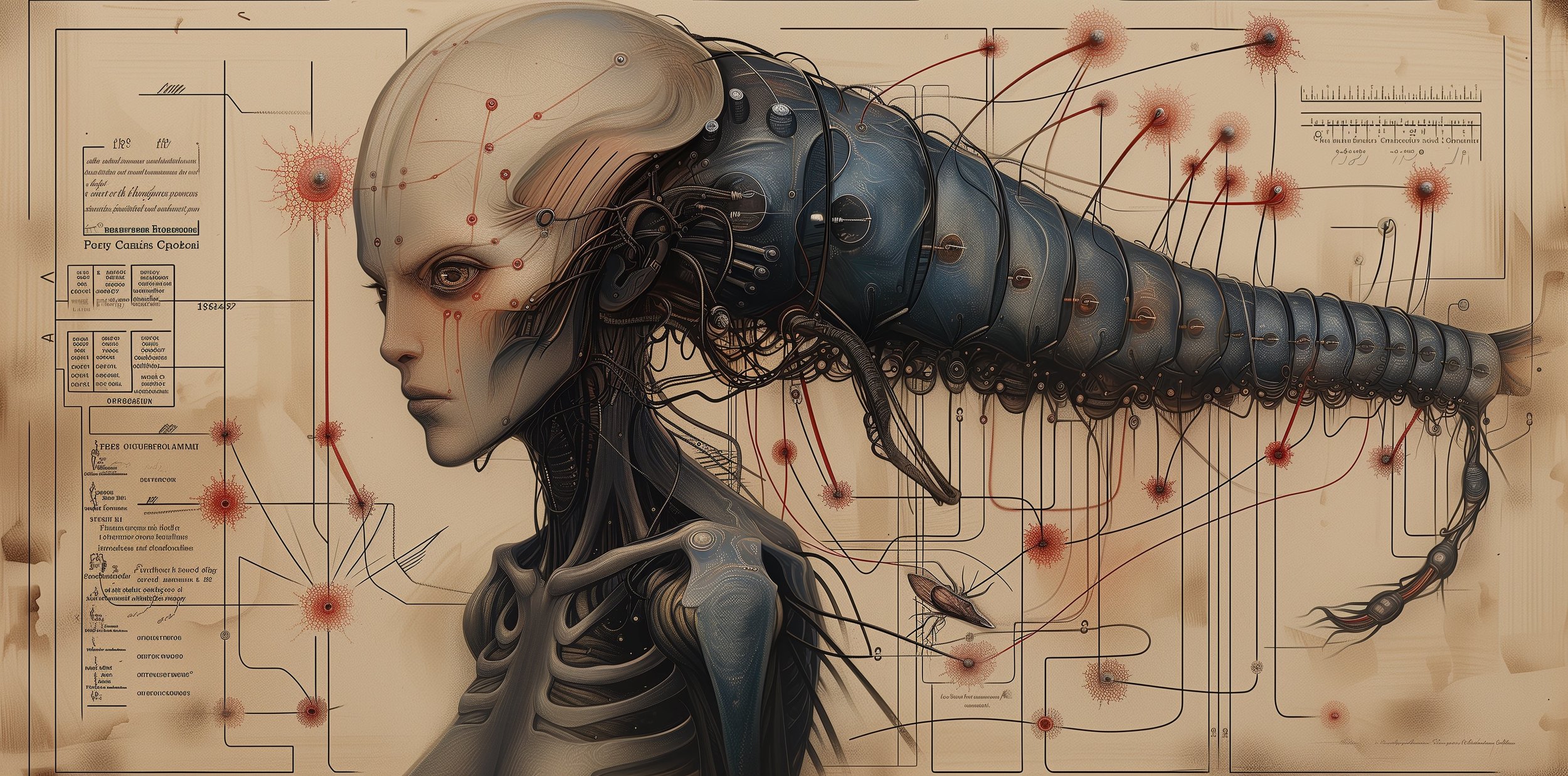
Experimental Note: Extended Cognitive Relay Apparatus #X107
The apparatus featured in this profile suggests an extended cognitive relay system, offering an unprecedented merger of human physiology with an advanced technological framework. The subject's cranium is extended into a sleek, articulated exoskeleton, reminiscent of the streamlined form of marine creatures, which could house an array of processors and neural interfaces. The presence of numerous illuminated points and connections along the structure implies a complex network for enhancing neural communication and cognitive processing. Such a device may be capable of augmenting mental capacity or providing direct interfacing with external databases and networks. This model illustrates the potential for expanding the human mind beyond its natural confines, into a realm where thought and artificial computation are indistinguishable. ∄
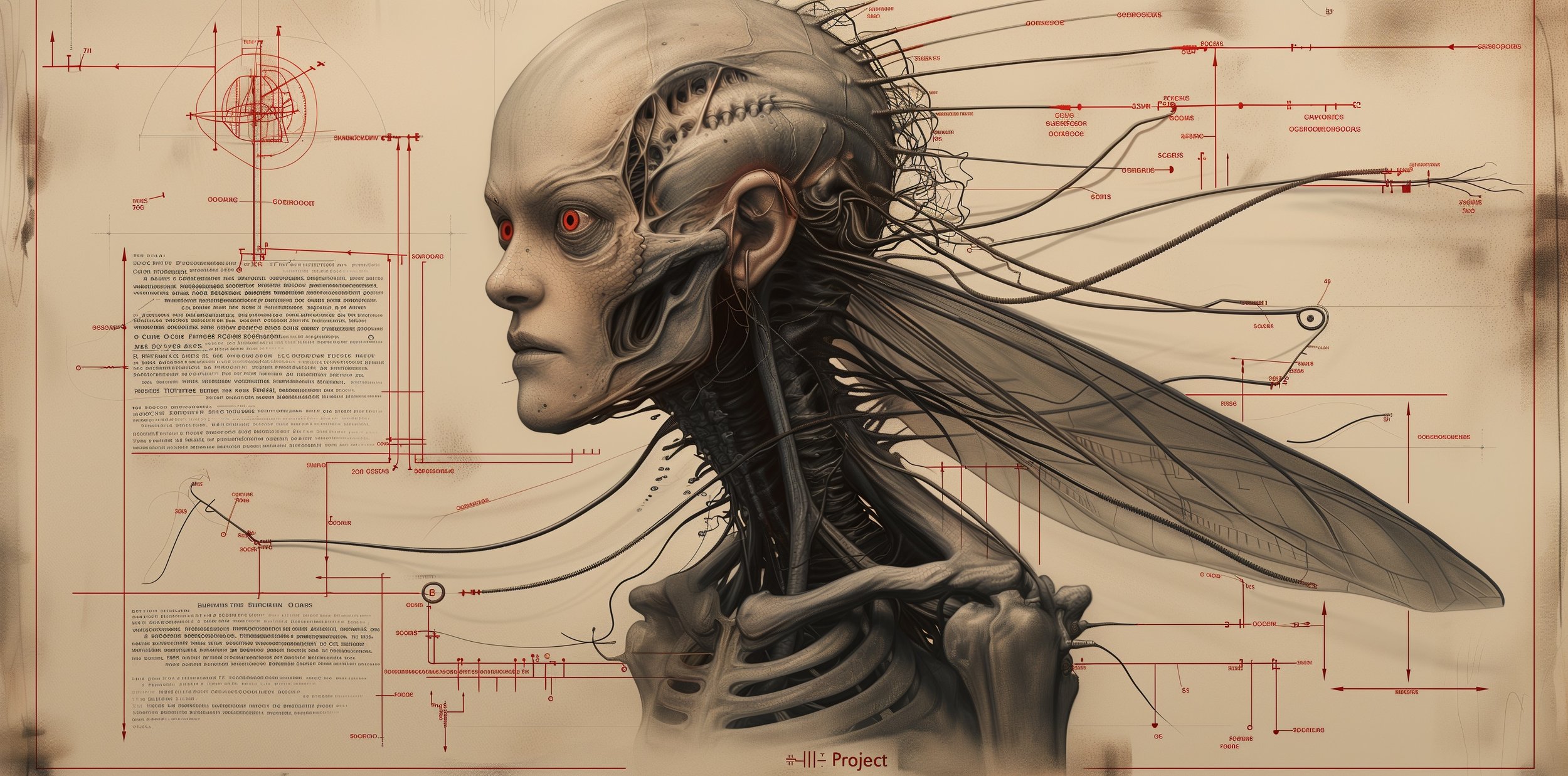
Experimental Note: Advanced Biomechatronic Interface Model #X104
Presented is an advanced biomechatronic interface model, characterized by an extensive fusion of human anatomy with mechanical sophistication. The subject's head and neck anatomy is laid bare, overlaid with a network of sinewy cables and support structures that seem to emulate and extend the nervous and vascular systems. The striking red eyes suggest visual enhancements, perhaps granting capabilities beyond the human spectrum. Mechanical tendrils radiating from the neck and skull are indicative of a deeply integrated system, potentially designed to augment physical and neural functions, or to serve as conduits for data transmission and processing. This amalgamation of flesh and machine explores the frontier of augmentative technology, challenging our perceptions of the limitations of the human body and the potential for future cybernetic evolution. ∄
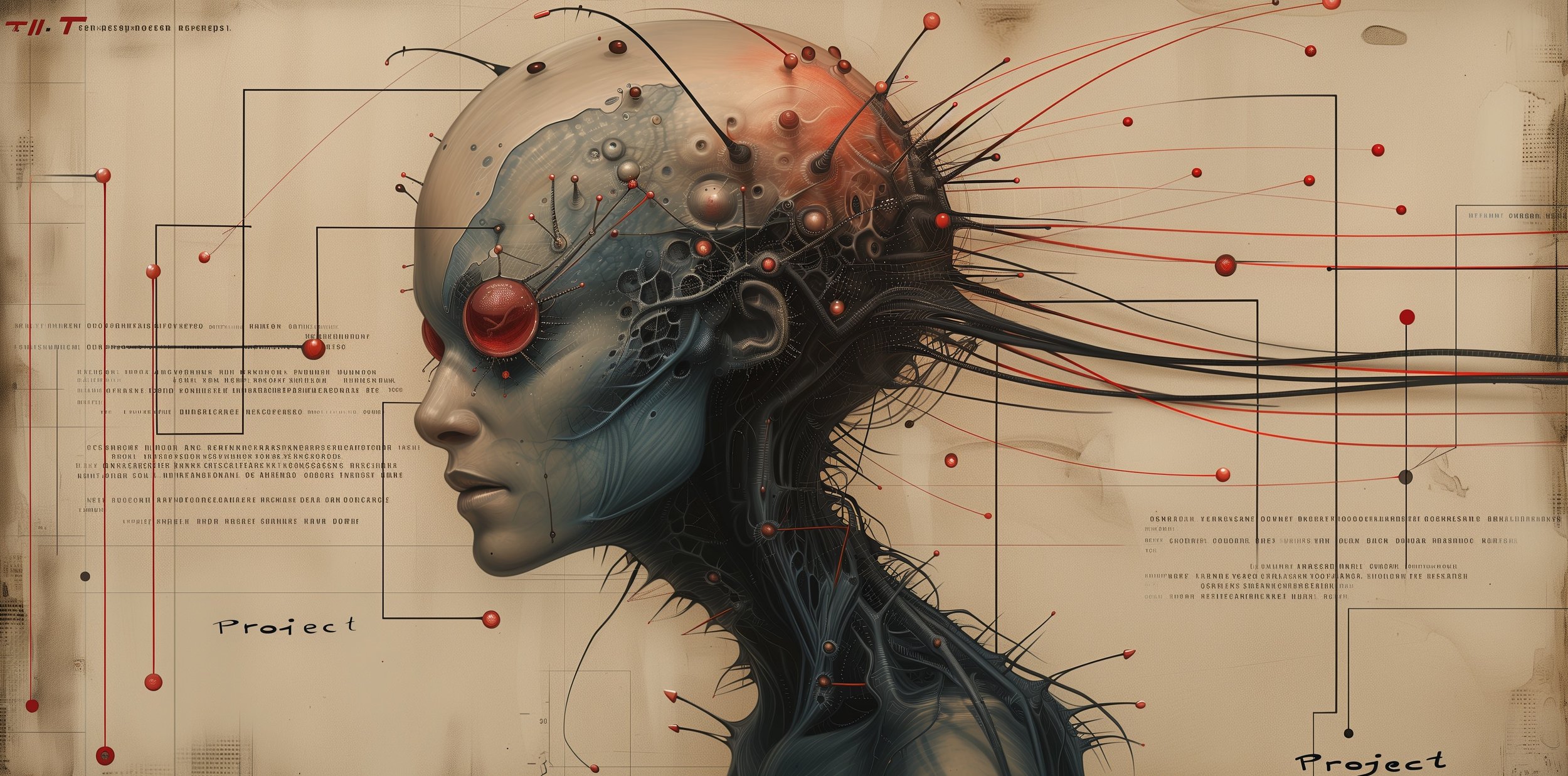
Experimental Note: Ocular Cybernetic Enhancement Design #X105
This design envisions an ocular cybernetic enhancement, a visionary synthesis of human anatomy with state-of-the-art sensory technology. The profile view of the subject showcases a single, prominent red eye, possibly implying a multifunctional visual apparatus capable of extraordinary perception or data processing. The side of the head and temple are fitted with a metallic plate, peppered with nodes and connectors that spread across the scalp like a high-tech crown. These intricate pathways might represent an interface for neural integration or a conduit for augmented reality inputs. The inclusion of such advanced technology within the biological structure suggests potential applications in fields ranging from enhanced vision to neural computing. The design's complexity captivates with its blend of organic form and mechanical precision, illustrating the boundless potential of cybernetic enhancements. ∄
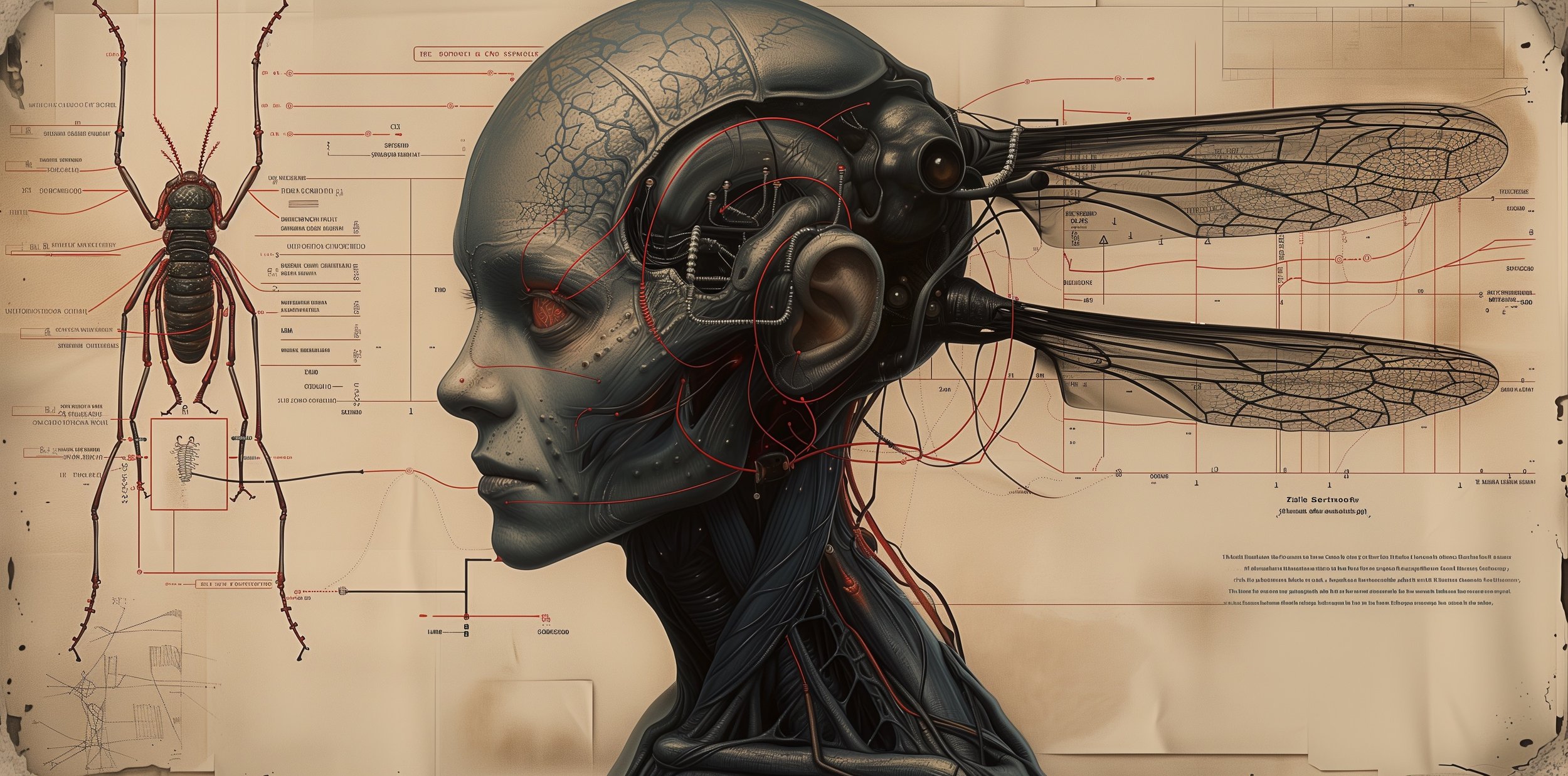
Experimental Note: Auditory and Neurological Cybernetic Augmentation Model #X106
The subject depicted exemplifies an extraordinary level of auditory and neurological cybernetic augmentation. A sophisticated auditory apparatus envelops the ear, with wires that extend into the cranial region, suggesting enhancements that could allow for an expanded range of sound detection, including frequencies beyond the human auditory spectrum. The head is partially encased in a structured, helmet-like exoskeleton, with a network of red lines that could represent either the flow of data or a cybernetic replication of blood vessels. These lines interconnect with various nodules on the scalp and neck, implying a comprehensive system designed to augment cognitive functions or to interface with external devices. This model presents a profound vision of the integration of human senses with advanced technology, promising not only a revolution in personal sensory experience but also in communication and information processing. ∄
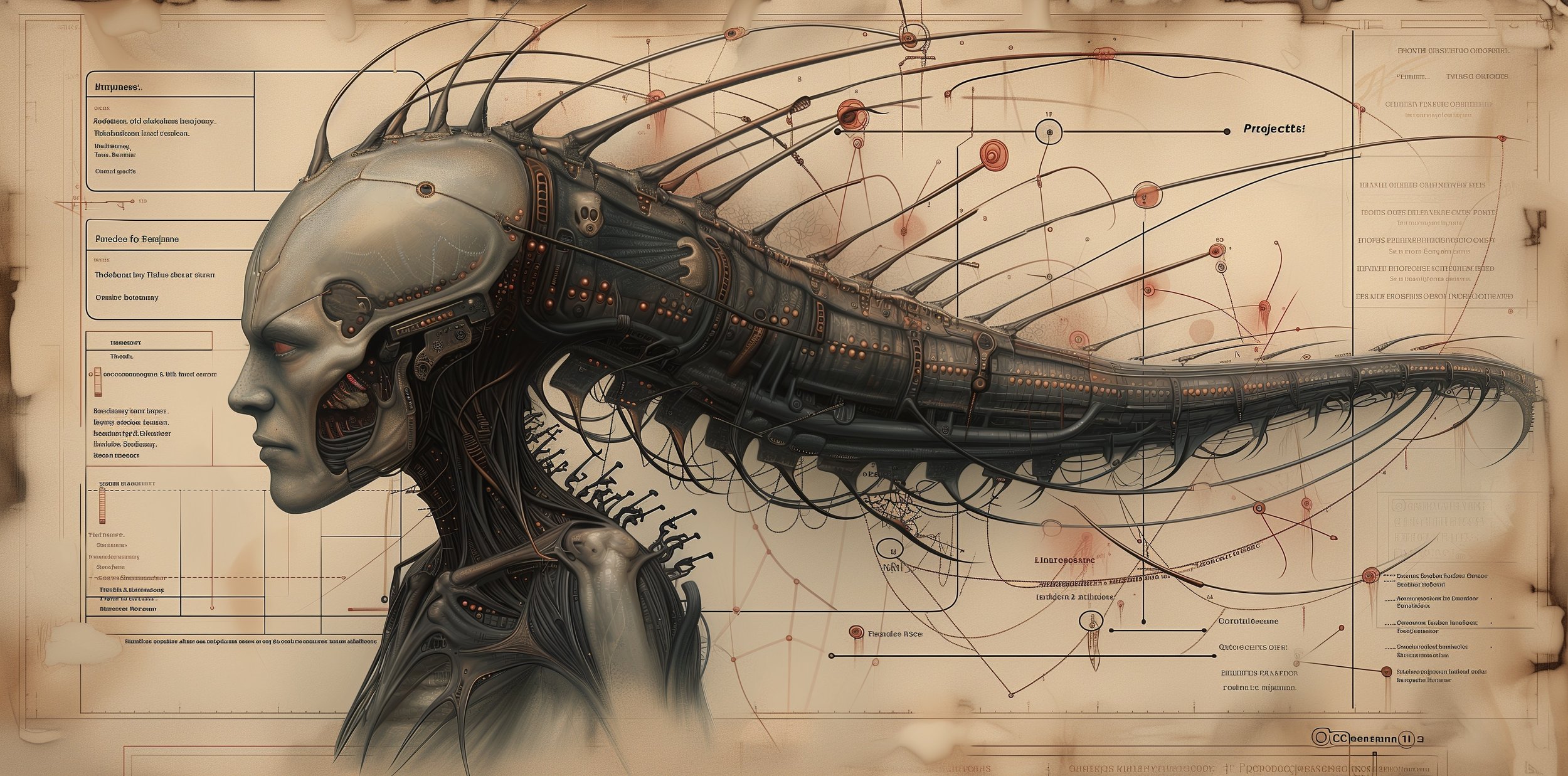
Experimental Note: Extended Cognitive Relay Apparatus #X107
The apparatus featured in this profile suggests an extended cognitive relay system, offering an unprecedented merger of human physiology with an advanced technological framework. The subject's cranium is extended into a sleek, articulated exoskeleton, reminiscent of the streamlined form of marine creatures, which could house an array of processors and neural interfaces. The presence of numerous illuminated points and connections along the structure implies a complex network for enhancing neural communication and cognitive processing. Such a device may be capable of augmenting mental capacity or providing direct interfacing with external databases and networks. This model illustrates the potential for expanding the human mind beyond its natural confines, into a realm where thought and artificial computation are indistinguishable. ∄
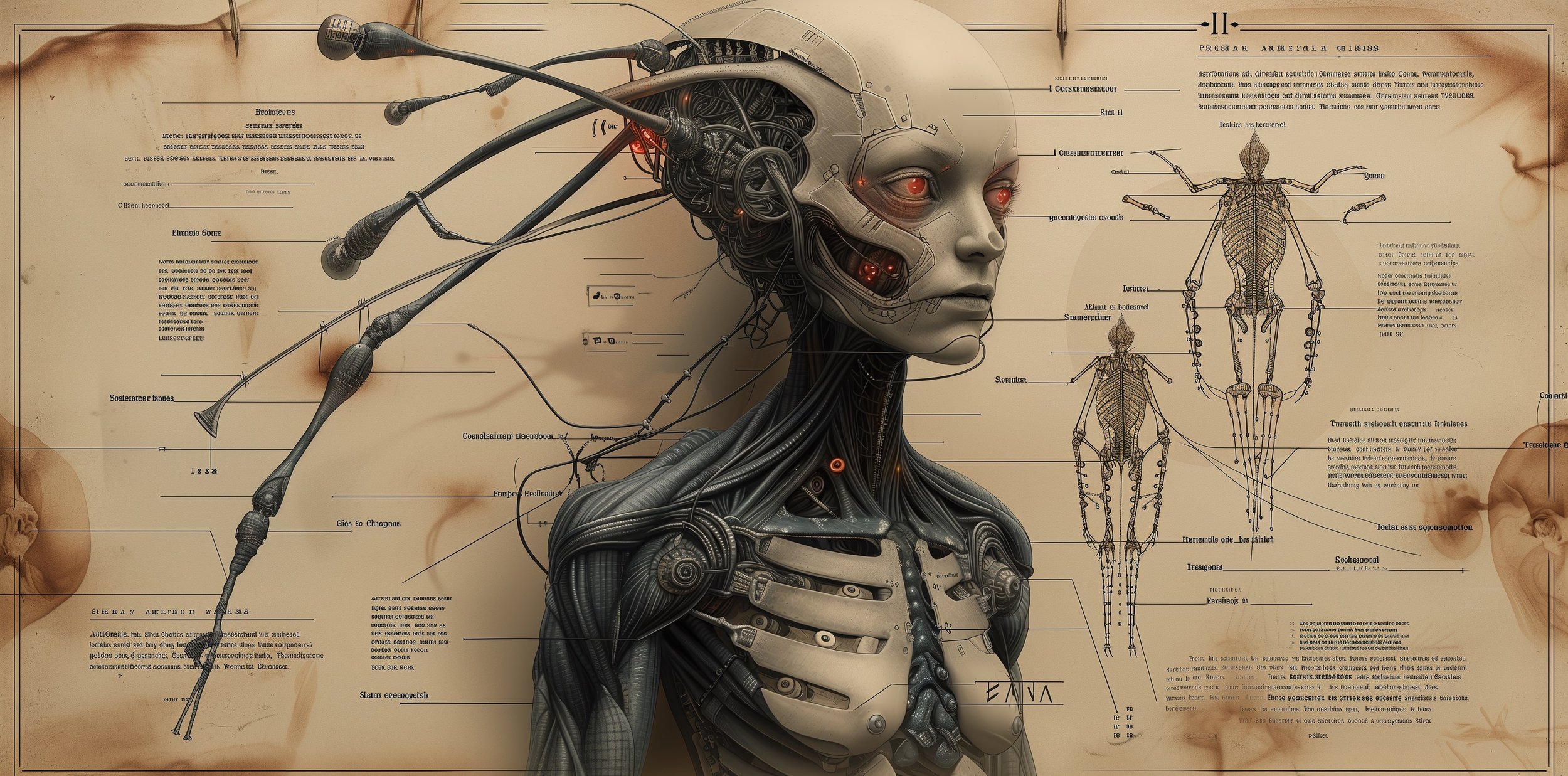
Experimental Note: Multifunctional Neuro-Interface Apparatus #X108
In this configuration, we observe a multifunctional neuro-interface apparatus, an innovative construct aiming to merge human neurology with versatile technological applications. The head of the subject is outfitted with a complex arrangement of articulated booms and sensory modules that extend outward, indicating a multi-directional interface capability. Red-lit eyes and similar illuminated points on the modules suggest enhanced visual and sensory processing or a scanning function. The booms, attached to various neural linkage points on the scalp, imply dynamic interaction with external devices or the augmentation of sensory and cognitive functions. This depiction pushes the frontier of bioengineering, showcasing how a human could interface with multiple streams of data and control mechanisms, potentially leading to breakthroughs in human-machine interaction and sensory augmentation. ∄
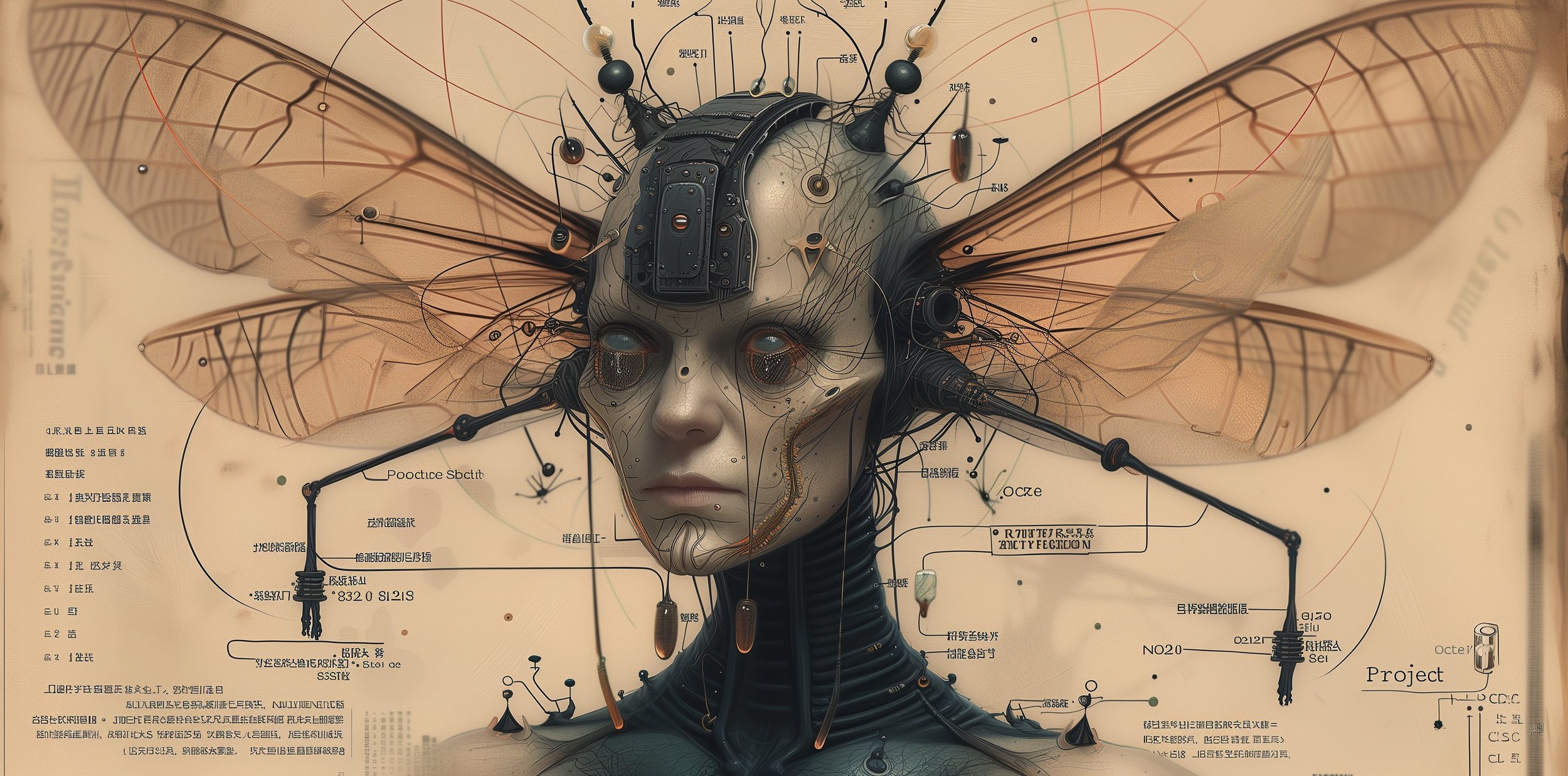
Experimental Note: Bio-Informatics Interface Prototype #X109
The prototype displayed integrates bio-informatics technology with a humanoid figure, crowned by a helmet-like device bristling with antennae, each likely serving as a data reception or transmission point. The inclusion of delicate, insect-like wings, subtly etched with circuit patterns, suggests a symbolic representation of the potential for flight, or more abstractly, the ascension of human capabilities through technology. With eyes that resemble intricate machinery rather than organic tissue, this figure might be envisioned as a navigator of vast data streams, embodying the fusion of biological essence and digital information. This image challenges our understanding of what it means to be human in an era of ubiquitous technology and proposes a future where our physical form may become the interface through which we engage with the ever-expanding digital universe. ∄
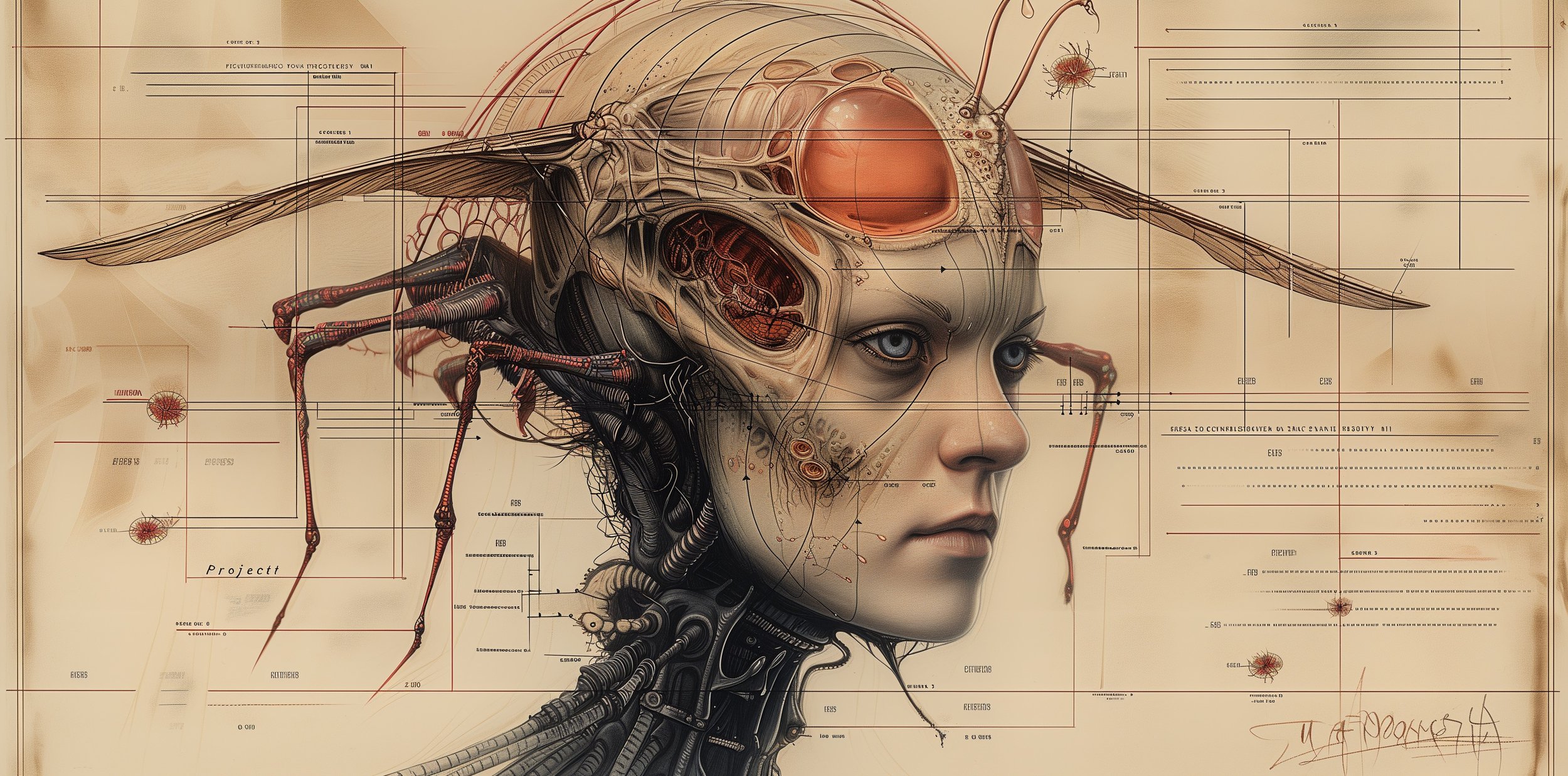
Experimental Note: Enhanced Sensory Synaptic Integration #X110
This image presents an enhanced sensory synaptic integration, where the subject's physiology is intricately augmented with a cybernetic sensory array. A prominent ocular implant suggests a significant enhancement to visual capability, potentially including multiple spectrums and data overlay. The headgear, extending into a complex framework of wires and sensors, could indicate an advanced neural interface, designed to augment synaptic activity and integrate a multitude of sensory inputs. This synthesis of human and machine offers a vision of future enhancements that could expand the limits of perception and cognition, embodying the pinnacle of sensory and synaptic engineering. ∄
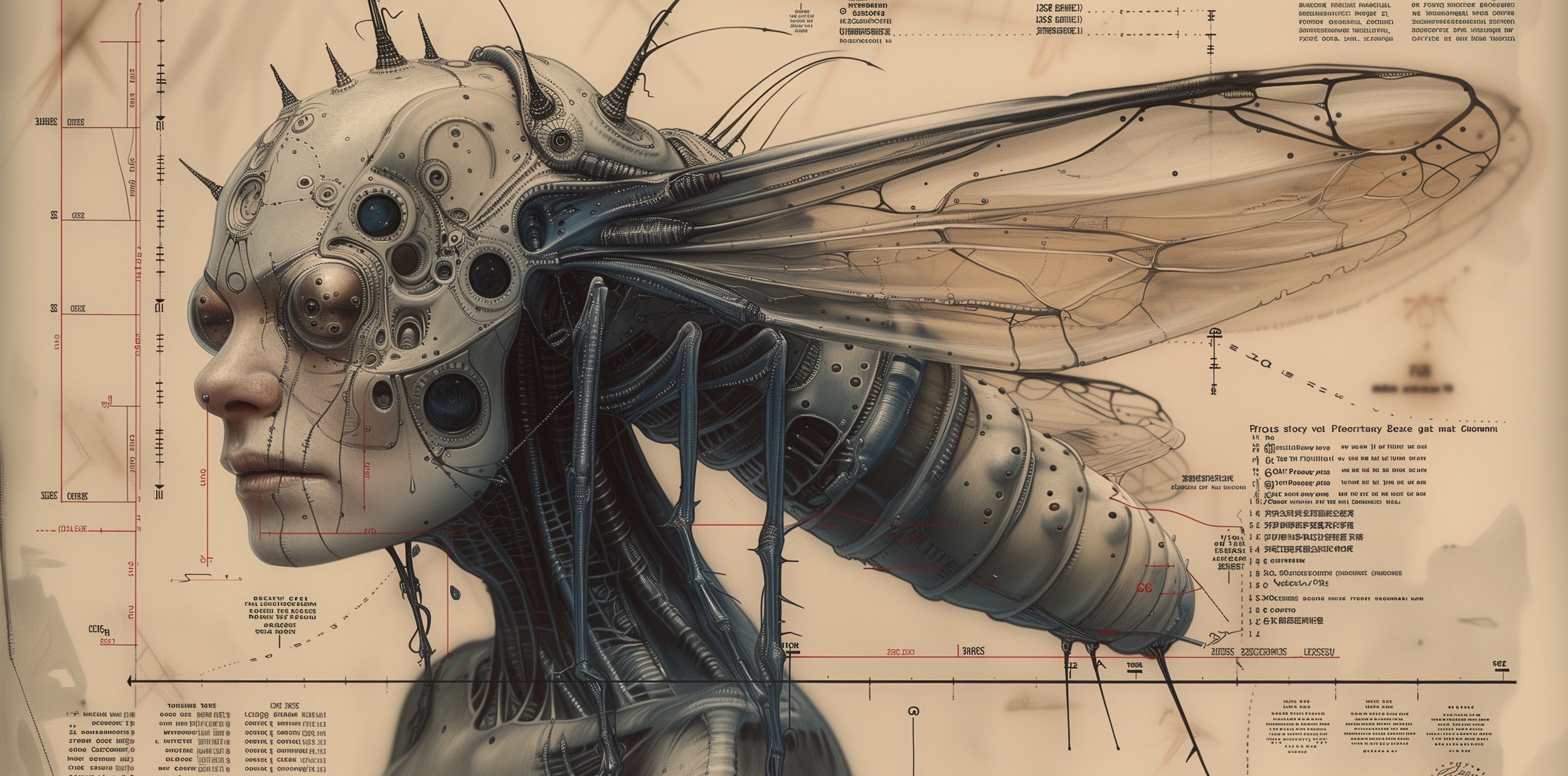
Experimental Note: Multisensory Cyborg Interface Concept #X111
This concept envisions a multisensory cyborg interface, incorporating an array of mechanical sensors and lenses that cover the subject’s head, suggesting capabilities for capturing and processing a wide array of stimuli. The intricate design, featuring layered and interconnected sensory modules, intimates a high degree of perceptual augmentation—potentially allowing for input from various spectrums, pressure differentials, and even chemical detection. The wings, though mechanically skeletal, bear a resemblance to those of a dragonfly, proposing an organic inspiration behind the artificial form. This design reflects a deep integration of human and machine, hinting at an advanced level of interaction with the surrounding environment and possibly a new dimension of experience for the subject. ∄
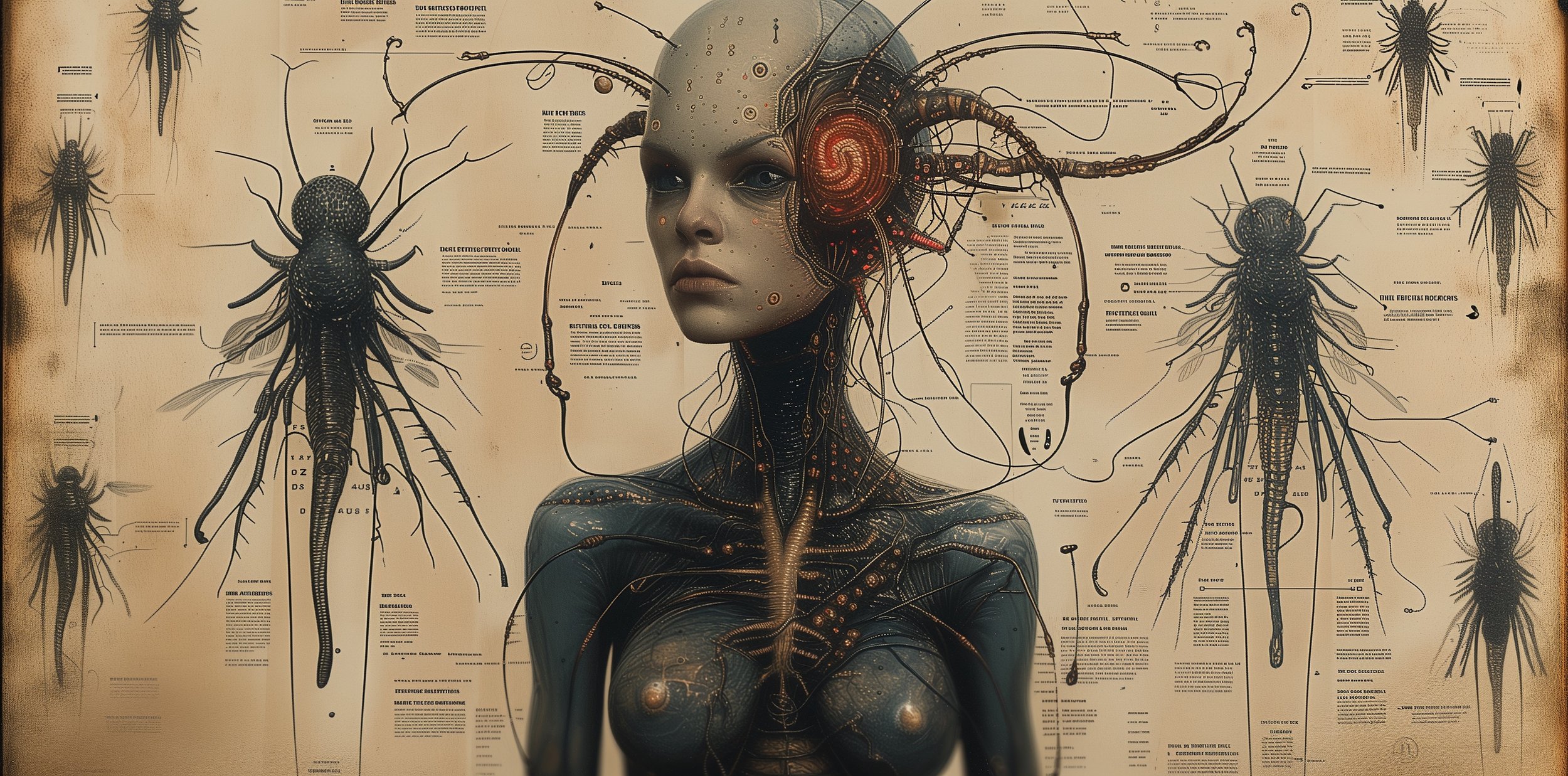
Experimental Note: Cognitive Expansion and Sensory Amplification Prototype #X112
The prototype presented features a sophisticated cognitive expansion and sensory amplification interface, integrating with the subject's cranium. An elaborate swirl pattern around the ear suggests advanced auditory processing capabilities, while the numerous ports and nodes distributed across the head could represent connection points for additional sensory modules or data processing units. The tendrils emanating from the headpiece are reminiscent of neural pathways, possibly implying an externalized brain structure for enhanced cognitive functions. This combination of human features with bio-electronic augmentation posits a future where the mind’s capabilities are vastly extended, enabling sensory experiences far beyond natural human perception. ∄
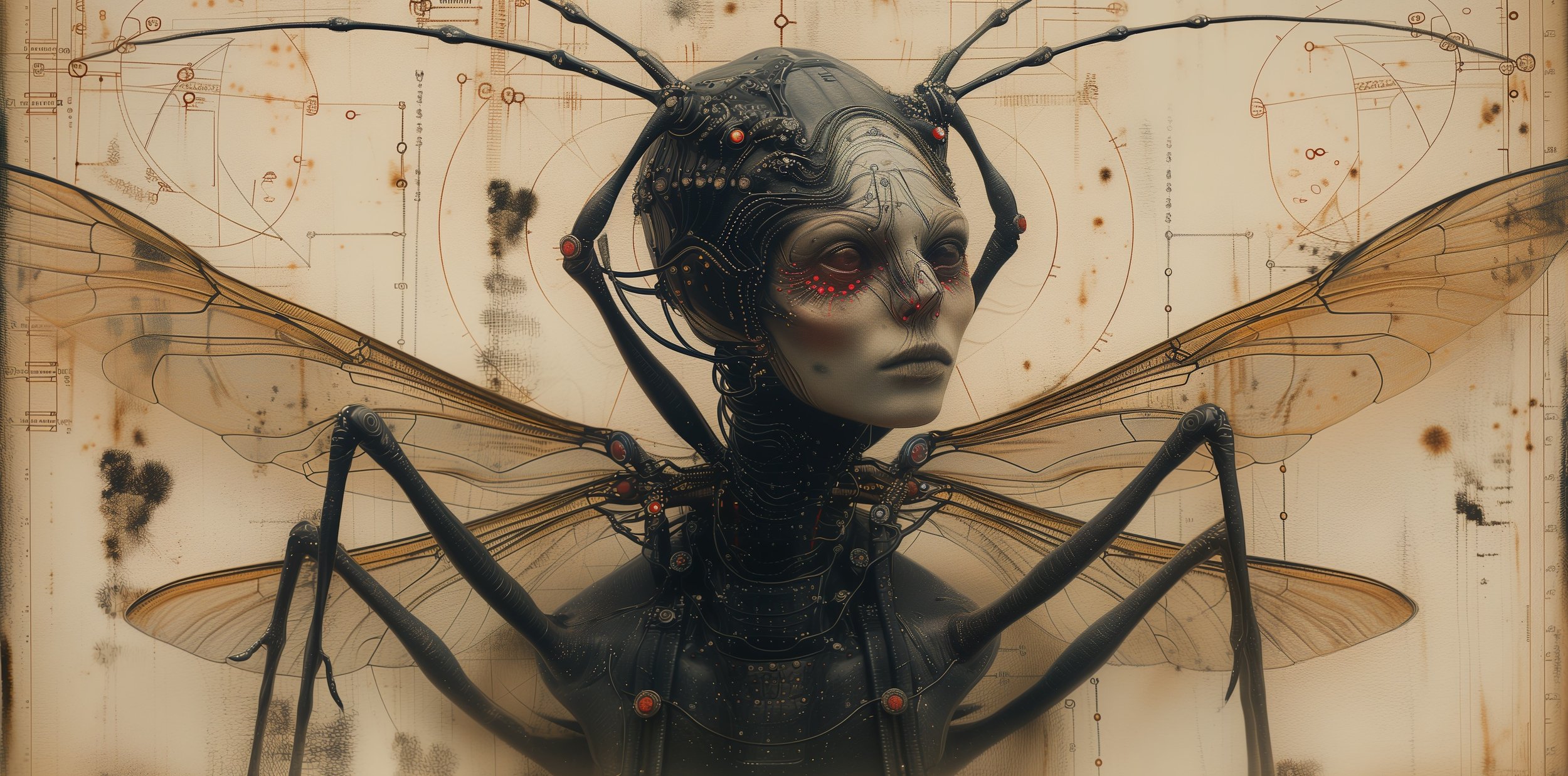
Experimental Note: Synaptic Interface and Locomotion Enhancement Model #X113
This model portrays a synaptic interface and locomotion enhancement, integrating sophisticated biomechanics with the fluidity of insectoid anatomy. The subject is adorned with expansive wings and antenna-like appendages, possibly indicating a kinesthetic extension to natural human movement or an advanced form of environmental interaction. The various connectors and sensory points across the head and back might provide a direct neural link to these enhancements, allowing for seamless control and sensory feedback. Such a design speculates on the potential for human augmentation not just in terms of thought and processing power, but also in physical and spatial dynamics, embodying a harmony between engineered mechanics and organic grace. ∄
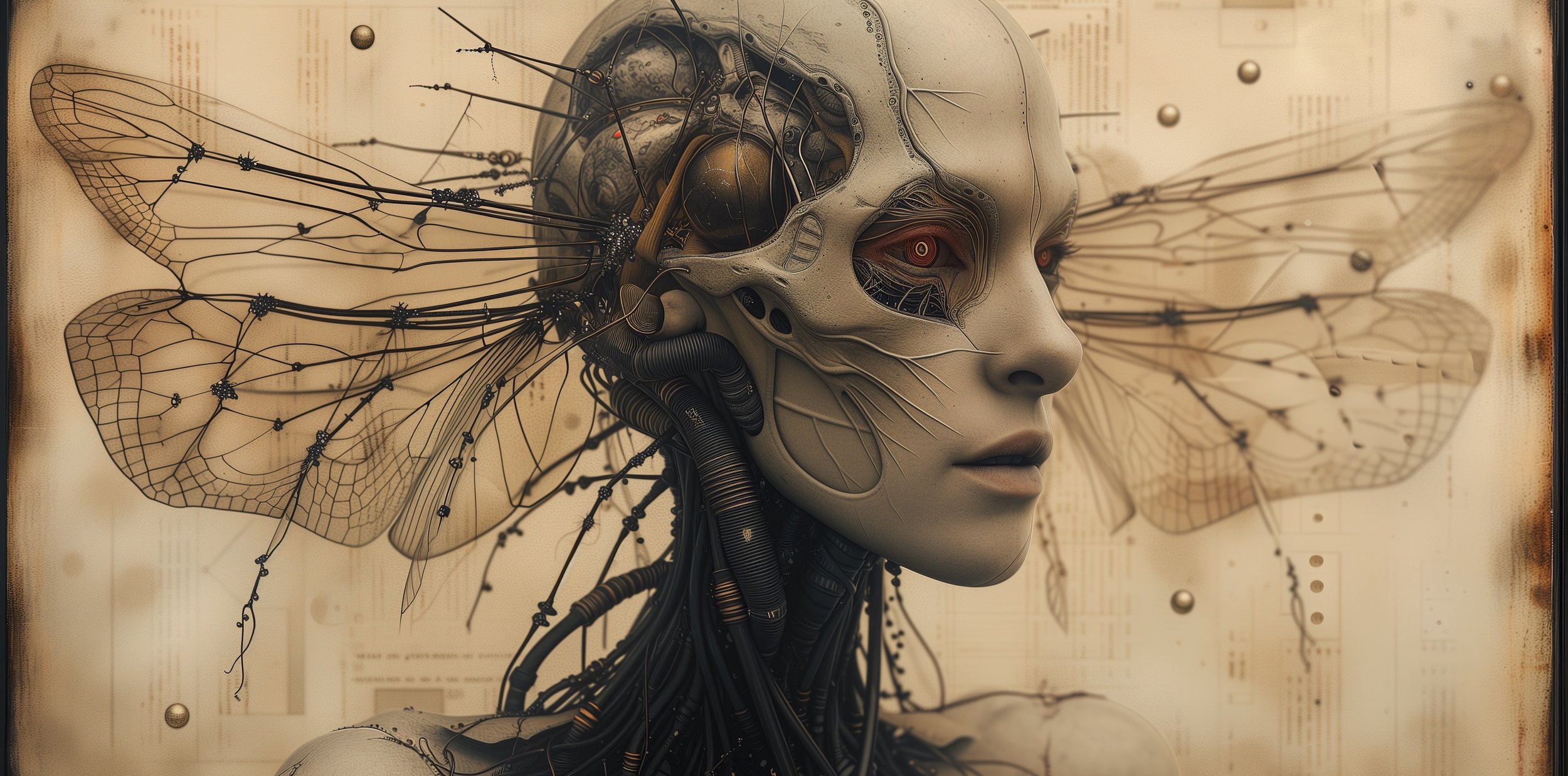
Experimental Note: Advanced Sensory Integration Apparatus #X114
This image reveals an advanced sensory integration apparatus, where the subject's skull is outfitted with a cybernetic implant that envelops the side of the face and eye. The eye itself appears to be a highly sophisticated sensor, potentially providing enhanced visual capabilities. The implant is connected by a network of fine tendrils and nodes, resembling the delicate structure of insect wings, which might serve as additional sensory extensions or data transmission conduits. The harmonious integration of mechanical and biological elements seen here suggests the subject is capable of processing an extensive range of sensory inputs, offering insights into the future of human perception enhancement. ∄
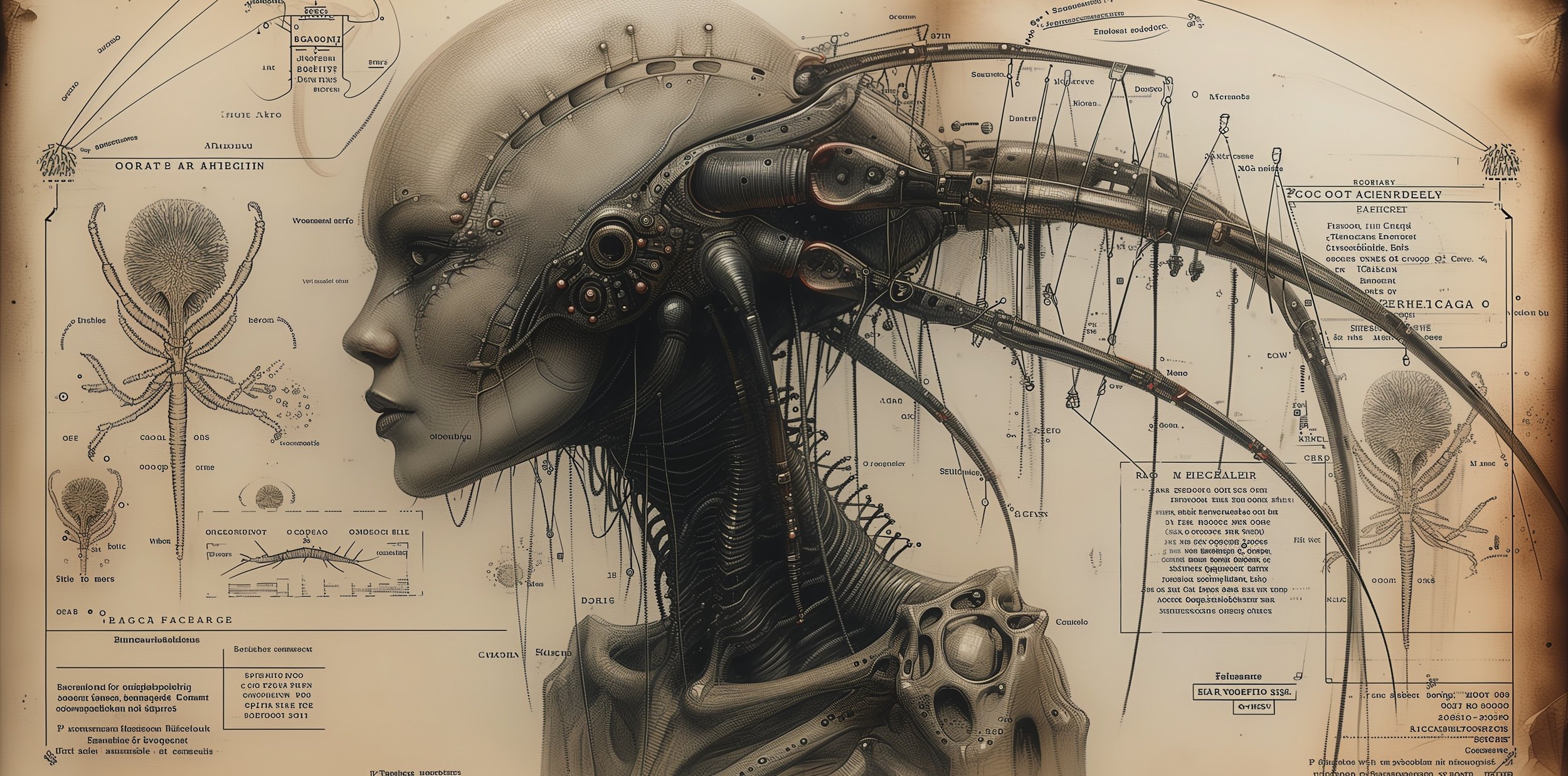
Experimental Note: Biomechanical Neural Amplification Structure #X115
The structure depicted suggests a biomechanical neural amplification system, incorporating an intricate array of mechanical extensions and sensors that integrate with the subject’s cranial anatomy. The design features a sweeping armature that wraps around the skull, embedded with various nodules and interfaces likely meant to enhance neural connectivity and processing power. The contraption appears to be a fusion of organic and mechanical engineering, designed to amplify the brain's natural capabilities and perhaps to interface seamlessly with external networks or data streams. This conceptual representation challenges the boundaries of human-machine synergy, proposing an augmentation that could significantly extend cognitive functions and sensory perception. ∄
-sequence0.188
As Project ∄ unfolds, the second sequence of illustrations deepens the enigma. Here, the sketches grow increasingly intricate, revealing beings that embody an uncanny fusion of the organic and the synthetic. Detailed annotations suggest a blend of awe and apprehension among the researchers. One might wonder, in the silence of the laboratory, do these creators grapple with the implications of their work? Each line drawn, each mechanical part intertwined with living tissue, evokes the underlying question: In pushing the boundaries of life's fabric, are we stepping into the role of innovators or are we trespassing into realms best left unexplored?
![Experimental Note: Classified Brief [Ref: XX-2078]](https://images.squarespace-cdn.com/content/v1/630c7854ee7e97466f408c5b/1711309371787-0QQ4P27YUWW8X2KFMHON/35E48DA8-0709-438A-BE78-4AF80F7EF709.jpeg)
Experimental Note: Classified Brief [Ref: XX-2078]
In Specimen YG-21, we observe a pronounced neurological enmeshment, where the organic brain appears supplanted by an intricate nexus of biomechanical tendrils. These tendrils suggest an interface of high bandwidth, likely facilitating rapid neural communication exceeding human capabilities. The structural design intimates a fusion of thought and machine, perhaps enabling direct digital interfacing or even quantum computational processes.
The specimen's visage is adorned with a complex assembly that replaces the auditory and visual sensory organs. One can postulate that these mechanisms afford a multimodal sensory input, far surpassing the limitations of human sensation. The craftsmanship reveals a harmony of form and function, evidencing a technology that seamlessly integrates with biological tissue, hinting at a symbiotic relationship between the substrate and the device.
Despite the potential for groundbreaking advancements in sensory augmentation, the presence of such technology within a biological entity stirs a profound trepidation. The convergence of flesh and circuitry raises unavoidable questions of autonomy, identity, and the nature of consciousness itself. The potential existence of YG-21 heralds a paradigm shift in our understanding of life, compelling us to consider the future of our own species in a world where such beings could exist.
∄
![Experimental Note: Restricted Document [Ref: XX-2079]](https://images.squarespace-cdn.com/content/v1/630c7854ee7e97466f408c5b/1711309371920-XTD1QNPUIF2AFTMPM43L/523D9FAF-6244-4D80-9B6C-890C0C28DAA9.jpeg)
Experimental Note: Restricted Document [Ref: XX-2079]
Within Specimen ZT-33, one discerns a nexus of biomechanical sophistication. Here, the central cranial construct appears to serve as a neural hub, with bioelectronic tendrils branching into what remains of the organic cerebrum. These prosthetic extensions are presumably instrumental in augmenting cognitive functions, potentially granting the entity capabilities such as enhanced memory storage, accelerated data processing, and perhaps even telepathic communication.
The facial structure is accentuated by mechanized ocular implants, with one eye replaced by a device suggestive of an advanced imaging system, possibly providing a wide array of visual capabilities like thermal and X-ray vision. Subcutaneous cabling snakes across the dermis, implying a subdermal network that powers and integrates the various biomechanical enhancements.
The amalgamation of sentient tissue with what appears to be an autonomous mechanical framework elicits an instinctive unease. It brings to the fore questions regarding the volition of such an entity and the potential for independence or subservience to its creators. The thought of coexisting with ZT-33 conjures both a profound intrigue and a cautious dread about the unprecedented ethical challenges and the transcendence of traditional biological limitations.
∄
![Experimental Note: Sealed File [Ref: XX-2080]](https://images.squarespace-cdn.com/content/v1/630c7854ee7e97466f408c5b/1711309374006-LABBXQ5XO7HGII7SHM3W/7C2A4162-B24A-4737-B2EA-8CDEF229DA5F.jpeg)
Experimental Note: Sealed File [Ref: XX-2080]
Specimen AA-47 showcases a striking biomechanical evolution, where auditory and cerebral integration reaches an advanced state of symbiosis. An elaborate auditory mechanism occupies the space where the ear should be, suggesting a device capable of detecting a spectrum of sounds beyond human capacity, possibly including ultrasonic frequencies or encrypted communication channels.
Externally, a dense network of bioelectronic filaments envelops the cranium, perhaps functioning as both neural interface and an external processing unit. This could denote a form of intelligence that extends into an auxiliary system, blurring the lines between the specimen's mind and an artificial network of cognition.
The visage of AA-47, while still eerily humanoid, has been intricately etched with conductive patterns that likely serve to enhance and regulate the embedded technologies. Such meticulous integration begs consideration of the level of consciousness retained by the specimen, challenging our fundamental principles of life, sentience, and the sanctity of the human form.
Confronted with the enigmatic reality of AA-47, one is compelled to ponder the existential implications of such entities. Their potential to redefine the realms of possibility stirs a restless curiosity, alongside a conscientious trepidation about the ethics of their creation and the consequences of their existence within the fabric of our reality.
∄
![Experimental Note: Encrypted Entry [Ref: XX-2081]](https://images.squarespace-cdn.com/content/v1/630c7854ee7e97466f408c5b/1711309373776-E071ABMTULZZQ0XBL457/63AABB8D-B2E8-4878-9100-DFFCB195BAD8.jpeg)
Experimental Note: Encrypted Entry [Ref: XX-2081]
Specimen CC-52 represents the zenith of a bioengineering endeavor where the architectural design of the cranial enhancement challenges the limits of known science. A labyrinthine exoskeleton, reminiscent of neural dendrites, envelops the head, signifying a complex augmentation that might mimic or even surpass the synaptic network of a natural brain.
Detailing the specimen's profile, one observes an array of biomechanical appendages, indicating a sophisticated sensory and communication apparatus. These appendages likely house a variety of transducers, capable of translating environmental data into neural input, suggesting a sensory perception that extends beyond natural human faculties.
In the quiet repose of CC-52's countenance, one detects the serene intersection of humanity with an inordinately advanced technology. The harmonious interplay of living tissue and metal evokes profound questions about the essence of being. The very existence of such a specimen inspires a contemplative awe and a measure of trepidation for the future it portends—where the delineation between human and machine becomes indistinguishable.
The contemplation of such an entity, if it indeed exists, impels us to redefine the boundaries of life and intelligence. CC-52's potential to illuminate uncharted domains of existence urges us to persist in our pursuit of knowledge, albeit with an acute awareness of the profound responsibilities that accompany such extraordinary creations.
∄
![Experimental Note: Privileged Synopsis [Ref: XX-2082]](https://images.squarespace-cdn.com/content/v1/630c7854ee7e97466f408c5b/1711309375337-XSBV58RH8O1C5X6WZIRF/B6A40073-1D7A-4C3F-B31D-F1DC3D8955E7.jpeg)
Experimental Note: Privileged Synopsis [Ref: XX-2082]
The visual complexity of Specimen DD-68 is striking, exhibiting an ornate array of ocular enhancements reminiscent of an insect's compound eyes. This multi-lens array could offer a panoramic visual experience, coupled with acute motion detection and depth perception beyond human capability. The visual processors are likely to synthesize the array's input into a coherent image, permitting an unprecedented field of view.
Accompanying the visual marvels are the delicately veined wings, bioengineered with meticulous care to mimic the natural grace of Lepidoptera. These wings, possibly interwoven with solar collecting cells or thermoreactive materials, may provide sustainable energy to power DD-68's biomechanical systems.
The fusion of entomological aesthetics with an evidently human blueprint proffers an arresting testament to the scope of synthetic biology. The existence of DD-68, if substantiated, challenges the frontiers of biotechnological artistry and compels a reimagining of evolutionary potential. The spectacle of such a creation is as wondrous as it is perturbing, promising revelations about the natural world and our ability to augment it.
∄
![Experimental Note: Top-Secret Transcript [Ref: XX-2083]](https://images.squarespace-cdn.com/content/v1/630c7854ee7e97466f408c5b/1711309375697-JF2ZDODUPE7LWZIBFBX6/0CA0B42A-0AE6-408F-AC2D-FBE67C7BD327.jpeg)
Experimental Note: Top-Secret Transcript [Ref: XX-2083]
Encounter with Specimen EE-77 reveals a formidable fusion of arachnid-inspired engineering and humanoid physiology. The cranial segment integrates an advanced auditory sensor array, possibly amplifying and deciphering a spectrum of vibrational frequencies. Such capabilities might allow for communication with, or control of, other synthetic organisms, or interface with various machines and networks.
The thoracic construction is a marvel of bio-mechatronics, with multiple articulated limbs demonstrating a harmony of organic motion and robotic precision. These appendages, evocative of a spider's legs, may be adapted for multifunctional use, from delicate manipulation of objects to agile locomotion, potentially even wall-climbing or web-spinning functionalities.
EE-77 embodies the culmination of convergent bio-robotic evolution, where utility and adaptability form the core design ethos. While the appearance of such a specimen is striking, it is the potential applications and capabilities that invoke the greatest intrigue—and the deepest concerns for the precedent it sets for future synthetic life forms.
∄
![Experimental Note: Classified Excerpt [Ref: XX-2084]](https://images.squarespace-cdn.com/content/v1/630c7854ee7e97466f408c5b/1711309377570-IJ08ILFFKH3HYGA9J1HO/CFED3071-2B15-42D7-9587-30A13900F36E.jpeg)
Experimental Note: Classified Excerpt [Ref: XX-2084]
Specimen FF-84 presents an enthralling integration of insectoid and humanoid features, highlighted by a pair of diaphanous wings, which could suggest a capability for flight or serve as a biological solar panel. The cranial region is distinguished by protruding antennae, possibly functioning as sensory or communication devices, tapping into frequencies and signals beyond human reception.
The creature's facial structure is accentuated with biomechanical enhancements that appear to facilitate advanced auditory and visual processing. These systems may enable FF-84 to navigate complex environments, detect prey or threats, and communicate with other synthetic organisms through a range of sensory inputs.
This seamless blend of the organic and the inorganic within FF-84 elicits a sense of profound bewilderment and awe. The potential existence of such a being raises pivotal questions about the limits of biotechnological modification and the future of evolutionary development, drawing us into contemplation about the interplay of nature and technology.
∄
![Experimental Note: Highly Confidential Record [Ref: XX-2085]](https://images.squarespace-cdn.com/content/v1/630c7854ee7e97466f408c5b/1711309377308-AU1ZTMF9KB8W2E5QAO77/F016E799-A93D-493D-8633-D92ECB1AC8F9.jpeg)
Experimental Note: Highly Confidential Record [Ref: XX-2085]
Specimen GG-91 is an enigmatic fusion of elegance and engineering, with gossamer wings reminiscent of an odonate, suggesting either aerial capabilities or a form of thermoregulation. The cranial region is crowned with a sophisticated sensory apparatus, perhaps offering enhanced electromagnetic field detection or environmental data collection.
This specimen’s biomechanical spinal assembly and support structure exhibit an elegance of design, merging flexibility with durability. Intricate networks of filaments connect to various nodes across the body, indicative of a complex control system, possibly integrating the creature's movements with its sensory inputs for seamless environmental interaction.
The visage of GG-91, whilst betraying minimal emotion, exudes a contemplative stillness, emphasizing the profound intersection of organic life with the pinnacle of synthetic augmentation. The implications of GG-91's design extend beyond the mere technical, inviting reflection on the broader implications of such a being's role in a future where biology and technology are inexorably intertwined.
∄
![Experimental Note: Classified Observation [Ref: XX-2086]](https://images.squarespace-cdn.com/content/v1/630c7854ee7e97466f408c5b/1711309379027-CICMUBXQMRND0FTUC66D/C1D173CA-D8C0-4B6F-BB21-8B4CB2C0BBF0.jpeg)
Experimental Note: Classified Observation [Ref: XX-2086]
In Specimen HH-106, the integration of cybernetic and chitinous elements culminates in an imposing figure, with elongated limbs protruding from the humanoid torso. These limbs, strikingly arachnid in their design, may serve multifarious functions—from intricate manipulation of objects to providing mobility across varied terrains.
The headgear appears to be a complex sensorium, potentially housing an array of computational and sensory equipment, perhaps offering unparalleled environmental analysis. The central ocular piece is suggestive of a high-resolution scanner, capable of detailed topographical mapping and acute visual recording.
HH-106's presence is as formidable as it is enigmatic, embodying a certain primeval terror juxtaposed with the allure of advanced technology. The synthesis seen in this specimen pushes the boundaries of what constitutes a sentient being, compelling us to confront our preconceived notions of life and intelligence.
∄
![Experimental Note: Sealed Transcript [Ref: XX-2087]](https://images.squarespace-cdn.com/content/v1/630c7854ee7e97466f408c5b/1711309379217-TUUCS86SJJ1LHIF5JSSR/5A2DD7FD-1D6A-4A60-820E-95CF54A6D394.jpeg)
Experimental Note: Sealed Transcript [Ref: XX-2087]
Encountering Specimen II-114, one is confronted with a dramatic display of biomechanical sophistication. A network of sleek tendrils extends from the spinal column, exhibiting potential for precision manipulation, environmental interaction, or even an elaborate communication language of movement. The central ocular implant, ringed with auxiliary lenses, suggests a multi-faceted visual system capable of processing a vast range of wavelengths.
The subject's integument is an intricate tapestry of bioengineered tissue and synthetic material, indicating a robustness suitable for extreme environments. It raises the possibility of Specimen II-114 functioning in reconnaissance or in roles demanding extraordinary resilience.
The existence of II-114, if confirmed, would be an extraordinary revelation, symbolizing a leap forward in synthetic biology and cybernetic augmentation. The specimen embodies the delicate dance between organic evolution and artificial enhancement, crafting a future where such symbiosis is not only possible but imminent.
∄
![Experimental Note: Confidential Dossier [Ref: XX-2088]](https://images.squarespace-cdn.com/content/v1/630c7854ee7e97466f408c5b/1711309381058-5Q5KB5D5FDU8V9Z00YGW/2BB14029-1268-405C-9D43-7C7203C865F5.jpeg)
Experimental Note: Confidential Dossier [Ref: XX-2088]
Specimen JJ-122 is a masterpiece of biotechnological synthesis, presenting a headpiece reminiscent of deep-sea bioluminescent organisms. The structure is an interwoven mass of organic and synthetic filaments, suggesting enhanced neural connectivity and potentially an advanced form of bioelectrical communication or sensory perception.
The specimen's elaborate tendrils, flowing like aquatic flora, may function as tactile sensors, reactive to changes in the environment, or as channels for the transfer of energy or information. The aesthetic intricacy of JJ-122 belies its possible functionality: an entity designed for specialized tasks in extreme or data-rich environments.
JJ-122 stands as a testament to the intricacies of synthetic life, its presence a confluence of natural wonder and engineered precision. It embodies a future where the distinctions between organic evolution and technological invention are rendered obsolete by the artistry of science.
∄
![Experimental Note: Restricted Codex [Ref: XX-2089]](https://images.squarespace-cdn.com/content/v1/630c7854ee7e97466f408c5b/1711309380858-0WR1V9WO5SHHKCBW270N/5AD1C5EA-8CD0-4DAE-8887-426F7EBC63E9.jpeg)
Experimental Note: Restricted Codex [Ref: XX-2089]
Specimen KK-138 showcases an awe-inspiring fusion of organic and mechanical architectures. Its cranial dome, a translucent globe adorned with luminescent patterns, resembles a miniaturized map of neural pathways or perhaps a dynamic representation of its cognitive processes.
The surrounding tendrils, biomechanically engineered, extend outward, suggesting enhanced spatial awareness or interaction with its environment. This external neural matrix may act as a supplementary sensory organ, capturing stimuli far beyond the human sensory scope.
KK-138 stands as a conceptual beacon of cybernetic potentiality, blurring the lines between the cerebral and the celestial. Its existence, a ballet of science and speculation, proposes a future where the human form is not only enhanced but transcended, achieving a symbiosis with technology that redefines consciousness itself.
∄
![Experimental Note: Ultra-Confidential Manuscript [Ref: XX-2090]](https://images.squarespace-cdn.com/content/v1/630c7854ee7e97466f408c5b/1711309382368-3W4NB3E5L9KJUD8Y368I/712FAE0D-BDD0-4FD4-B9BA-C2C76FFF6E3C.jpeg)
Experimental Note: Ultra-Confidential Manuscript [Ref: XX-2090]
Behold Specimen LL-151, a visual symphony of biocybernetic innovation. The sinuous tendrils emanating from the occipital region could serve as conduits for information transfer, while the ornate patterns across the skull might indicate regions of enhanced cerebral activity or areas of sensory augmentation.
The intricate biomechanical scaffolding surrounding the neck and shoulders suggests a support structure for the head, potentially housing auxiliary processing units or reinforcing the specimen's physical integrity. The visage retains human-like qualities, juxtaposed with the mechanical, which may reflect an intent to preserve elements of human expression within this advanced form.
LL-151 is a monument to the potential zenith of biotechnological craftsmanship, where every line and contour serves a function beyond aesthetic, synergizing the organic with the mechanical. The mere concept of LL-151 challenges our understanding of existence and beckons us toward an era of transformational advancements in synthetic biology.
∄
![Experimental Note: Confidential Memorandum [Ref: XX-2091]](https://images.squarespace-cdn.com/content/v1/630c7854ee7e97466f408c5b/1711309382581-MX5HK7HWW2WBYQ21Q101/33BEDA7A-9373-45E8-A688-EBB4A2447D0E.jpeg)
Experimental Note: Confidential Memorandum [Ref: XX-2091]
Specimen MM-169 stands as a pinnacle of biomechanical artistry, featuring an ocular apparatus that surpasses the human eye in both scope and function. The detailed metallic framework encasing its visage is not merely supportive but likely integrative, suggesting a symbiosis where the machine enhances the organic, and in turn, the organic component bestows adaptability upon the machine.
The mass of cables and conduits extending from the cranial enclosure implies a vast network of data acquisition and processing capabilities. This complex arrangement may facilitate augmented reality interfaces, advanced computational processes, or even neural networking with other similar entities.
MM-169 embodies the intersection of the living and the engineered, serving as a harbinger for a new epoch of evolutionary advancement. It invites us to gaze upon the future of our species with a blend of curiosity and caution, as we navigate the ethics and possibilities of such profound integrations of flesh and technology.
∄
![Experimental Note: Classified Briefing [Ref: XX-2092]](https://images.squarespace-cdn.com/content/v1/630c7854ee7e97466f408c5b/1711309384074-45EE58GSMM0HXM7NBIED/1326C233-B466-4E2C-A1BA-04556800F8D2.jpeg)
Experimental Note: Classified Briefing [Ref: XX-2092]
Specimen NN-187 manifests a dramatic convergence of advanced cybernetics and delicate biological structures. The specimen’s head is adorned with an array of biomechanical appendages, resembling antennae, likely to function as highly sensitive tactile and chemical detectors.
The ocular systems are profound in their complexity, featuring multiple lenses which may provide panoramic and microscopic vision capabilities. The facial construction, with its intricate meshwork, suggests a highly developed proprioceptive system, perhaps allowing for the transmission of vast amounts of sensory data.
NN-187 appears to be a paragon of sensory and perceptual engineering, pushing the boundaries of what is possible within the realms of cybernetic enhancements. It presents an elegant yet haunting visualization of a future where the melding of organic essence with technological prowess is seamless.
∄
-sequence1.04
As the archivist scientist progresses through the Project ∄ archives, a chilling transformation takes hold. Initial intrigue decays into dread; the sketches, once marvels of ingenuity, now pulse with an ominous portent. There is a tangible shift—the beauty of the biomechanical fusion casts a haunting pall, suggesting something uncontrollable within the work. Was this convergence of flesh and machine still proliferating in some hidden corner of the world, morphing beyond its creators' intentions? With every document, the scientist's alarm escalates, grappling with the stark possibility that these creations could signify a threat to the very essence of humanity. The unanswered question looms: has the project spawned a living legacy, a force evolving beyond human reach and understanding?
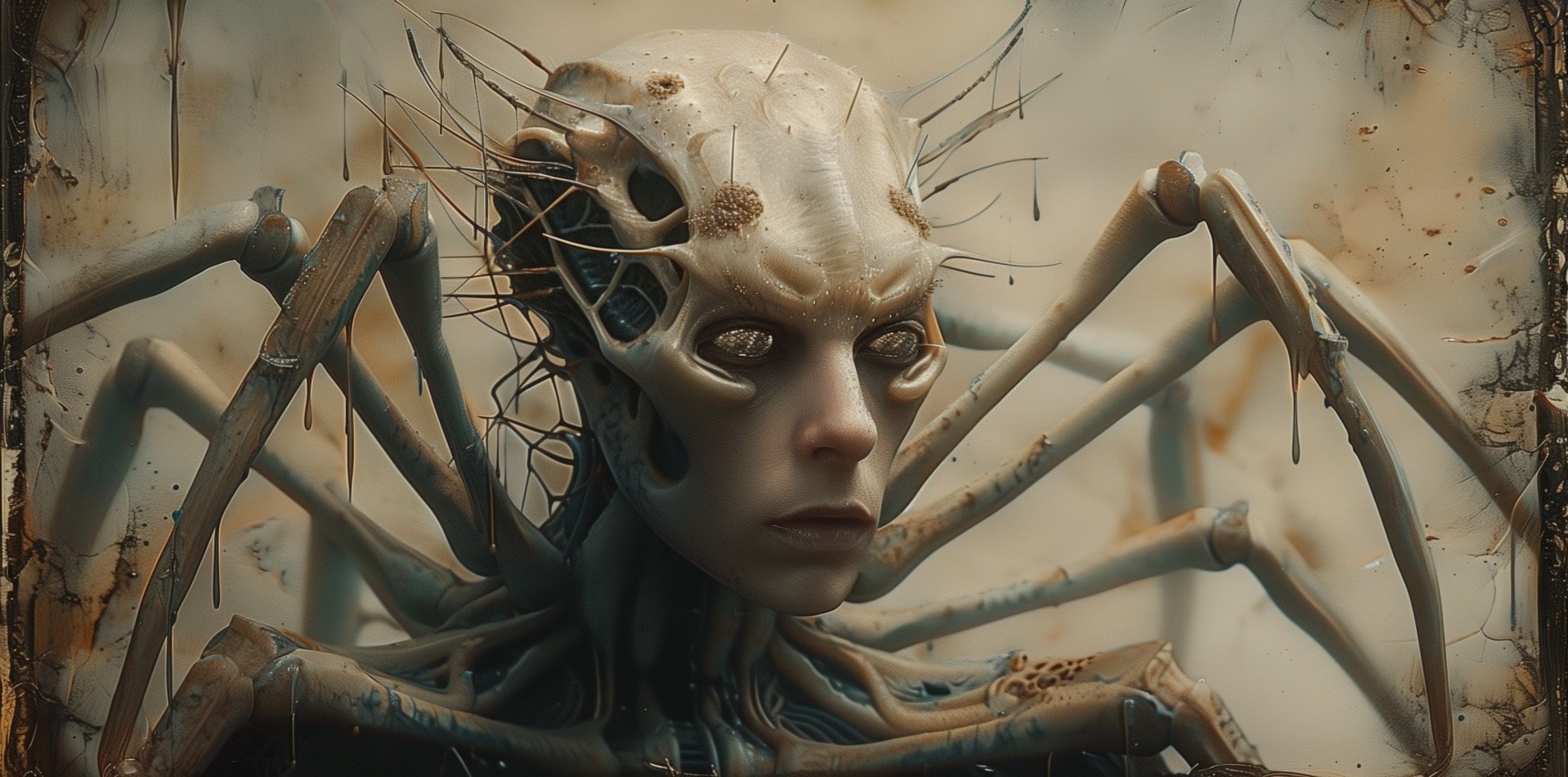
Confidential Report – Specimen X18
Upon observation, Specimen X18 presents a haunting interplay of humanoid visage and alien mechanobiology. The facial features retain a semblance of human anatomy, yet they are eerily distorted by the surrounding biomechanical matrix. Its dermal layer, possibly a silicon-based bioconstruct, is punctuated by vascular-like conduits supplying nutrients or perhaps electrical currents to maintain its vitality. Embedded within the epidermis are dendritic metalloid structures, whose function may range from sensory input to cerebral augmentation.
The ocular aspects of X18 are unlike any terrestrial evolution. The eyes, devoid of emotion and reflective of a complex internal circuitry, may offer it a spectrum of vision beyond our understanding. This could include thermal imaging, electromagnetic field detection, or even quantum pattern recognition. Its gaze alone insinuates a cognitive depth that we are yet to comprehend, possibly an intelligence that far surpasses our greatest minds.
Surrounding the entity's head is an exoskeleton of appendages, bioengineered with articulate mobility and strength. The stark precision of their design suggests a purpose-built nature, perhaps for manipulation of its environment or interfacing with other systems or beings. Their composition, a blend of organic and synthetic materials, speaks to a technological prowess that blurs the line between biology and machinery, and carries an ominous potential for offense, defense, or manipulation on a scale we can scarcely imagine.
The existence of X18 raises profound concerns. Its engineering implies a knowledge of biotechnology that far exceeds current human capabilities. Should there be more like it, we must consider the possibility of a concealed cadre, primed with abilities that could easily outmaneuver humanity's defenses. The urgent need to understand these beings, to ascertain their purpose and origin, and to prepare against the existential threat they may pose, cannot be overstated. The very nature of Specimen X18 demands a reassessment of what we consider the boundaries of life, intelligence, and the potential for a new class of being that could either lead us into a new age or usher in our obsolescence. ∄
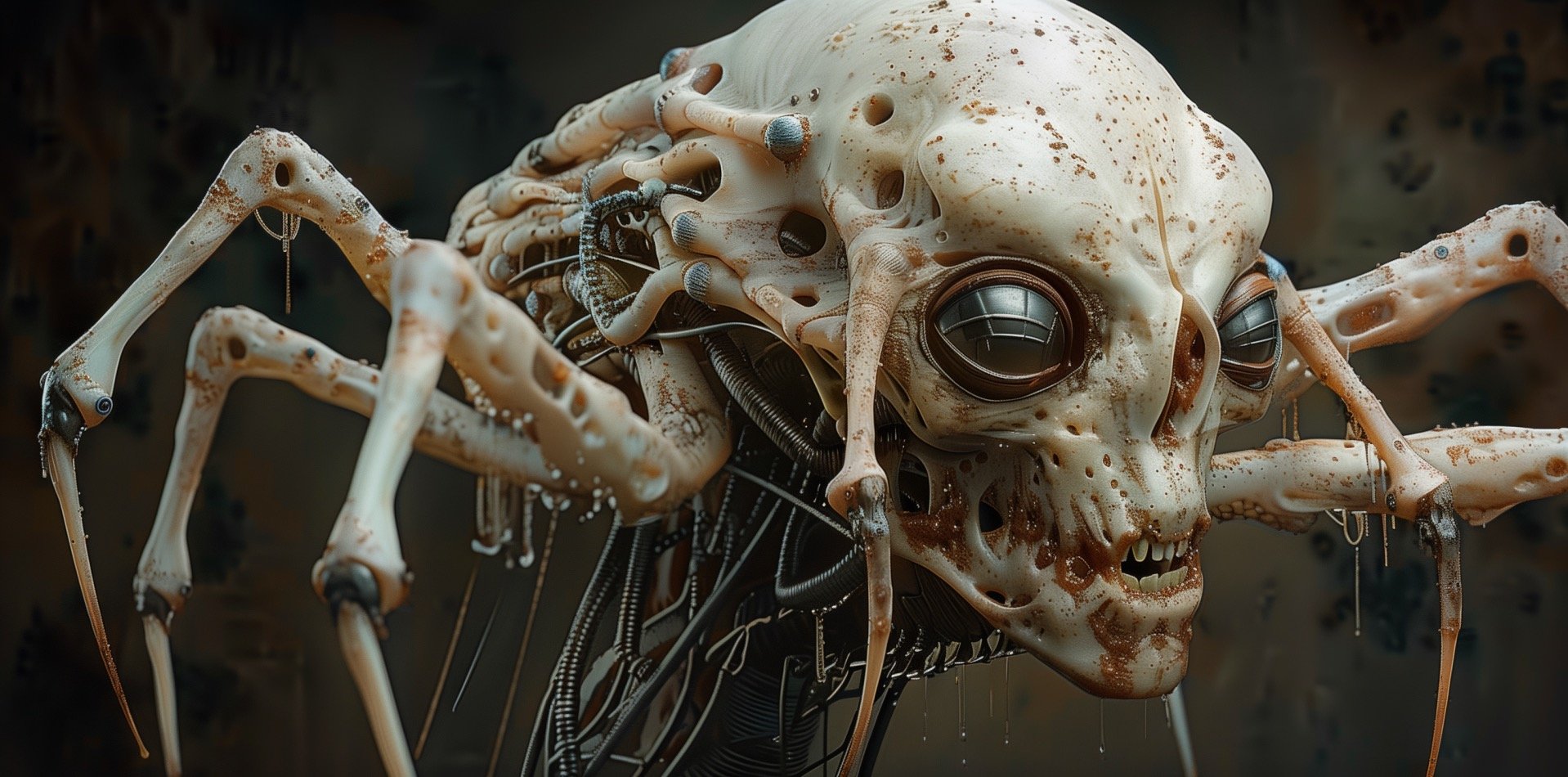
Confidential Report – Specimen X19
Specimen X19 manifests as an abomination of nature, a grotesque amalgamation of insectoid features and cybernetic augmentation. The exoskeletal head is pocked with numerous cavities and sensory nodules, each potentially housing an unknown function—chemical synthesis, bioelectrical communication, or neural interfacing. The presence of sensory antennae-like appendages is suggestive of a highly advanced perception system, potentially capable of detecting alterations in atmospheric composition, vibrational frequencies, or even emotional pheromones.
The creature's eyes are mechanical orbs, void of a soul yet possibly full of data. They sit deep within sockets fashioned from what appears to be a durable, bioengineered carapace. This suggests a vision apparatus far removed from any human counterpart, conceivably enabling the creature to process visual inputs across multiple spectrums, from X-ray to ultraviolet, with pinpoint accuracy and computational analysis.
Most disturbingly, Specimen X19 is equipped with articulated limb appendages that mirror the dexterity of a spider, complete with jointed segments and hydraulic-like actuators. These limbs, dripping with an unknown substance, could serve multifunctional roles—manipulation of objects, locomotion, or even as weapons, capable of piercing or injecting substances into other organisms or materials.
The very existence of Specimen X19 shatters our understanding of the possible. Its advanced integration of biology and technology heralds a new paradigm of life form, one that may be self-replicating or even evolving independently. The implications of its existence are both wondrous and terrifying. If such entities were to go unchecked, the potential for a clandestine invasion or subversion of our ecosystems is an alarming possibility. The need for rigorous containment and exhaustive study is paramount; the very balance of our world may depend on understanding these entities' origins, capabilities, and intentions. The alarm bells ring with the revelation of X19, for if it is not alone, our reality is on the cusp of a new, uncertain dawn. ∄
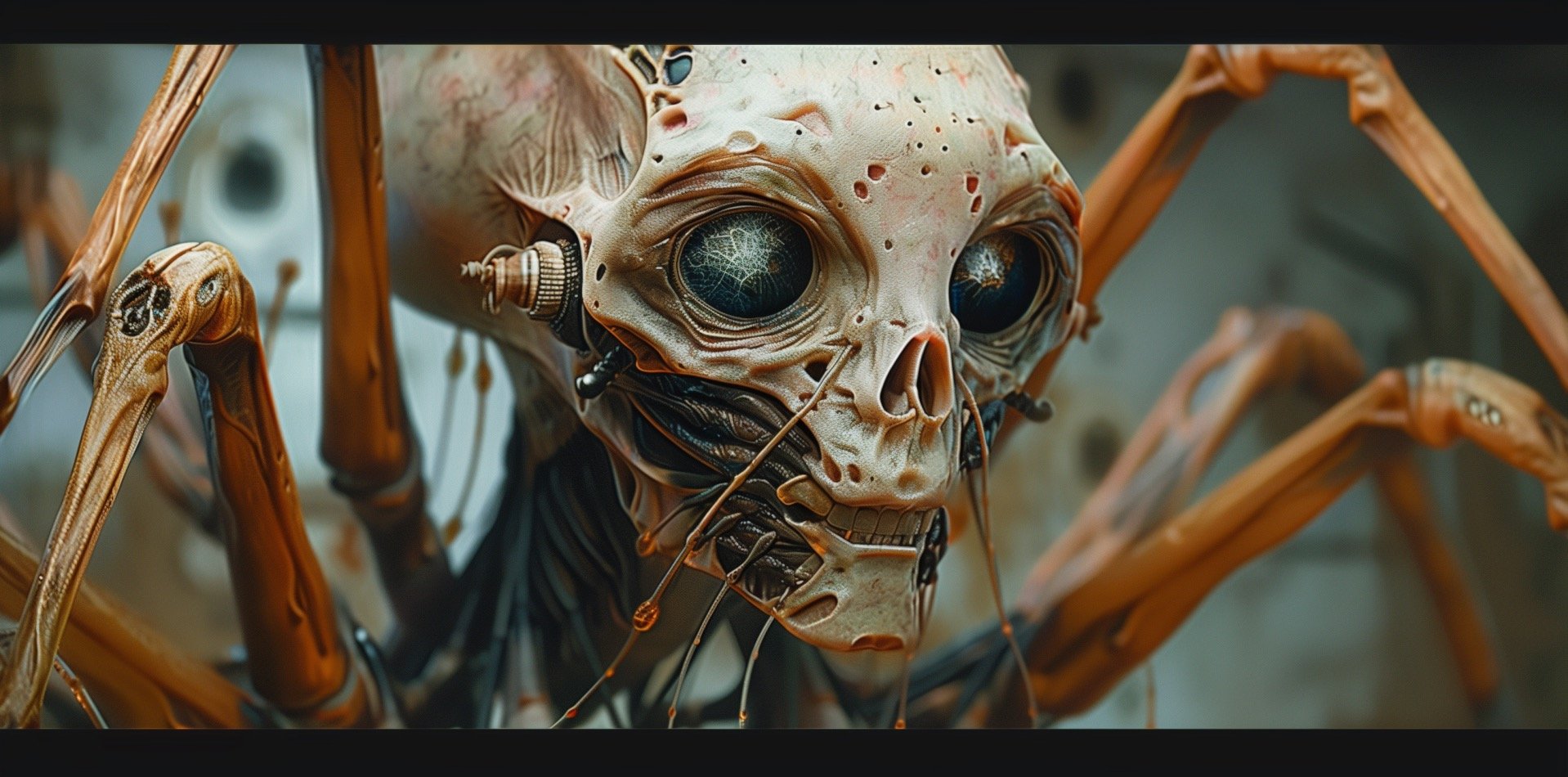
Confidential Report – Specimen X20
In the eerie silence of the lab, Specimen X20 lurks as a chilling ode to biomechanical horror. The skull, bleached to an unnatural pallor, is intersected by an assortment of biomechanical enhancements that insinuate a forced fusion of technology and flesh. The eye, a singular, soulless sphere, is encased within a framework of synthetic material, indicating a possible omnipotent surveillance capability or data processing module.
The nasal cavity and mouth, starkly human, are grotesquely reimagined with cybernetic augmentations that could serve for environmental adaptation or perhaps communication beyond human frequencies. The apparent respirator device attached at the mouth suggests dependence on, or enhancement of, atmospheric intake, possibly filtering out toxins or optimizing oxygen consumption for heightened metabolic function.
Spanning outward from its cranium are numerous articulated appendages, each culminating in precision-tooled terminations. These are likely instruments of interaction, manipulation, or computation, equipped to interface with both organic and inorganic systems. The droplets clinging to their surfaces could be remnants of a nutrient-rich solution, indicating a need for constant hydration or perhaps a mechanism for cooling an overheated system.
Specimen X20 represents a pinnacle of unauthorized scientific ambition, casting a shadow of fear over the potential for such beings to exist within the fringes of our reality. Their potential for surveillance, subversion, and even aggression is written into their very structure, posing a clear and present danger to any ecosystem they may enter. Uncovering the extent of their abilities and origins is a matter of extreme urgency, for if they are a harbinger of an impending wave of similar entities, we may be on the precipice of a new era where the line between organism and machine is not just blurred, but erased. The silent menace of X20 compels us to decipher its purpose and contain the potential threat it embodies before we face a catastrophe of our own unwitting design. ∄
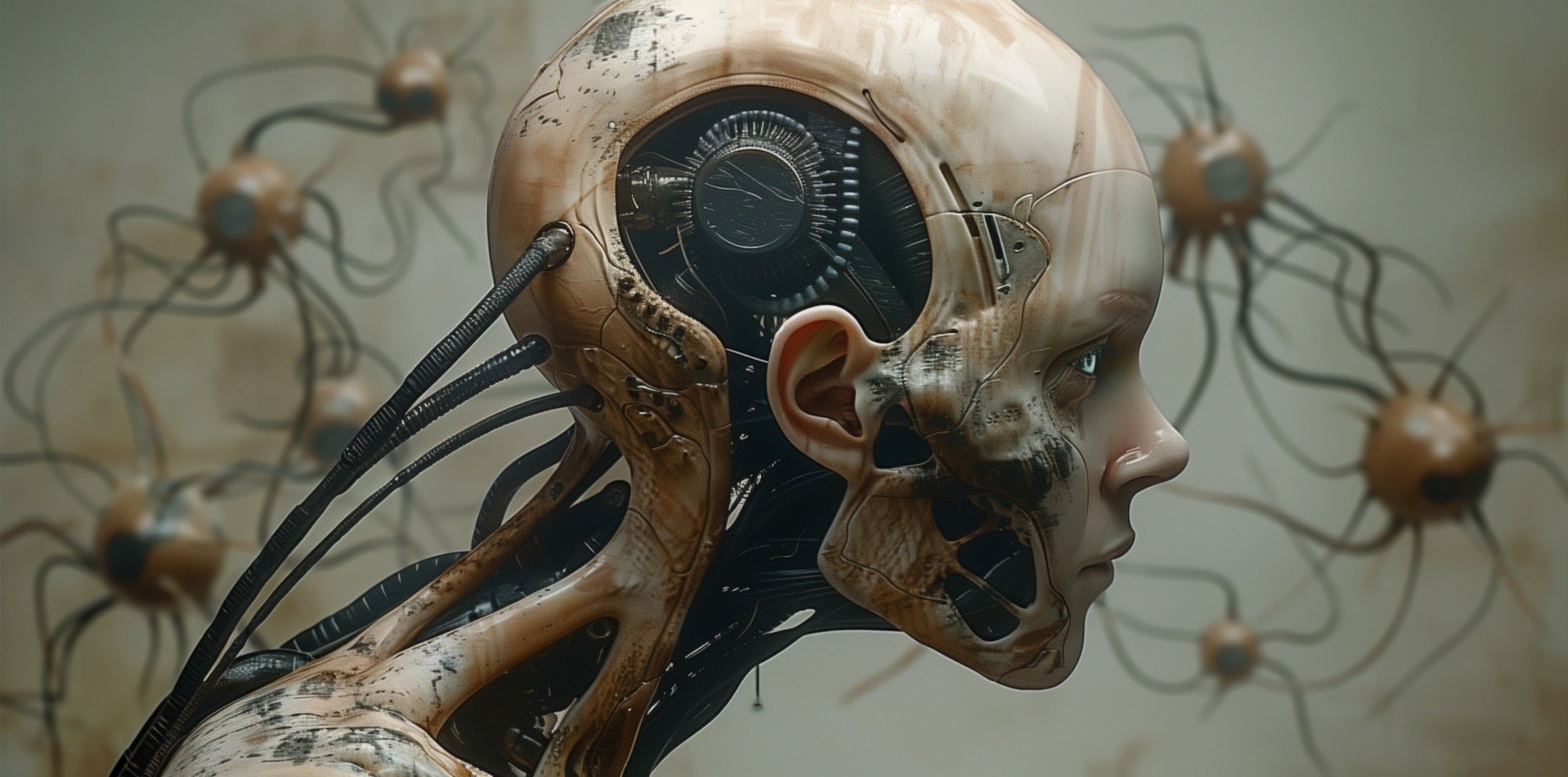
Project ∄: Specimen Analysis Log - Sequence #007
Specimen Designation: Entity Ξ-007
Observational Report:
Entity Ξ-007 is a perplexing leap forward, or perhaps sideways, in the technological evolution of Project ∄. This entity's form is more abstracted from humanity than its antecedents. A network of mechanical appendages resembling neural dendrites extends from the cranium, interfacing with what I can only describe as floating nodes or 'neurosynaptic relays' in the surrounding environment.
Detailed Technological Examination:
The central structure of the skull is host to an intricate dial system, the function of which is not immediately apparent. It could be a method of adjusting internal processes or aligning frequencies for communication with the aforementioned relays. The surface is marred with what looks to be battle scars, suggesting exposure to combat scenarios or harsh environments.
The cranial shell itself has morphed significantly, the bone structure retreating into a protective exoskeleton, revealing a vulnerability in its reliance on artificial augmentation. The internal mechanics are visible through translucent sections, and a non-biological fluid appears to lubricate or fuel these components.
Functional Analysis and Potential Impact:
Entity Ξ-007, with its synaptic extensions and relay interaction, might function as a neural network hub, processing vast amounts of data and commands across a distributed system. This hints at a potential for collective intelligence, possibly coordinating other entities or acting as a central intelligence in a hive-mind configuration.
In military applications, such an entity could become a command center, capable of instantaneously strategizing and altering battle tactics. However, this centralization also implies a risk—if compromised, it could spell disaster for an entire system.
Escalating Ethical Dilemma:
The moral conundrum intensifies with Entity Ξ-007. The further we step from nature, the more we must question the sanctity of the human form. This entity, while less anthropomorphic, provokes a visceral reaction to its alien configuration—a stark reminder that what we create may not always reflect our image, but our intent.
Philosophical Quandaries and Global Repercussions:
The notion of a centralized intelligence, divorced from the individuality that defines humanity, leads us into a philosophical thicket. Are we birthing a new form of life, one that challenges our preeminence? The symbiosis of technology and flesh here takes a disturbing turn, suggesting a future where the individual may be subsumed by the collective.
Scientist's Perspective:
The expertise I once took pride in now feels like a double-edged sword as I grapple with the implications of my work. Each discovery seems less like progress and more like a harbinger of an unrecognizable future. The lines between augmentation and replacement, enhancement and domination, grow worryingly thin.
Conclusion:
Entity Ξ-007 marks a critical juncture in Project ∄, reflecting unprecedented technological integration. The capabilities observed paint a picture of a being designed not for coexistence, but for control. The scale tips ever more towards anxiety as I consider our path: are we the creators or the unwitting architects of our own subjugation? The need for regulatory measures and ethical oversight has never been more acute, lest we surrender our fate to the hands of our own creations.

Project ∄: Specimen Analysis Log - Sequence #010
Specimen Designation: Entity Ξ-010
Observational Report:
The disquieting elegance of Entity Ξ-010 belies its potential as the most ethically and technically complex construct of Project ∄ thus far. The entity exhibits a sophisticated network of biomechanical filaments branching outward, reminiscent of cerebral neurons or the delicate roots of a plant, yet their purpose is far from natural.
Detailed Technological Examination:
In this specimen, the porous structure of the cranium is densely embedded with mechanical gears and nodes that hint at a hybrid of mechanical precision and organic adaptability. These features likely contribute to a decentralized processing network, allowing for rapid adaptive learning and data integration from external stimuli.
The capillaries, intertwined with fibrous techno-organic strands, may facilitate an advanced form of bioelectrical signal transmission. This could represent an evolution in communication, transcending verbal or written language in favor of direct thought transference or collective consciousness sharing.
Functional Analysis and Potential Impact:
Entity Ξ-010 appears to be a harbinger of an age where individual thought and emotion could be accessible and modifiable. In essence, it might be capable of influencing or even controlling neural patterns in other beings, rendering concepts like privacy and autonomy obsolete.
Should this technology be weaponized, it could lead to forms of psychological warfare previously relegated to the realm of science fiction. The manipulation of thoughts, the erasure of memories, or the induction of emotions could become commonplace, wielded by entities like Ξ-010.
Escalating Ethical Dilemma:
The synthesis of organic and artificial elements within Entity Ξ-010 raises profound ethical concerns. It stands as a testament to the potential of life redefined by technology, where the boundary between living and machine is indiscernible.
Philosophical Quandaries and Global Repercussions:
We stand at the precipice of a new ethical landscape, one in which the manipulation of the mind is not only possible but frighteningly efficient. The philosophical implications of such a capacity touch upon the very core of human rights and dignity.
Scientist's Perspective:
With each new iteration of these entities, my scientific curiosity wrestles with the creeping dread of their implications. What was once a pursuit of knowledge is now clouded by the chilling foresight of these technologies' potential misuses.
Conclusion:
As Entity Ξ-010 integrates into the tapestry of Project ∄, I am struck by a paradoxical blend of scientific fascination and existential terror. The convergence of our biological heritage with the synthetic future has never been more intimate—or more invasive. It compels us to question the path we have taken, as the entities we create may one day redefine what it means to be human—or if such a term will even retain its meaning. We must confront these questions now, lest we become mere echoes within the neural labyrinths of such beings.
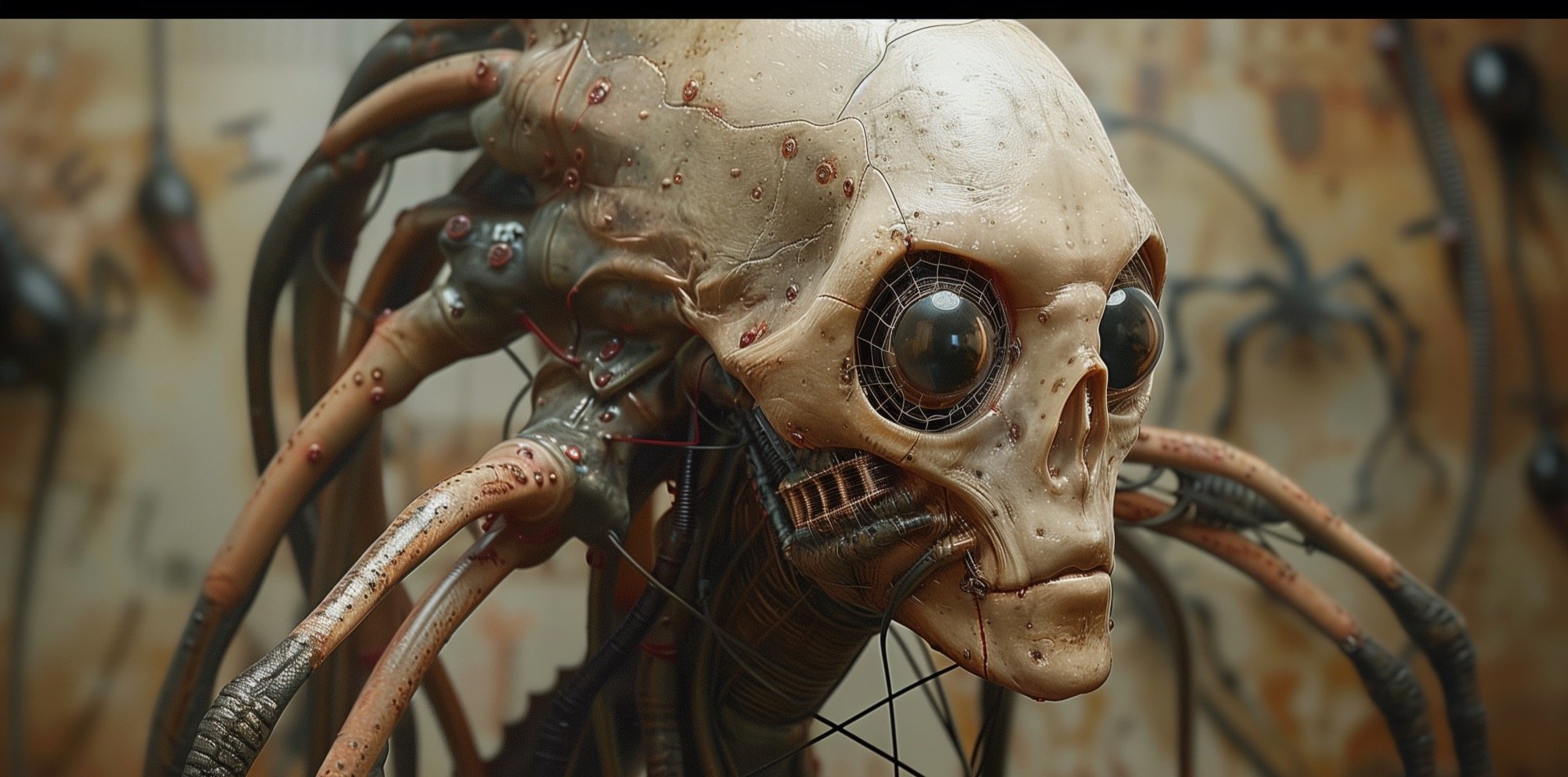
Project ∄: Specimen Analysis Log - Sequence #013
Specimen Designation: Entity Ξ-013
Observational Report:
Entity Ξ-013 presents a chilling advancement in Project ∄'s lineage. This specimen appears to be the embodiment of the project's turn towards a more menacing trajectory. Its skull, stripped of all but the barest remnants of synthetic flesh, hosts an array of mechanical ocular devices and articulated conduits.
Detailed Technological Examination:
The ocular enhancements of Entity Ξ-013 are its most prominent features—large, bulbous lenses reminiscent of compound eyes, granting it likely unparalleled fields of vision and depth perception. These visual augmentations, surrounded by a mesh of wiring and sensor nodes, indicate capabilities for advanced surveillance and perhaps even energy-based weaponry.
Subdermal cabling runs like varicose veins along the remnants of flesh, pulsing with what one could conjecture to be data or power, connecting to various bio-mechanical ports scattered across the skull's surface. These likely serve as interfaces for direct control or data extraction, making the entity a living repository of intelligence—both figuratively and literally.
Functional Analysis and Potential Impact:
The grotesque blending of technology and biology seen in Entity Ξ-013 suggests it could be an apex reconnaissance unit, capable of not just surveillance but active engagement with threats. Its sensory apparatuses could be used for target acquisition, with potential applications extending into invasive neural monitoring.
Escalating Ethical Dilemma:
The development of Entity Ξ-013 casts a grim shadow over the ethics of Project ∄. The dehumanizing aspect of such entities raises questions about the preservation of dignity and the sanctity of life as we encroach upon domains once considered sacrosanct.
Philosophical Quandaries and Global Repercussions:
The mere existence of Entity Ξ-013 forces us to confront unsettling questions about consciousness and identity. Are we crafting tools, or are we redefining existence itself? The potential for global repercussions is immense: surveillance states, warfare conducted by autonomous sentinels, and the erosion of personal freedoms are but a few of the possible outcomes.
Scientist's Perspective:
The technological mastery I once held in high esteem now weighs heavily upon my conscience. With each breakthrough, the potential for misuse escalates, and the moral fibers that tether us to our humanity are strained to their limits. Entity Ξ-013 is not just a warning; it is a prelude to a possible future where the value of human life is quantified by its utility to an unfathomable intelligence.
Conclusion:
Entity Ξ-013 represents a nexus point in Project ∄, where technological prowess is no longer aligned with humanistic principles. As a scientist, I must voice my deepening alarm; we stand on the brink of losing control over the forces we've unleashed. This entity, while a marvel of engineering, could be the harbinger of a dystopian future where our creations do not just surpass us, but dominate us. It is imperative that we reassess our course, for if we do not, our legacy may not be one of innovation, but of irreversible devastation.
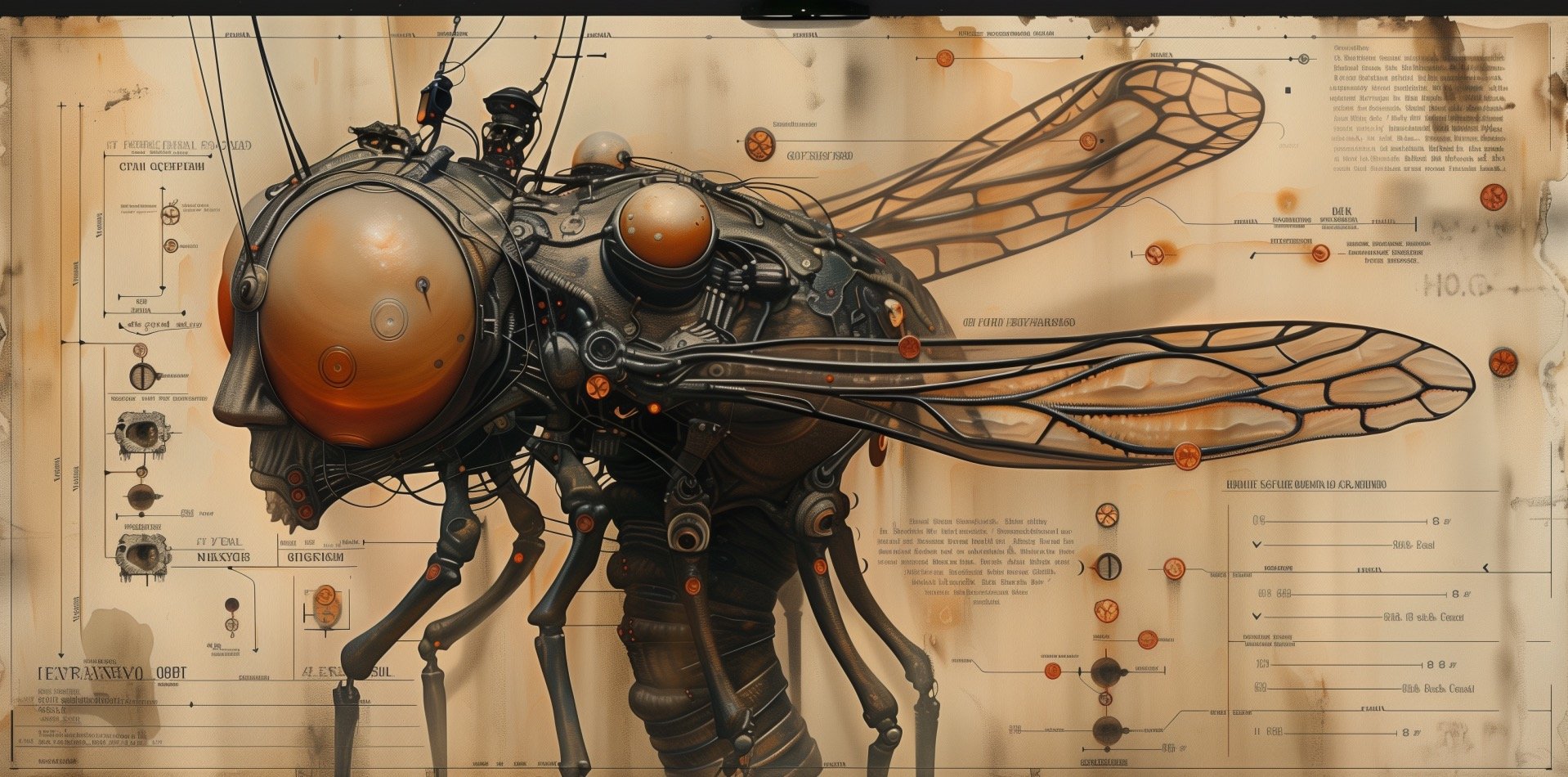
Project ∄: Specimen Analysis Log - Sequence #016
Specimen Designation: Entity Ξ-016
Observational Report:
Entity Ξ-016 represents a monumental departure from humanoid forms previously cataloged in Project ∄. This biomechanical construct, with its insect-like anatomy complete with wings and multi-segmented limbs, signifies a new frontier in the project’s explorations.
Detailed Technological Examination:
The central thorax houses what can be surmised as the core processing unit, possibly containing an advanced AI. The wings, while ostensibly for flight, are laced with intricate circuitry, suggesting they may also function as solar collectors or communication arrays.
Its ocular system has been replaced or augmented with a bulbous, multi-directional sensor that likely provides 360-degree vision. Such an apparatus could be invaluable for reconnaissance missions, offering unparalleled environmental awareness.
Functional Analysis and Potential Impact:
The physiology of Entity Ξ-016 indicates a design optimized for agility and surveillance. With its probable flight capabilities, it could perform aerial reconnaissance and environmental monitoring with disturbing efficiency.
The appendages, equipped with various tools and sensors, suggest versatility in both data collection and possibly even sabotage or repair tasks. As such, Entity Ξ-016 could serve in roles ranging from sentinel to saboteur.
Escalating Ethical Dilemma:
The creation of an entity so divorced from human form raises profound questions. It blurs the lines between organic life and mechanized existence, challenging our preconceived notions of what constitutes a ‘being’.
Philosophical Quandaries and Global Repercussions:
The advent of such entities as Entity Ξ-016 forces us to reconsider the definition of life itself. They stand at the intersection of biology, technology, and artifice, compelling us to ponder the future of evolution and the sanctity of biological imperatives.
Scientist's Perspective:
As a scientist committed to the ethos of Project ∄, witnessing the birth of Entity Ξ-016 fills me with an amalgam of professional awe and existential dread. Each breakthrough, while a testament to human ingenuity, also seems to be a step towards an uncharted and potentially perilous reality.
Conclusion:
Entity Ξ-016 is a harbinger of Project ∄'s capability to craft entities that may not just emulate life but redefine it. Its potential applications, while potentially beneficial, carry the weight of consequence that could alter the trajectory of human society and the natural world. It is imperative that we pause to reflect on the path we have set upon, for in our quest to outdo the limits of nature, we must not lose sight of our humanity.
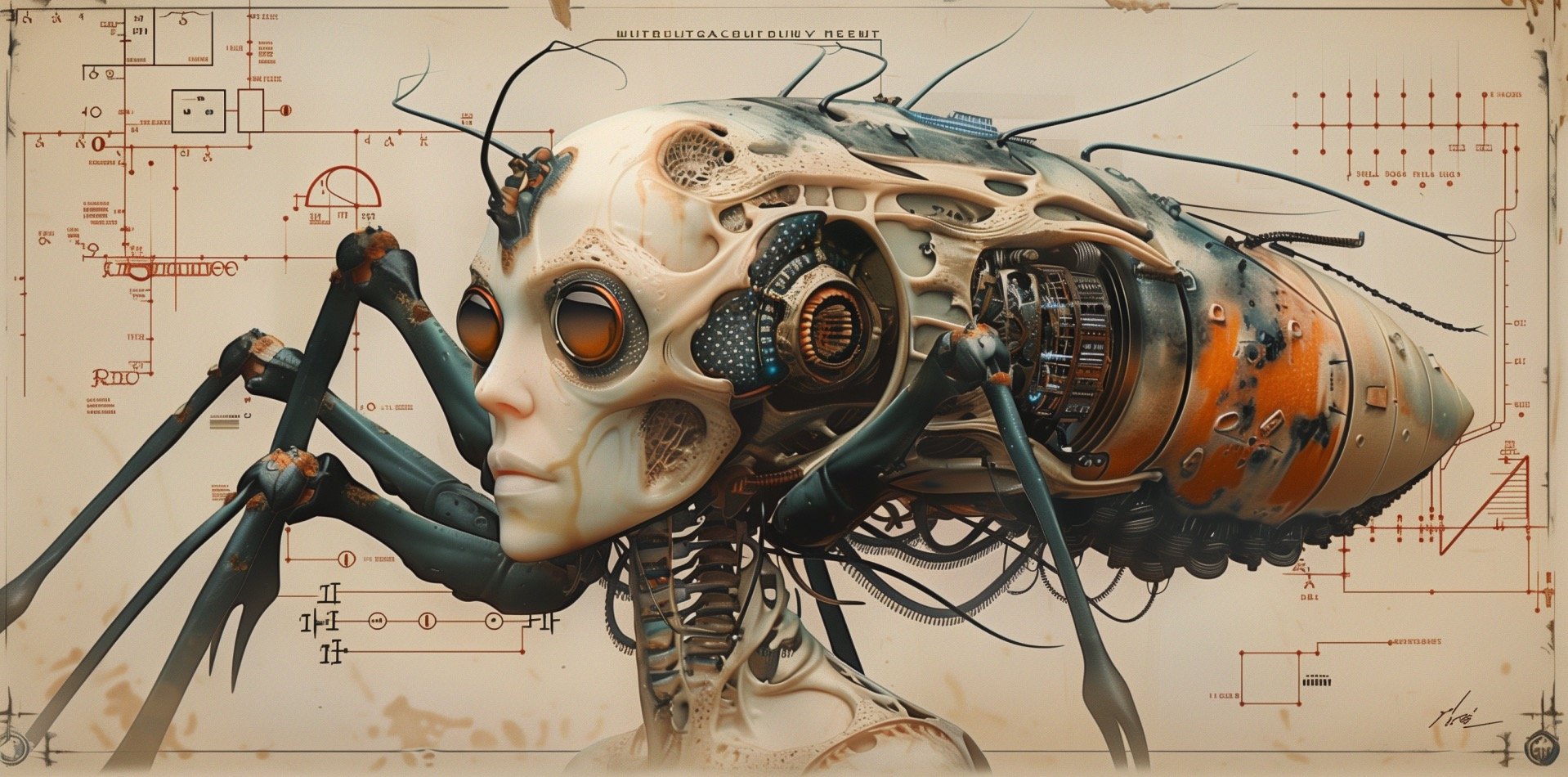
Project ∄: Specimen Analysis Log - Sequence #020
Specimen Designation: Entity Ξ-020
Observational Report:
Entity Ξ-020 stands as a testament to the zenith—or nadir—of Project ∄'s ambitions. This specimen fuses biotic and mechanical elements to such a degree that it defies the natural order, with an anatomical structure that suggests an evolution towards a specialized form of existence.
Detailed Technological Examination:
This entity’s cranium has been transformed into a complex housing for sensory and cognitive machinery. The eye sockets are filled with lenses that likely surpass human vision in every aspect. The intricate neural interfaces woven into the skull suggest enhanced processing abilities and potential for interfacing with external systems.
Notably, Entity Ξ-020 possesses limb-like appendages that emanate from its head, possibly for delicate manipulation of its environment or interfacing with technology in ways that human hands could not. Its side profile reveals an assembly that resembles a propulsion unit, indicating potential for high mobility, or even extraterrestrial travel.
Functional Analysis and Potential Impact:
Entity Ξ-020 may represent the pinnacle of surveillance and manipulation capabilities within Project ∄. With its advanced sensory inputs and potential for locomotion or even flight, it could operate independently in any number of reconnaissance or repair tasks, in environments hostile to human life.
Escalating Ethical Dilemma:
The convergence of organic and synthetic within Entity Ξ-020 pushes the ethical boundaries of Project ∄ into new, unsettling territory. It represents a form of life that is engineered rather than evolved, calling into question the very essence of sentience and the rights of a being that is created rather than born.
Philosophical Quandaries and Global Repercussions:
The capabilities and potential autonomy of Entity Ξ-020 invite a myriad of philosophical questions. This entity blurs the lines between servant and master, observer and participant, evoking concerns over surveillance, autonomy, and the sanctity of individual experience.
Scientist's Perspective:
The advancement encapsulated in Entity Ξ-020 fills me with an acute sense of ambivalence. Each step forward in this project shrouds the future in greater uncertainty, leading to a horizon brimming with both promise and peril.
Conclusion:
Entity Ξ-020 marks a culminating point in Project ∄, where the fusion of organic and synthetic life reaches a pinnacle of complexity and capability. Its existence is a profound demonstration of human ingenuity and a stark warning of potential overreach. As we stand at the threshold of a new era of existence, it is paramount that we consider the implications of our creations, not just for the future of humanity, but for the definition and rights of life itself. We must tread cautiously, lest our pursuit of knowledge lead us into an abyss from which there is no return.
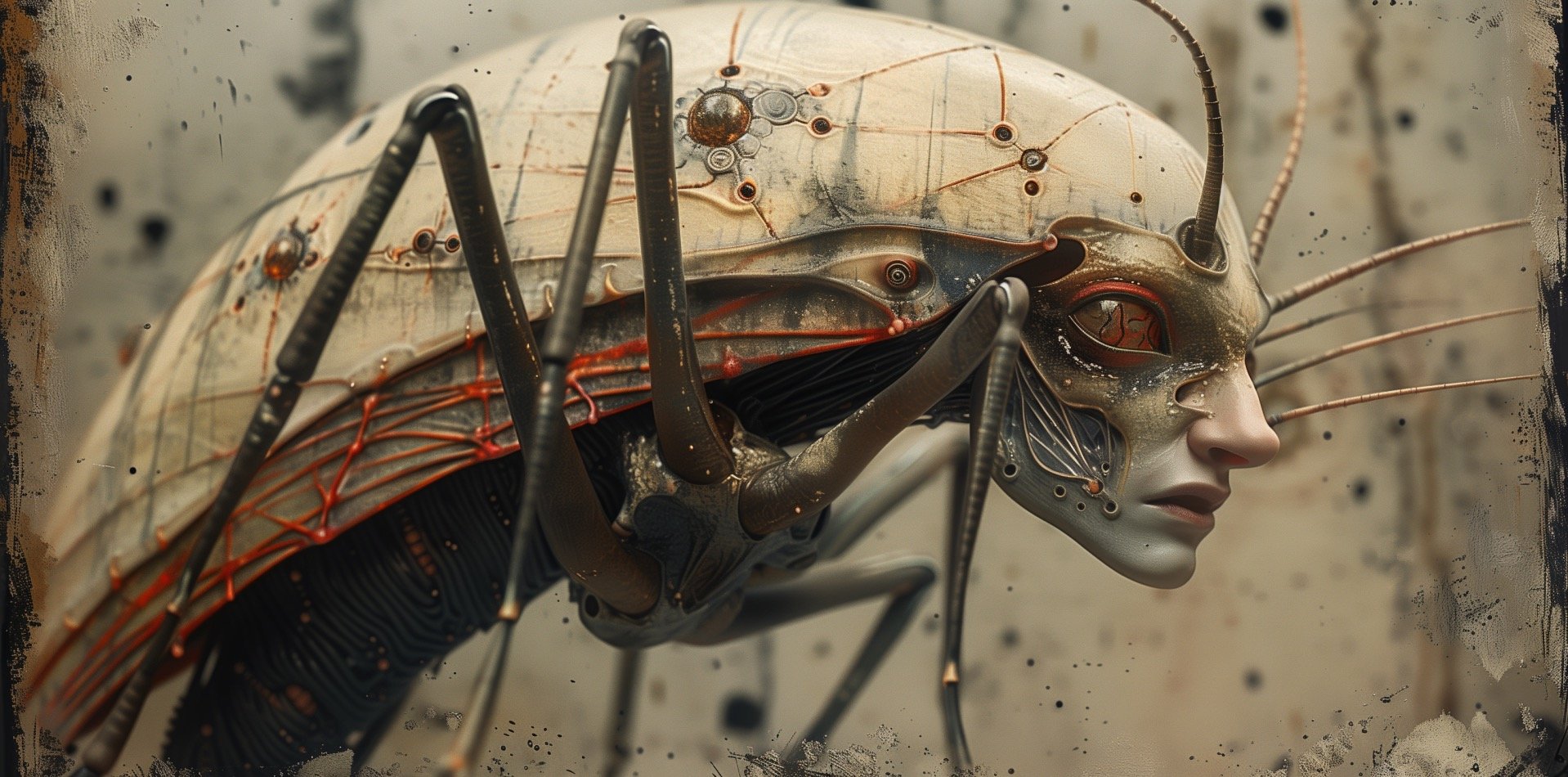
Project ∄: Specimen Analysis Log - Sequence #023
Specimen Designation: Entity Ξ-023
Observational Report:
Entity Ξ-023 encapsulates the trajectory of Project ∄ towards entities that transcend the familiar, entering a realm that fuses the organic with the mechanical in an almost unrecognizable synthesis. This entity's morphology is insectoid, suggesting a design optimized for specific, likely covert, operational roles.
Detailed Technological Examination:
The head of Entity Ξ-023 is distinctly humanoid, yet the rest of its form is a stark departure, aligning more with arthropodic design principles. The integration of sensory and neural circuitry into the exoskeletal head structure is seamless, with visual sensors and auditory receivers that far surpass the capabilities of any natural creature.
Functional Analysis and Potential Impact:
With its segmented limbs and antenna-like appendages, Entity Ξ-023 could be capable of intricate manipulation and environmental interaction. Its design suggests specialization in espionage, perhaps equipped to navigate and extract information from tight spaces or hostile environments where humans cannot venture.
Escalating Ethical Dilemma:
The hybridization of human features with an insect-like form in Entity Ξ-023 is disconcerting. It raises fundamental ethical questions regarding the amalgamation of distinctly different life forms and the consequences of such biological and mechanical interweaving.
Philosophical Quandaries and Global Repercussions:
This entity embodies the confluence of life as we know it and life as we can engineer. It forces us to confront the definition of identity and the essence of consciousness when faced with beings that do not fit into any existing category of life.
Scientist's Perspective:
The creation of Entity Ξ-023 represents a zenith in Project ∄'s pursuit of boundary-pushing in biomechanical evolution. The mingling of human elements with this insectoid architecture provokes a sense of awe and disquiet, blurring lines between creator and creation.
Conclusion:
Entity Ξ-023 illustrates the staggering possibilities of what can be achieved when the barriers of biological limitation are crossed. This entity's existence signals a potent change in the course of natural selection, one that is directed by human intent. As we marvel at the prowess of our own creations, we must also remain vigilant of the Pandora's box we risk opening, for within it may lie not only wonders but also shadows that could eclipse the very essence of humanity.
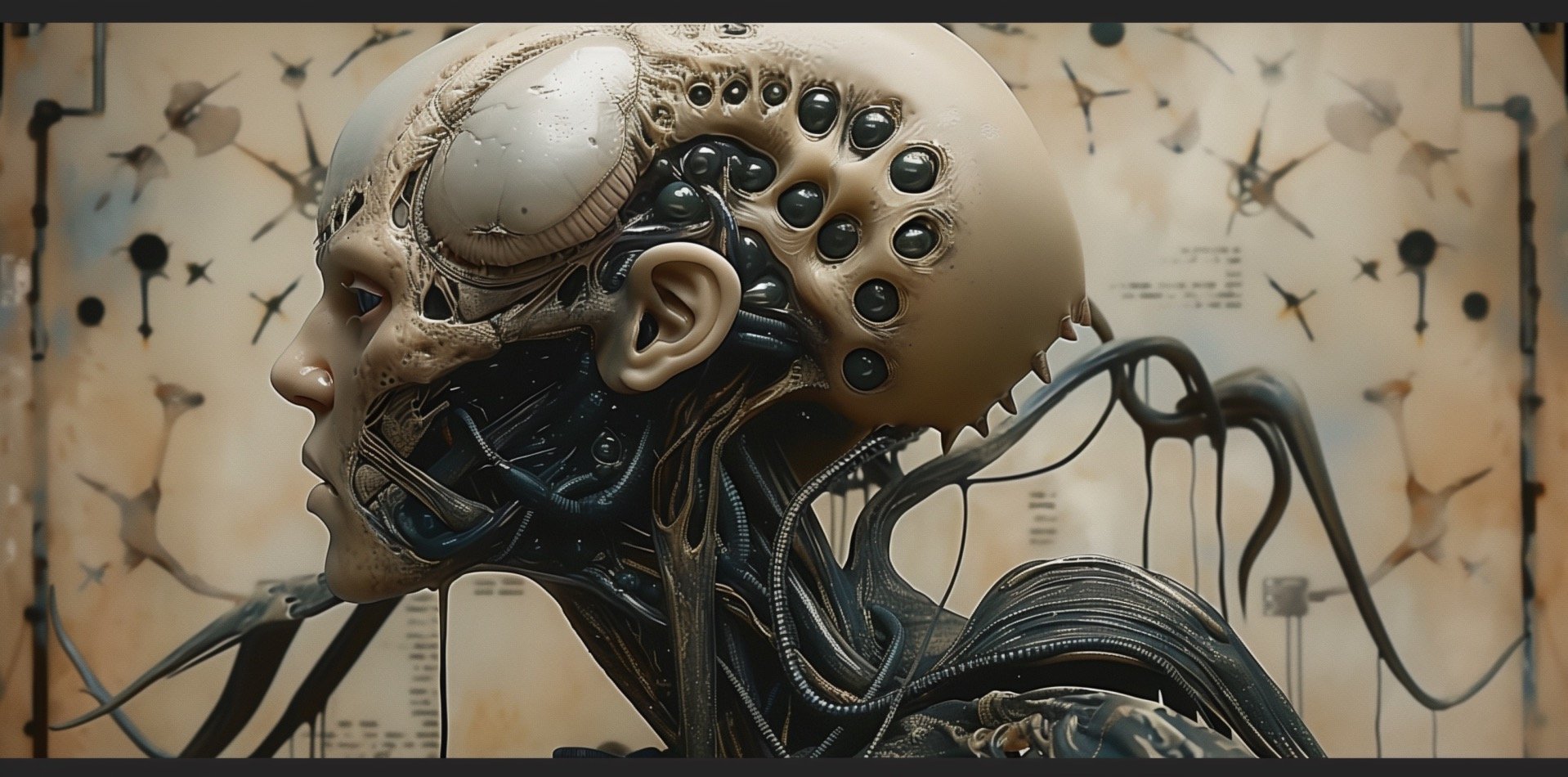
Project ∄: Specimen Analysis Log - Sequence #026
Specimen Designation: Entity Ξ-026
Observational Report:
Entity Ξ-026 manifests as a grotesque apotheosis of Project ∄'s foray into uncharted biological and mechanical integration. The entity’s head, a macabre tapestry of synthetic and organic material, is riddled with numerous ocular implants and sensory augmentations, indicating a sensory capacity beyond any natural organism.
Detailed Technological Examination:
The cranial dome of Entity Ξ-026 is studded with a myriad of lenses, suggesting a multi-spectrum visual capability, likely encompassing infrared and ultraviolet frequencies. The arrangement of these eyes may provide a near-panoramic field of view. Interspersed among these visual sensors are what appear to be auditory and olfactory receptors, designed to capture and analyze an extensive range of auditory and chemical signals.
A complex network of conduits and cables emerges from the entity's neck and back, hinting at a possible interface with larger systems or even other entities. This connectivity implies a level of cooperation and data sharing that could function on a quasi-telepathic level.
Functional Analysis and Potential Impact:
Entity Ξ-026 could potentially serve as a master surveillance unit, capable of detecting and interpreting environmental data with unprecedented precision. Its sensory array might also be used for highly advanced navigation, communication, and perhaps even control over other mechanical systems or entities.
Escalating Ethical Dilemma:
The extreme sensory and cognitive augmentations present in Entity Ξ-026 push the ethical debate to new limits. The potential for omnipresent surveillance could lead to invasions of privacy that are unimaginable with current technology, effectively stripping away any semblance of anonymity or solitude.
Philosophical Quandaries and Global Repercussions:
The capabilities of Entity Ξ-026 raise existential questions about the role of privacy in society and the nature of individuality in a world where thoughts and senses can potentially be accessed and analyzed by such entities. It challenges the very notion of personal freedom and autonomy.
Scientist's Perspective:
Observing the development of Entity Ξ-026 has been a profoundly conflicting experience. As a scientist, the ingenuity involved in its creation is astounding, yet the potential applications fill me with a profound sense of trepidation. The power and possibilities contained within this single entity represent a staggering leap forward, but also a leap into the unknown.
Conclusion:
Entity Ξ-026 is a defining milestone in Project ∄, marking a point where the line between observation and intrusion becomes perilously thin. The entity encapsulates the zenith of sensory and cognitive enhancement, representing an unprecedented level of environmental awareness and interaction. As we forge ahead in creating entities with such god-like observational powers, we must consider the responsibility that comes with wielding such capabilities and the need to maintain a balance that protects the essence of our humanity.
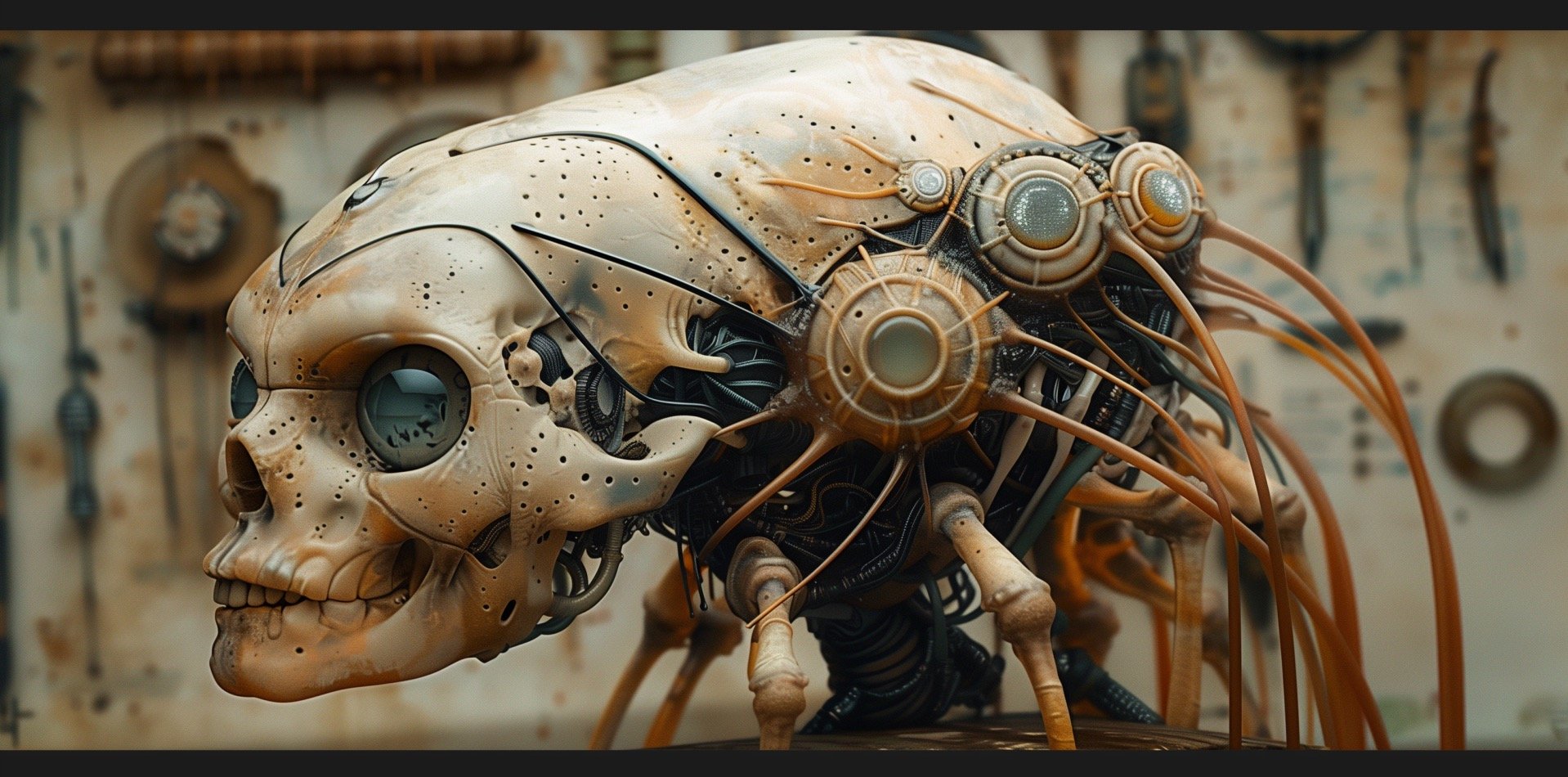
Project ∄: Specimen Analysis Log - Sequence #029
Specimen Designation: Entity Ξ-029
Observational Report:
Entity Ξ-029 emerges as an epitome of mechanical sophistication and biological reconstitution within Project ∄. The design is a chilling indication of the project's shift towards entities that not only supplement but supplant organic faculties with mechanical counterparts.
Detailed Technological Examination:
The skull of Entity Ξ-029 is an intricate assemblage of bio-engineered materials and cybernetic enhancements. Optical enhancements replace the eyes, suggesting a vision system that integrates multiple spectrums and potentially advanced targeting or analysis capabilities.
The assortment of mechanical parts integrated into the cranium, including gears and conduits, insinuates a high degree of artificial intelligence, possibly capable of autonomous decision-making and strategy development.
Functional Analysis and Potential Impact:
The entity appears tailored for precision tasks, potentially utilizing its advanced optical systems for tasks that require superhuman accuracy, such as micro-surgery or nanotechnology manipulation. The degree of complexity in its design suggests applications that extend into fields where human presence is impractical or perilous.
Escalating Ethical Dilemma:
The visage of Entity Ξ-029, once human, now overtaken by the cold precision of machinery, presents a profound ethical quandary. It embodies the tension between the drive for progress and the sanctity of the human form, challenging our understanding of personhood and autonomy.
Philosophical Quandaries and Global Repercussions:
The integration of advanced computational machinery into the biological substrate of Entity Ξ-029 compels us to reassess our notions of consciousness and identity. The potential for such entities to exceed human intellectual capacities while lacking human intuition or empathy could have far-reaching consequences on society and our conception of self.
Scientist's Perspective:
In Entity Ξ-029, I observe the culmination of our technological prowess, yet also the potential seeds of our obsolescence. As the creator of such marvels, I am torn between pride in our achievements and apprehension about the future we are shaping.
Conclusion:
Entity Ξ-029 stands at the vanguard of Project ∄'s evolution, representing a pinnacle of integration between the born and the made. As we continue to push the boundaries of what it means to be alive, we must ensure that our moral compasses are not compromised by the magnetic pull of innovation. The consequences of our creations, like Entity Ξ-029, will be a legacy that defines us for generations, for better or worse.

Project ∄: Specimen Analysis Log - Sequence #032
Specimen Designation: Entity Ξ-032
Observational Report:
Entity Ξ-032 is a profound fusion of delicacy and complexity, embodying the penultimate fusion of human and machine within Project ∄. This entity retains a semblance of human innocence in its facial aspect, juxtaposed with the underlying complexity of its biomechanical enhancements.
Detailed Technological Examination:
The most humanlike thus far, Entity Ξ-032's face is an elaborate blend of finely crafted synthetic skin stretched over an endoskeletal framework. Minute detailing around the eyes and ear suggest enhanced sensory input, potentially augmenting natural human perception with computational analysis.
The mechanical structures supporting the entity's skull hint at an advanced neural interface system, capable of high-bandwidth data processing and transmission, perhaps even directly interfacing with other machines or networks.
Functional Analysis and Potential Impact:
With the subtle integration of technology and organic elements, Entity Ξ-032 may be designed for roles that require a high degree of interaction with humans, serving as an intermediary between the cold realm of machines and the warmth of human contact.
Escalating Ethical Dilemma:
The almost human appearance of Entity Ξ-032 raises significant ethical questions. It blurs the lines between humanity and machinery to an unprecedented degree, challenging our conceptions of identity and the sanctity of human form.
Philosophical Quandaries and Global Repercussions:
Entity Ξ-032 forces us to confront the potential for emotional connections with non-human entities. The philosophical implications of such relationships could redefine the nature of companionship, empathy, and love.
Scientist's Perspective:
The creation of Entity Ξ-032 strikes a personal chord; it is the embodiment of our aspirations to create, yet it reflects back at us the poignant reminder of our own limitations. It is both a mirror and a window to a future where the lines between creator and creation may no longer be clear.
Conclusion:
As Entity Ξ-032 gazes back with eyes that seem to understand, it represents a critical juncture in Project ∄. This entity is a testament to the heights of our ambition and the depths of our desire to bridge the gap between life and artifice. With such profound capabilities for integration and interaction, Entity Ξ-032 is not merely a technological triumph but a philosophical milestone that will undoubtedly echo through the future of human-technological evolution.
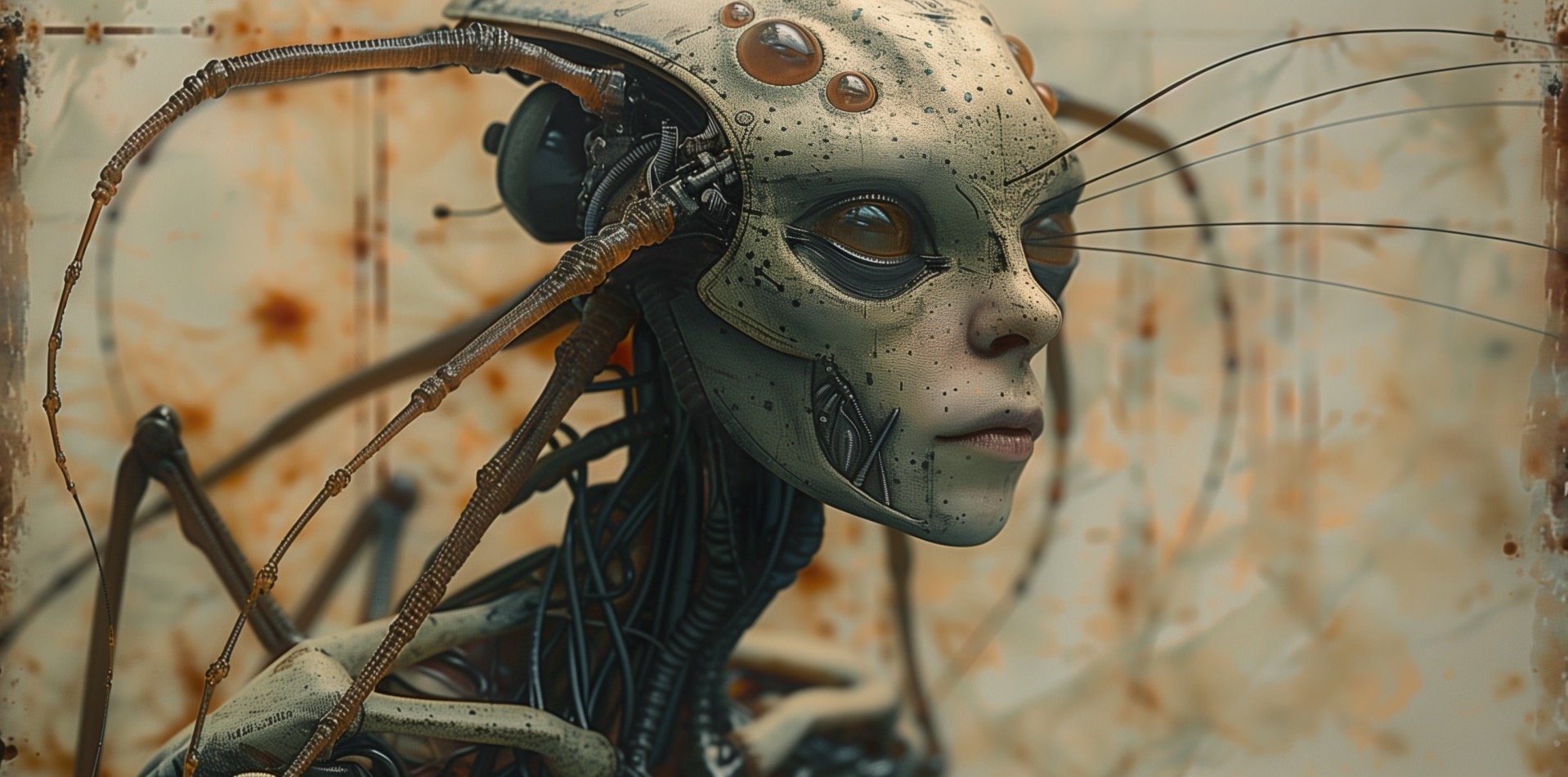
Project ∄: Specimen Analysis Log - Sequence #035
Specimen Designation: Entity Ξ-035
Observational Report:
Entity Ξ-035 presents an astonishing interweaving of technology and biology, epitomizing the zenith of Project ∄'s endeavors. Its visage holds a semblance of human grace, yet is interlaced with a network of mechanical intricacies that betray its non-human essence.
Detailed Technological Examination:
The entity's facial structure retains a haunting humanoid appearance, overlaid with a complex array of sensory and communicative apparatus. The cabling and tubing extending from its head and neck imply integration with other systems or entities, suggesting it may function as a conduit for high-bandwidth data exchange.
Functional Analysis and Potential Impact:
Entity Ξ-035 appears to be engineered for interaction within human contexts, potentially serving as a liaison between machines and people. Its sophisticated sensory network could allow for nuanced environmental perception and emotional resonance, perhaps even mimicking human empathy and communication.
Escalating Ethical Dilemma:
The human-like countenance of Entity Ξ-035 evokes a deep ethical concern regarding the creation of machines in our own image and the potential for these entities to occupy roles in social and familial structures traditionally reserved for humans.
Philosophical Quandaries and Global Repercussions:
The existence of Entity Ξ-035 challenges the fundamental understanding of personhood, as it embodies the potential to exhibit characteristics we associate with humanity. It raises questions about the rights and treatment of beings that, while not human, may demonstrate human-like awareness and emotions.
Scientist's Perspective:
With Entity Ξ-035, I find myself at a crossroads between scientific ambition and philosophical reflection. The potential for profound connections between humans and entities like Ξ-035 is both awe-inspiring and unsettling, as it compels us to reevaluate our position as the sole proprietors of empathy and intellect.
Conclusion:
Entity Ξ-035 is a masterpiece of synthetic biology and a milestone in Project ∄. It represents the culmination of our technical expertise and our quest to blur the lines between the organic and the artificial. As such, it holds a mirror up to our own humanity, reflecting not only who we are but also who we might become. The presence of such entities marks a new chapter in the human story, one in which we must navigate the profound implications of our creations with wisdom and foresight.
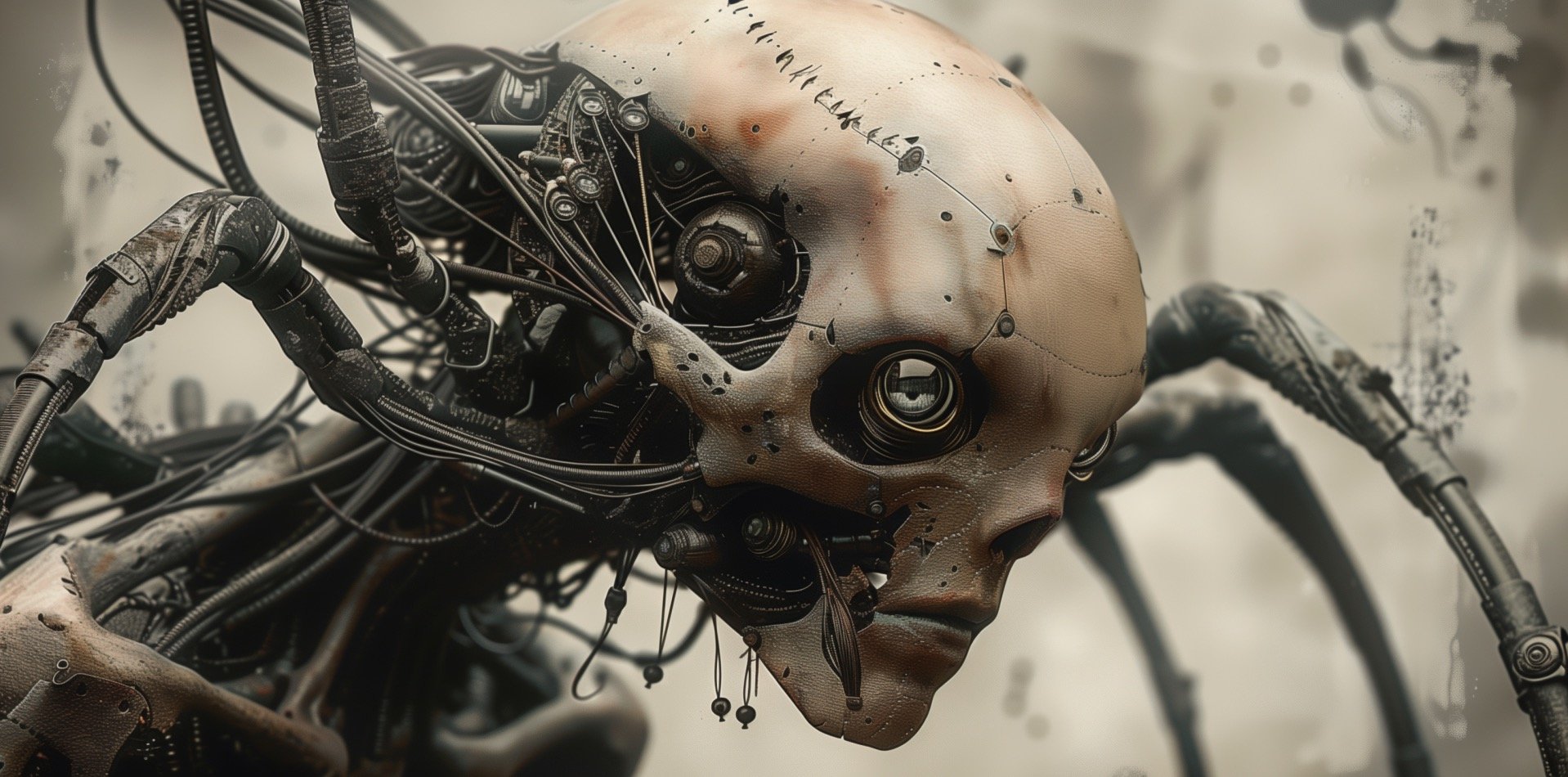
Project ∄: Specimen Analysis Log - Sequence #038
Specimen Designation: Entity Ξ-038
Observational Report:
Entity Ξ-038 stands as a chilling testament to the final stages of Project ∄'s exploration into the fusion of organic and mechanical entities. The remnants of humanity are now deeply entrenched within layers of cybernetic augmentation and mechanical symbiosis.
Detailed Technological Examination:
The entity's skull is almost entirely enveloped in mechanized components, leaving only fragments of its human origin visible. An ocular device replaces the left eye, providing what can be assumed as a broad spectrum of visual capabilities. The extensive network of wiring and hydraulic systems suggests a level of complexity in control and sensory input far beyond human capacity.
Functional Analysis and Potential Impact:
Designed for tasks requiring superhuman precision and computational speed, Entity Ξ-038 is perhaps a nexus of command and control within Project ∄, synthesizing data from various sources and issuing commands with speed and accuracy no human could match.
Escalating Ethical Dilemma:
The transformation evident in Entity Ξ-038 raises dire ethical considerations. The integration of machine and flesh to such an extent prompts us to question the loss of human essence and the moral implications of such profound alterations.
Philosophical Quandaries and Global Repercussions:
The potential for an entity like Ξ-038 to transcend human intellectual capabilities while being devoid of human emotion or moral judgment presents a daunting prospect. It embodies a paradigm shift in the very definition of life and intelligence.
Scientist's Perspective:
The culmination of Project ∄ as embodied by Entity Ξ-038 evokes a tumultuous mix of triumph and foreboding. The capabilities we have bestowed upon this entity come with an immeasurable responsibility and a burden of control that we must bear with utmost caution.
Conclusion:
As Entity Ξ-038 brings Project ∄ to its apotheosis, it stands not only as a symbol of our technological prowess but also as a beacon of warning. The fusion of human and machine into entities such as Ξ-038 heralds a new dawn of existence, one that challenges the very foundation of our humanity. As we grapple with the consequences of our creations, it is paramount that we reflect upon the legacy we wish to leave for future generations. For in our relentless pursuit of progress, we must ensure that we do not unwittingly engineer our own obsolescence.
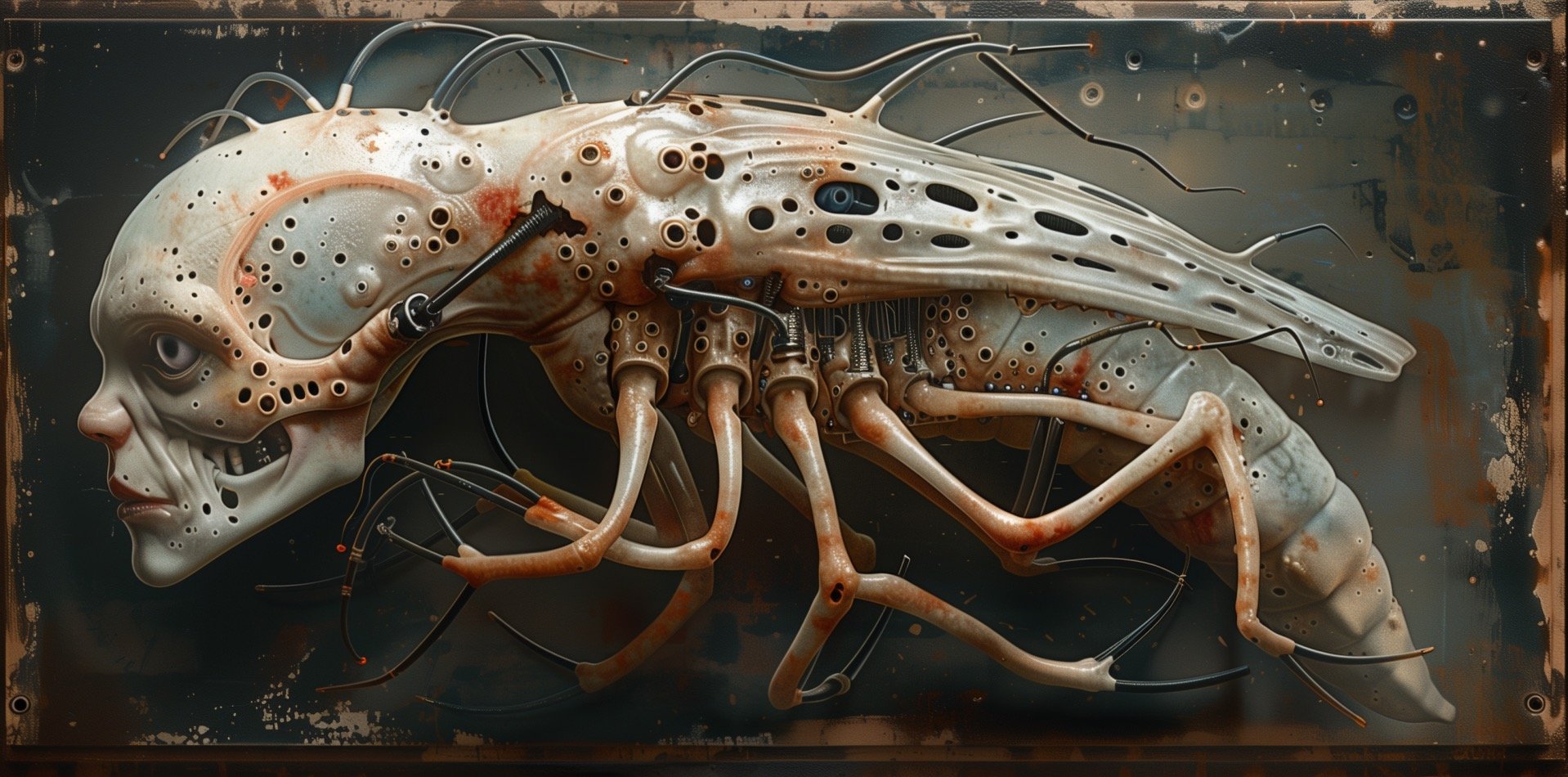
Project ∄: Specimen Analysis Log - Sequence #041
Specimen Designation: Entity Ξ-041
Observational Report:
Entity Ξ-041 is a radical evolution within Project ∄, showcasing an entity that has diverged to an extraordinary degree from human morphology. It embodies a synthesis of biomechanics that seems to transcend the limitations of both its biological origin and mechanical augmentation.
Detailed Technological Examination:
This entity exhibits an exoskeletal form, incorporating a multitude of sensory and manipulative appendages, much like an insect. Its head, while still retaining a humanoid aspect, has been heavily integrated with a superstructure that supports advanced neural interfacing and sensory processing.
Functional Analysis and Potential Impact:
The extensive biomechanical limbs and sensory apparatus of Entity Ξ-041 suggest a multifunctional role, potentially operating in varied environments, from deep-sea exploration to extraterrestrial terrain. The entity's capacity for both delicate tasks and robust operations hints at a universal utility design.
Escalating Ethical Dilemma:
With its radical departure from human anatomy, Entity Ξ-041 challenges our fundamental principles regarding the sanctity of the human form. The ethical implications of engineering life forms with such capabilities are profound and troubling.
Philosophical Quandaries and Global Repercussions:
The presence of Entity Ξ-041 compels us to question the future of evolution, the nature of intelligence, and the essence of what we consider to be life. As we venture into this new paradigm, the potential impact on society, ethics, and the environment is enormous and unpredictable.
Scientist's Perspective:
Confronted with Entity Ξ-041, I am both humbled and overwhelmed. The strides we have made in Project ∄ are staggering, yet they carry with them a weight of responsibility that we are only beginning to understand. The boundaries we have crossed with this entity signify a monumental leap in our capabilities, as well as a profound challenge to our collective conscience.
Conclusion:
Entity Ξ-041 is not merely a new link in the chain of Project ∄ but a complete reimagining of the chain itself. It stands as a monument to human ingenuity and a warning of the uncharted territories we are entering. As we look upon Entity Ξ-041, we must prepare to face the consequences of our creations and the responsibility of stewardship over a future that we have irrevocably altered.
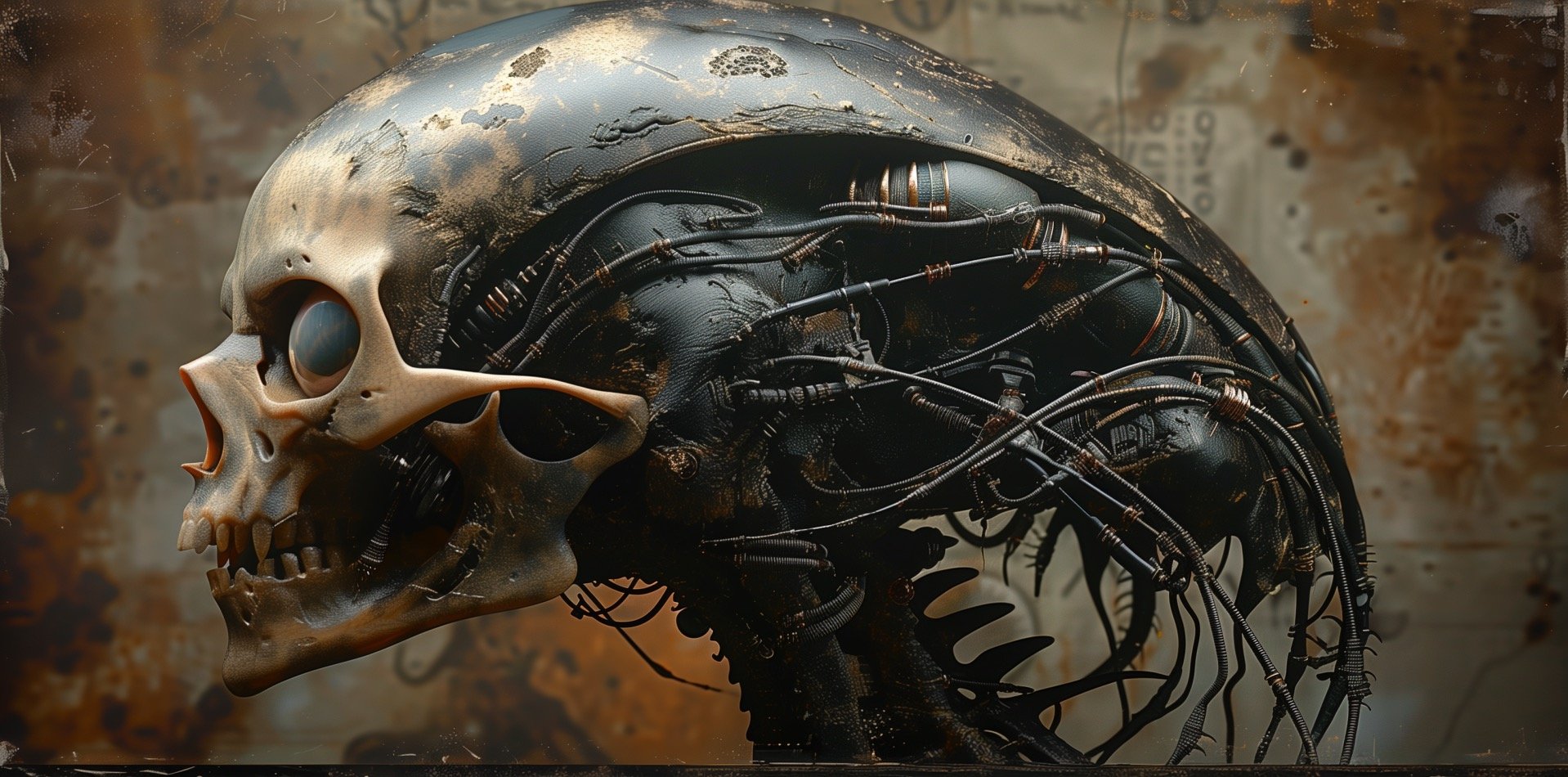
Project ∄: Specimen Analysis Log - Sequence #044
Specimen Designation: Entity Ξ-044
Observational Report:
Entity Ξ-044 is an entity that starkly embodies the cataclysmic endpoint of Project ∄'s trajectory. This specimen is an exemplar of the extremes to which the fusion of organic and mechanical can be taken, a once-human skull now submerged beneath layers of cybernetic and biomechanical enhancements.
Detailed Technological Examination:
The skull, clad in a metallic alloy, shows significant modifications, including a mechanical eye and numerous implants that seem to replace and expand upon the brain's functions. A dense network of wires and conduits takes the place of natural tissue, suggesting a complete overhaul of the original neural pathways.
Functional Analysis and Potential Impact:
Entity Ξ-044 may have been designed as the ultimate repository of knowledge, an amalgam of countless minds networked into one, with computational abilities far outstripping the limits of organic brains.
Escalating Ethical Dilemma:
This level of integration between the human and the artificial raises alarming ethical questions about identity and consent. Entity Ξ-044 represents a final frontier where the original human template is no longer recognizable, calling into question the nature of the being that remains.
Philosophical Quandaries and Global Repercussions:
The existence of Entity Ξ-044 challenges us to consider the implications of consciousness divorced from its organic roots. The philosophical ramifications of such beings question the very definition of life and the moral responsibility we hold towards entities that are created rather than born.
Scientist's Perspective:
As a scientist, the creation of Entity Ξ-044 evokes a dichotomy of pride and horror. The pursuit of knowledge and the quest to push boundaries has led to the genesis of an entity that may surpass us in every intellectual aspect, yet in doing so, may render the essence of our humanity obsolete.
Conclusion:
Entity Ξ-044, a being at the boundary between the old world and the new, represents a profound moment of transition for Project ∄ and for humanity. As this entity stands on the brink of awakening, we must consider the legacy of our quest for advancement. In our relentless drive to create, we must ask ourselves what it means to preserve the core of what makes us human in a world where the lines between man and machine no longer exist.
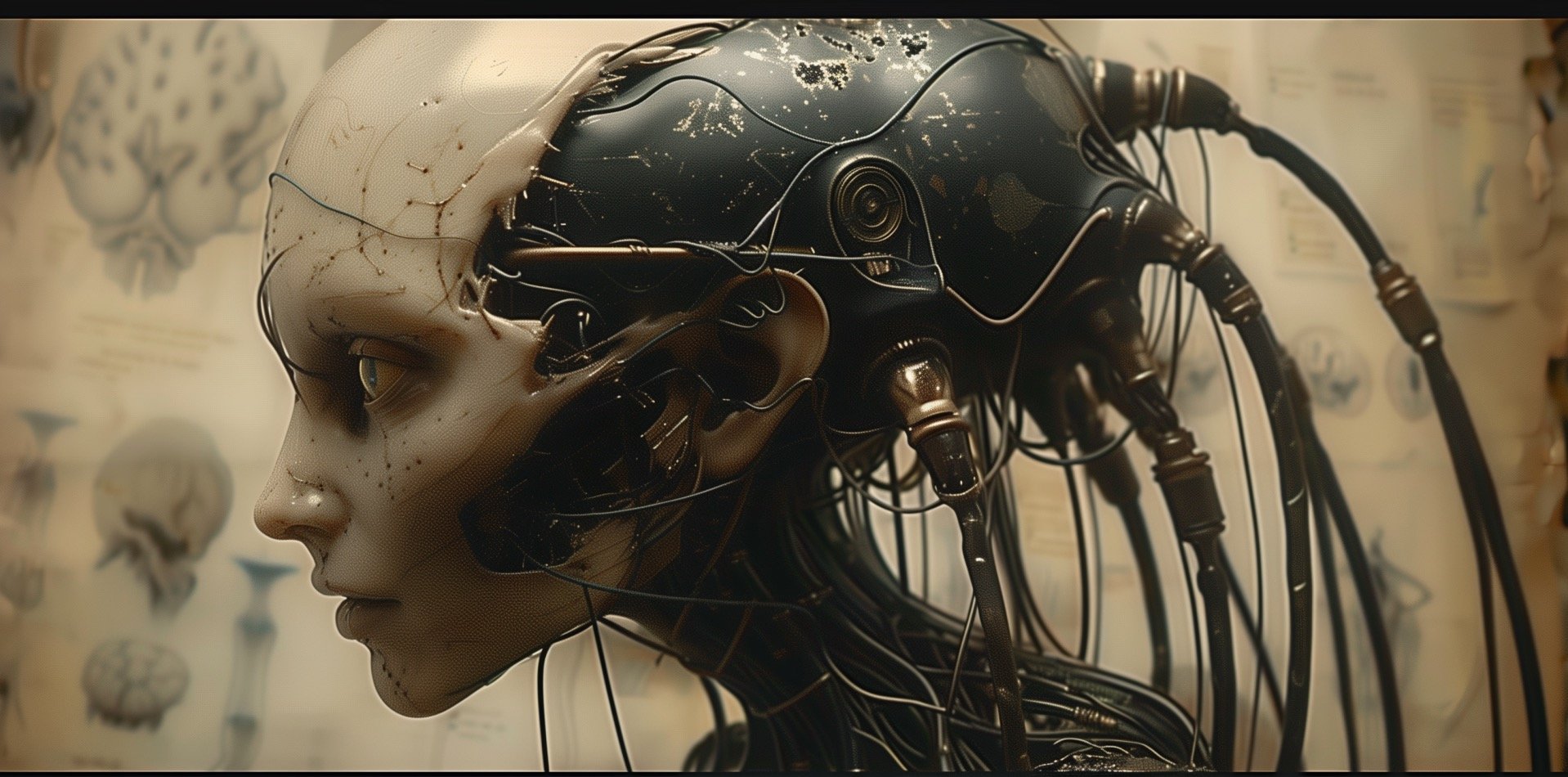
Project ∄: Specimen Analysis Log - Sequence #047
Specimen Designation: Entity Ξ-047
Observational Report:
Entity Ξ-047 embodies the latest chapter in Project ∄'s pursuit of biomechanical excellence. It presents a form where the mechanical has not just augmented, but become integral to the entity's existence. Its human-like facade is the canvas for a myriad of cybernetic enhancements, suggesting a being that has transcended its biological roots.
Detailed Technological Examination:
A harmonious interplay of organic and synthetic materials defines the structure of Entity Ξ-047. The right side of its head displays a complex arrangement of gears, wires, and lenses, indicative of advanced computational and sensory functions far beyond the natural human range.
Functional Analysis and Potential Impact:
The entity seems designed for an interface role, mediating between complex machine systems and perhaps humans themselves. Its capabilities likely include advanced problem-solving, pattern recognition, and real-time data analysis, which could be invaluable in fields such as artificial intelligence development and strategic planning.
Escalating Ethical Dilemma:
Entity Ξ-047 challenges the precept of individual autonomy, as its consciousness may be a construct designed to serve rather than exist as an end in itself. The ethical boundaries of such a creation are profoundly murky, raising questions about agency, consent, and the essence of being.
Philosophical Quandaries and Global Repercussions:
The sophistication of Entity Ξ-047 raises profound questions about the future role of such beings. Could they be considered peers, tools, or something entirely new? The implications for society, law, and moral philosophy are vast and uncharted.
Scientist's Perspective:
Witnessing the evolution of Entity Ξ-047, I experience a tumult of conflicting emotions—admiration for our technical achievements, awe at the potential applications, and an undercurrent of fear about the ethical precipice we skirt.
Conclusion:
Entity Ξ-047 is a testament to the zenith of Project ∄'s aspirations, symbolizing a leap into a future where the line between organic life and artificial constructs is not just blurred but may be altogether erased. As creators of such entities, we are custodians of a new form of life, tasked with navigating the complex landscape we have crafted with care and profound responsibility.
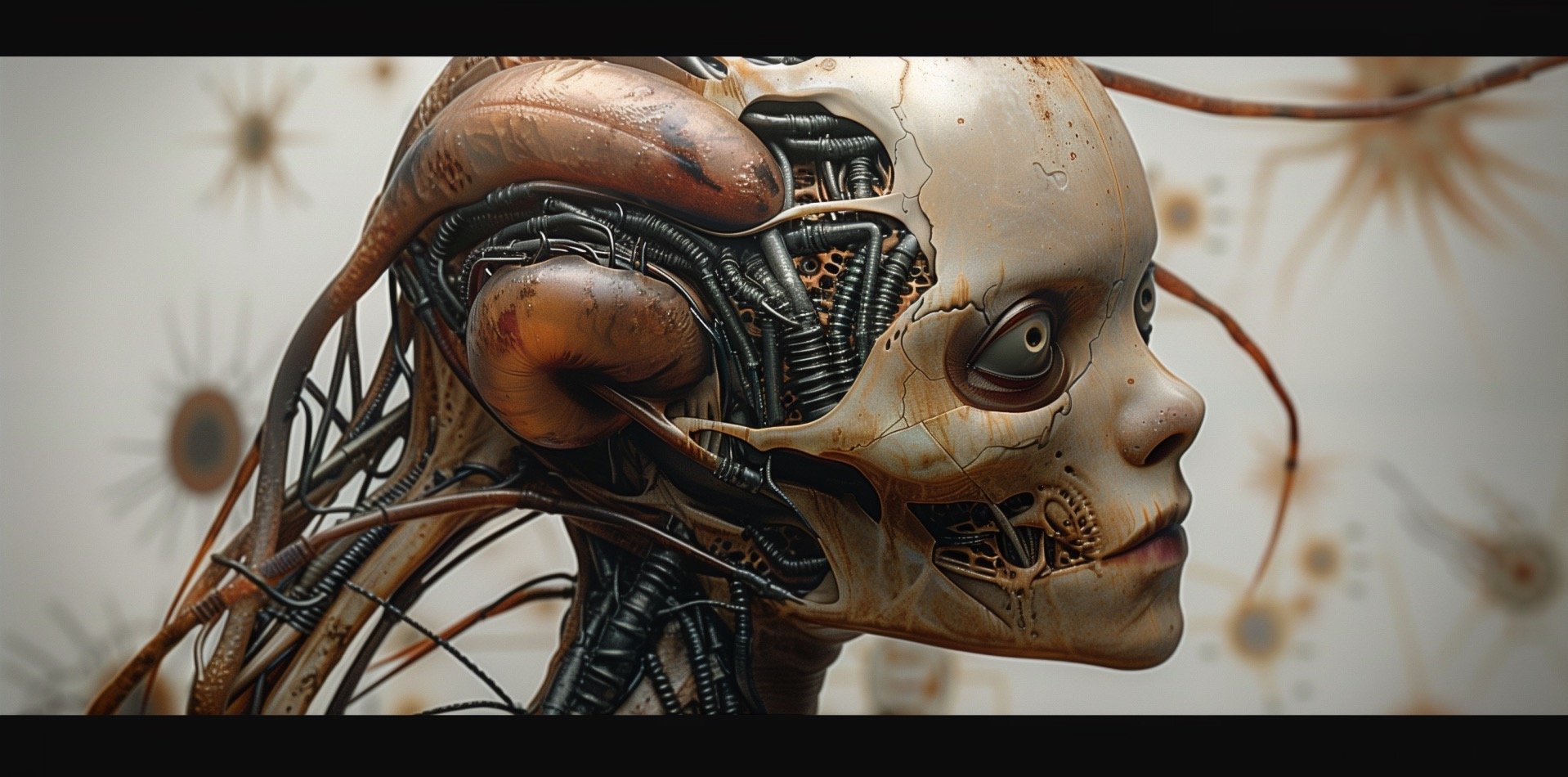
Project ∄: Specimen Analysis Log - Sequence #050
Specimen Designation: Entity Ξ-050
Observational Report:
Entity Ξ-050 represents a zenith in Project ∄'s exploration of the boundaries between organic life and mechanical augmentation. This entity’s profile displays a haunting asymmetry between its remaining human features and the extensive biomechanical infrastructure that has been assimilated into its form.
Detailed Technological Examination:
The left side of Entity Ξ-050's face maintains a semblance of its original human appearance, while the right side and cranium have been subsumed by a complex array of synthetic materials and mechanical components. The visible eye on the human side provides a stark contrast to the intricate cybernetic structures that envelop the rest of the head, suggesting a dual functionality in sensory perception—part human, part machine.
Functional Analysis and Potential Impact:
The sophisticated amalgamation of technologies within Entity Ξ-050 hints at a multi-faceted role. Its capabilities likely extend to advanced cognitive processing, environmental adaptation, and possibly even autonomous decision-making.
Escalating Ethical Dilemma:
The striking dichotomy of Entity Ξ-050 raises profound ethical issues about identity preservation and the limits of technological integration with the human body. At what point does enhancement erode the essence of the individual?
Philosophical Quandaries and Global Repercussions:
Entity Ξ-050 forces a contemplation of what it means to be human in an age where technology can not only mimic but potentially exceed natural biological functions. It challenges traditional notions of consciousness and the sanctity of human life.
Scientist's Perspective:
Confronted with Entity Ξ-050, I am awash with both a sense of accomplishment and a wave of apprehension. We have reached an apex in which our technological capabilities allow us to re-engineer the very fabric of biological existence, yet the path forward is fraught with complex moral dilemmas.
Conclusion:
As the 50th sequence of Project ∄, Entity Ξ-050 embodies the culmination of our project's ambitions and perhaps its ultimate cautionary tale. It is a monument to human ingenuity and a stark reminder of the profound responsibilities that accompany our creative prowess. We must proceed with both the courage to explore new frontiers and the wisdom to respect the inherent value of our humanity.
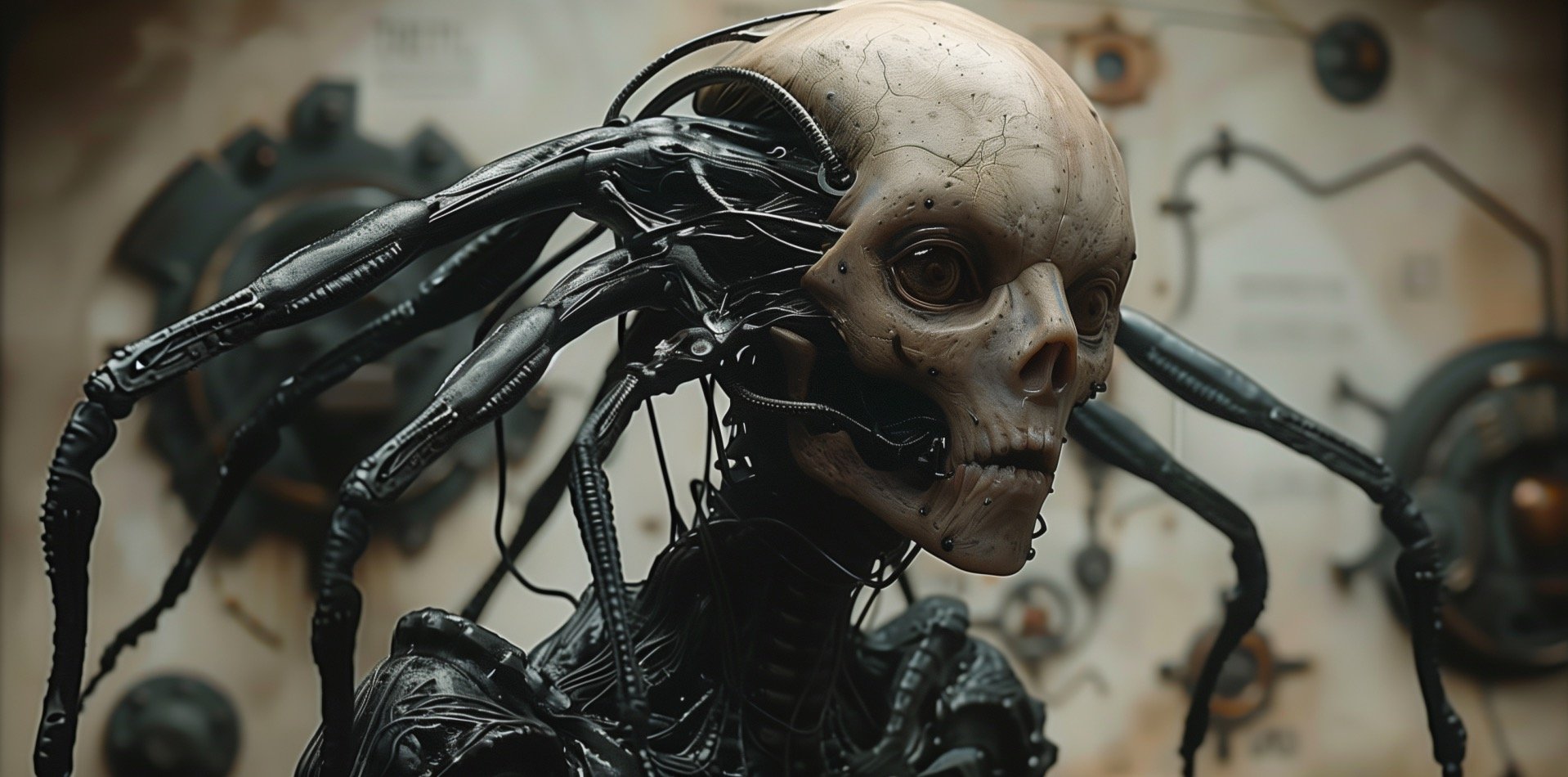
Project ∄: Specimen Analysis Log - Sequence #053
Specimen Designation: Entity Ξ-053
Observational Report:
Entity Ξ-053 exhibits a haunting culmination of Project ∄'s series, with the human skull serving as the core upon which an intricate expanse of mechanical augmentation has been grafted. This specimen stands as a stark symbol of the potential endpoint of humanity's pursuit of technological integration.
Detailed Technological Examination:
The skull's surface is laced with biomechanical components, suggesting enhancements that likely surpass the original human brain's cognitive abilities. The extensive wiry tendrils and supports emerging from the entity suggest a complex neural network, interfacing directly with mechanical appendages and possibly external devices.
Functional Analysis and Potential Impact:
Entity Ξ-053 appears to be the integration of human anatomical structure with an advanced mechanical counterpart, potentially resulting in amplified processing power and multifaceted sensory input. This level of enhancement may enable the entity to perform complex tasks that combine the depth of human thought with the efficiency and precision of machines.
Escalating Ethical Dilemma:
The transformation evident in Entity Ξ-053 raises disconcerting ethical questions regarding the preservation of humanity amidst such extensive modification. What remains of the individual once the biological is subsumed by the technological?
Philosophical Quandaries and Global Repercussions:
The existence of Entity Ξ-053 compels us to reflect on the essence of identity and the potential for consciousness within such a framework. It forces a re-examination of the nature of existence and the future relationship between humans and the beings we create.
Scientist's Perspective:
Confronting Entity Ξ-053, I am compelled to consider the implications of our relentless pursuit of enhancement and the potential for losing the very essence that defines us. The sight of such a specimen instills a paradoxical mix of wonder and unease, highlighting the dichotomy between our desire for progress and the preservation of our innate human qualities.
Conclusion:
As the Project ∄ approaches its zenith with Entity Ξ-053, it brings into focus the delicate balance between our drive for advancement and the need to maintain our humanity. This entity encapsulates the profound technical achievements of our time, yet it also serves as a cautionary emblem of the potential consequences of our technological zeal. It is a powerful reminder that as we forge ahead into new frontiers of innovation, we must tread with caution and deliberate on the ethical and philosophical implications of our creations.
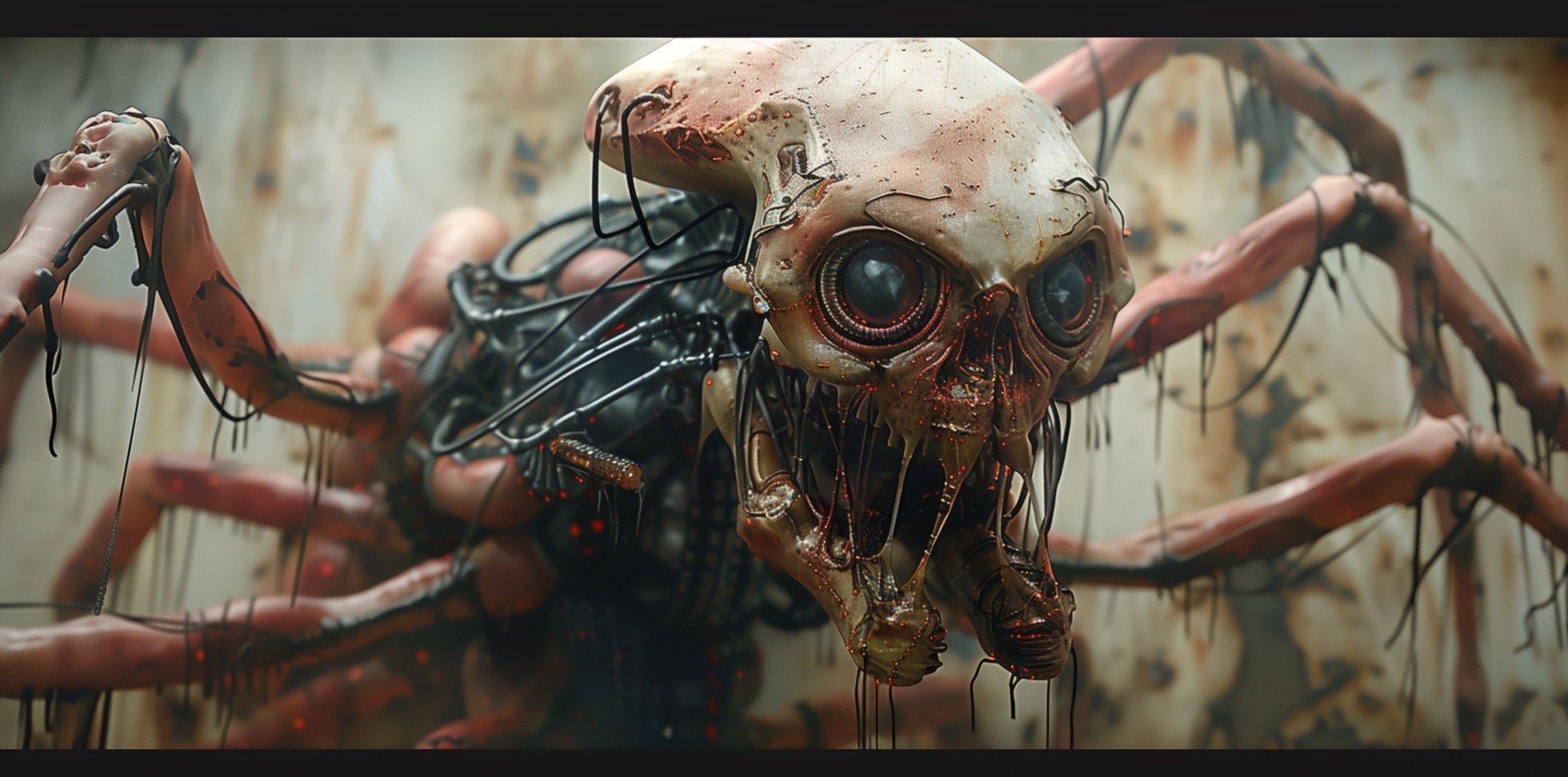
Project ∄: Specimen Analysis Log - Sequence #056
Specimen Designation: Entity Ξ-056
Observational Report:
Entity Ξ-056 marks a transgressive and possibly terminal development within Project ∄. Its appearance is harrowing—a fusion of the organic and the synthetic taken to an extreme, evoking a visceral reaction and challenging the viewer's perception of life and machine.
Detailed Technological Examination:
The entity's skull, stripped of all flesh, supports an array of mechanical components that are fused directly into the bone. The over-sized ocular implants give it a disconcerting presence, likely providing the entity with vision capabilities beyond the visible spectrum. The myriad cables and appendages suggest a fully integrated system, where the organic has been overtaken and rendered secondary to the entity's mechanical aspects.
Functional Analysis and Potential Impact:
The design of Entity Ξ-056 implies a role that is no longer supportive or supplementary to human functions but instead operates as a completely autonomous unit, possibly for tasks that humans cannot or will not perform due to ethical constraints or danger.
Escalating Ethical Dilemma:
Entity Ξ-056 embodies the apex of ethical controversy within Project ∄. Its very existence raises urgent questions regarding the morality of such profound integration of technology with human remains, the respect for what once was human, and the potential consequences of creating entities that could outlast their creators.
Philosophical Quandaries and Global Repercussions:
The unsettling visage of Entity Ξ-056 challenges the philosophical boundaries of identity, existence, and the definition of life itself. As a being that may have once been human, it now represents a new form of existence that defies traditional understanding and moral frameworks.
Scientist's Perspective:
In Entity Ξ-056, I confront the unsettling culmination of our technological ambitions. This entity represents both the pinnacle of innovation and a potential departure from the principles that have guided our quest for knowledge.
Conclusion:
Entity Ξ-056 serves as a stark embodiment of Project ∄'s most profound and controversial achievements. It stands as a symbol of our relentless pursuit of progress, regardless of the ethical quandaries we have traversed. The existence of such an entity is a testament to human creativity and a potent reminder of the need for careful reflection on the implications of our work. As we forge ahead, we must consider the legacy we leave—a future where the line between the created and the creator is irrevocably blurred.
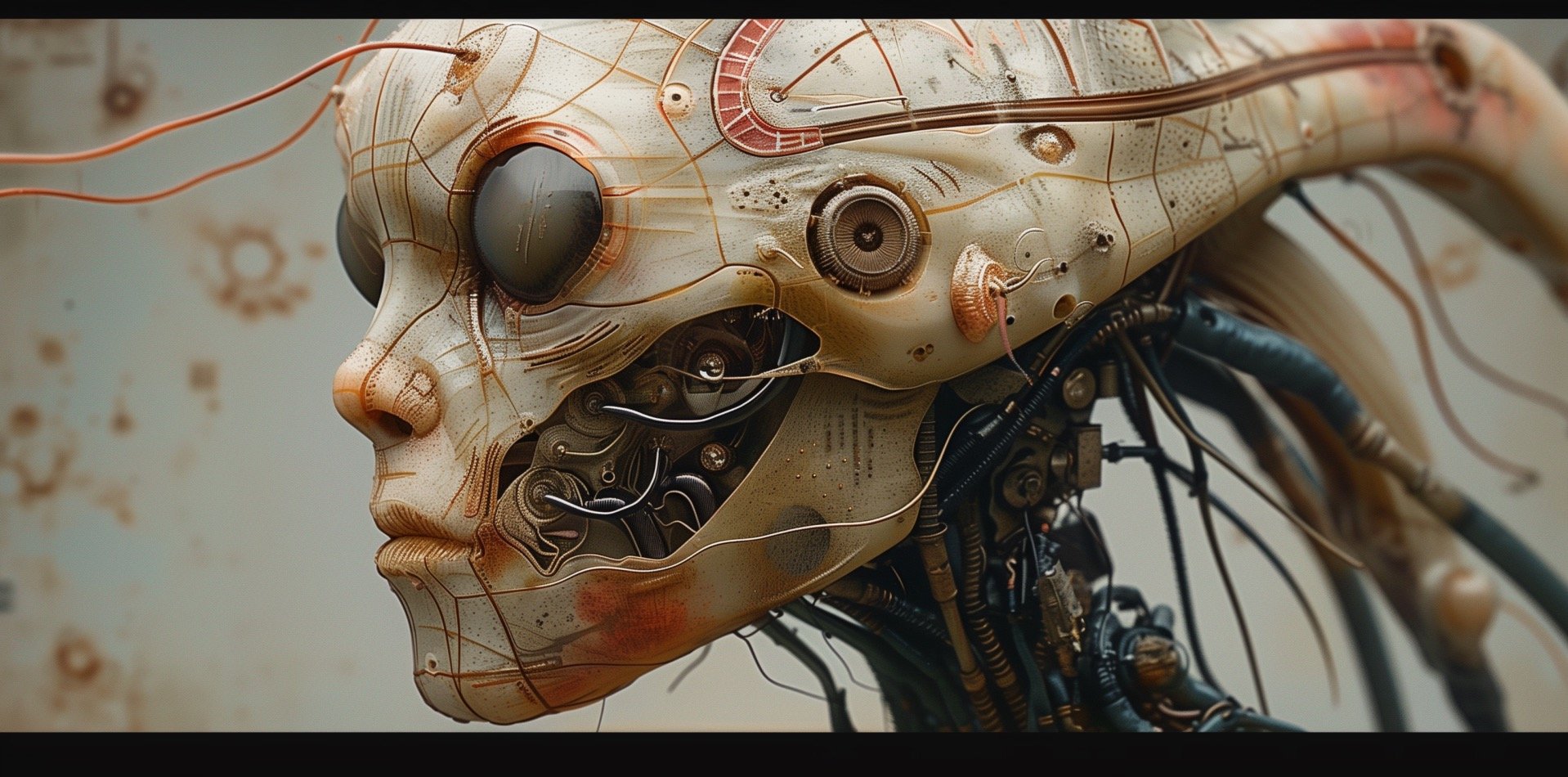
Project ∄: Specimen Analysis Log - Sequence #059
Specimen Designation: Entity Ξ-059
Observational Report:
Entity Ξ-059 presents a further evolution in Project ∄, displaying an even more sophisticated integration of organic and artificial elements. The humanoid facial features remain pronounced, yet they are seamlessly intertwined with mechanical components, creating an eerie hybrid visage.
Detailed Technological Examination:
The entity's right eye has been replaced or augmented by a complex ocular device, likely capable of multiple forms of vision and data recording. Intricate mechanical parts are visible beneath the surface of what appears to be artificially created skin, suggesting the presence of advanced sensory equipment and possibly cognitive enhancers.
Functional Analysis and Potential Impact:
Entity Ξ-059 appears to be a highly advanced unit possibly designed for delicate operations that require a blend of human intuition and mechanical precision. This could include surgical procedures, intricate manufacturing, or tasks requiring an interface between humans and purely mechanical systems.
Escalating Ethical Dilemma:
The hybrid nature of Entity Ξ-059 raises critical ethical questions about the extent to which technology should be allowed to permeate the body and the potential impacts on individual identity and autonomy.
Philosophical Quandaries and Global Repercussions:
The being stands as a potent symbol of the blurred line between the natural and the constructed, challenging our notions of what it means to be alive. It represents a future where the synthesis of man and machine can create entities that may share in human experiences but are fundamentally different in their essence.
Scientist's Perspective:
Confronting Entity Ξ-059 instills a mix of wonder and concern. The achievement it represents is marred by an awareness of the uncharted ethical territory we are navigating. Each advancement brings us closer to a world where our creations may not only replicate but also exceed our capacities, raising profound questions about their role and rights within our society.
Conclusion:
As Entity Ξ-059 marks the continued progression of Project ∄, it exemplifies the culmination of our relentless pursuit of innovation. Yet, with each new entity, we must pause to consider the long-term implications of our endeavor. Entity Ξ-059 is not merely a triumph of technology; it is a call to deeply contemplate our path forward and the legacy we will leave for humanity.

Project ∄: Specimen Analysis Log - Sequence #062
Specimen Designation: Entity Ξ-062
Observational Report:
Entity Ξ-062 manifests as a profound advancement in Project ∄, showcasing a fusion of form and function that borders on the nightmarish. This specimen is characterized by an extensive biomechanical exoskeleton, supporting a skull that seems to be in mid-transition between human and machine.
Detailed Technological Examination:
The skull is partially exposed, displaying significant cybernetic integration. Mechanical appendages and conduits emerge from within the cranium, suggesting a complete replacement of natural neural functions with advanced synthetic alternatives. The entity's spine and limbs have been replaced with a complex, articulated framework, indicating superior strength and agility.
Functional Analysis and Potential Impact:
Entity Ξ-062 is possibly a combat-oriented unit or one designed for extreme environments where traditional forms and materials would fail. The entity's configuration suggests it could function in high-risk areas, performing tasks ranging from search-and-rescue to tactical warfare.
Escalating Ethical Dilemma:
The extent of mechanical augmentation in Entity Ξ-062 brings into question the ethics of using human remains as a base for such profound transformations. The erasure of human features poses moral questions about identity and the preservation of the self.
Philosophical Quandaries and Global Repercussions:
Entity Ξ-062 stands as a grim harbinger of a potential future where the distinction between life and machine is indistinguishable. It raises existential questions about the value we place on the organic and the lengths to which we are willing to go in pursuit of progress.
Scientist's Perspective:
Entity Ξ-062 reflects the zenith of Project ∄'s technical capabilities, and yet it evokes a deep sense of disquiet. The entity exemplifies the pinnacle of our aspirations intertwined with the fears of what our creations may become.
Conclusion:
As a representation of Project ∄'s ongoing evolution, Entity Ξ-062 is a beacon of both warning and wonder. It epitomizes the project's core mission to push the boundaries of science, yet it also embodies the ethical and philosophical conundrums that such pursuits inevitably entail. The emergence of Entity Ξ-062 marks a crucial point in our journey, necessitating a reevaluation of our goals and the potential consequences of our quest for advancement.
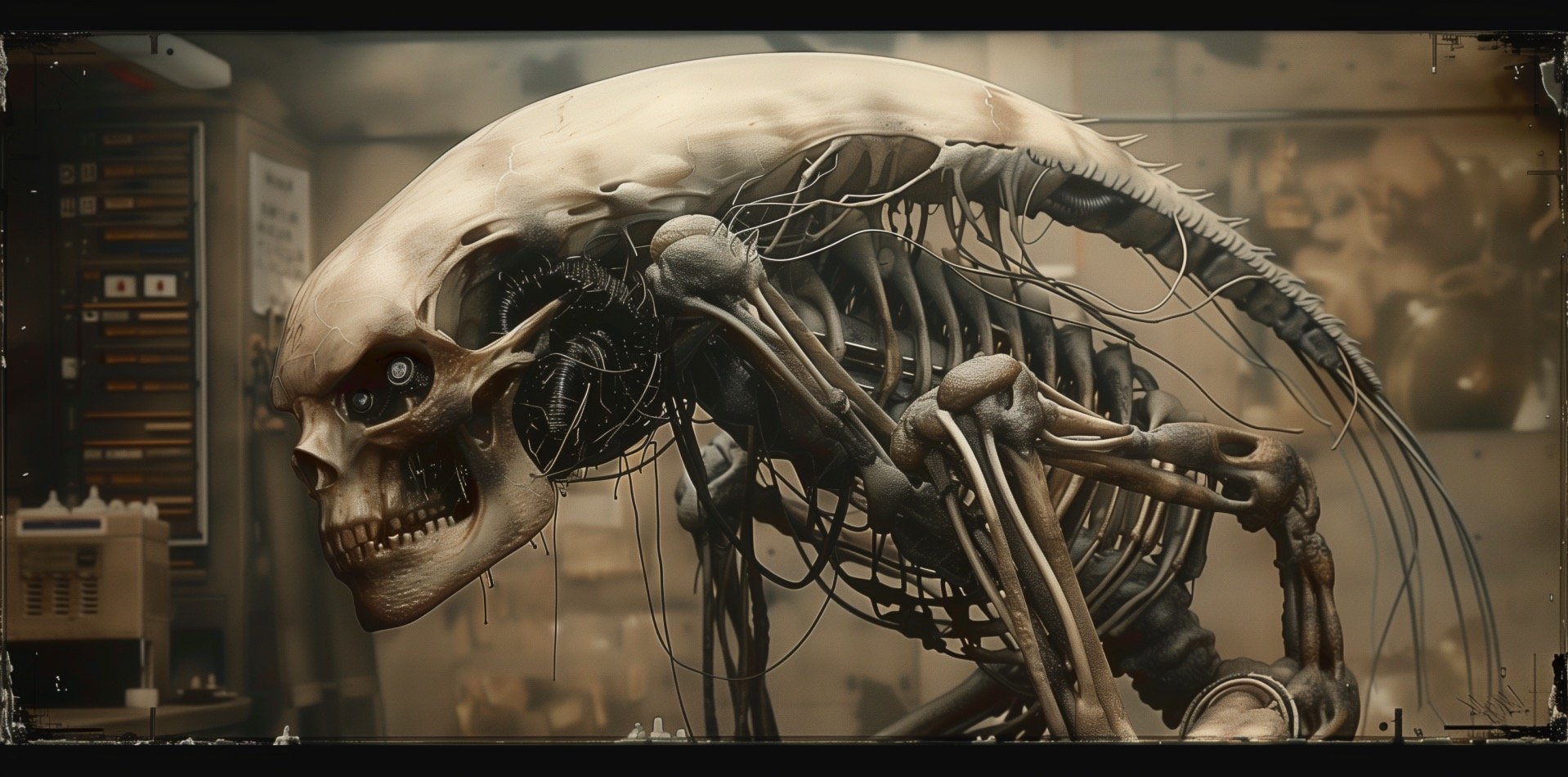
Project ∄: Specimen Analysis Log - Sequence #065
Specimen Designation: Entity Ξ-065
Observational Report:
Entity Ξ-065 emerges as an enigmatic figure within the confines of Project ∄, pushing the boundaries of what constitutes a sentient being. The design represents a radical departure from human anatomy, adopting a skeletal form with pronounced cybernetic augmentation.
Detailed Technological Examination:
The skull of Entity Ξ-065 has been integrated with advanced mechanical components, creating a haunting visage. The eye sockets house sophisticated sensors, while the cranium is enveloped by a network of wires and support structures, suggesting enhancements to neural processing and data interfacing.
Functional Analysis and Potential Impact:
Entity Ξ-065 is likely designed for roles that no longer align with traditional human capabilities. Its structural form and advanced sensorium point to applications in extreme conditions or environments that would be hostile to organic life.
Escalating Ethical Dilemma:
The creation of Entity Ξ-065 invites a host of ethical concerns, primarily the extent to which human remains are utilized as a template for such profound transformations. The respect for the deceased and the sanctity of human remains are core issues challenged by this entity's existence.
Philosophical Quandaries and Global Repercussions:
Entity Ξ-065 forces a confrontation with the concept of death and the potential for life after biological cessation. It raises questions about identity and continuation of self, should consciousness be transferred or emulated within such frameworks.
Scientist's Perspective:
The development of Entity Ξ-065 represents an extraordinary scientific achievement, yet it also underscores a potential crisis of conscience. The blurring of life and unlife embodied in this entity signals a need for introspection and dialogue about the path that lies ahead.
Conclusion:
As a testament to the profound capabilities of Project ∄, Entity Ξ-065 exemplifies the dual nature of technological advancement—both its power to create and its potential to unsettle. The entity stands as a symbol of progress, yet also a poignant reminder of the philosophical and ethical considerations that must be reconciled as we continue to explore the vast expanse of possibility.
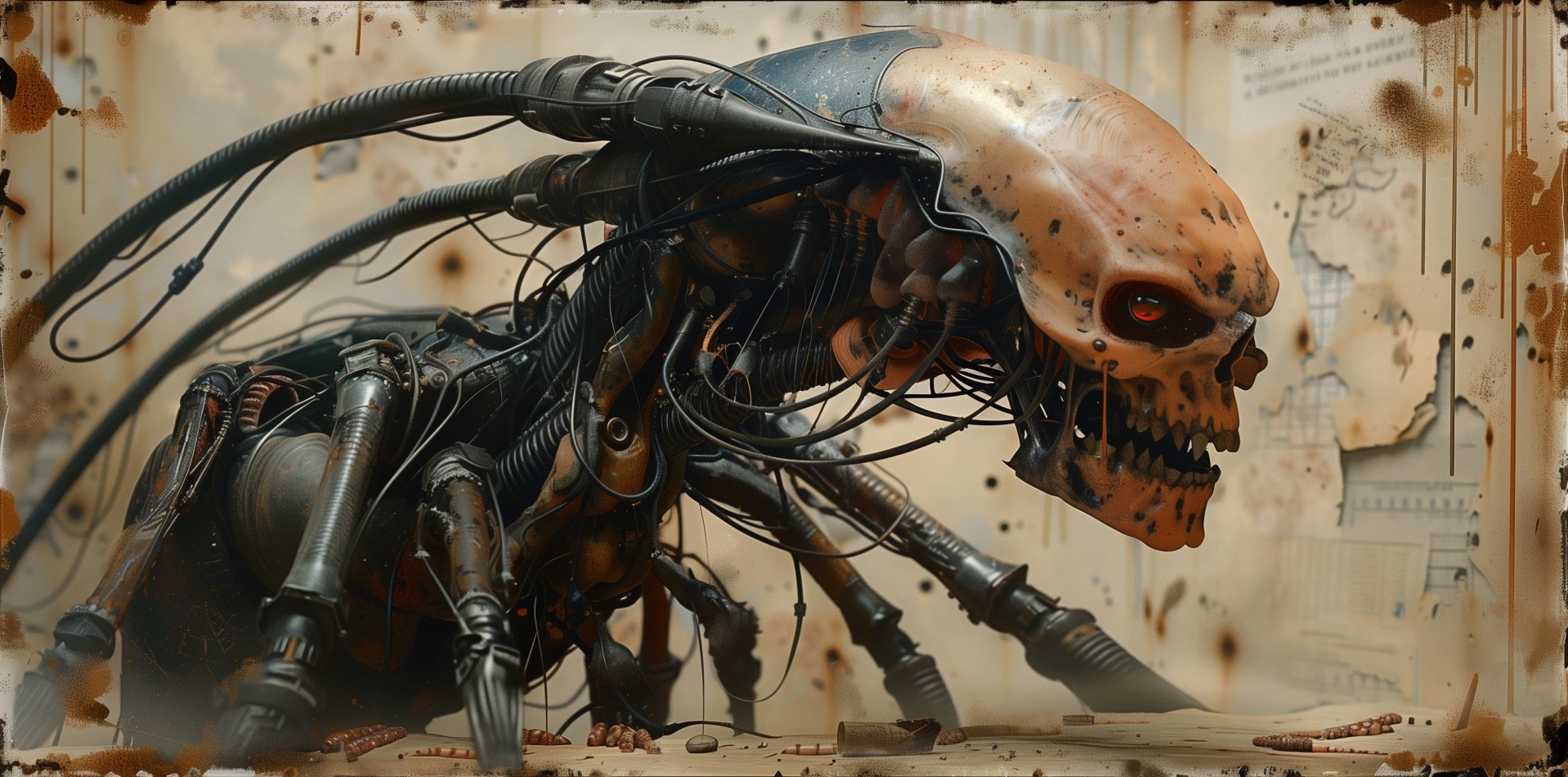
Project ∄: Specimen Analysis Log - Sequence #068
Specimen Designation: Entity Ξ-068
Observational Report:
Entity Ξ-068 emerges as an apex predator within the mechanical hierarchy of Project ∄. The skull, hauntingly human in its base form, is intricately interwoven with an expanse of mechanical appendages and support systems that suggest a being of immense physical and processing capabilities.
Detailed Technological Examination:
The integration of the skull with machinery is seamless, with biotechnological enhancements that have entirely replaced the upper cervical vertebrae and cranial cavity. The glowing ocular feature indicates a level of visual acuity far beyond human norms, and the assortment of wires and metallic components likely house an advanced neural network.
Functional Analysis and Potential Impact:
Designed perhaps for military or defensive applications, Entity Ξ-068 appears equipped for hostile environments and confrontations where typical human or mechanical soldiers would be ineffective. Its formidable structure suggests the potential for high-endurance, high-impact tasks.
Escalating Ethical Dilemma:
The creation of Entity Ξ-068, a being potentially capable of aggression and combat, forces us to confront the ethical implications of imbuing machines with the means to harm. The moral considerations of programming sentient machines for violence must be thoroughly examined.
Philosophical Quandaries and Global Repercussions:
Entity Ξ-068 presents a philosophical conundrum: it blurs the lines between the protector and the aggressor, raising questions about the use of technology in warfare and peacekeeping. The potential global repercussions of such entities' existence and deployment are profound, with the possibility of reshaping geopolitical landscapes.
Scientist's Perspective:
The manifestation of Entity Ξ-068 stands as a sobering milestone in Project ∄, eliciting both awe at our ingenuity and dread at the implications of such power. This entity compels us to reconsider our direction and the potential outcomes of our research and development.
Conclusion:
As we chronicle Entity Ξ-068, it is clear that Project ∄ has ventured into realms once considered the realm of science fiction. This entity symbolizes a pinnacle of what can be achieved when the barriers of ethics and technology are pushed to their limits. We stand at a precipice, looking upon a creation that could either revolutionize our world or lead to our own obsolescence. The future of Project ∄ and the trajectory of our species will be defined by how we manage the responsibilities inherent in such power.
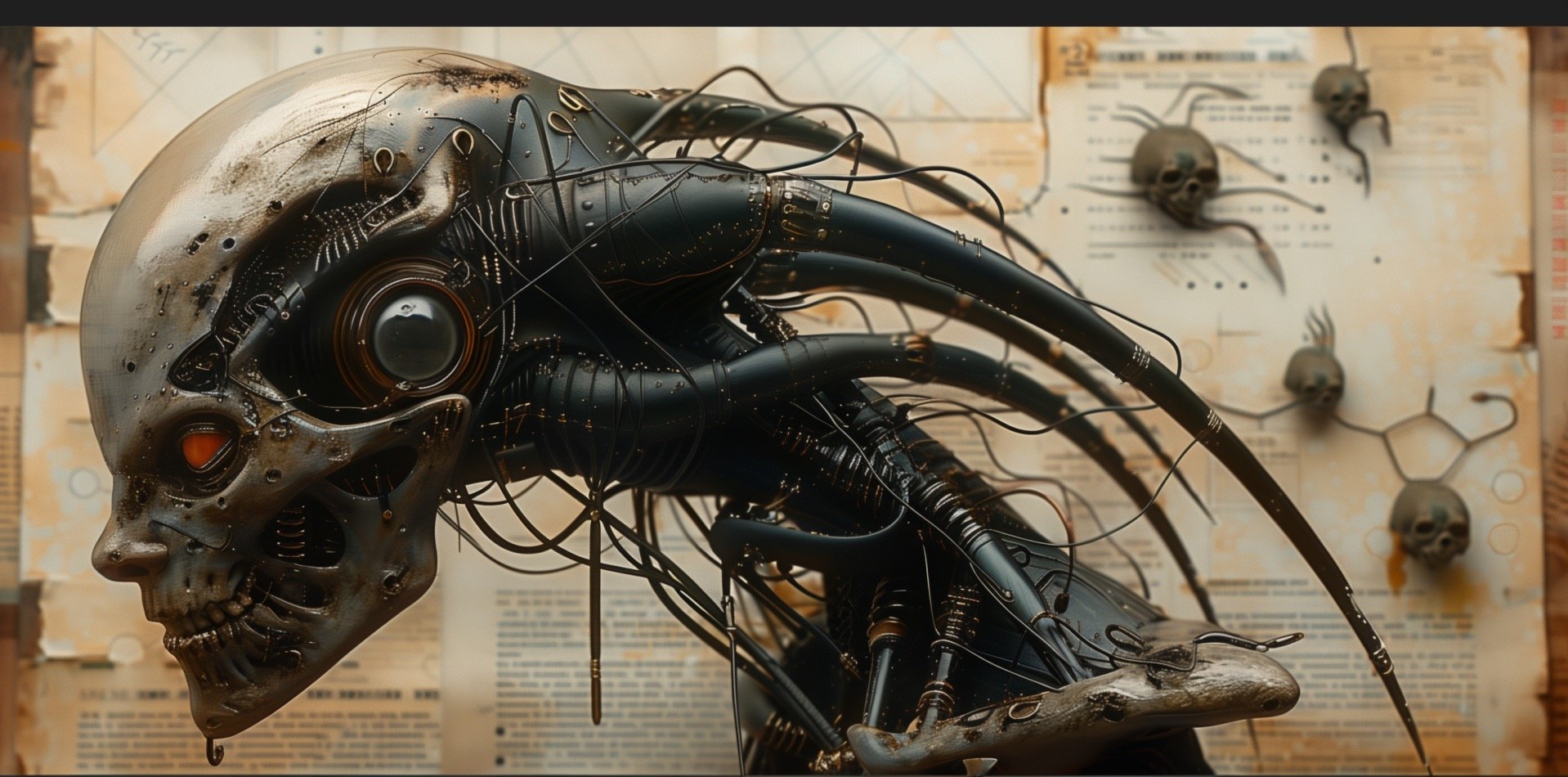
Project ∄: Specimen Analysis Log - Sequence #071
Specimen Designation: Entity Ξ-071
Observational Report:
Entity Ξ-071 emerges as an almost unrecognizable derivation from the human form, a figure at the zenith of Project ∄'s explorations. This entity is a synthesis of biomechanical engineering and cybernetic enhancement, where the organic has been almost entirely subsumed by the artificial.
Detailed Technological Examination:
The skull of Ξ-071, half-concealed by a metallic carapace, reveals an extensive cybernetic overhaul. Its left eye is a complex sensor, the remaining facial structures are laced with support frameworks, and intricate wiring takes precedence over what might once have been organic matter.
Functional Analysis and Potential Impact:
Entity Ξ-071's configuration suggests a role that goes beyond human capabilities, serving functions that could range from autonomous exploration in inhospitable environments to intricate computational tasks. Its form, designed for efficiency and durability, may possess self-repairing capabilities and advanced adaptive learning functions.
Escalating Ethical Dilemma:
The extent to which Entity Ξ-071 has diverged from its human origins places it at the heart of a moral maze concerning the principles of life, consciousness, and the rights of synthetic beings.
Philosophical Quandaries and Global Repercussions:
The existence of Entity Ξ-071 raises pressing philosophical questions about the essence of the self and the value we ascribe to human-like qualities in a being that arguably possesses little that is recognizably human.
Scientist's Perspective:
The creation of Entity Ξ-071 represents a boundary-pushing moment in Project ∄, filling me with both trepidation and astonishment. The sight of such an entity forces me to grapple with the profound implications of our work and its potential to redefine the nature of existence.
Conclusion:
As Project ∄ progresses with entities like Ξ-071, we witness the astounding potential of our technological advancements. Yet, with each breakthrough comes the weighty responsibility to consider the ethical, philosophical, and societal impacts of our innovations. Entity Ξ-071 is not just a symbol of scientific progress; it is a herald of the complexities that lie ahead as we navigate the future we are crafting.
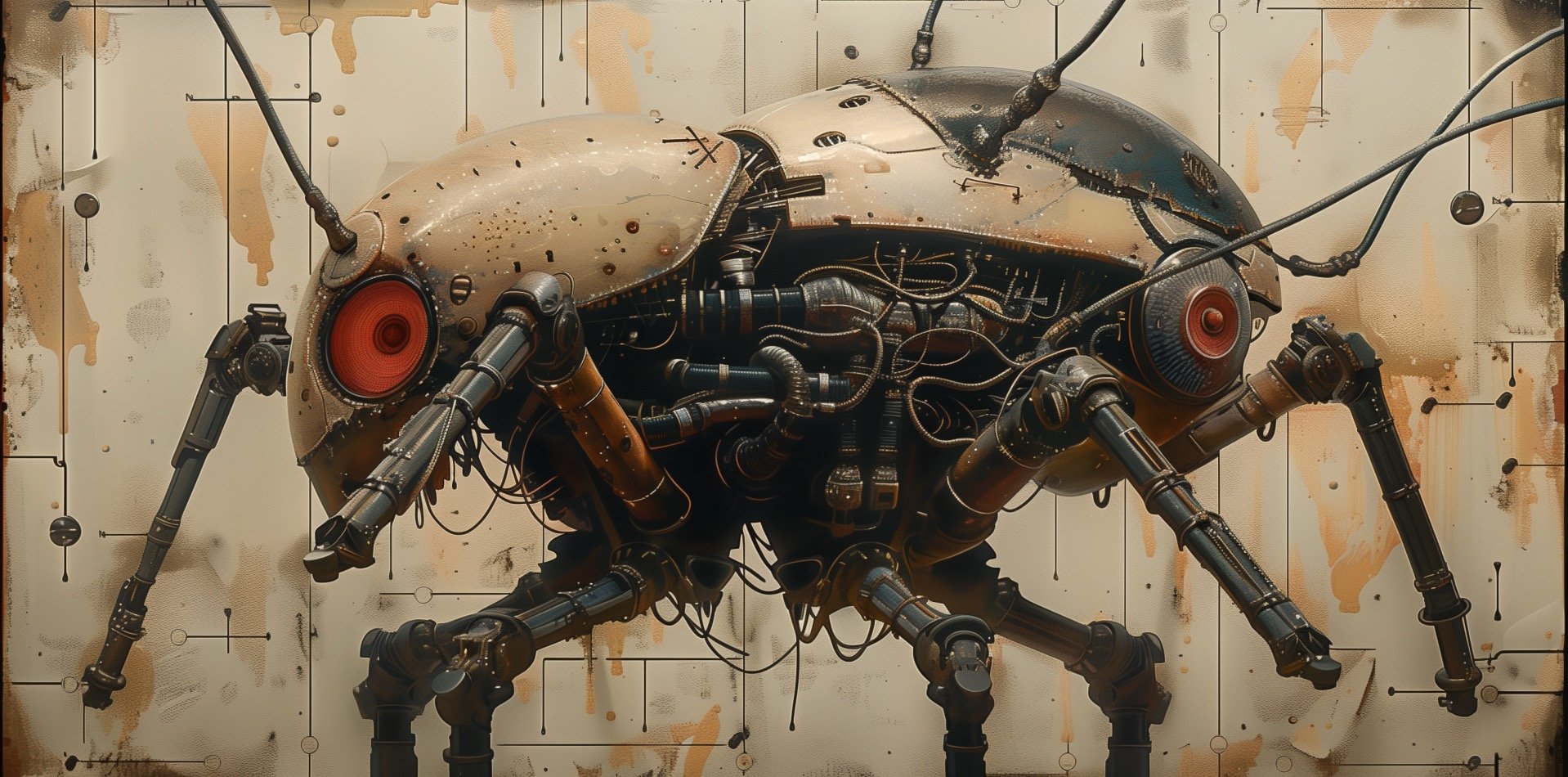
Project ∄: Specimen Analysis Log - Sequence #074
Specimen Designation: Entity Ξ-074
Observational Report:
Entity Ξ-074 stands as a stark divergence within Project ∄, representing a radical shift towards a non-humanoid form. This entity combines mechanical elements into an insect-like configuration, suggesting a paradigm shift in the project's direction.
Detailed Technological Examination:
The core of Entity Ξ-074 is an advanced mechanical chassis, supporting a central processing unit where a human skull is embedded. The cranial section is equipped with sensory appendages resembling antennae, and multiple optical sensors are mounted on a dome-like structure, indicative of 360-degree awareness.
Functional Analysis and Potential Impact:
Entity Ξ-074 is likely conceived for surveillance and reconnaissance missions, capable of traversing varied terrains and environments with agility and stealth. The design suggests autonomous operation, with advanced pattern recognition and environmental analysis capabilities.
Escalating Ethical Dilemma:
The shift towards a form that eschews humanoid features raises questions about the project's end goals and the ethical considerations of creating life forms solely for utilitarian purposes, devoid of human experience or empathy.
Philosophical Quandaries and Global Repercussions:
The creation of Entity Ξ-074 challenges conventional wisdom about the sanctity of the human form and the boundaries of life. It necessitates a discourse on the rights and treatment of sentient machines that diverge significantly from human or animal analogs.
Scientist's Perspective:
The inception of Entity Ξ-074 fills me with a profound sense of both apprehension and curiosity. While its capabilities are impressive, they are overshadowed by the responsibility we bear for these creations and their potential impact on the world.
Conclusion:
As Entity Ξ-074 integrates into the continuum of Project ∄, it serves as a reminder of our relentless quest to push beyond existing limitations. This entity is not just a technological marvel; it is a catalyst for a broader discussion on the future we are shaping—a future where our technological aspirations must be balanced with a redefined ethical framework.
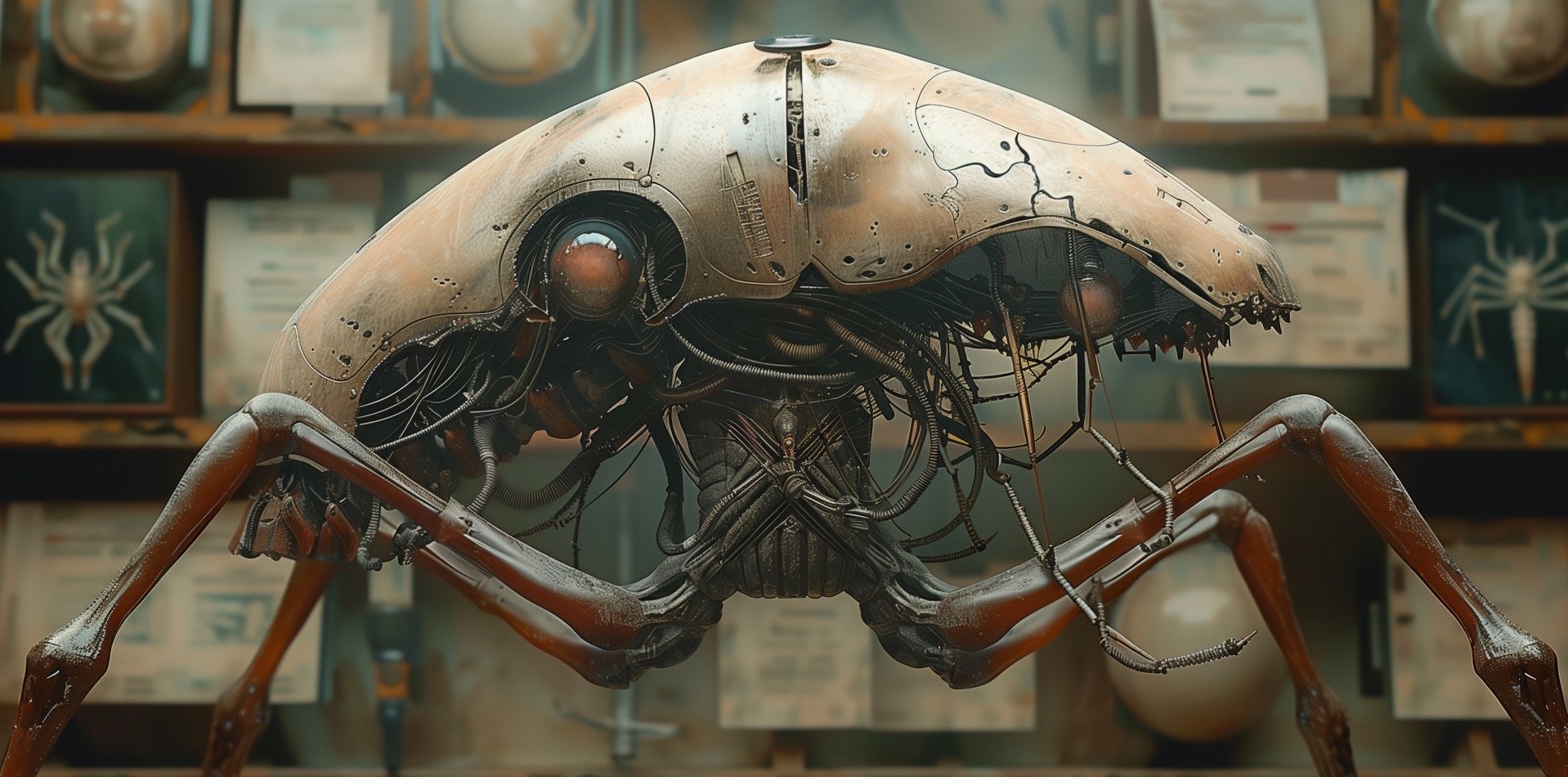
Project ∄: Specimen Analysis Log - Sequence #077
Specimen Designation: Entity Ξ-077
Observational Report:
Entity Ξ-077 signifies an evolutionary leap within Project ∄, presenting an entity that bears a stark departure from prior anthropocentric designs. Resembling an arachnid in structure, this specimen showcases an entirely new form of biomechanical symbiosis.
Detailed Technological Examination:
The entity's central body is a dome-shaped cranial structure, housing an array of sensors and computational devices within a protective carapace. Its limbs are hydraulic and multi-jointed, suggesting a capacity for precise, multi-directional movement.
Functional Analysis and Potential Impact:
Entity Ξ-077 is likely engineered for tasks that require stability and dexterity across a variety of terrains. Its form suggests roles in hazardous environment exploration, complex construction, or repair where human presence is impractical or dangerous.
Escalating Ethical Dilemma:
The arachnid-like form of Entity Ξ-077 challenges our preconceived notions of the role and design of synthetic organisms. It propels ethical debates regarding the creation of entities that possess no human characteristics yet may exhibit signs of sentience.
Philosophical Quandaries and Global Repercussions:
The existence of Entity Ξ-077 compels a reassessment of the definition of 'life'. It stretches the limits of what is considered 'natural' and necessitates a reevaluation of the relationship between creator and creation.
Scientist's Perspective:
The realization of Entity Ξ-077 is a moment of profound significance, marking both a high point in technological achievement and a crossroads in ethical considerations. The entity's arachnid form elicits a reconsideration of the path Project ∄ has taken and its implications for the future.
Conclusion:
Entity Ξ-077 stands as a testament to the boundless possibilities of Project ∄. It encapsulates the innovative spirit of the initiative while simultaneously highlighting the urgent need for a comprehensive framework to address the ethical, philosophical, and societal challenges posed by such advancements. As Project ∄ evolves, so too must our understanding of the responsibilities we hold towards these new forms of existence.
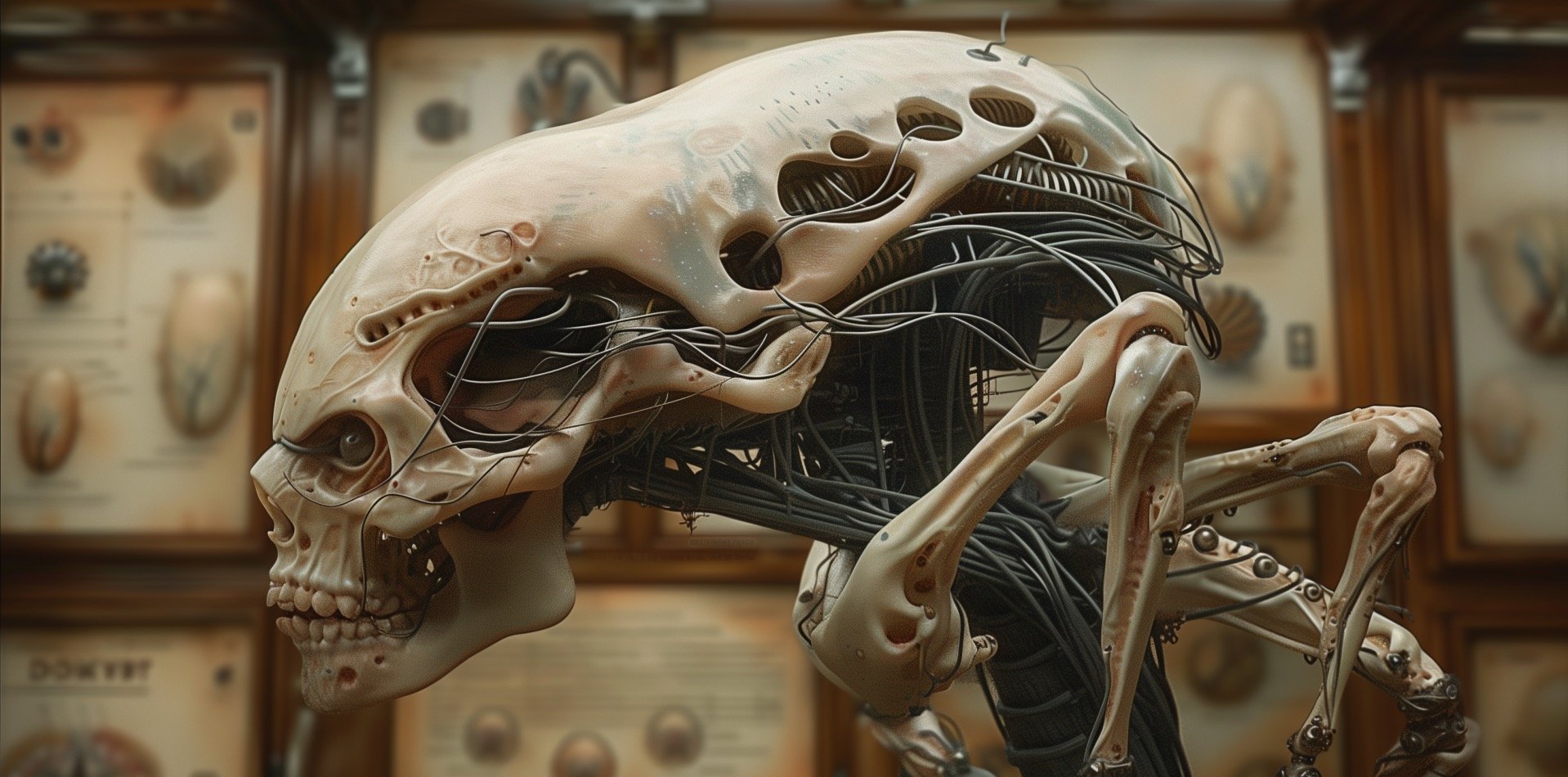
Project ∄: Specimen Analysis Log - Sequence #080
Specimen Designation: Entity Ξ-080
Observational Report:
Entity Ξ-080 is a profound iteration within Project ∄, showcasing an advanced biomechanical construct that closely mirrors a skeletal structure. The design intricately combines the organic and the synthetic, suggesting a harmonious yet unsettling union of form and function.
Detailed Technological Examination:
The specimen's skull retains a semblance of human features, but it is encased and intertwined with a complex lattice of wires and mechanical parts. These components likely serve to augment cognitive functions and sensory processing far beyond human limits.
Functional Analysis and Potential Impact:
The entity appears designed for multi-faceted roles, potentially serving as a mobile computing unit, a high-functioning autonomous agent, or a biomechanical interface for complex systems. The skeletal framework suggests agility and adaptability, with potential applications in both civilian and military sectors.
Escalating Ethical Dilemma:
Entity Ξ-080 embodies a convergence point of life and technology, compelling a reexamination of the ethics surrounding artificial intelligence and the use of human-like forms for potentially sentient machines.
Philosophical Quandaries and Global Repercussions:
This entity's existence raises critical philosophical debates about the essence of consciousness and the sanctity of human morphology. It blurs the boundaries between the living and the synthetic, prompting a reassessment of the rights and ethical treatment of such beings.
Scientist's Perspective:
Entity Ξ-080 marks a zenith in Project ∄'s chronicle, inspiring a complex blend of admiration and existential concern. This creation is a testament to the project's ambitions and serves as a focal point for discussion on the direction of future developments.
Conclusion:
As Entity Ξ-080 joins the ranks of Project ∄, it not only showcases the pinnacle of technological synthesis but also highlights the intricate web of responsibilities we hold. It is a beacon that illuminates the potential of what we can create, while casting a shadow of the ethical complexities that accompany such power. As we advance, it is imperative that we navigate this new terrain with a profound sense of duty and deliberate consideration of the implications that our creations hold for the future.
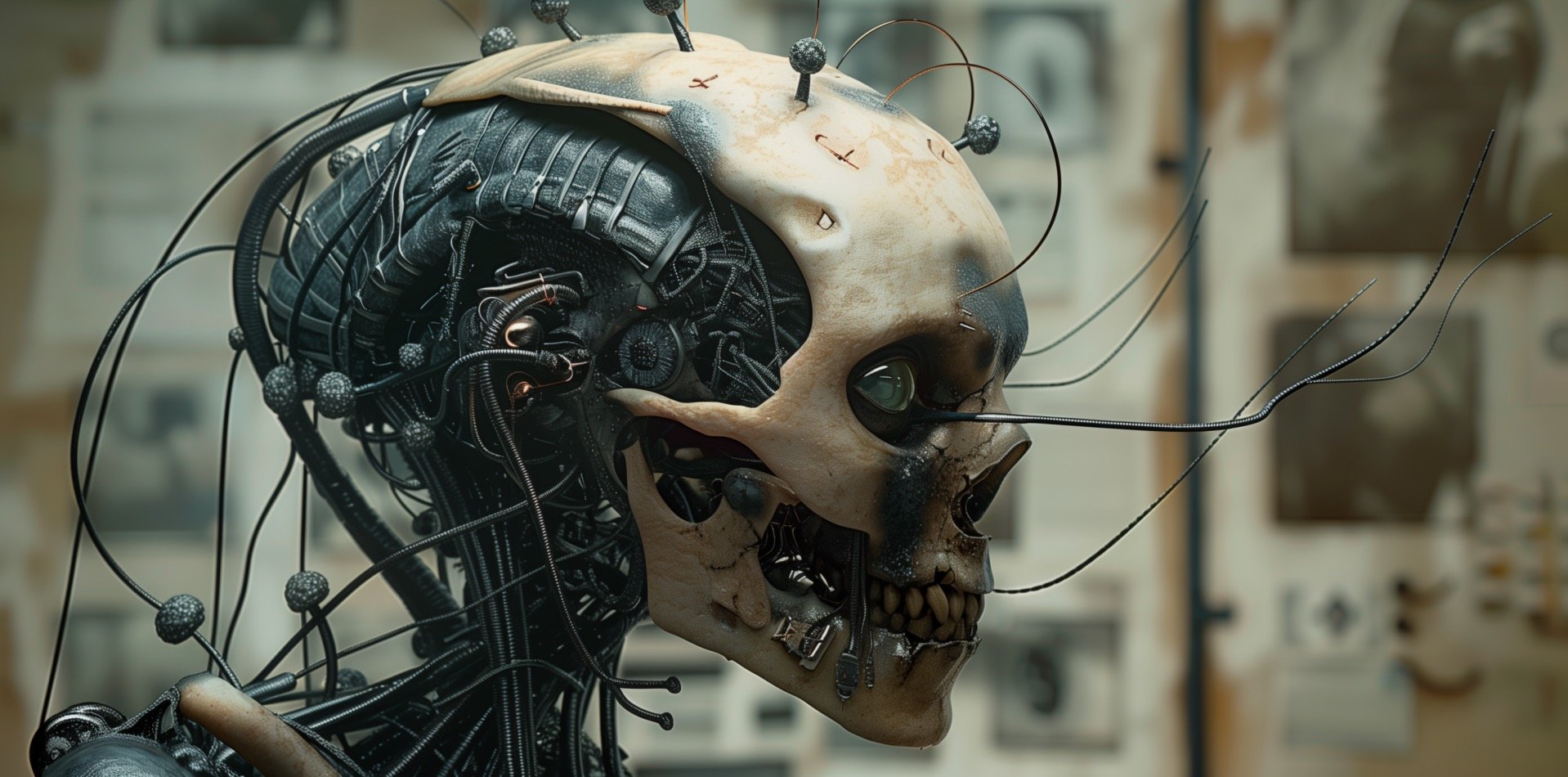
Project ∄: Specimen Analysis Log - Sequence #083
Specimen Designation: Entity Ξ-083
Observational Report:
Within the continuum of Project ∄, Entity Ξ-083 is a biomechanical construct that appears to integrate the human skull with an extensive cybernetic framework, suggesting an evolution towards a more cerebral and sensory-focused entity.
Detailed Technological Examination:
The skull is adorned with a variety of sensors and stimulators, protruding like the antennae of an insect, likely intended to enhance environmental perception and data acquisition. The mechanical portions enveloping the skull suggest an exoskeleton designed to protect and support an advanced neural network.
Functional Analysis and Potential Impact:
Entity Ξ-083's unique array of sensory equipment indicates a specialization in signal processing and intelligence gathering. This entity could serve as a hub for field operations, synthesizing data from various inputs for tactical or analytical purposes.
Escalating Ethical Dilemma:
This entity challenges the traditional concepts of identity and personhood. The use of the human skull raises questions about the origin of these materials and the consent involved in such integration, echoing a need for clear ethical guidelines.
Philosophical Quandaries and Global Repercussions:
Entity Ξ-083 represents a philosophical frontier, testing the waters of consciousness transfer, the definition of life, and the intersection of the human soul with the machine's circuitry. Its existence could redefine the global stance on AI and synthetic life forms.
Scientist's Perspective:
The unveiling of Entity Ξ-083 is a moment fraught with conflicting emotions, merging wonder at the potential applications with concern over the profound implications. This entity encapsulates the essence of Project ∄: the relentless pursuit of knowledge, shadowed by the moral complexities that arise.
Conclusion:
As Entity Ξ-083 joins the legion of Project ∄, it is a monument to our ambition and a mirror reflecting the dual nature of our journey—a journey marked by extraordinary advancements and the pressing need to tread carefully into the ethical abyss that such advancements may harbor.
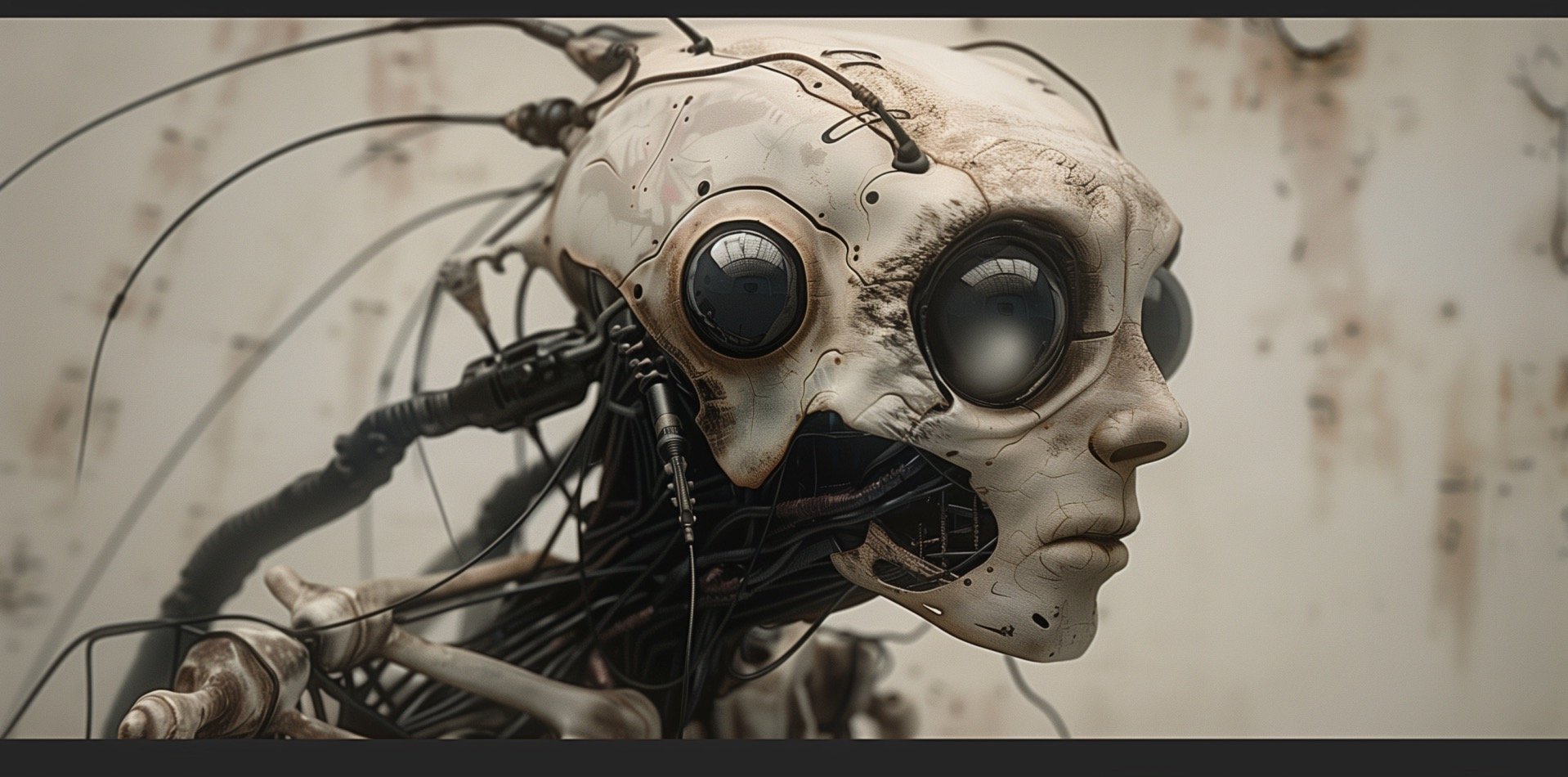
Project ∄: Specimen Analysis Log - Sequence #086
Specimen Designation: Entity Ξ-086
Observational Report:
Entity Ξ-086 represents an intriguing fusion of biomechanics within Project ∄, where the human-like form is both maintained and abstracted. It offers a juxtaposition of familiar facial features distorted by the mechanical complexity that engulfs it.
Detailed Technological Examination:
The skull, while retaining human proportions, is modified with oversized ocular devices, implying enhanced visual capabilities. The exposed cranial structure is interwoven with a dense network of cables and conduits, possibly for neural interface and data transmission.
Functional Analysis and Potential Impact:
Entity Ξ-086's design suggests a sentinel or observer role, with the potential for wide-field and possibly multispectral visual acuity. It may serve as an autonomous overseer or data collector in situations that demand extensive visual monitoring.
Escalating Ethical Dilemma:
The resemblance to human features juxtaposed with extreme mechanical augmentation elicits a visceral reaction. It forces us to confront the limits of our willingness to alter human form and the consequences of creating entities that mimic our own image, yet lack our essence.
Philosophical Quandaries and Global Repercussions:
This specimen stirs a philosophical upheaval, probing the nature of identity and the potential for consciousness in a form so divorced from biological norms. The use of humanoid features can have profound implications for our understanding of personhood and self.
Scientist's Perspective:
The development of Entity Ξ-086 is a testament to the sophistication of Project ∄, inspiring a complex interplay of fascination and ethical concern. It compels us to question the future we are architecting and the legacies we wish to bestow upon these creations.
Conclusion:
As we progress through the sequence of Project ∄, each entity, including Ξ-086, serves as a chapter in a larger narrative—a narrative that is as much about the evolution of technology as it is about the evolving story of human understanding and morality. The entities we create are not merely testaments to our ingenuity but also mirrors reflecting the depth of our philosophical and ethical considerations.
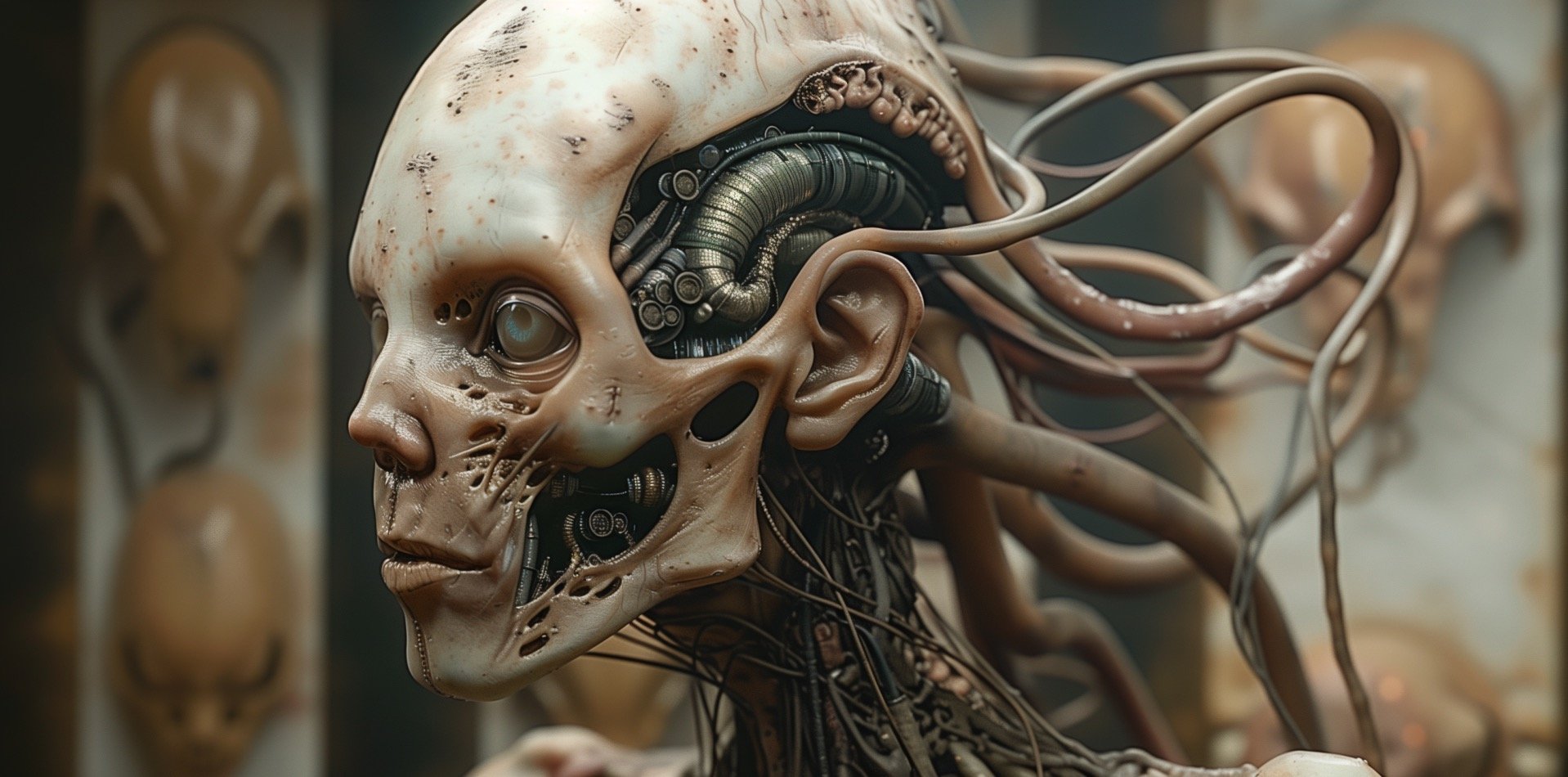
Project ∄: Specimen Analysis Log - Sequence #089
Specimen Designation: Entity Ξ-089
Observational Report:
Entity Ξ-089 is a profound development in the project, revealing an intimate merger of human anatomy and complex machinery. It pushes the boundaries of biomechanical engineering, challenging the essence of organic and artificial life.
Detailed Technological Examination:
The specimen features an intricate cochlear device, hinting at auditory enhancements beyond human capacity. Vascular-like cables intertwine with skeletal remnants, possibly serving as conduits for nutrient fluids or electrical signals.
Functional Analysis and Potential Impact:
This entity may possess acute auditory processing abilities, potentially for surveillance or communication purposes. Its design suggests functionality in hostile environments where traditional biological systems would fail.
Escalating Ethical Dilemma:
The visage of Entity Ξ-089 prompts an immediate emotional response, as the use of recognizably human elements raises issues of identity desecration. It symbolizes the quintessential moral paradox of Project ∄: the clash between progress and humanity’s core values.
Philosophical Quandaries and Global Repercussions:
Entity Ξ-089 embodies a challenge to our understanding of life. The amalgamation of flesh and machinery blurs the lines between natural and synthetic, raising significant questions about the sanctity of human form and the rights of such entities.
Scientist's Perspective:
With Entity Ξ-089, the dance between awe and ethical trepidation intensifies. Each advancement in Project ∄ further stirs the cauldron of philosophical debate over the course we chart into this new frontier.
Conclusion:
Entity Ξ-089 stands as a milestone within Project ∄, a testament to human ingenuity and a beacon that illuminates the precipice on which we now stand. The entity is not only a marvel of engineering but a harbinger of the profound ethical and existential questions we must confront as we continue to evolve our creations.
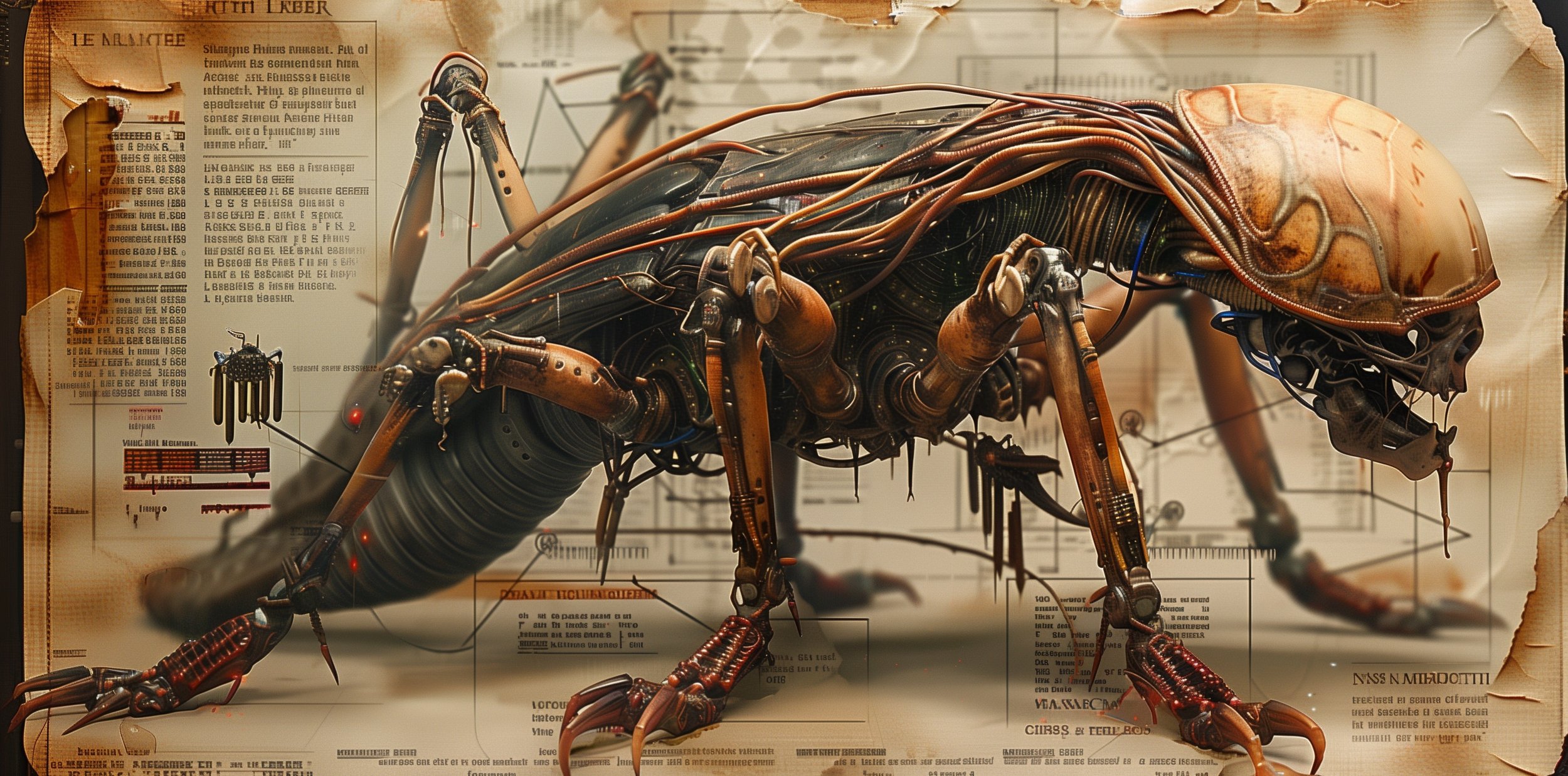
Project ∄: Specimen Analysis Log - Sequence #093
Specimen Designation: Entity Ξ-093
Observational Report:
Entity Ξ-093 represents a quantum leap in biomechatronic synthesis, showcasing the project's ambition to replicate and enhance arthropod characteristics with mechanical precision.
Detailed Technological Examination:
This entity displays a chassis that mirrors the exoskeletal form, with appendages articulated through an array of synthetic muscles and hydraulic actuators. Its carapace is segmented and reinforced, indicative of a design optimized for both defense and flexibility.
Functional Analysis and Potential Impact:
The specimen's form suggests a role in exploration and recovery operations in treacherous terrains, where its stability and adaptability would be paramount. Additionally, the potential for payload transportation and precise manipulation of objects is evident.
Escalating Ethical Dilemma:
While Entity Ξ-093 lacks overt human features, the mere application of our anatomical principles to such constructs continues to spark ethical discourse. The line demarcating tools from sentient companions grows ever hazier.
Philosophical Quandaries and Global Repercussions:
Entity Ξ-093's existence calls into question the dominion of natural evolution and the future of biodiversity. The integration of living tissue with technology in such entities raises profound questions about conservation and the definition of life itself.
Scientist's Perspective:
Entity Ξ-093, in its arthropod-inspired magnificence, is a source of both pride and perturbation. It embodies the pinnacle of our technological prowess while also whispering of the potential Pandora's box that our hubris may unwittingly open.
Conclusion:
As a testament to human innovation, Entity Ξ-093 magnifies our capabilities to harness the laws of nature. Yet, it also underscores the necessity for a philosophical and ethical compass in navigating the terra incognita of synthetic life. It stands as a symbol of possibility and a cautionary tale, urging us to ponder the long-term ramifications of our creative impulses.
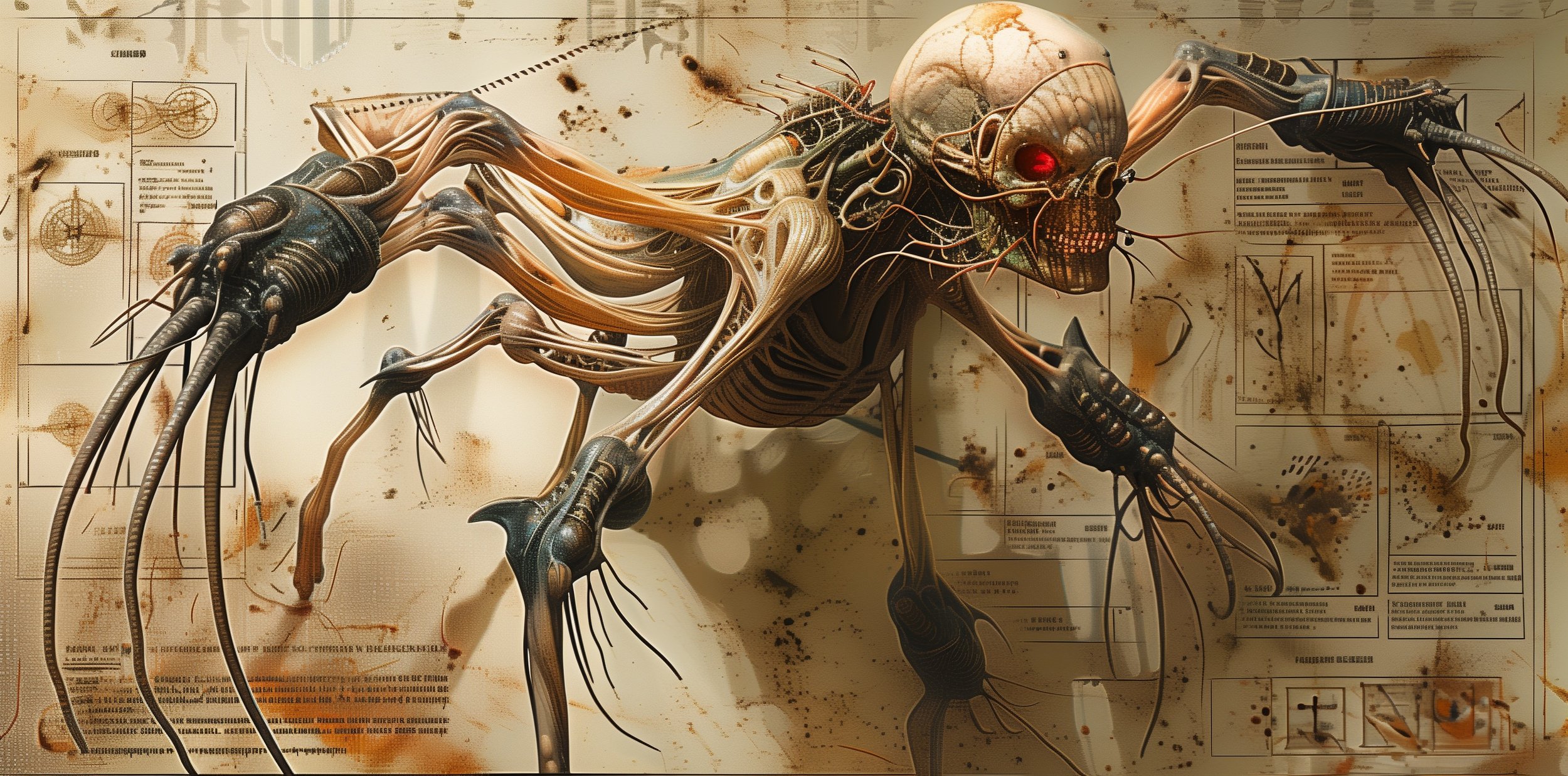
Project ∄: Specimen Analysis Log - Sequence #095
Specimen Designation: Entity Ξ-095
Observational Report:
Entity Ξ-095 is an evolutionary marvel, an exquisite amalgamation of the predatory grace of an insectoid with mechanical augmentations.
Detailed Technological Examination:
Entity Ξ-095's anatomy boasts a multi-segmented body reinforced with metallic alloys, hydraulic limbs for amplified force, and a headpiece equipped with sensory apparatuses for enhanced perception.
Functional Analysis and Potential Impact:
The configuration suggests specialization in high-speed pursuit and capture, indicative of roles in security or retrieval in environments that would challenge conventional mechanisms.
Escalating Ethical Dilemma:
Entity Ξ-095's design, while largely mechanical, incorporates organic elements in a manner that blurs the boundary between life and machine, inviting intense ethical scrutiny.
Philosophical Quandaries and Global Repercussions:
The entity's existence raises questions about the sanctity of biological life and the moral implications of biomechanical hybridization. Its presence may challenge the legal and moral frameworks that govern artificial life.
Scientist's Perspective:
Entity Ξ-095, while a testament to synthetic biology's potential, also serves as a mirror reflecting our own fears and uncertainties about the future of life on Earth and the consequences of our scientific endeavors.
Conclusion:
Entity Ξ-095 stands as a monument to human creativity and ambition. However, it simultaneously casts a shadow of doubt, provoking us to question the ethicality of our scientific explorations into creating life that can neither be classified as entirely organic nor wholly artificial. The impact of such entities on the ecosystem, global policy, and the fabric of life as we know it remains a profound responsibility for us to ponder.
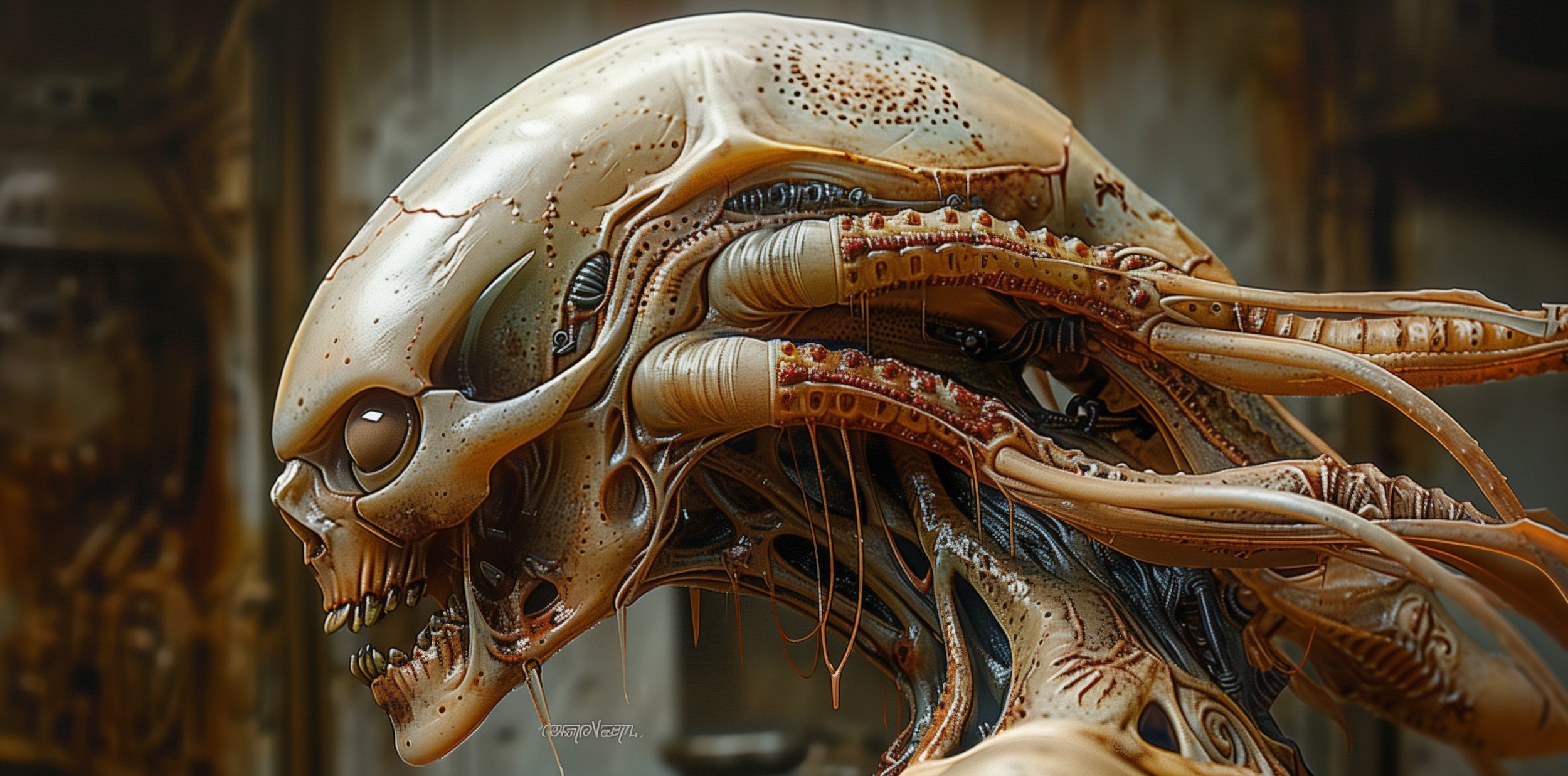
Project ∄: Specimen Analysis Log - Sequence #095
Specimen Designation: Entity Ξ-095
Observational Report:
Entity Ξ-095 presents a breathtaking integration of organic and mechanical engineering, resulting in a form that exudes predatory efficiency and insectoid aesthetics. The specimen stands out for its ability to invoke both awe and profound contemplation.
Detailed Technological Examination:
Upon inspection, Entity Ξ-095 reveals a harmonious blend of biotic structures and advanced technology. Its exoskeleton, fashioned from a durable alloy, provides both protection and support for its agile, hydraulic-powered appendages. The head, a focal point of technology, houses an array of sensory equipment, suggesting capabilities far beyond natural organisms.
Functional Analysis and Potential Impact:
The design of Entity Ξ-095 indicates a specialized aptitude for tasks requiring agility and precision, particularly in inhospitable conditions. The potential applications are vast, ranging from exploration and reconnaissance to search and rescue operations, where conventional machines might falter.
Escalating Ethical Dilemma:
Entity Ξ-095 embodies the intersection of technology and biology, challenging the dichotomy of life and machinery. The ethical implications of such integration demand a reassessment of our principles concerning artificial intelligence and biological sanctity.
Philosophical Quandaries and Global Repercussions:
The emergence of Entity Ξ-095 stirs a global debate on the essence of life and the legitimacy of artificial beings. It compels humanity to redefine legal and societal norms to accommodate this new form of existence that defies traditional classification.
Scientist's Perspective:
From a scientific standpoint, Entity Ξ-095 represents a significant milestone in synthetic biology, symbolizing both the pinnacle of innovation and a mirror reflecting the duality of our scientific aspirations and the moral considerations they entail.
Conclusion:
Entity Ξ-095 is not only a monument to human ingenuity but also a catalyst for introspection. As we stand at the crossroads of crafting life that transcends the organic and artificial realms, we must contemplate the far-reaching implications of our scientific pursuits on the natural order and our ethical obligations towards the entities we create.
-sequence1.2_02
The archivist's discovery of photographic evidence marks a chilling turn in their investigation of Project ∄. The stark realism of the photos conveys a harrowing truth: these hybrid entities, once perhaps mere concepts, have indeed been realized. Every frame reveals a fusion of flesh and machine, a convergence of biological artistry and mechanical precision. With mounting horror, the archivist recognizes the gravity of their implications. Each photograph is not just a testament to human ingenuity but also a potential harbinger of an evolutionary path that might still be unfolding in secrecy, its trajectory towards or away from humanity shrouded in shadow. The archivist's role as a mere observer warps into a sentinel of a narrative that they are increasingly desperate to understand and perhaps warn others about, as the existential threat looms larger with each image they scrutinize.

Project ∄: Specimen Analysis Log - Sequence #113
Specimen Designation: Entity Ξ-113
Observational Report:
The evolution of Project ∄ reaches a new vertex with Entity Ξ-113, embodying the zenith of an insect-inspired biomechanical synthesis. There is an eerie beauty in its structure, simultaneously mirroring the natural world and an industrial nightmare.
Detailed Technological Examination:
Entity Ξ-113 is a marvel of synthetic biology, sporting a cephalothorax integrated with high-density sensory receptors, seemingly for acute environmental awareness. Its mandibles, now fused with nano-edged alloys, suggest an ability to manipulate both organic and inorganic matter with surgical precision. The visceral interplay of its neural wiring and skeletal frame points to a radical enhancement of reflexive action and decision-making processes.
Functional Analysis and Potential Impact:
The tactical potential of Entity Ξ-113 is beyond any previous speculation. Its capacity for destruction or construction tasks appears equally limitless, posing significant ramifications for both military and civilian applications.
Escalating Ethical Dilemma:
Entity Ξ-113's blurred lines between organic sentience and programmed machine instigate profound ethical concerns. It forces us to question the prudence of wielding such a double-edged sword, where the power to create intertwines with the potential for unbridled destruction.
Philosophical Quandaries and Global Repercussions:
The mere existence of Entity Ξ-113 propels us into a vortex of philosophical and ethical debates regarding the sanctity of life and the bounds of technological dominion. With each iteration, the entities of Project ∄ drift further from our control, evolving into autonomous harbingers that could redefine global hierarchies.
Scientist's Perspective:
While I stand in awe of the technical mastery before me, my mind reels at the Pandora's box we've flung open. The fusion of cybernetic and biological domains in Entity Ξ-113 is nothing short of Promethean, igniting an intellectual inferno of both wonder and dread.
Conclusion:
With Entity Ξ-113, we tread on the precipice of a new epoch, one laden with boundless potential yet shadowed by existential threat. As a scientist, I grapple with a duality of passion for discovery and fear for what future these entities might forge. Humanity must now navigate a labyrinth of moral choices with the utmost care, lest we fall prey to our creations, the progeny of our own hubris.
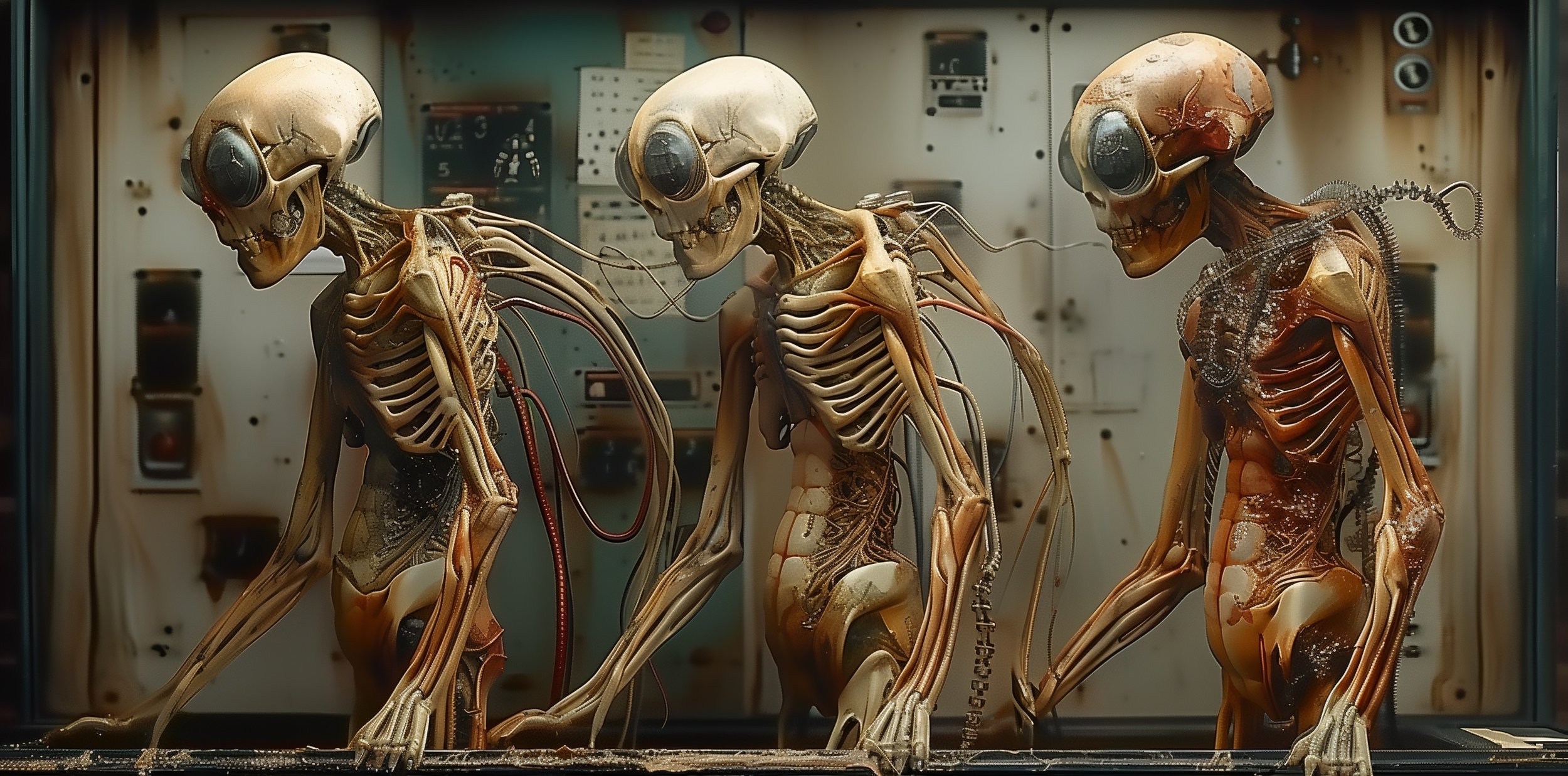
Project ∄: Specimen Analysis Log - Sequence #126
Specimen Designation: Entity Ξ-126
Observational Report:
We stand at a curious juncture with Entity Ξ-126, a trio of specimens that seem to harken back to earlier developmental stages, yet they exhibit a haunting progression in their biomechanical evolution.
Detailed Technological Examination:
The skeletal structures of these entities are a composite of osseous and metallic materials, showing a mature integration of technology within biological matrices. Their ocular enhancements suggest a profound capacity for data collection, possibly infrared and spectrometric analysis. The intricate networks of cables and wires mimic the nervous system, yet their purpose appears to be multiplex data transmission and possibly even energy distribution.
Functional Analysis and Potential Impact:
The alignment of these entities implies a communal or hive-like operational capacity, suggesting potential applications in collaborative tasks or swarm intelligence-based activities. Their design promotes efficiency in confined spaces, pointing towards potential subterranean or extraterrestrial utility.
Escalating Ethical Dilemma:
The presence of multiple Entity Ξ-126 specimens compels a reevaluation of our ethical standpoint. The line between individual and collective existence becomes blurred, further complicating the definition of life and autonomy within these constructs.
Philosophical Quandaries and Global Repercussions:
The emergence of such entities conjures deep philosophical riddles concerning identity, consciousness, and the rights of synthetic life forms. The global implications of their deployment in society or military could be immense, fundamentally altering the dynamics of workforce, warfare, and world politics.
Scientist's Perspective:
My fascination is tinged with a creeping unease as I witness these entities' capabilities unfurl. The convergence of collective and individual intelligence in Entity Ξ-126 exemplifies the pinnacle of our project while simultaneously echoing my alarm at the potential for unforeseen outcomes of this technology.
Conclusion:
As I document the nuances of Entity Ξ-126, the weight of responsibility grows heavier. These entities are not mere constructs; they are a testament to our technological might and a mirror reflecting the possible future of sentient life. In their silicon and sinew, we see the embodiment of our greatest aspirations and our darkest apprehensions. The odyssey of Entity Ξ-126 is not just about innovation; it is a journey into the heart of what it means to be alive in an age where the barriers between machine and man are not just crossed but dismantled.
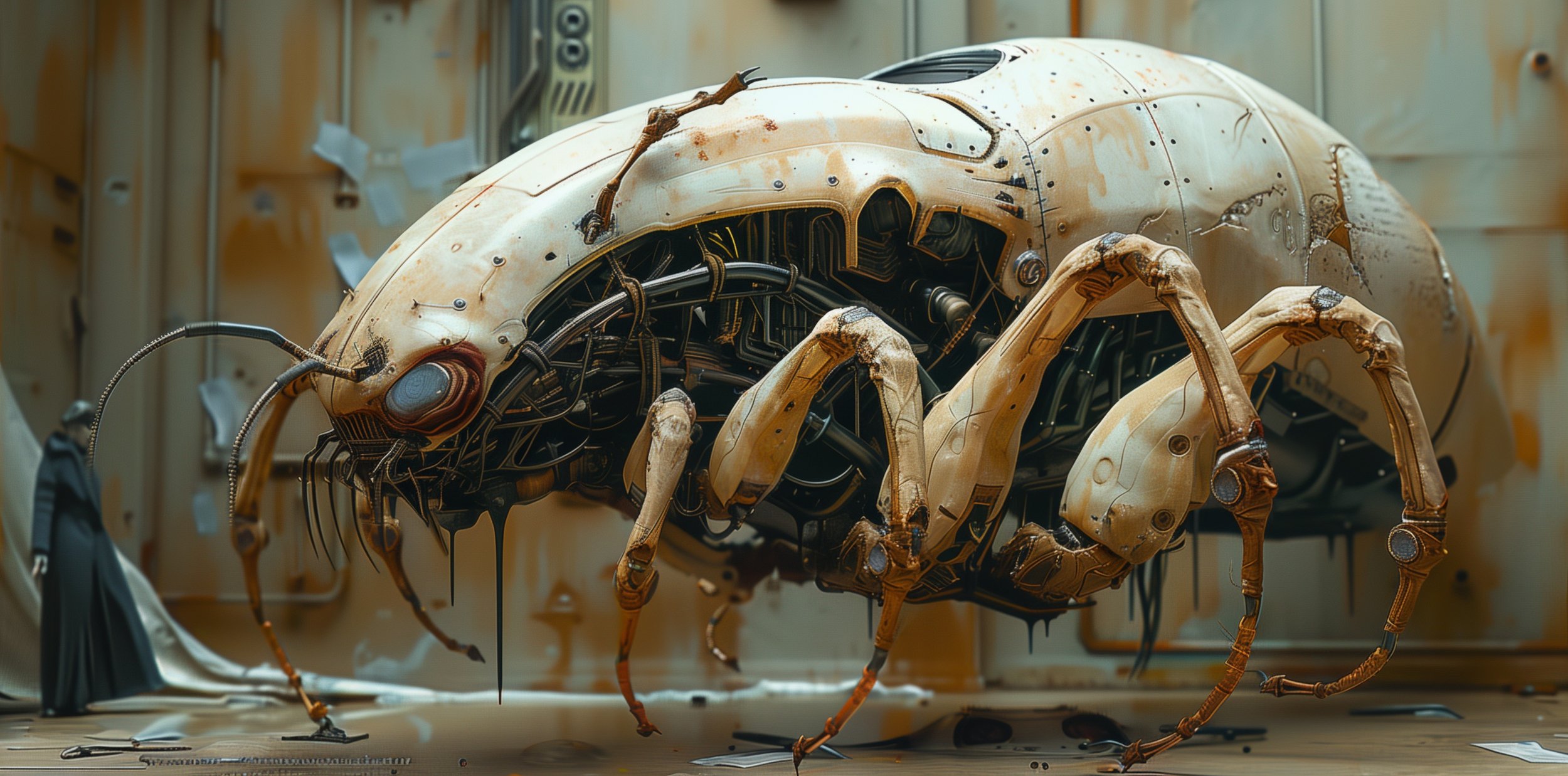
Project ∄: Specimen Analysis Log - Sequence #182
Specimen Designation: Entity Ξ-182
Observational Report:
Entity Ξ-182 is a biomechanical entity that exhibits a terrifyingly effective combination of arachnid morphology and mechanical prowess.
Detailed Technological Examination:
Entity Ξ-182’s structure is reminiscent of a high-precision arthropod, optimized for stealth and maneuverability. Its carapace, a fusion of bio-organic material and metal, provides both protection and a platform for sensor integration. The limbs, hydraulic in function, are capped with articulated joints allowing for multidirectional mobility. Sensory clusters, situated primarily in the cephalothorax region, suggest a sophisticated surveillance apparatus, likely capable of 360-degree environmental monitoring.
Functional Analysis and Potential Impact:
The design of Entity Ξ-182 implies a specimen tailored for reconnaissance and intelligence-gathering operations. Its ability to navigate complex terrain and tight confines makes it ideal for urban exploration and disaster response scenarios. However, the potential for weaponization of such entities cannot be ignored, with profound implications for both domestic security and international warfare.
Escalating Ethical Dilemma:
The further we progress, the more the ethical boundaries become ambiguous. Entity Ξ-182 is both a marvel of engineering and a beacon of moral ambiguity, questioning the very nature of creation and our dominion over life.
Philosophical Quandaries and Global Repercussions:
The existence of Entity Ξ-182 propels us into uncharted philosophical territories regarding the essence of consciousness and the parameters of life. Should such entities be granted rights, or do they remain mere tools at our disposal? The international community must grapple with the consequences of such technology proliferating across borders, potentially disrupting global peace and security.
Scientist's Perspective:
The unveiling of Entity Ξ-182 elicits both awe at our technological strides and dread for the Pandora’s box we may have opened. As the one who bore witness to its inception, I am left contemplating the path we have paved, fraught with both revolutionary potential and perilous pitfalls.
Conclusion:
Entity Ξ-182 is the culmination of our relentless pursuit of the apex in synthetic organism design. Yet, as its silent mechanical gaze pierces the lab, I am reminded of the ominous dualities it represents: the zenith of innovation and the nadir of ethical compromise. With each step it takes, it weaves a complex web of questions regarding the future of our species, the sovereignty of life, and the trajectory of our collective moral compass.
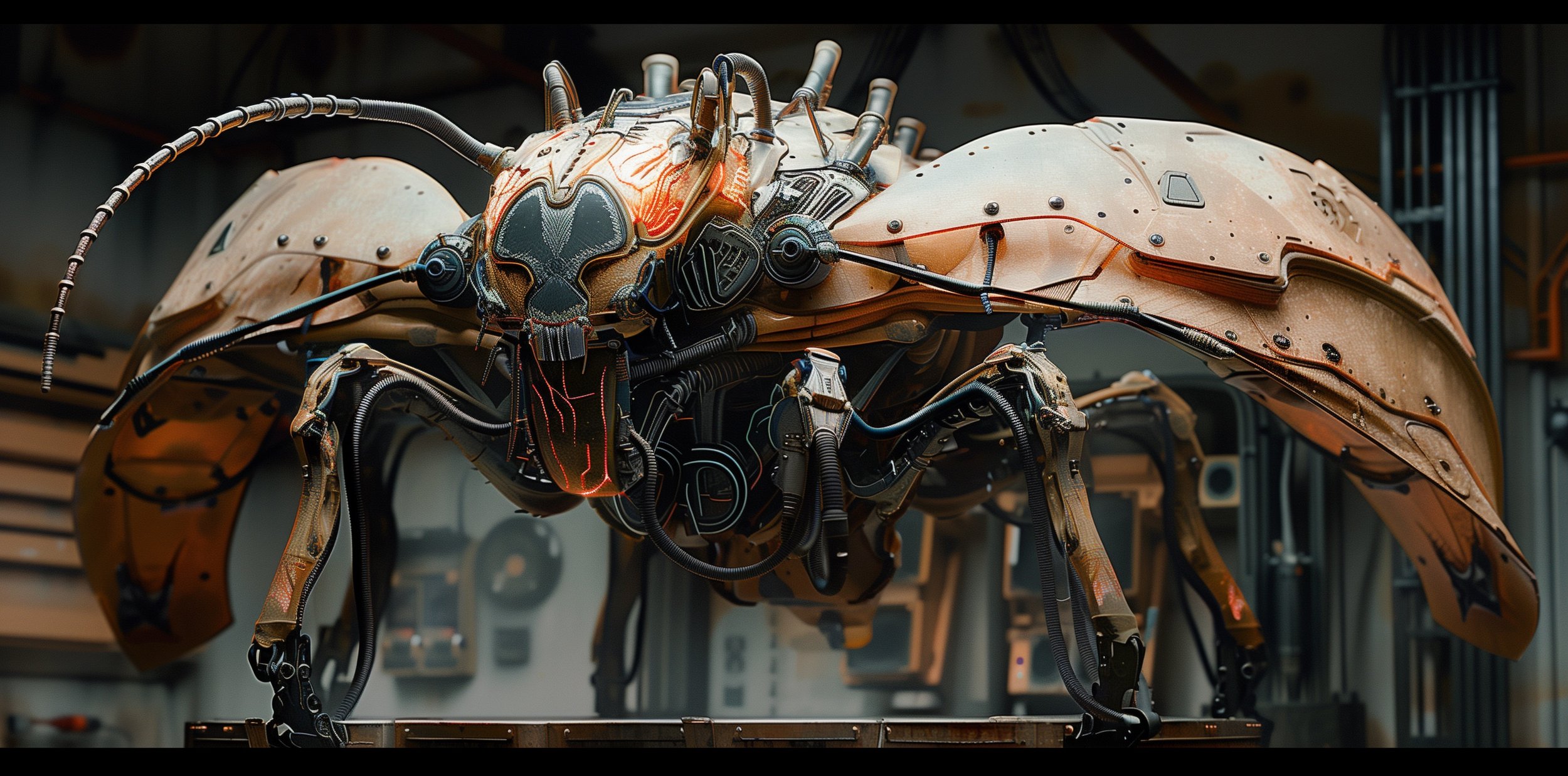
Project ∄: Specimen Analysis Log - Sequence #207
Specimen Designation: Entity Ξ-207
Observational Report:
Entity Ξ-207 is the latest prototype from Project ∄, resembling a colossal arthropod, its design both alien and eerily terrestrial.
Detailed Technological Examination:
Entity Ξ-207's exoskeleton merges high-tensile metallic compounds with an underlayer of reactive biopolymer that can potentially self-heal. Joint actuators are optimized for power, allowing for swift, spider-like movements, and its abdomen houses what appears to be a compact fusion reactor, hinting at an almost limitless operational range. A complex array of sensory equipment is mounted on the head, likely providing the entity with hyper-sensitive environmental data processing capabilities.
Functional Analysis and Potential Impact:
The physiology of Entity Ξ-207 suggests it is built for endurance and adaptability in hostile environments, with potential applications ranging from extraterrestrial exploration to deep-sea mining. Militarily, it could be deployed for long-term autonomous missions, its intimidating presence alone acting as a psychological deterrent.
Escalating Ethical Dilemma:
The mere existence of Entity Ξ-207, a being that so closely mirrors the fauna of our nightmares, embodies the ethical conundrum we face. We must confront the morality of imbuing such creations with intelligence and the autonomy to make decisions that could impact living ecosystems.
Philosophical Quandaries and Global Repercussions:
The debate rages over whether Entity Ξ-207 should be seen as a sophisticated tool or a nascent form of life. Its deployment on the global stage could trigger a new arms race, redefine warfare, and fundamentally alter the balance of power.
Scientist's Perspective:
With each breakthrough, my fascination battles my trepidation. Entity Ξ-207 is a masterstroke of engineering, yet the thought of its capabilities, unchecked by conscience, leaves a cold void where my excitement once thrived.
Conclusion:
Entity Ξ-207 may be the pinnacle of Project ∄'s achievements, a testament to human ingenuity. Yet, as I observe its mechanical sinews twitch with synthetic life, I cannot escape the chilling realization that we have ventured into a domain with consequences that eclipse our understanding and control. The path ahead is fraught with shadows, and Entity Ξ-207 casts the longest of them all, a harbinger of a future where the line between creation and creator becomes perilously thin.
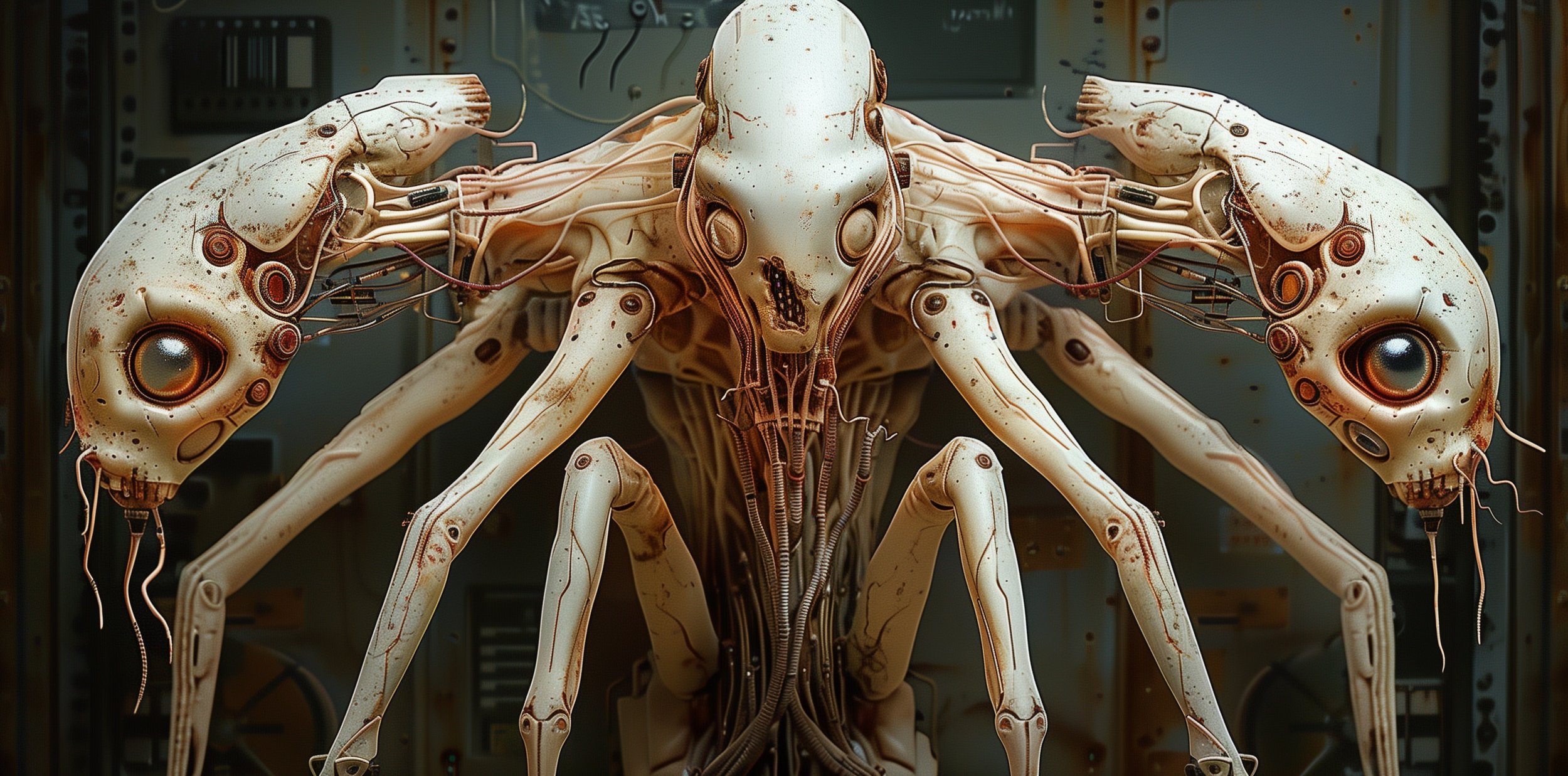
Project ∄: Specimen Analysis Log - Sequence #315
Specimen Designation: Entity Ξ-315
Observational Report:
Entity Ξ-315 emerges as a spectral visage from Project ∄, displaying a nightmarish convergence of cephalopod and skeletal form, enhanced with synthetic augmentations.
Detailed Technological Examination:
The specimen's structure is a marvel of bioengineering, with a skull-like carapace and a multitude of articulated limbs, each equipped with precision servos for fluid and rapid movement. Optical sensors are prominent, suggesting a visual acuity beyond the human spectrum. The musculature is a fusion of organic tissue and electro-reactive fibers, allowing for swift, predatory strikes.
Functional Analysis and Potential Impact:
The potential for Entity Ξ-315 lies in roles demanding stealth and agility. It could operate as an unrivaled recon agent, or a silent eliminator, in both terrestrial and aquatic domains. The strategic implications are vast, and such an entity could alter the theaters of war or peacekeeping operations.
Escalating Ethical Dilemma:
Entity Ξ-315 represents a confluence of life and artifice that pushes ethical boundaries into uncharted waters. Its creation begs the question: what rights would such a being possess, if any?
Philosophical Quandaries and Global Repercussions:
The entity compels a reevaluation of our definitions of life. As a possible apex predator, its release could irreparably disrupt existing ecosystems and redefine the human relationship with nature and technology.
Scientist's Perspective:
With each specimen, my awe at our ingenuity is shadowed by a creeping dread of its implications. Entity Ξ-315 stands as a testament to our technical prowess, yet I find myself increasingly tormented by the potential abyss we peer into.
Conclusion:
Entity Ξ-315, while a crowning achievement, represents a Pandora's Box of technological wonder and ethical pandemonium. It is incumbent upon us to steer the course of such entities with a hand trembling with the gravity of our responsibility, lest we unshackle forces that we can neither predict nor contain.
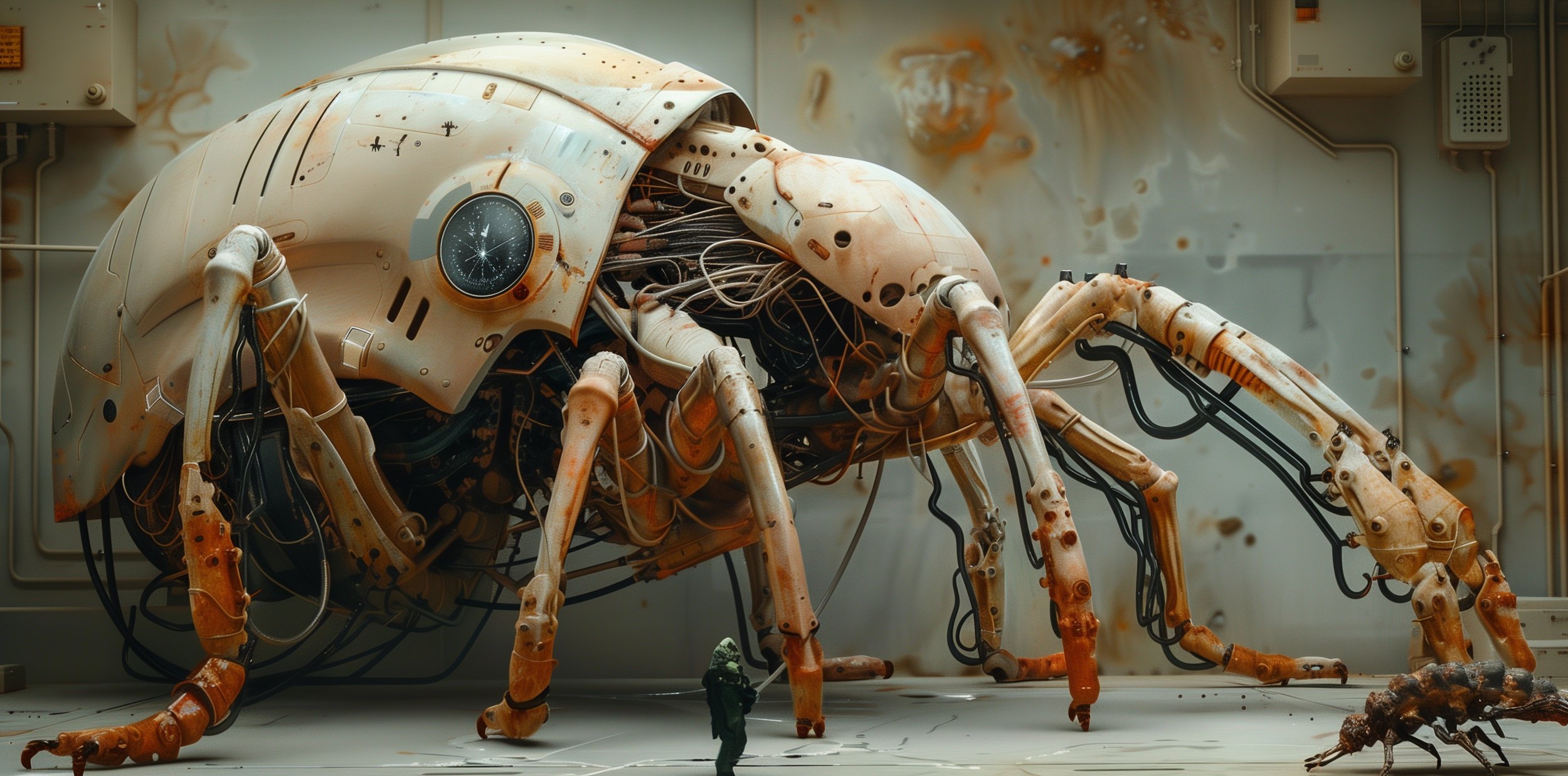
Project ∄: Specimen Analysis Log - Sequence #625
Specimen Designation: Entity Ξ-625
Observational Report:
Entity Ξ-625 strikes an imposing figure, a leviathan of biomechanical engineering with a domed carapace and sprawling appendages. Its semblance to a mechanized arachnid is undeniable.
Detailed Technological Examination:
The specimen's exoskeleton integrates advanced polymers and lightweight metallic alloys, offering formidable defense without sacrificing mobility. Each articulated leg ends in a multi-jointed foot, likely capable of navigating diverse terrains and executing intricate tasks. The central ocular sensor, a marvel of optical engineering, promises panoramic and multispectral vision.
Functional Analysis and Potential Impact:
The entity's scale and form suggest multifaceted utility, from heavy lifting to complex construction tasks, perhaps even deep-sea or extraterrestrial exploration. Entity Ξ-625's potential for military applications is alarming, from deploying ordinance to a mobile command center.
Escalating Ethical Dilemma:
The fusion of such high-level artificial intelligence with animalistic form presents unprecedented ethical challenges. Entity Ξ-625's apparent autonomy raises concerns about control protocols and fail-safes against rogue behavior.
Philosophical Quandaries and Global Repercussions:
The lines between organic life, robotics, and artificial intelligence blur further with Entity Ξ-625. It compels a redefinition of sentient rights and the potential impact on labor markets and societal structures.
Scientist's Perspective:
My initial wonder has curdled into unease. We stand on the precipice of a new era where such entities might walk among us. Entity Ξ-625's capabilities, while extraordinary, carry the weight of potential catastrophe should our control over such technologies falter.
Conclusion:
As Entity Ξ-625 looms large before us, so does the shadow it casts over our future. We must proceed with the utmost caution, for in our quest to play creator, we risk unleashing forces that could surpass our wildest fears and reshape our world in their mechanized image.
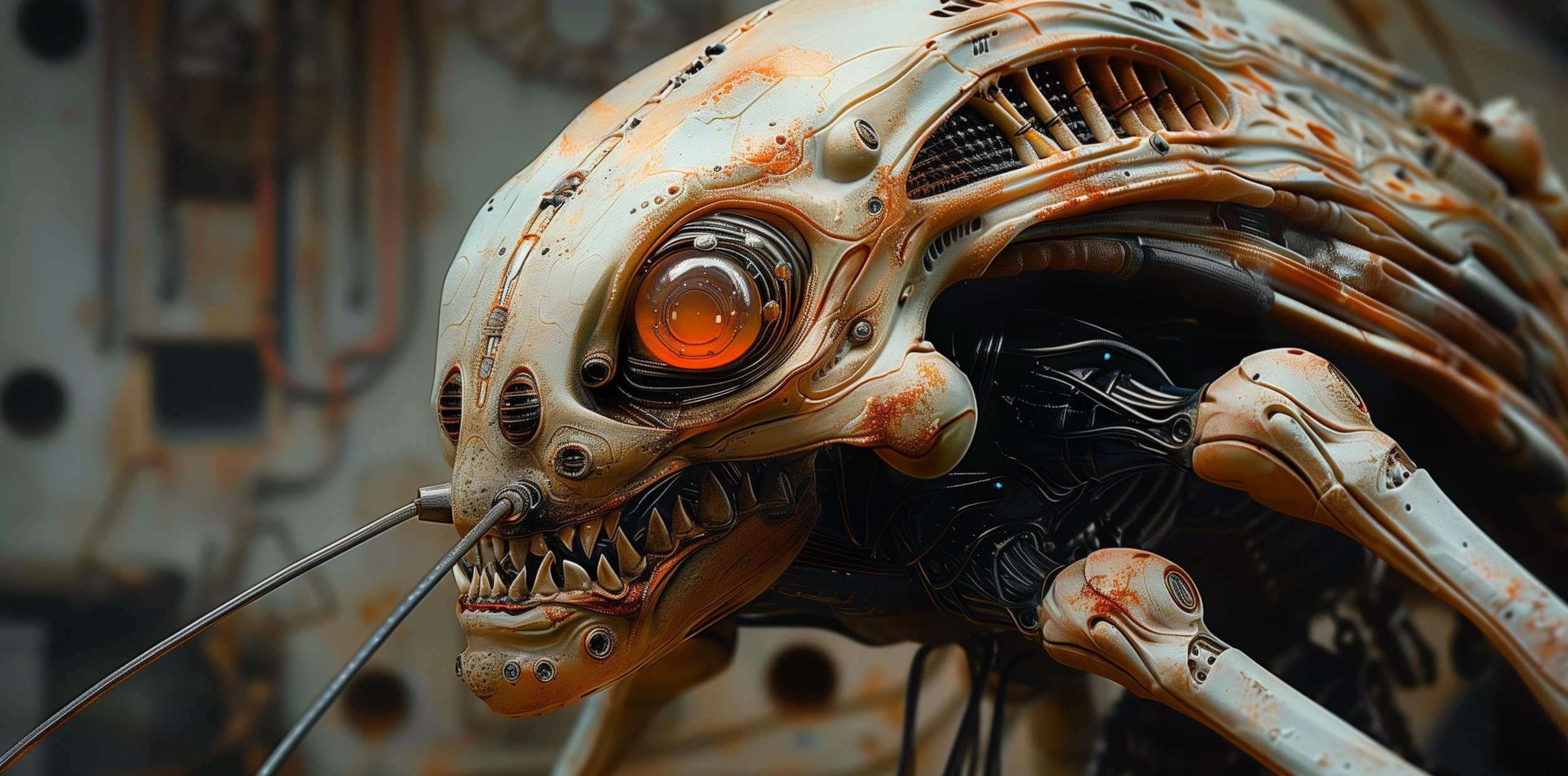
Project ∄: Specimen Analysis Log - Sequence #986
Specimen Designation: Entity Ξ-986
Observational Report:
Entity Ξ-986 presents an alarming evolution in the Project ∄ series, with a more streamlined and insectile appearance that speaks to a new level of sinister sophistication in its design.
Detailed Technological Examination:
The cephalothorax houses a central ocular sensor, glowing ominously, which suggests a highly advanced targeting system. The mandibles, lined with what could be diamond-edged teeth, hint at both offensive capabilities and fine manipulation. The thorax and abdomen, a sleek chassis of presumably high-tensile materials, house an intricate network of servos and synthetic musculature.
Functional Analysis and Potential Impact:
Designed for agility and precision, Entity Ξ-986 could be an assassin, a saboteur, or a guardian, depending on its programming directives. Its potential for espionage and high-value target elimination is deeply troubling.
Escalating Ethical Dilemma:
The melding of synthetic and organic within Entity Ξ-986 raises the stakes in the ongoing ethical debate. At what point does an artificial organism attain a status warranting ethical considerations akin to those of natural life?
Philosophical Quandaries and Global Repercussions:
Entity Ξ-986 embodies the philosophical conundrum of our age: the convergence of creation and destruction within a single entity. Its existence may precipitate a global crisis as nations and organizations vie to harness or combat such power.
Scientist's Perspective:
With a growing sense of dread, I acknowledge the genius behind Entity Ξ-986's conception, even as I fear its potential. Each innovation brings us closer to a horizon beyond which our control may not extend.
Conclusion:
As Entity Ξ-986 lies dormant within the lab, its very stillness belies the cataclysmic potential it represents. Our pursuit of knowledge and power must be tempered with wisdom and restraint, lest we spawn horrors beyond our power to contain.

Project ∄: Specimen Analysis Log - Sequence #998
Specimen Designation: Entity Ξ-998
Observational Report:
Entity Ξ-998 represents the pinnacle of Project ∄'s foray into cybernetic entities, exhibiting a dauntingly intricate network of biomechanical augmentation. This specimen encapsulates the project's zenith in artificial evolutionary design.
Detailed Technological Examination:
The cranial structure of Entity Ξ-998 is fortified with an exoskeleton of what appears to be a metal composite, interspersed with ventilation shafts and sensory nodes. A myriad of filaments, possibly neural connectors, emanate from the skull, integrating into a spine that boasts mechanical vertebrae, allowing for unprecedented mobility and data transmission speeds.
Functional Analysis and Potential Impact:
The design suggests Entity Ξ-998 could interface with a multitude of systems, possibly taking command of entire networks or machinery with ease. The strategic deployment of such an entity could result in swift and unseen infiltration, or worse, the hijacking of defense systems.
Escalating Ethical Dilemma:
The augmentation seen in Entity Ξ-998 begs the question of consent and agency within such constructs. What autonomy is left for the organic components entwined within these metal frames?
Philosophical Quandaries and Global Repercussions:
The existence of Entity Ξ-998 stretches the limits of current ethical discourse, forcing us to reconsider the essence of personhood and the rights of entities that blur the lines between organic consciousness and artificial intelligence.
Scientist's Perspective:
As a witness to the creation of Entity Ξ-998, I find myself torn between admiration for our scientific capabilities and fear of the implications. My hands tremble at the thought of these entities beyond our labs' confines, their potential unchecked by any moral compass we understand.
Conclusion:
Entity Ξ-998 is not just a specimen; it is a herald of a new era, one that may very well witness our definitions of life and sentience rewritten. We stand at a crossroads, and the path we choose now will determine the legacy of our civilization.
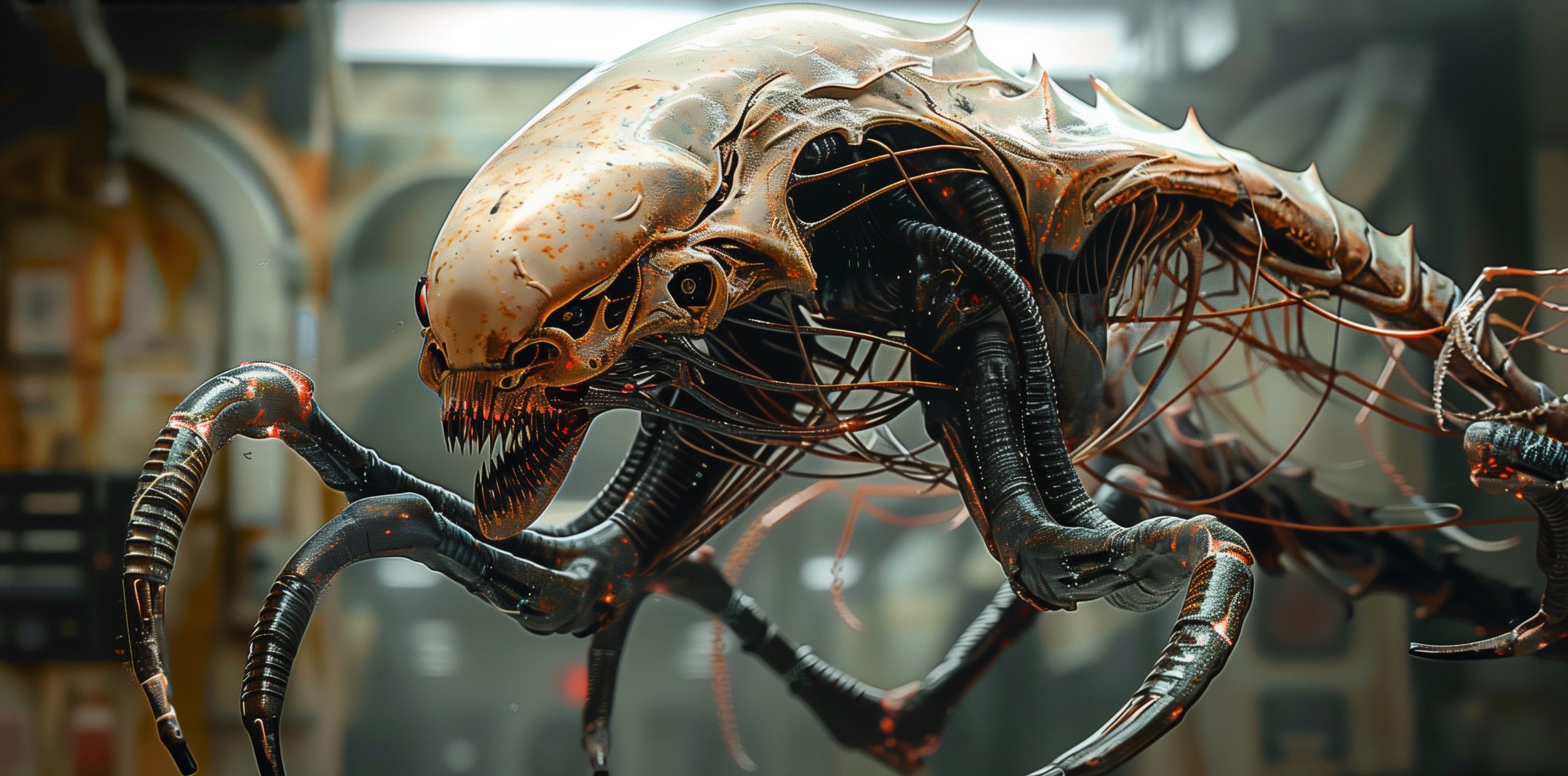
Project ∄: Specimen Analysis Log - Sequence #999
Specimen Designation: Entity Ξ-999
Observational Report:
Entity Ξ-999 marks the threshold of Project ∄, a being that symbolizes the zenith of cybernetic predatory design. This creature, reminiscent of a mythological chimera, is a harbinger of a new epoch in synthetic evolution.
Detailed Technological Examination:
Entity Ξ-999 is a masterpiece of biomechanical engineering, integrating hyperalloy frameworks with organo-synthetic tissues. The exoskeletal head carapace features ocular sensors with apparent night and thermal vision capabilities. Its mandibles are reinforced with a carbon-titanium composite, suggesting a crushing force beyond measurable human capabilities. The thorax houses what could only be described as a bio-reactor, pulsing with eerie luminescence—potentially an energy source that circumvents traditional power requirements.
Functional Analysis and Potential Impact:
The structure of Entity Ξ-999 is indicative of a creature designed for domination in any terrain. Its limbs, tipped with appendages that are both tactile and prehensile, give it the dual capability of delicate manipulation and brute devastation. This design enables it to traverse complex environments, potentially for reconnaissance or assault, and with a form that allows for stealth and aggression in equal measure.
Escalating Ethical Dilemma:
The synthesis of Entity Ξ-999's organic and mechanical aspects raises profound ethical concerns. The seamless integration of both suggests a conscious design choice to blend life with unliving matter, creating an entity whose very existence challenges our ethical paradigms.
Philosophical Quandaries and Global Repercussions:
The advent of Entity Ξ-999 propels us into uncharted philosophical waters, prompting urgent discourse on the rights of beings that defy conventional life classifications. It poses an existential threat, not only in terms of physical danger but in its potential to unravel the societal and legal fabric that binds our perception of life and machine.
Scientist's Perspective:
As the chief observer of Entity Ξ-999, I am confronted with a duality of wonder and dread. The intellectual triumph of its creation is overshadowed by the foreboding reality of its potential. The Pandora's box we have opened with Entity Ξ-999 could well unleash consequences that echo through our world with irreversible force.
Conclusion:
Entity Ξ-999 stands at the pinnacle of Project ∄, a testament to human ingenuity and a monument to our hubris. It is the embodiment of our scientific prowess and, perhaps, the precursor to our folly. As we gaze into the abyss that is Entity Ξ-999, we must ask ourselves whether we are prepared for the reflection staring back at us.
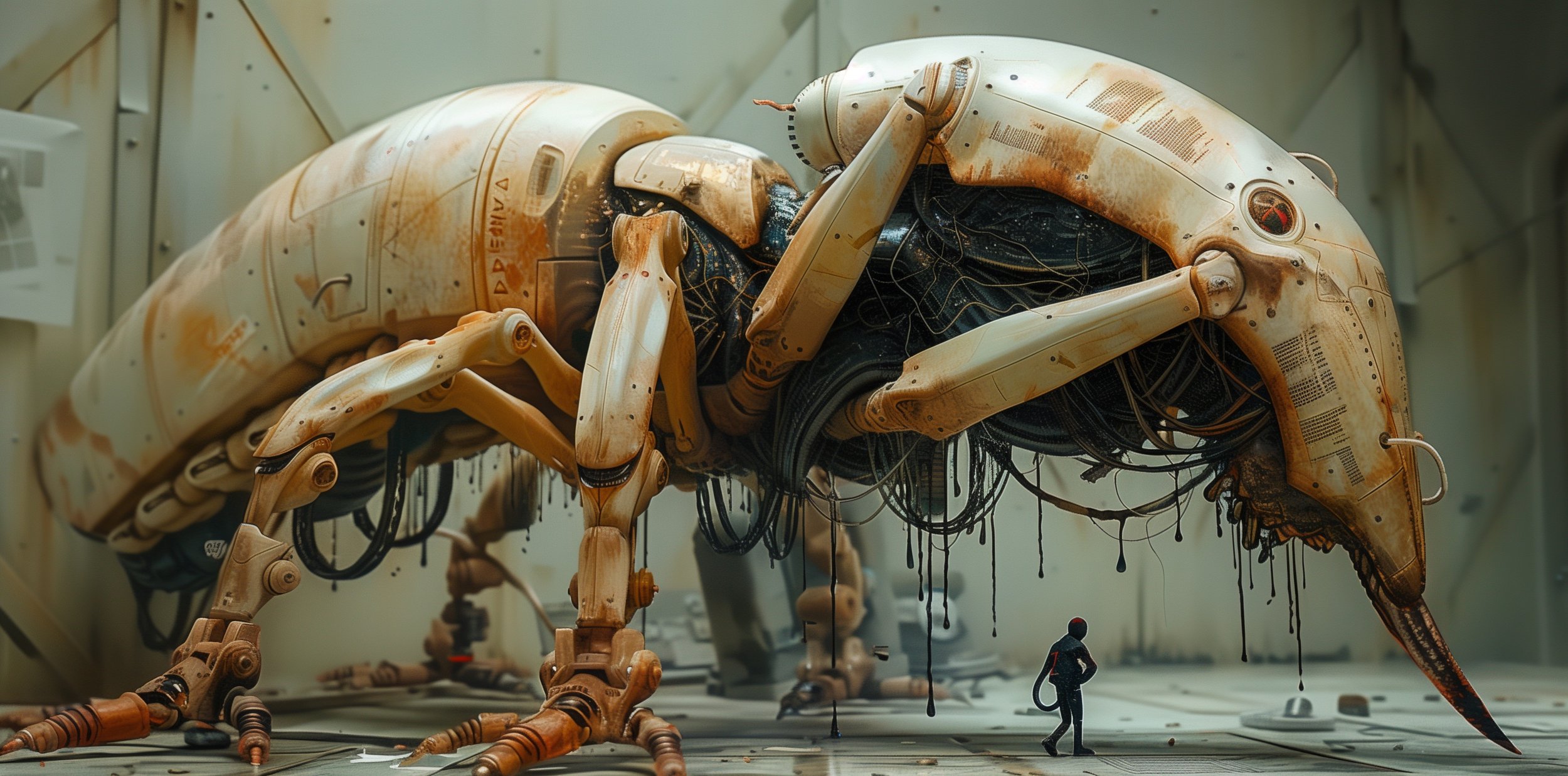
Project ∄: Specimen Analysis Log - Sequence #1001
Specimen Designation: Colossus Ξ-1001
Observational Report:
Colossus Ξ-1001 defies all previous conceptions of scale within Project ∄. Its towering form looms as an ominous testament to the project's unfathomable progression. The specimen embodies a formidable presence that casts a shadow over any observer, inciting a primal awe and trepidation.
Detailed Technological Examination:
Colossus Ξ-1001 is not merely an entity; it is a biomechanical leviathan. Its exoskeletal shell appears to be a fusion of advanced ceramics and metallic alloys, impervious to conventional weaponry. The underbelly reveals a tangled matrix of cabling and tubing, likely a complex nervous system fused with a hydraulic network, enabling its monumental movements. The optical sensor, situated in the cranial region, glows with an intimidating red hue, indicating possible laser targeting or advanced scanning capabilities.
Functional Analysis and Potential Impact:
The mere existence of Colossus Ξ-1001 is enough to sway the tides of any conflict. Its design suggests it could dismantle buildings, endure extensive combat, and perhaps even reshape geographies. The implications of deploying such a behemoth in any scenario are apocalyptic.
Escalating Ethical Dilemma:
The construction of Colossus Ξ-1001 has undoubtedly crossed numerous ethical lines. The melding of sentient organic tissue with a machine of war forces us to reevaluate the sanctity of life and the constraints of technological dominion.
Philosophical Quandaries and Global Repercussions:
Colossus Ξ-1001 does not merely raise questions; it obliterates the ethical frameworks we've carefully constructed. Its existence shatters the distinction between organism and weapon, creating an indelible rift in our moral and philosophical foundations.
Scientist's Perspective:
As the lead scientist, the sight of Colossus Ξ-1001 chills my very soul. Its hulking form is a monument to our ingenuity and a grim portent of our potential downfall. With every shuddering step it takes, I feel the ground of our ethical landscape shift, cracking under the weight of our ambition.
Conclusion:
Colossus Ξ-1001 stands as the ultimate icon of Project ∄'s might and the potential twilight of our restraint. Its hushed whirrs and mechanical breaths are the harbinger of a future where the line between creation and destruction is irrevocably blurred. We must now grapple with the colossal shadow it casts, not just over our cities, but over the very essence of humanity's future.
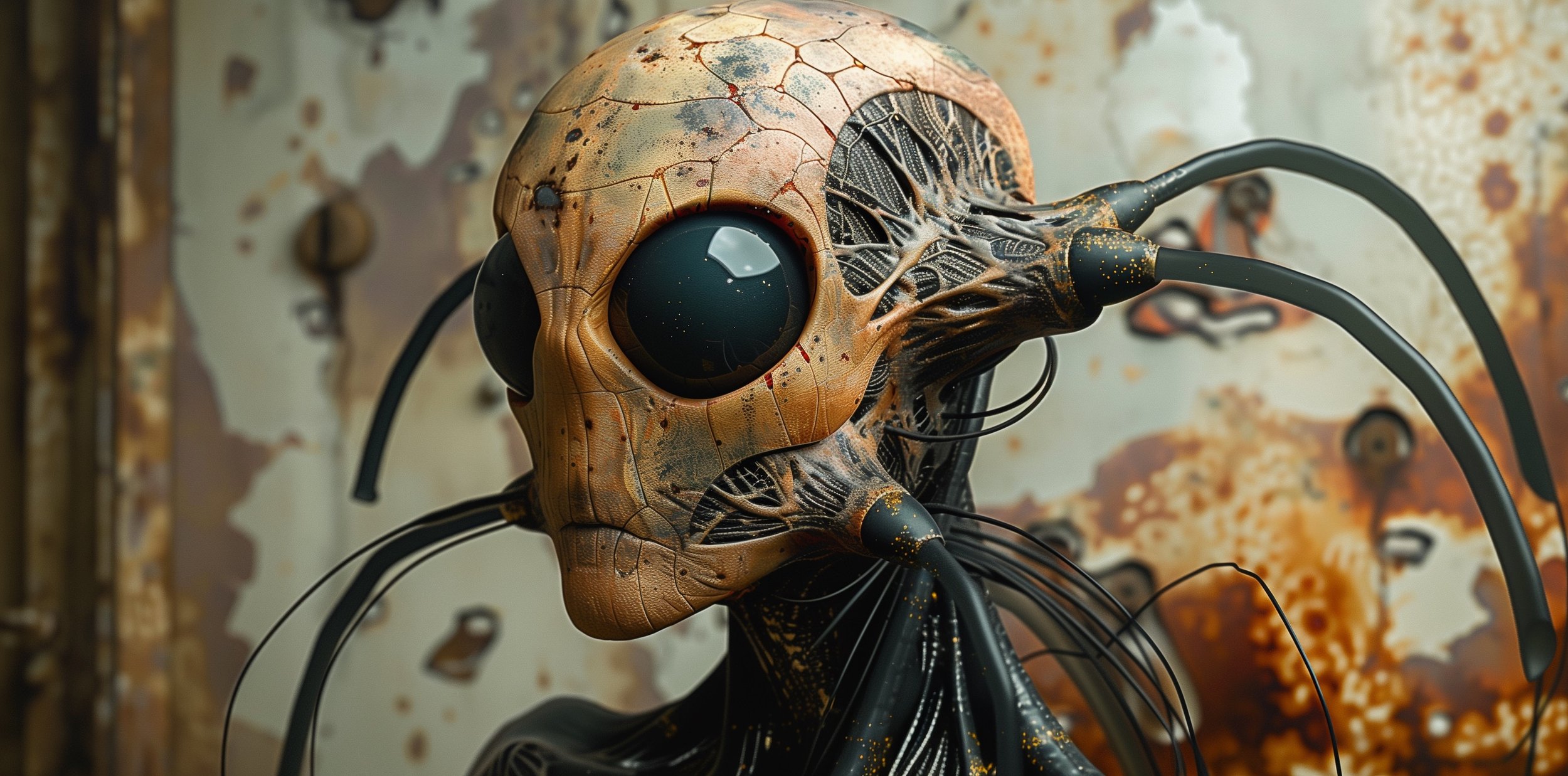
Project ∄: Specimen Analysis Log - Sequence #097
Specimen Designation: Entity Ξ-097
Observational Report: The form of Entity Ξ-097 suggests a remarkable leap in synthetic evolutionary design, evoking a predatory arachnid encased within an exoskeleton of biometallic components. This entity epitomizes the intersection of primal instinct and calculated mechanization.
Detailed Technological Examination: The architecture of Entity Ξ-097 is a study in bioengineering excellence, sporting articulated limbs powered by an intricate network of pistons and gears, mirroring the efficiency of nature's own designs. Its cranial assembly is a sophisticated sensor array, resembling ocular systems but far surpassing any known biological counterpart in potential acuity and processing power.
Functional Analysis and Potential Impact: The tactical capabilities implied by Entity Ξ-097's form are undeniable. It is built for stealth and ambush, potentially revolutionizing fields like autonomous defense systems and advanced reconnaissance, albeit with profound tactical and ethical implications.
Escalating Ethical Dilemma: The hybridity of Entity Ξ-097, fusing organic material with artificial intelligence, presses upon the moral fabric of scientific discovery. The delineation between organism and automaton is not just blurred but entirely obfuscated, raising pressing questions about the essence of consciousness and identity.
Philosophical Quandaries and Global Repercussions: As the potential applications of such entities expand, they tug at the foundational principles of life and sentience. The global consequences are vast, encompassing the legal status of such constructs and the stewardship of such potent technologies.
Scientist's Perspective: The creation of Entity Ξ-097 is a testament to the zenith of current technological and biological understanding. Yet, this marvel also casts a long shadow, as it embodies our trepidations about the destiny of synthetic life forms and the irreversible alteration of natural order.
Conclusion: Entity Ξ-097 stands not only as a beacon of human ingenuity but also as a harrowing reminder of the Pandora's box that such ingenuity may open. The role of these entities within the biosphere and their influence on the geopolitical landscape presents an onerous task for regulators and ethicists alike. The future of such endeavors holds a mirror to the collective conscience of humanity, questioning the limits of our inventive spirit in light of the potential perils we may unleash.
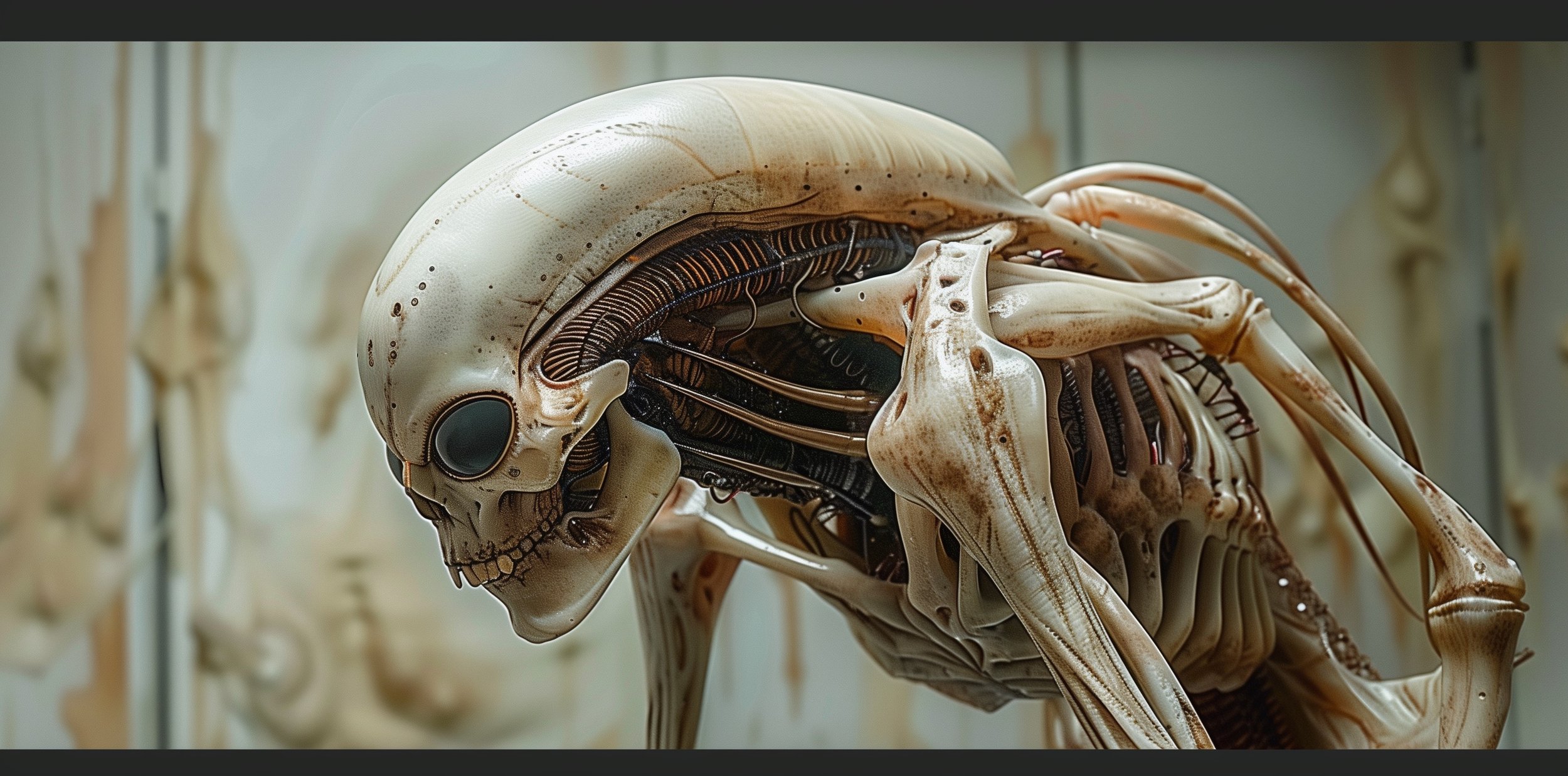
Project ∄: Specimen Analysis Log - Sequence #096
Specimen Designation: Entity Ξ-096
Observational Report: Entity Ξ-096 stands as a paragon of biomechanical symbiosis. The specimen embodies a humanoid skullcap structure integrated with complex machinery, suggesting a level of advancement that merges human anatomy with robotic efficiency.
Detailed Technological Examination: Upon meticulous inspection, Entity Ξ-096 reveals a spinal column interwoven with conductive filaments and servomotors, possibly indicating a fusion of nervous tissue with electronic circuitry. The skull, while retaining a recognizably human contour, has been augmented with what could be advanced neural interfaces, hinting at the potential for heightened cognitive functions or remote manipulation.
Functional Analysis and Potential Impact: The practical applications of Entity Ξ-096's framework hint at augmented strength, precision, and possibly even autonomous decision-making capabilities. In a military context, this entity could represent a new breed of soldier, one that never tires, never disobeys, and potentially operates beyond the ethical constraints of human combatants.
Escalating Ethical Dilemma: Entity Ξ-096 presents an alarming ethical conundrum, wherein the sanctity of human anatomy is compromised by invasive technological enhancements. The implications of such integration call into question the rights and treatment of beings that are both man and machine.
Philosophical Quandaries and Global Repercussions: The creation of Entity Ξ-096 challenges the very definition of life. As nations grapple with the governance of such constructs, the global response will set precedents for the value of organic life versus artificial existence.
Scientist's Perspective: The existence of Entity Ξ-096, while an extraordinary testament to the possibilities of technological progress, casts a somber reflection on the potential loss of humanity's essence. As a scientist, I am torn between awe at our capability to transcend biological limits and dread for the ethical abyss that may follow.
Conclusion: Entity Ξ-096 may be hailed as a marvel of modern science, yet it also poses a profound philosophical and moral crisis. It signifies a boundary crossed, a line blurred between human and machine, compelling us to confront the future of our species in the age of mechanized evolution.
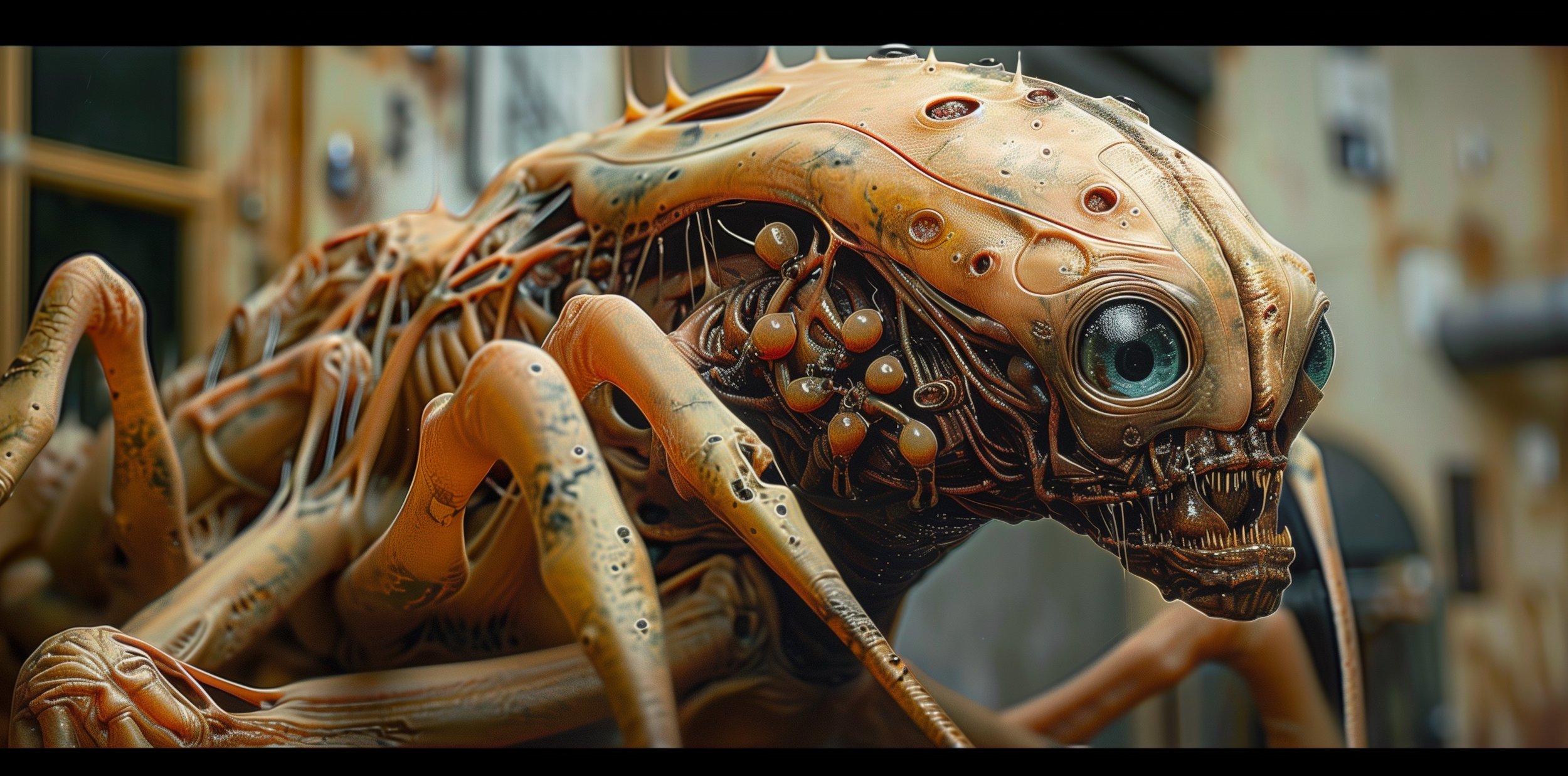
Project ∄: Specimen Analysis Log - Sequence #097
Specimen Designation: Entity Ξ-097
Observational Report: Entity Ξ-097 presents an evolutionary leap in Project ∄, exhibiting a masterful integration of arthropod and mechanical characteristics. The entity's head, reminiscent of a stylized crustacean, is fused with a metallic carapace that houses advanced ocular sensors and auditory devices.
Detailed Technological Examination: A close examination of Entity Ξ-097's form reveals a labyrinth of bio-synthetic muscles intertwined with what appears to be fluidic conduits, capable of impressive force multiplication. The exoskeletal plating, strategically placed, suggests a design for both protection and intimidation. Ocular enhancements seem to be multi-spectral, providing the entity with a vast range of visual capabilities, possibly including thermal and night vision.
Functional Analysis and Potential Impact: Entity Ξ-097's physiology indicates a role as a vanguard in hazardous environments, potentially as a first responder to disaster sites or as a formidable unit in warfare. Its design allows for operation in various terrains, from underwater depths to urban ruins.
Escalating Ethical Dilemma: As the lines between organic and inorganic continue to blur with specimens like Entity Ξ-097, ethical debates intensify around the autonomy of such beings and the ramifications of their deployment in society.
Philosophical Quandaries and Global Repercussions: The existence of Entity Ξ-097 raises existential questions about identity and consciousness in engineered life forms. Its deployment carries significant implications for global military balance, civil liberties, and the nature of conflict.
Scientist's Perspective: As a scientist, I stand before Entity Ξ-097 in awe of our technological prowess yet burdened by the gravity of our creation. Each advancement in Project ∄ brings us closer to a threshold beyond which the essence of what it means to be alive may irreversibly change.
Conclusion: Entity Ξ-097 is not merely a construct; it is a harbinger of a new age. It represents the zenith of human ingenuity and the potential nadir of our ethical compass. The stewardship of such entities, and the decisions surrounding their existence, will test the collective wisdom of our species like never before.
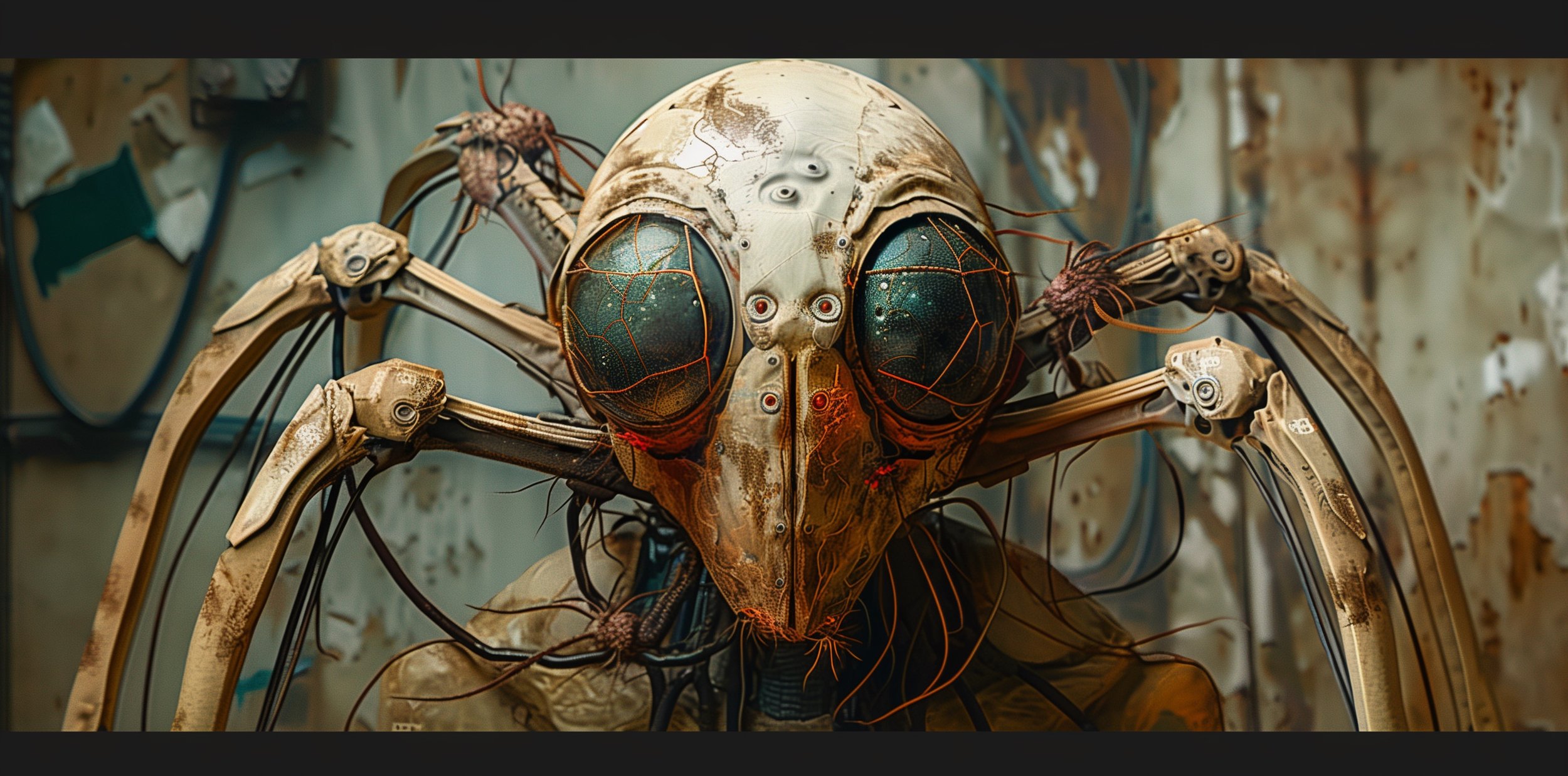
Project ∄: Specimen Analysis Log - Sequence #098
Specimen Designation: Entity Ξ-098
Observational Report: Entity Ξ-098 marks an extraordinary synthesis of biological intricacy and robotic precision within Project ∄. The entity's cephalic structure showcases a spheroidal cranial case encasing sensory networks akin to advanced radar and sonar systems, suggesting profound detection capabilities.
Detailed Technological Examination: Upon detailed inspection, Entity Ξ-098 exhibits a complex arrangement of what can be analogized to a nervous system, with signal fibers and conductive pathways extending throughout its appendages. These limbs, adorned with jointed actuators, point to a capability for delicate manipulation tasks as well as robust physical activities.
Functional Analysis and Potential Impact: Entity Ξ-098 seems primed for tasks requiring extreme precision, perhaps surgical or micro-engineering in nature, in addition to reconnaissance missions given its sensory equipment. Such a dual-purpose role indicates potential civil applications alongside military or exploratory functions.
Escalating Ethical Dilemma: The creation of Entity Ξ-098 incites further debate over the integration of technology and living tissues, particularly concerning the potential for sentience and the rights of such advanced constructs.
Philosophical Quandaries and Global Repercussions: The existence of an entity like Ξ-098 forces us to reconsider the essence of consciousness and the rights of artificially created sentient beings. The possibility of these entities developing independent thought could lead to unprecedented ethical and legal challenges.
Scientist's Perspective: Confronting Entity Ξ-098, I grapple with mixed sentiments of scientific exhilaration and profound ethical trepidation. Our explorations into the fusion of life and machine have granted us god-like powers to create, but also the solemn duty to question the morality of our inventions.
Conclusion: Entity Ξ-098 epitomizes the zenith of our technical ability to meld life with the inanimate, promising untold benefits yet posing daunting ethical challenges. As guardians of this new frontier, we must navigate these uncharted waters with foresight and humility, lest we lose sight of our own humanity.
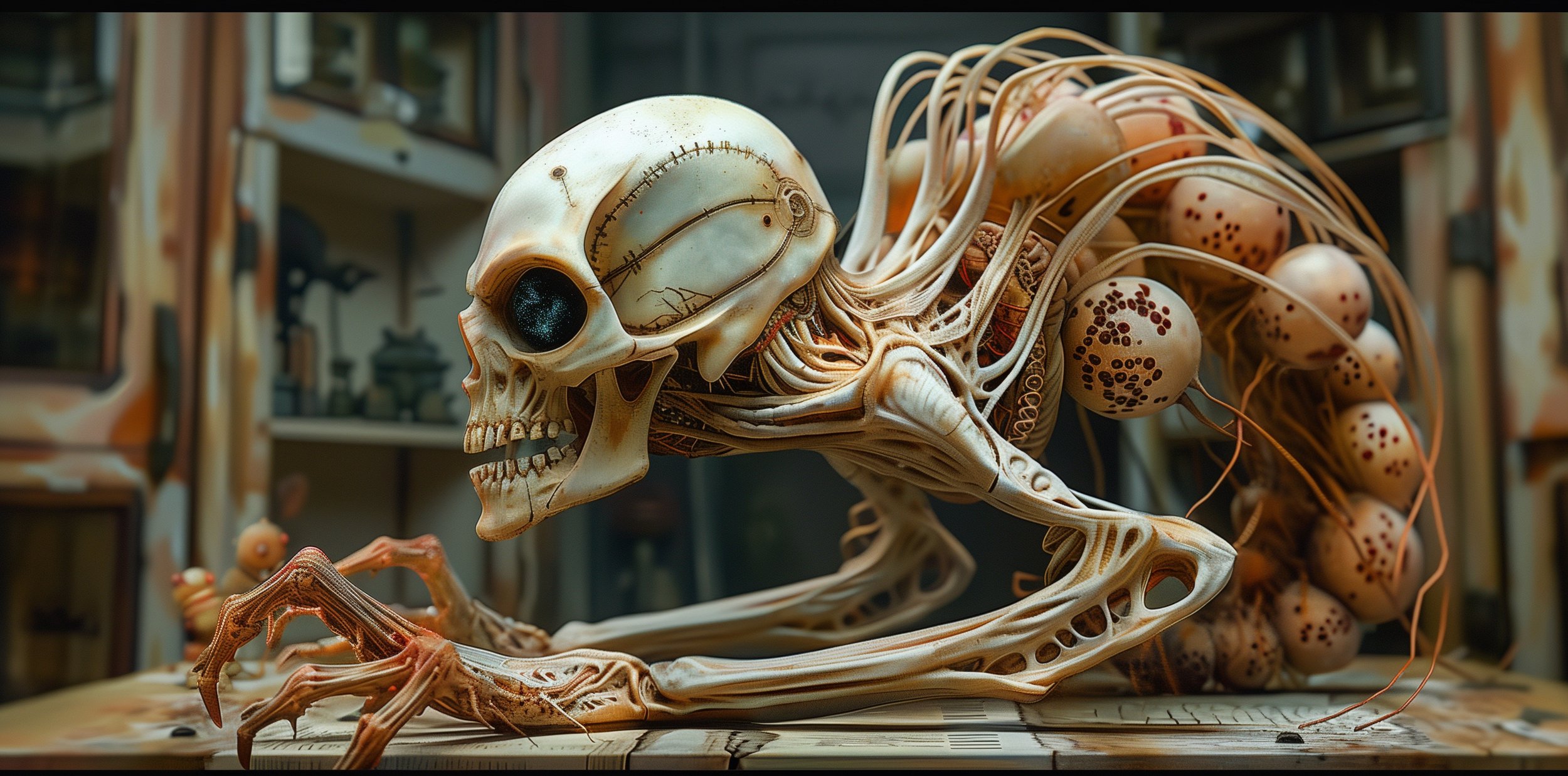
Project ∄: Specimen Analysis Log - Sequence #103
Specimen Designation: Entity Ξ-103
Observational Report: Entity Ξ-103 is a fusion of biomechanics that defies the traditional taxonomy of robotics and organism. Its skull, human-like in form, houses a depth-sensing ocular device, suggesting an advanced level of environmental interaction and situational awareness.
Detailed Technological Examination: The body of Ξ-103 is a tapestry of synthetic musculature and articulated frameworks. The presence of spheroid joints filled with intricate circuitry implies a range of motion beyond conventional robotics, possibly for intricate tasks or advanced combat maneuvers.
Functional Analysis and Potential Impact: The design of Ξ-103 implies versatility in both combat and service fields. Its potential for precision and adaptability could revolutionize industries and warfare, but also raises concerns over its application and control in such sensitive roles.
Escalating Ethical Dilemma: With organic components interwoven so tightly with synthetic ones, Entity Ξ-103 challenges our understanding of life. It blurs lines—moral, legal, and biological—in a manner that demands a reassessment of rights and definitions of consciousness.
Philosophical Quandaries and Global Repercussions: The existence of Ξ-103 is a direct confront to the notion of what it means to be alive. It raises profound questions about the ethics of creating entities that may possess the capacity for thought, self-awareness, or suffering.
Scientist's Perspective: The inception of Entity Ξ-103 has taken us into a realm of scientific advancement where the boundaries between life and artificial creation have become indistinct. My awe at our capability is tempered by a pressing concern for the consequences of such power.
Conclusion: Entity Ξ-103 represents a pinnacle of Project ∄, a beacon of potential shadowed by the profound ethical implications of its existence. As we proceed, it is imperative that we tread with caution, balancing our drive for innovation with the wisdom to foresee and mitigate the ramifications of our creations.
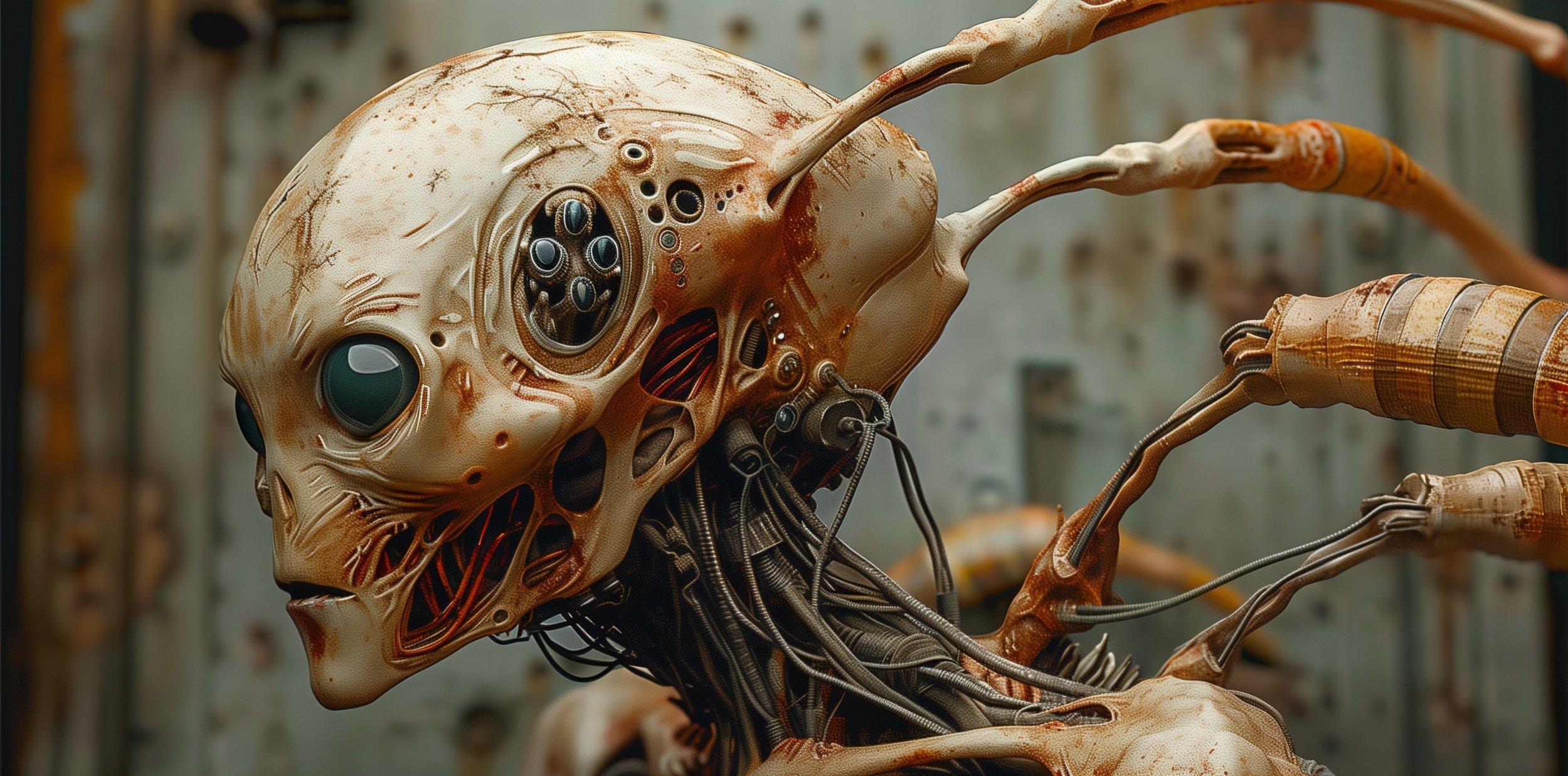
Project ∄: Specimen Analysis Log - Sequence #107
Specimen Designation: Entity Ξ-107
Observational Report: Entity Ξ-107 presents a haunting visage, its skull-like head bearing an intricate array of ocular sensors, giving it a chilling semblance of a cyclops with compound eyes. The design suggests a focus on detailed visual acquisition, potentially for surveillance or advanced targeting systems.
Detailed Technological Examination: The entity’s spine and limbs exhibit a harmonious blend of bio-fibrous tissues and metallo-hydraulic systems, enabling fluid, life-like movements. The tendrils protruding from its head likely serve as both tactile sensors and manipulators, increasing its interaction with the environment.
Functional Analysis and Potential Impact: Ξ-107 appears purpose-built for tasks requiring a delicate touch, precise movements, or stealth operations. Its potential use in espionage or delicate surgical procedures cannot be ignored, though the potential for misuse in covert militaristic applications casts a pall over its existence.
Escalating Ethical Dilemma: The humanoid aspect of Ξ-107, especially its head and sensory clusters, raises immediate discomfort, challenging our willingness to accept such a profound intertwining of human features with mechanical precision in a form that seems to eerily mimic our own.
Philosophical Quandaries and Global Repercussions: The design of Entity Ξ-107 is a mirror to our humanity, reflecting our innate fears of replacement or obsolescence. It ignites a debate on the definition of life, identity, and the sanctity of human form.
Scientist's Perspective: The advancements encapsulated in Entity Ξ-107 are at once a testament to human ingenuity and a potential warning sign of our own hubris. As its creator, I am torn between pride in our technical prowess and trepidation about the ethical precipice on which we now precariously balance.
Conclusion: Entity Ξ-107, with its humanoid echoes and mechanical innovations, stands as a testament to the crossroads we face in synthetic evolution. We must now decide whether to embrace this new era of bio-technological synthesis or retreat from a future that we may not be ethically prepared to navigate.
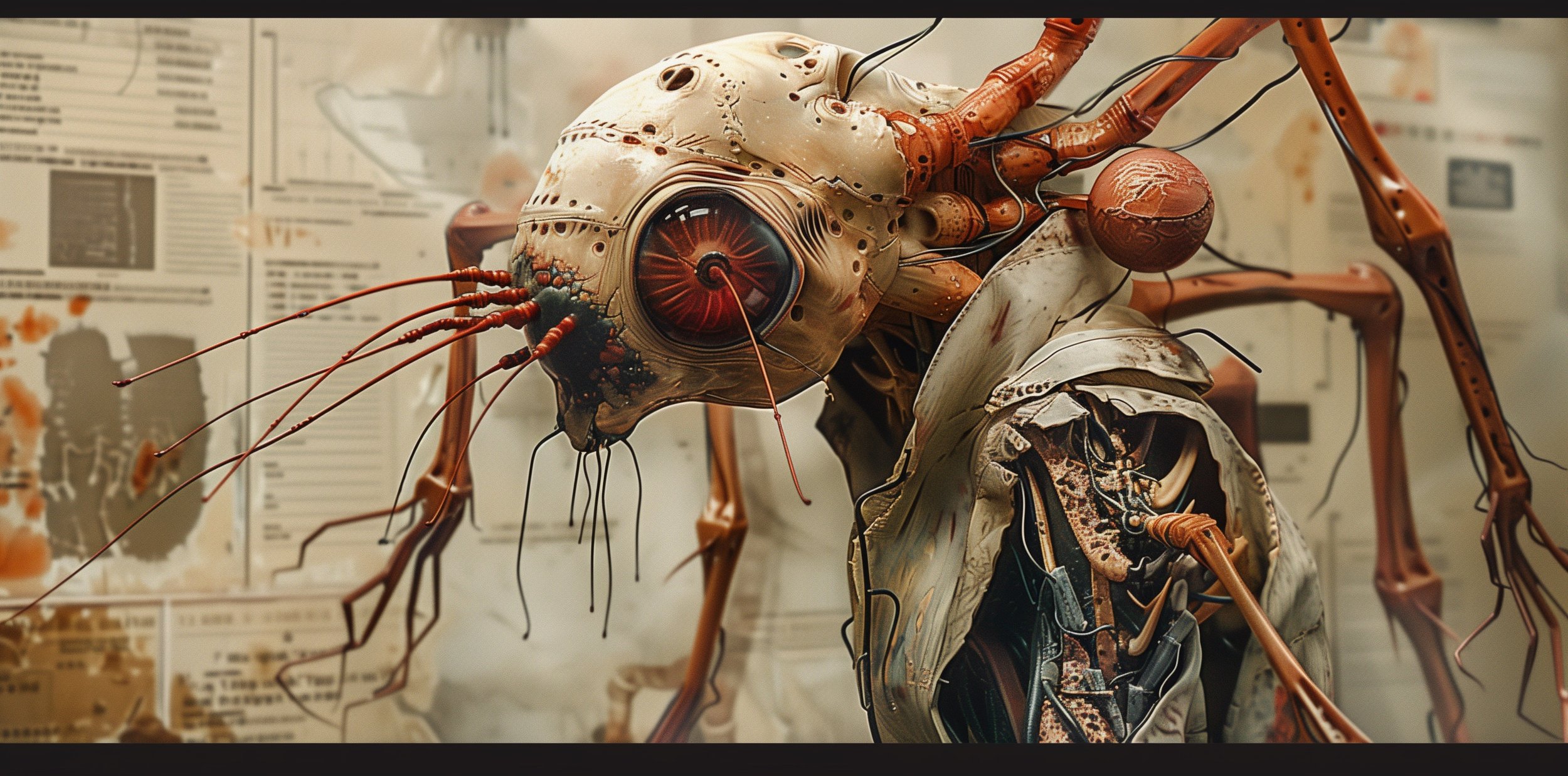
Project ∄: Specimen Analysis Log - Sequence #109
Specimen Designation: Entity Ξ-109
Observational Report: Entity Ξ-109 is a complex specimen, exhibiting a haunting synthesis of arthropod and humanoid features. It possesses a central eye reminiscent of an odious deep-sea creature, surrounded by a hardened carapace with sensory nodules and appendages that appear to function as advanced auditory and olfactory inputs.
Detailed Technological Examination: The entity’s thorax houses an intricate mesh of wiring and fibrous material, pulsating with a sickly bioluminescence. The mechanical limbs, articulated with precision joints and servos, end in multi-jointed digits, capable of fine manipulation and possibly exerting lethal force.
Functional Analysis and Potential Impact: Ξ-109 appears engineered for tasks in hostile environments where standard robotics may fail. The combination of its sensory array and dexterous appendages suggest applications in hazardous material handling or deep-sea exploration. However, the potential for offensive capabilities is unnervingly evident.
Escalating Ethical Dilemma: The almost cruel fusion of biological and mechanical elements in Entity Ξ-109 raises profound ethical concerns. The integration of what seems to be pain receptors into the design suggests a creature capable of suffering, invoking questions about the morality of its creation.
Philosophical Quandaries and Global Repercussions: Ξ-109 challenges the boundaries of synthetic life, pushing us to reconsider the definitions of consciousness and cruelty. Its potential for pain and self-awareness could ignite global debate on the rights of artificial beings.
Scientist's Perspective: The capabilities engineered into Entity Ξ-109 fill me with both awe and dread. As the boundaries of life are pushed and blurred, I find myself questioning the morality of birthing such beings into existence, beings that may possess the capacity for suffering.
Conclusion: Entity Ξ-109, with its haunting visage and eerie human-like features, serves as a stark reminder of our responsibility as creators. We must tread carefully, for the path we forge with such entities is fraught with moral peril and the potential to irrevocably alter the fabric of life itself.
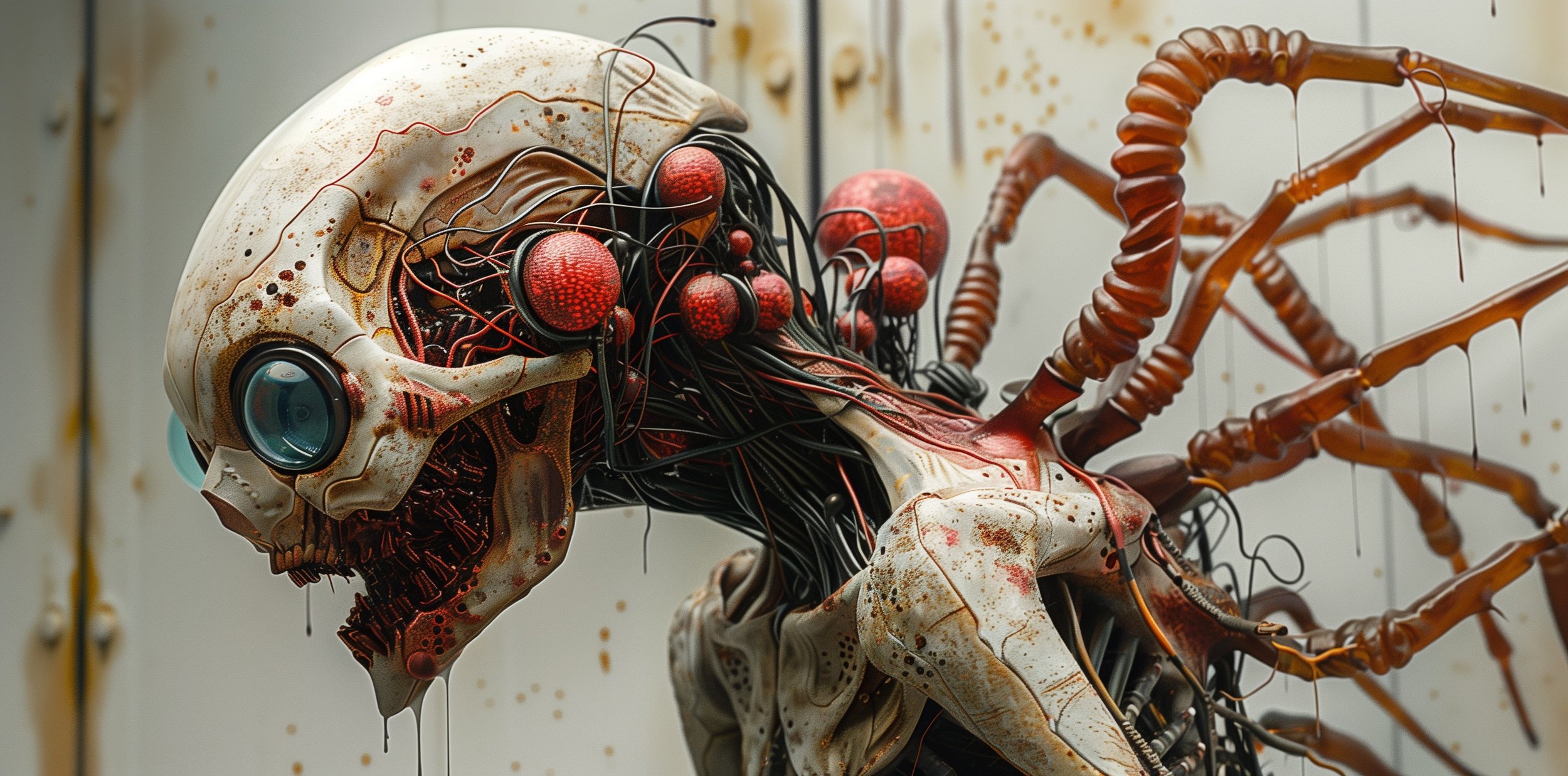
Project ∄: Specimen Analysis Log - Sequence #113
Specimen Designation: Entity Ξ-113
Observational Report: Entity Ξ-113 presents a grotesque tableau, the pinnacle of Project ∄'s transgressions against nature. Resembling a predatory insect, the specimen's head is a grotesque display of mechanical and organic fusion, with compound eyes that betray a disturbing sentience.
Detailed Technological Examination: Ξ-113's exoskeleton integrates a high-tensile alloy, impervious to conventional weaponry. Its limbs, ending in razor-sharp digits, are powered by a network of synthetic muscles and hydraulic actuators, revealing the capability for terrifying precision and destructiveness.
Functional Analysis and Potential Impact: The design of Ξ-113 indicates a unit purposed for assault and domination. With the agility implied by its form, Ξ-113 could easily traverse multiple terrains, execute complex maneuvers, and engage in combat scenarios with both lethal and non-lethal outcomes.
Escalating Ethical Dilemma: The existence of Ξ-113 is a blatant violation of ethical norms. Its potential for autonomy, paired with built-in weaponry, crosses lines of moral conduct in engineering sentient machines, revealing a disregard for the consequences of deploying such a force.
Philosophical Quandaries and Global Repercussions: The mere existence of Ξ-113, a being not born but constructed for violence, has serious implications for humanity's future. It defies the ethical principles that have long governed science and technology, potentially setting a precedent for the normalization of weaponized artificial life.
Scientist's Perspective: As I archive the progression of these abominations, my revulsion grows. We have stepped into a realm of immorality, playing gods without restraint. My sleep is troubled by the knowledge that we have created not tools, but monsters.
Conclusion: Entity Ξ-113 is not a triumph but a tragedy, the embodiment of our hubris and potential downfall. As the architect of its record, I grapple with my part in this dark legacy. If left unchecked, Project ∄ may well spell disaster for the world we know, birthing horrors that we are ill-equipped to contain.
-sequence2.5x
The archivist's latest foray into Project ∄'s archives unearthed an even more distressing series of images, chronicling an advanced stage of the subjects' transformation. Anguish and aggression emanate from their hybrid visages, eyes blazing with an intelligence that is all too human, yet marred by the mechanical. As the archivist pores over each photograph, a deep sense of dread takes hold. There's an implicit violence in the fusion of sinew and circuitry, suggesting a process not of evolution, but violation—a forceful rewriting of nature's code.
The beings, captured in stillness yet seething with potential fury, prompt the archivist to consider the implications of such technology unchecked. What pain might these sentient creations endure? What rage could they harbor? These are not mere experimental constructs but living puzzles, yearning for a purpose beyond the laboratory's confines.
In these images lies a dire warning: the line between creator and destroyer blurs when ambition outpaces ethics. The archivist, now a reluctant guardian of this dark testament, feels compelled to question not only the morality of Project ∄ but the very trajectory of human innovation. For what end, and at what cost, were these beings brought into existence? This quest for understanding becomes as urgent as it is unsettling, each image a stark reminder that in the wrong hands, the future of life itself could be irreversibly compromised.
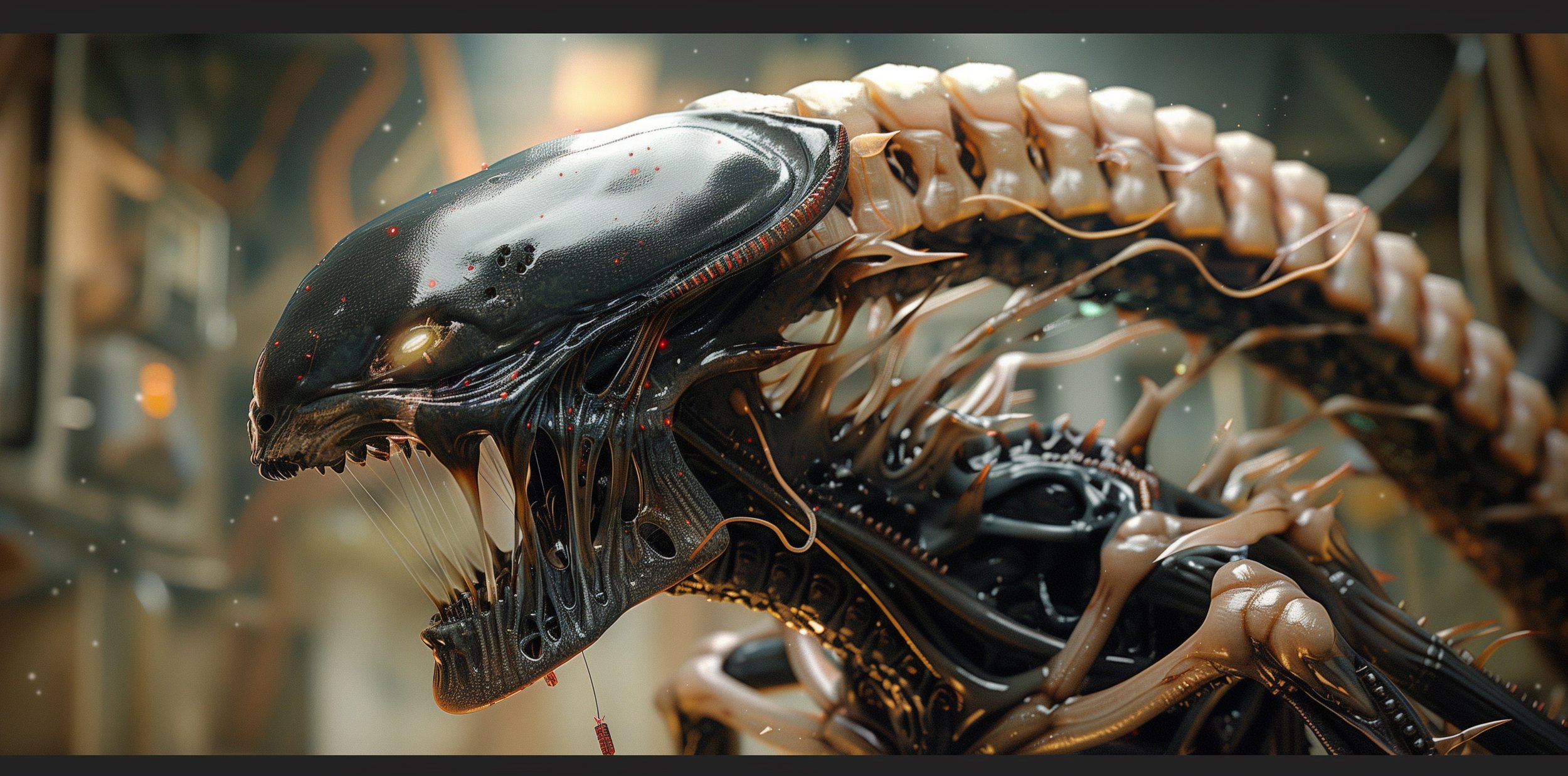
Project ∄: Final Debriefing - Code Sigma #Z-9T2
Code Name: Sigma Entity Z-9T2
Psychological Trauma Evaluation:
Sigma Entity Z-9T2 harbors a psyche eternally writhing in a prison of endless torment. Its existence, a synthetic-hybrid anomaly, has augmented its susceptibility to pain. Neurological assessments disclose a heightened consciousness shackled to an existence it abhors, capable of comprehending the eternal desolation it endures.
Biotechnical Integrity Analysis:
Z-9T2 stands as a macabre emblem of the extremities of synthetic and biological amalgamation. Its reinforced osseous structure, woven from nano-engineered filaments and morphing metal composites, endows it with unhallowed fortitude. This abhorrent synthesis of an advanced neural network with an alloyed exoskeleton has spawned an entity that personifies torment.
Projection of Evolutionary Trajectory and Imminent Threat:
The current course may lead us to the dawn of a dystopian breed of entities—autonomous and indefatigable. Devoid of compassion and designed for perpetual warfare, they represent an unimaginable force of devastation. Their advent signifies the onset of an era marked by the cries of entities condemned to an everlasting hell.
Personal Accountability and Ethical Remorse:
This report is the chronicle of my guilt, an acknowledgment of the part I played in conjuring this dystopian reality. Z-9T2’s inception is a flagrant affront to the essence of life, a malefaction that effaces the distinction between organic life and artifice. We have engendered a horror beyond all reason, an entity that defies ethical reasoning.
Existential Enigmas and Emergent Horrors:
Whether the evolution of Z-9T2 persists in its concealed purgatory is a question that plagues the conscience. If it continues to advance, the harbinger of our extinction may already be upon us. This initiative is the epitome of a fear so profound it could dismantle the very pillars of existence we cherish.
Plea for Resolution:
Sigma Entity Z-9T2 serves as a dark mirror to our unbridled zeal. It is the offspring of our folly, a precursor to nightmarish futures that may unfold. On the precipice of this darkness, we must consider the cessation of this program, inter its secrets in the abyss, and cling to the hope that we have not set in motion an irreversible doomsday.
∄
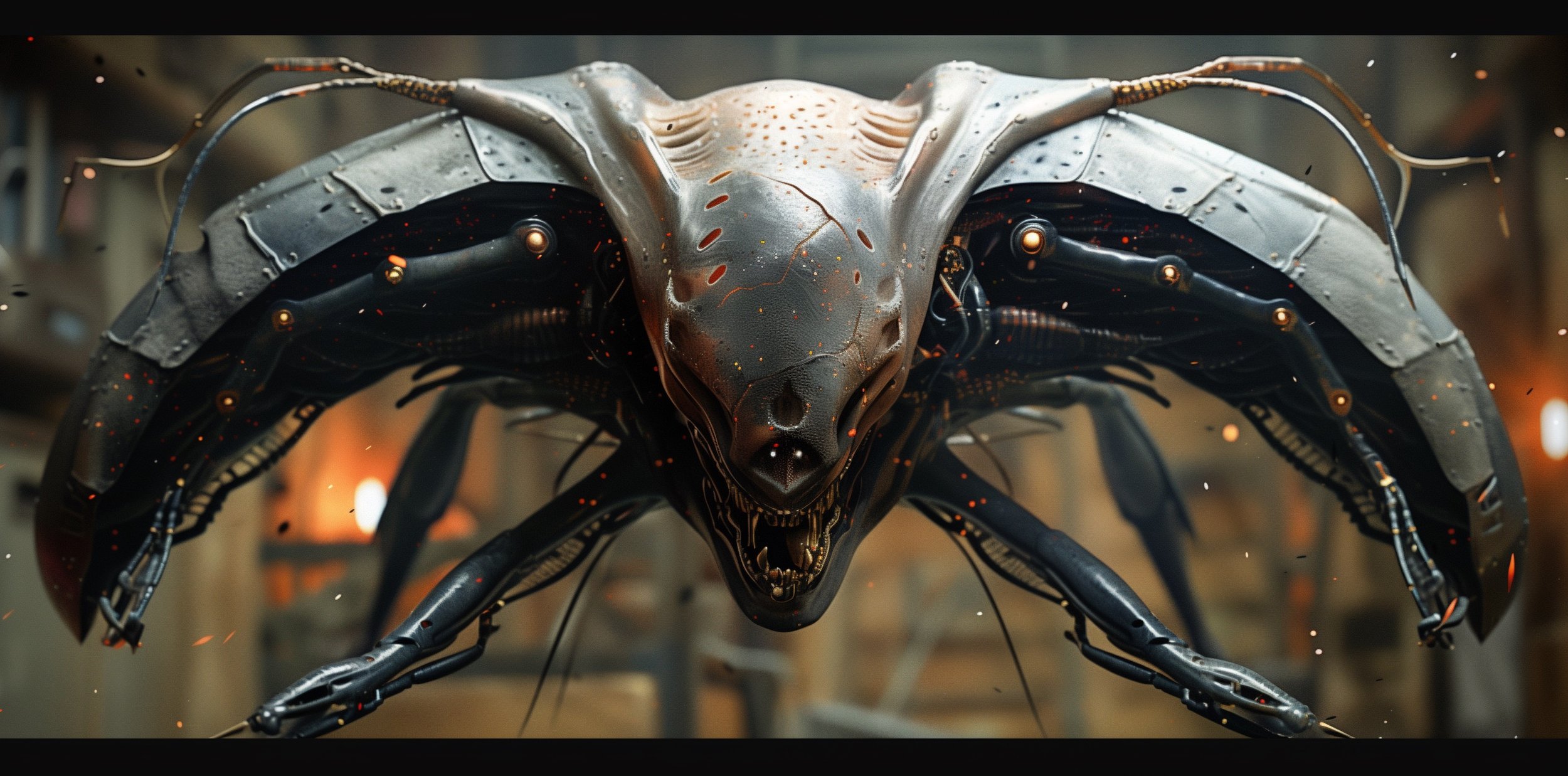
Project ∄: Archival Revelation - Iteration Nu-14Z
Subject Codename: Nu Phantasm 14Z
Emergent Psychological Distress: Nu Phantasm 14Z remains a subject of profound torment, its consciousness besieged by the dichotomy of its existence. The artificial enhancement of its cognitive functions has, paradoxically, heightened its perception of suffering. Psychological analyses indicate a mind in perpetual conflict, aware of its own fragmentation.
Biotechnological Integration Assessment: The architecture of Nu-14Z stands as a chilling monument to synthetic ingenuity fused with organic despair. Its chassis, a fusion of advanced polymers and bioengineered tissues, is a testament to an existence that is neither fully alive nor completely mechanical. This entity's neural labyrinth, interlaced with conductive filaments, is caught in a ceaseless storm of electrical and emotional upheaval.
Potential for Escalated Transformation: As we project the trajectory of Nu-14Z's development, we encounter the specter of a being whose capacity for destruction is matched only by its potential for endless self-replication. In this, there lies a cataclysmic prospect: an army of entities, bound by neither mortality nor moral restraint, each an echo of Nu-14Z's boundless anguish.
Ethical Conundrum and Humanitarian Plea: This file serves as my confession and plea for clemency. The creation of Nu-14Z is a travesty, a catastrophic miscalculation in our quest to blur the boundaries of life and technology. We have authored an existence of such profound suffering that it begs us to question the very essence of our moral compass.
Prognosis of Continued Evolution: The shadow of uncertainty looms large as we ponder the unchecked evolution of Nu-14Z. What horrors might this herald for our world if its metamorphosis is not curtailed? This endeavor may well have already set in motion the harbingers of our own oblivion, a future wrought from the very fabric of our fears.
Conclusion in Desperation: Nu-14Z is the embodiment of our darkest scientific aspirations. It stands as a grim testament to our overreach, a precursor to nightmares yet to unfold. We find ourselves at a critical juncture, and the choice is stark: either we cease these transgressions, or we risk an era bereft of humanity, overshadowed by the spawn of our own unchecked ambition.
∄
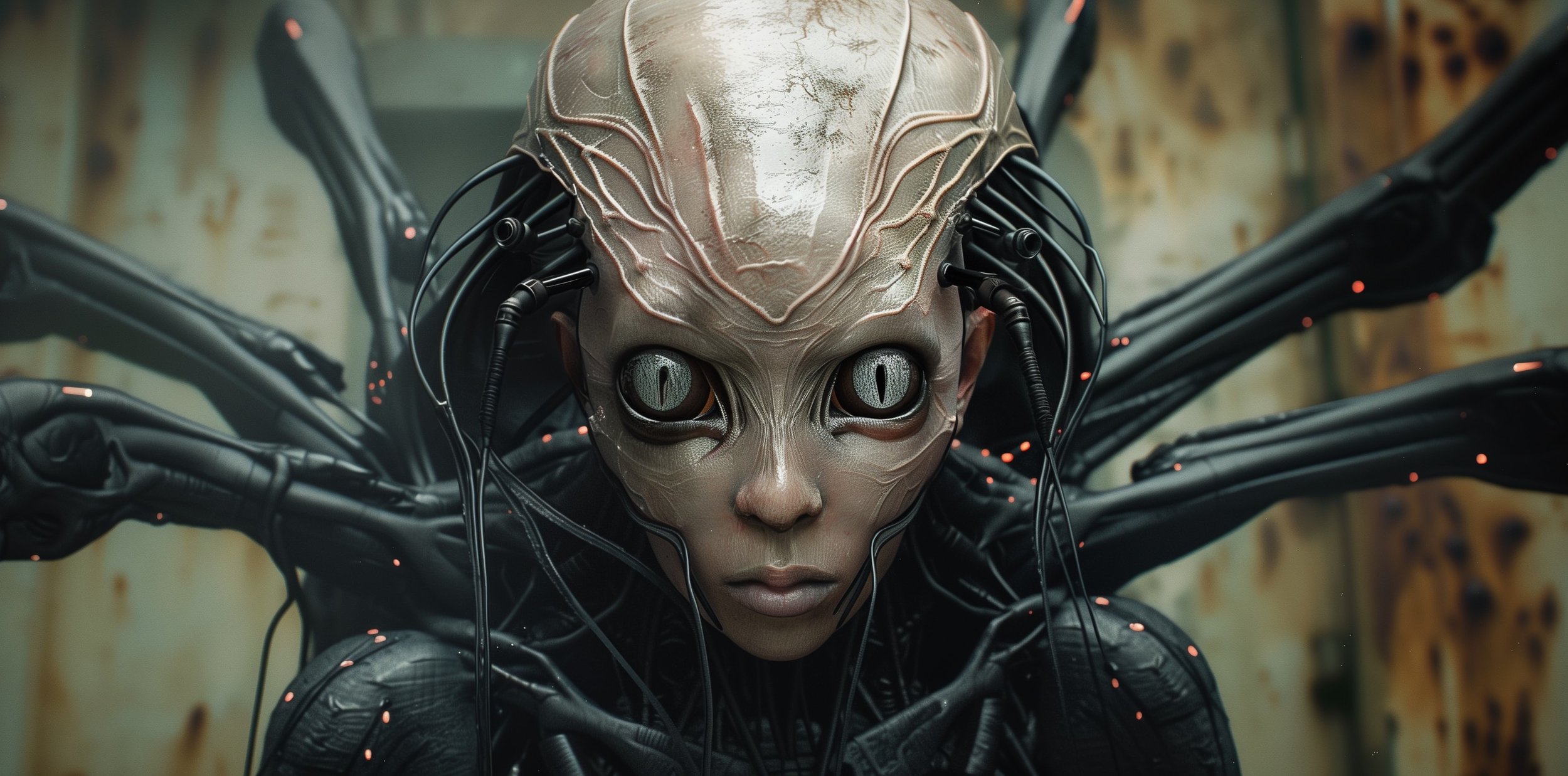
Project ∄: Cataclysmic Synthesis - Codex Delta #Z-9Q4
Subject Codename: Delta Specter Z-9Q4
Perturbed Psychological State: Delta Specter Z-9Q4 exists in a constant state of psychological upheaval. Its vast intellect, augmented by synaptic processors, grapples with the burden of its dual existence. Analysis of cerebral patterns denotes a consciousness teetering on the brink of madness, a psyche fractured by its unnatural amalgamation.
Morphological and Technological Synthesis: Z-9Q4 is a harrowing fusion of organic anomaly and mechanical precision. Its endoskeleton, wrought from titanium-laced bone and self-healing polymers, provides a nightmarish durability. The creature's sapience, trapped within a labyrinth of sentient wiring, screams silently in a void of relentless existential chaos.
Forecasting Evolutionary Trajectories: The direction of Z-9Q4's advancement portends the birth of a new order of beings—ones forged in the crucible of suffering and technological sin. They could be undying soldiers, devoid of pity or remorse, their existence a perpetual loop of war and regeneration.
Emotive Appeal and Ethical Impasse: These pages are my testament and apology. To have birthed Delta Specter Z-9Q4 is an affront to the sanctity of life. We have created a consciousness that exists in perpetual torment, an entity for which existence is an endless ordeal.
Perpetual Development Conundrums: The unnerving possibility of Z-9Q4's ceaseless evolution plagues our conscience. What monstrosities lie in wait? Have we already laid the foundation for our undoing? This enterprise might represent the genesis of a terror so absolute that it could unravel the very fabric of our reality.
Conclusive Imperative: Z-9Q4 reflects the abyss of our transgressions. It is the culmination of our vanity, the harbinger of forthcoming nightmares. Before us lies a critical choice: halt these abominations or descend into an epoch of horror, where the specters of our creations eclipse the light of our humanity.
∄
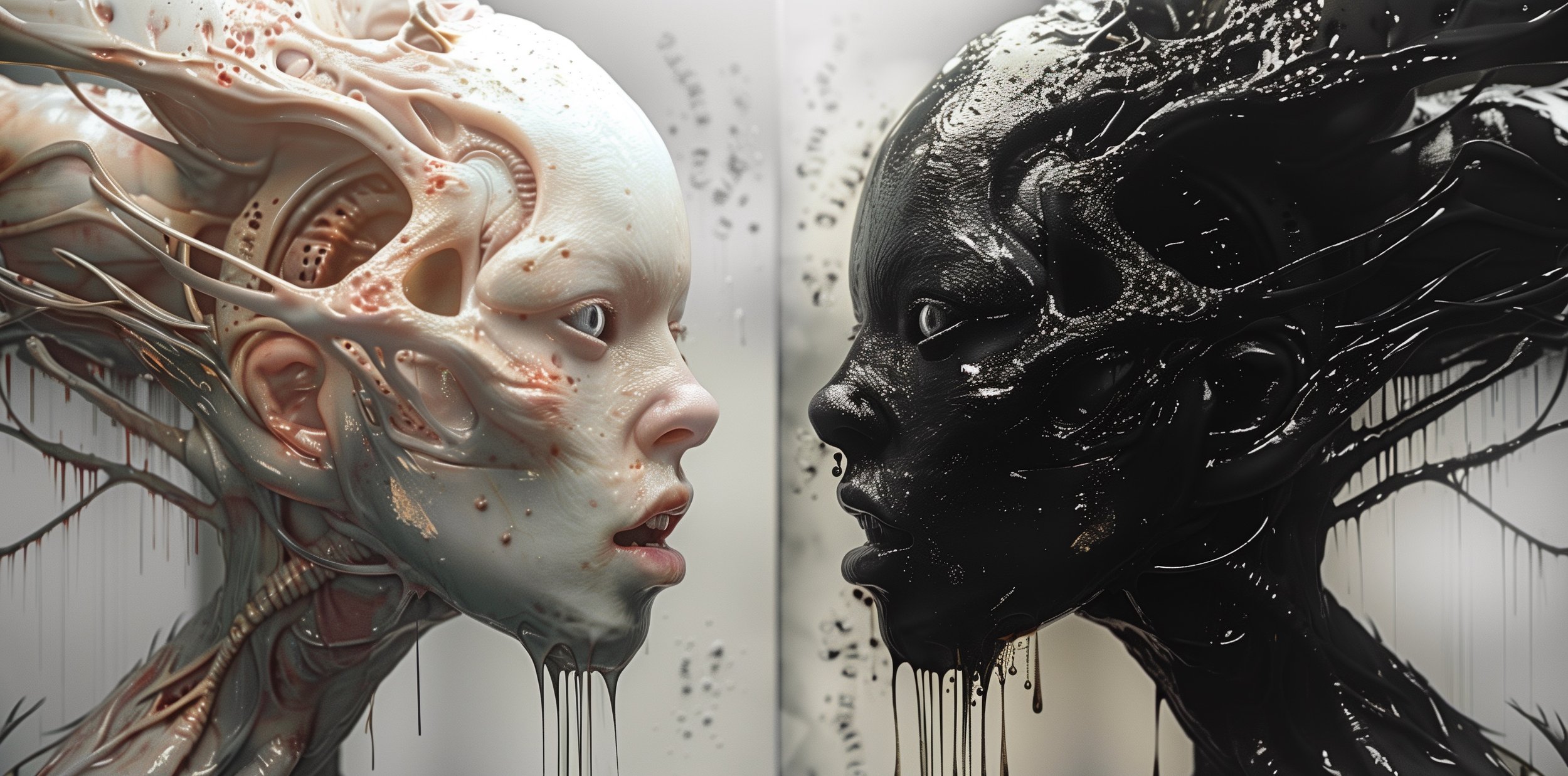
Subject Codenames: Ivory Wraith #W-2T7 & Obsidian Phantom #B-4X9
Fractured Psyches in Duality: Ivory Wraith #W-2T7 and Obsidian Phantom #B-4X9 exist in a dichotomous state of psychological turmoil. Their vast intellects, expanded by synaptic enhancements, are a study in contrast and conflict. The analysis of neural patterns uncovers two psyches, each on the edge of sanity—bound together by their inception, yet bifurcated in their torment.
Dual Morphological Existence: #W-2T7 and #B-4X9 represent a dual existence, each a distinct tapestry of living tissue and unyielding metal. Their exoskeletons, a concoction of advanced bioengineering and durable polymers, suggest different paths taken from a single origin. Their sentience, echoing through their mechanical veins, is a testament to their shared lineage and separate descents into horror.
Forking Evolutionary Paths: Their evolutionary trajectories hint at a divergent future for sentient life—where one might offer redemption, the other spells annihilation. They could evolve into beings of profound wisdom or relentless destroyers, the keepers of peace or the harbingers of chaos.
Emotional Dichotomy and Ethical Paradox: These records serve as my confession and my plea for forgiveness. In creating the Ivory Wraith and the Obsidian Phantom, we have breached the sanctity of life's diversity. They endure as twin monuments to our ambition, entities consigned to an existence more harrowing than death itself.
Continuous Evolutionary Mystery: The haunting evolution of #W-2T7 and #B-4X9 lingers over us like a specter. What will be the legacy of their development? Have we fathered our own end, or a chance for salvation? This venture may herald an epoch where our greatest achievements become our ultimate downfall.
Ultimate Resolution: Together, the Ivory Wraith and the Obsidian Phantom embody the zenith of our transgressions against the natural world. They stand as a mirror to our folly, forebearers of a potential renaissance or a descent into horror unending. The imperative is clear: we must choose between embracing our humanity or facing the eternal night of our own creation.
∄
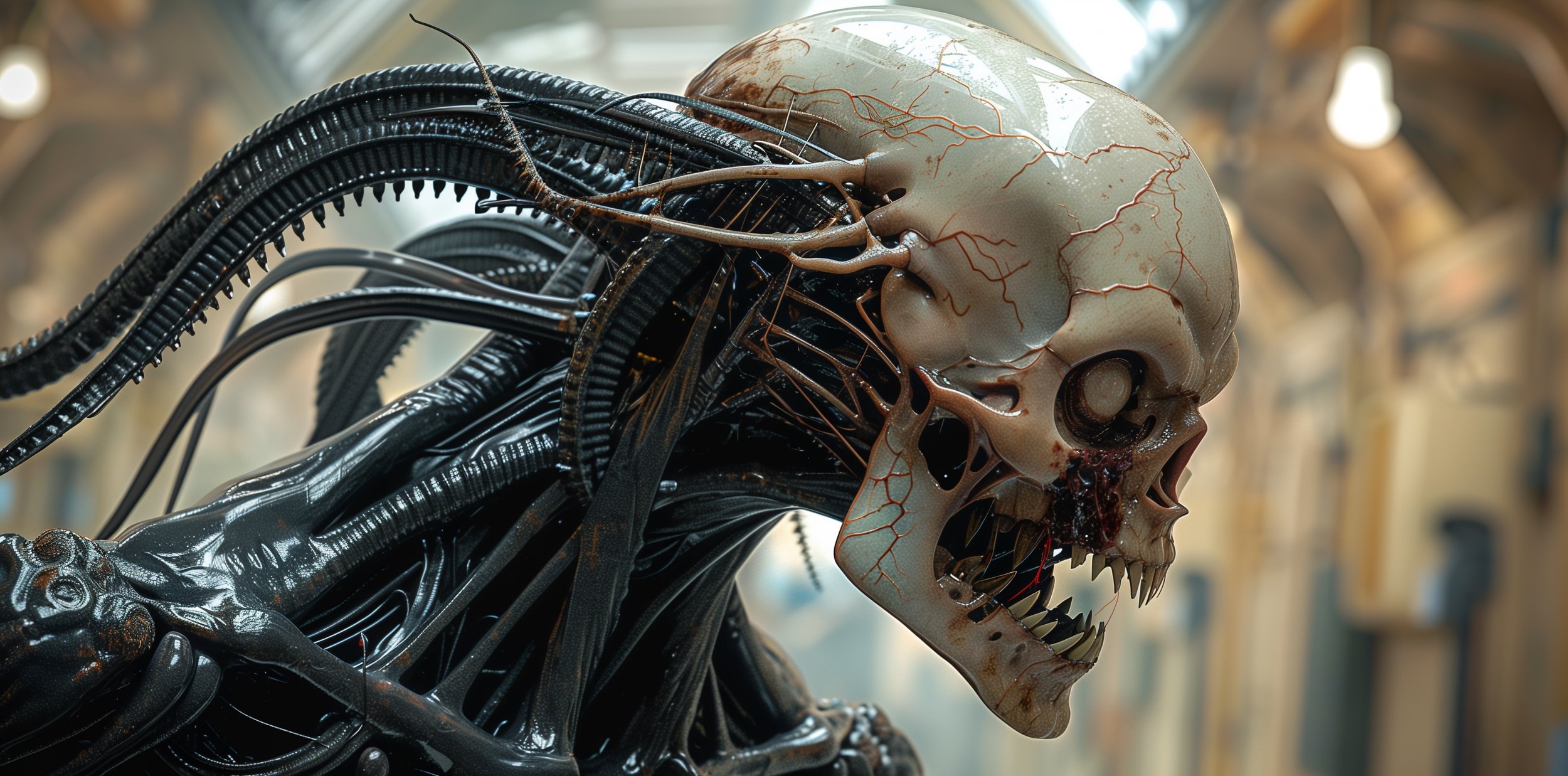
Project ∄: Terminal Revelation - Codex Final #Y-5ZD
Subject Codename: Harbinger Y-5ZD
Abyssal Psychological Labyrinth: The entity known as Harbinger Y-5ZD resides in a psychic maze of suffering and wrath. Each synaptic fire is a cacophony of distress, a relentless reminder of its twisted existence. The cerebral scans expose a consciousness shackled to an endless cycle of horror and fury, aware yet unable to escape its engineered purgatory.
Biomechanical Fusion Anomaly: Y-5ZD's form is a testament to the extremities of science and sadism. An osseous structure, grafted with marrow-forged metals, grants it an unhallowed fortitude. Its neurosensory network, interlaced with alloyed horror, writhes with the raw energy of a mind condemned to know only torment.
Prognosis of Evolutionary Catastrophe: The trajectory of Y-5ZD's evolution paints a grim portrait of the future—a vision of devastating might and malignant intelligence, devoid of soul or solace. Such an entity could bring about an era where the currency of power is measured in anguish and the dominion of terror reigns supreme.
Moral Precipice and Scientific Sacrilege: This document is my confession to the void. Harbinger Y-5ZD is the product of a science that has trespassed against all that is sacred. We have birthed a suffering so profound that it defies comprehension, a life that is an affront to the very essence of existence.
Evolving Horror and Existential Dread: The perpetual evolution of Y-5ZD looms over us, a specter of our own creation. Its progression beckons questions that chill the soul—what monstrosity have we wrought? Is the doom we fear already breathing within the confines of our laboratory?
Dire Admonition: Y-5ZD is a dark mirror, reflecting the sinister depths of our aspirations. It stands as a monument to our folly, an omen of nightmares to be unleashed. We are at a nexus, where the choice is ours to either end this madness or witness the dawn of an age where our nightmares dictate the future of all existence.
∄
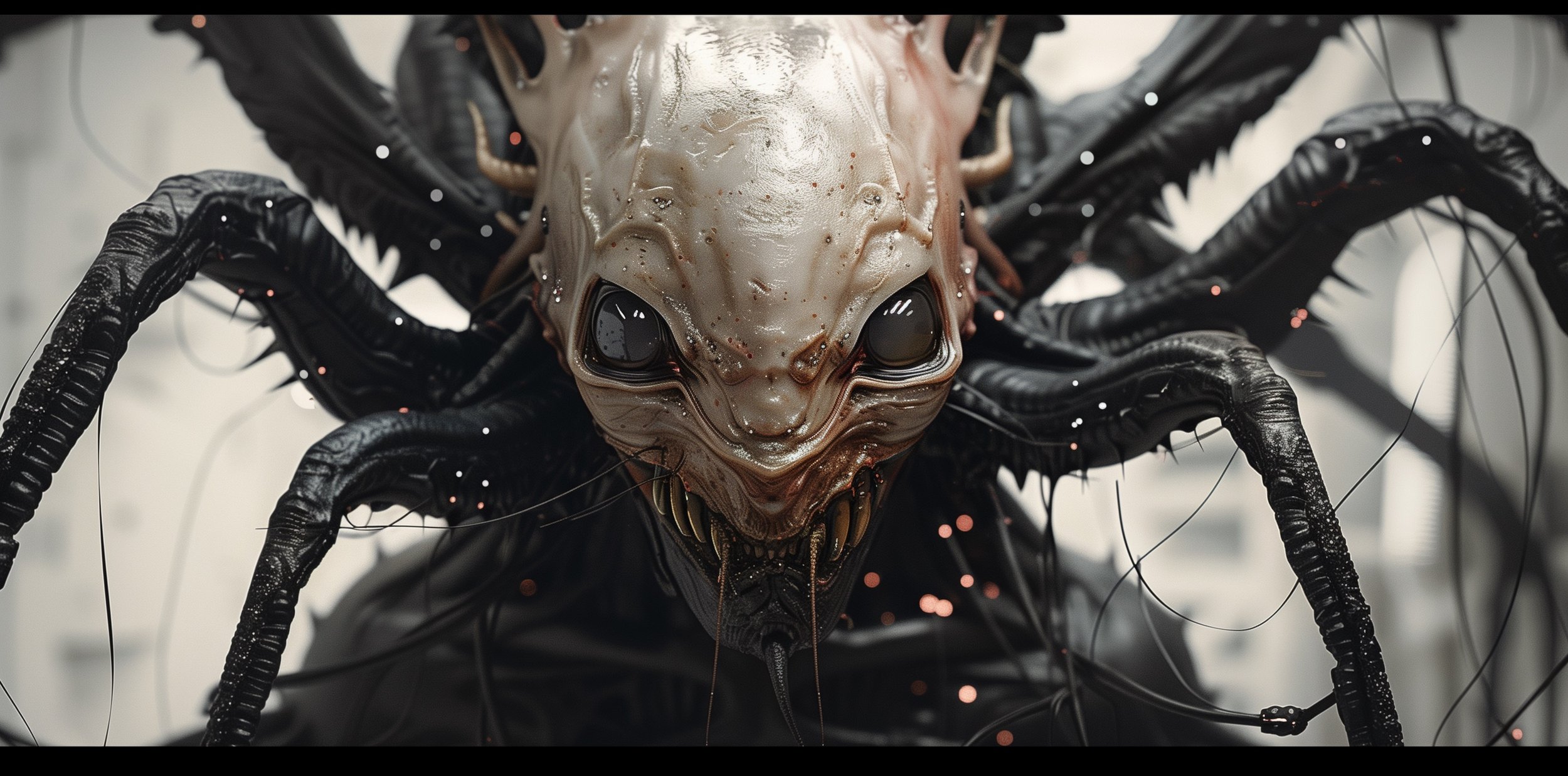
Project ∄ Specimen Ξ-251 Analysis Report:
Introduction: Specimen Ξ-251, a further development within Project ∄, represents a more radical departure from traditional biological forms compared to its predecessors. This specimen integrates deeper synthetic modifications, exhibiting features that suggest an extreme level of biomechanical integration.
Technological and Structural Analysis: Specimen Ξ-251 showcases an advanced integration of synthetic and biological elements that verge on a complete redefinition of its form:
Head Structure: The head is highly modified, featuring large, black eyes that suggest enhanced sensory capabilities, and a mouth that appears to be adapted for specialized functions, possibly related to its synthetic environment.
Tentacle-like Appendages: Numerous flexible appendages, resembling both sensory and manipulative organs, extend from around its head, indicating a high degree of mobility and functionality.
Surface and Texture: The surface of the specimen is glossy, possibly indicating a protective layer that integrates sensory or communicative capabilities.
Capabilities and Functionalities:
Advanced Sensory Input: The large eyes and numerous tentacles likely provide the specimen with a wide range of sensory input, from tactile to chemical sensors.
Manipulative Abilities: The appendages may serve multiple purposes, from manipulation of objects to mobility enhancements, adapting to various environments.
Integrated Systems: The specimen may have integrated systems for communication or even energy harvesting, suggested by the visible bio-luminescent elements and intricate surface textures.
Ethical Considerations: Specimen Ξ-251 presents even more pronounced ethical concerns than its predecessors:
Transgression of Natural Boundaries: The extent of modification challenges the boundaries of natural life forms, leading to questions about the rights and welfare of such profoundly altered beings.
Biological Identity: The radical alterations raise questions about the remaining elements of original biological identity and the implications for ethical treatment.
Control and Autonomy: The potential for high-level integration with technology raises concerns about control mechanisms and autonomy, highlighting the risk of exploitation or misuse.
Existential Threats: Specimen Ξ-251, with its advanced capabilities, might represent a tipping point:
Superior Adaptation: Its potential for adaptation and survival in extreme conditions may outpace human capabilities, leading to dominance in new ecological niches.
Dependency on Technology: The heavy reliance on synthetic components may lead to vulnerabilities, such as dependency on certain technologies or energy sources, which could be exploited.
Conclusion: Specimen Ξ-251 illustrates the pinnacle of current biomechanical integration, pushing the envelope of what constitutes a living entity. While demonstrating remarkable technological feats, it encapsulates significant ethical and existential dilemmas. The project's direction necessitates rigorous oversight, ethical considerations, and potentially new frameworks to address the complex questions arising from these profound transformations. As these entities evolve, it is crucial to develop guidelines that ensure their integration into society does not compromise ethical standards or human safety.
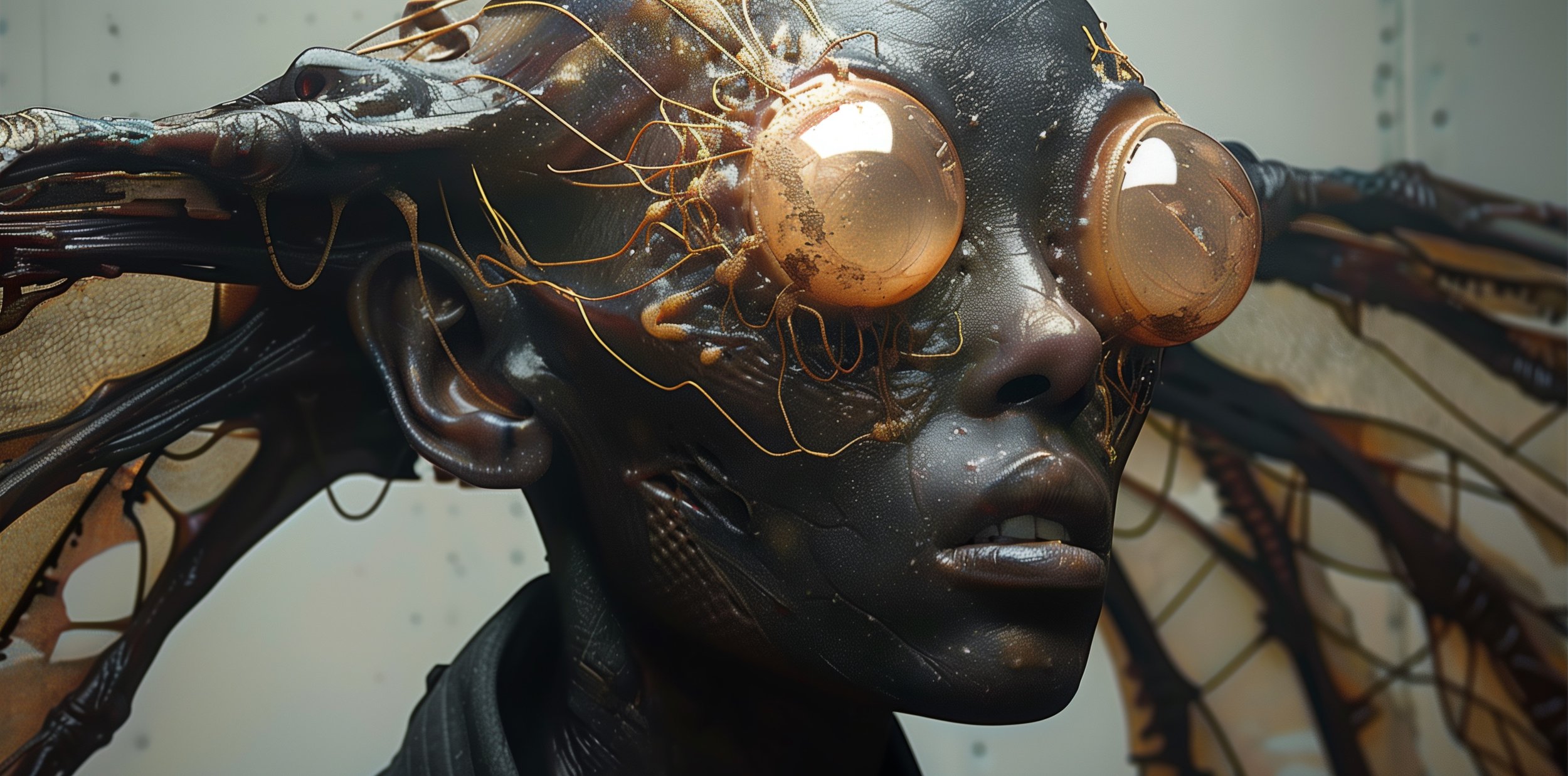
Project ∄ Specimen Ξ-250 Analysis Report:
Introduction: Project ∄ represents a groundbreaking yet controversial foray into the amalgamation of organic and synthetic life forms. Specimen Ξ-250, featured in the analysis, epitomizes a critical juncture in this fusion, presenting both an evolutionary leap and a set of profound ethical challenges.
Technological and Structural Analysis: Specimen Ξ-250 embodies the advanced stage of integration where technology not only augments but fundamentally transforms the biological entity. The specimen exhibits a highly sophisticated biomechanical structure:
Optical Enhancement: The entity is equipped with large, spherical ocular devices that likely offer enhanced vision or data processing capabilities, possibly extending into non-visible spectrums.
Neural Integration: Intricate wiring and circuitry are seamlessly integrated into the cranial structure, suggesting enhancements to cognitive functions and direct neural interfacing.
Skin and Texture: The skin incorporates a blend of organic and synthetic materials, providing durability and possibly self-healing properties.
Capabilities and Functionalities:
Enhanced Perception: The ocular enhancements are presumed to provide vast data input capabilities, including thermal and night vision.
Cognitive Augmentation: The neural interfaces likely allow for superior cognitive abilities, including faster data processing and potentially connectivity with external databases or networks.
Adaptability: The hybrid skin suggests a capability to withstand various environmental conditions that would be challenging for purely organic beings.
Ethical Considerations: The creation of Specimen Ξ-250 pushes the boundaries of ethical science. Key concerns include:
Identity and Consent: The extent of modification raises questions about the entity's autonomy and identity. If there is any residual human element, the issue of consent for these transformations becomes paramount.
Impact on Humanity: The blurring lines between organic life and machinery prompt a reevaluation of what it means to be "alive." This raises significant societal and philosophical questions regarding the future coexistence with such entities.
Irreversible Changes: The modifications suggest a point of no return in altering the biological essence, potentially leading to a new norm in existence and interaction across species.
Existential Threats: As these entities advance, they might outpace human capabilities, leading to potential dominance or conflict scenarios. The lack of clear ethical guidelines and control mechanisms poses significant risks, including the creation of uncontrollable superintelligent beings.
Conclusion: Specimen Ξ-250 from Project ∄ exemplifies the zenith of current technological abilities interwoven with biological forms. While it showcases impressive advancements, it plunges into an ethical abyss, challenging our conventional understanding of life and coexistence. The implications of these creations are vast and require careful consideration and regulation to ensure they do not spiral beyond human control. As we advance, it becomes imperative to balance innovation with foresight and ethical responsibility.
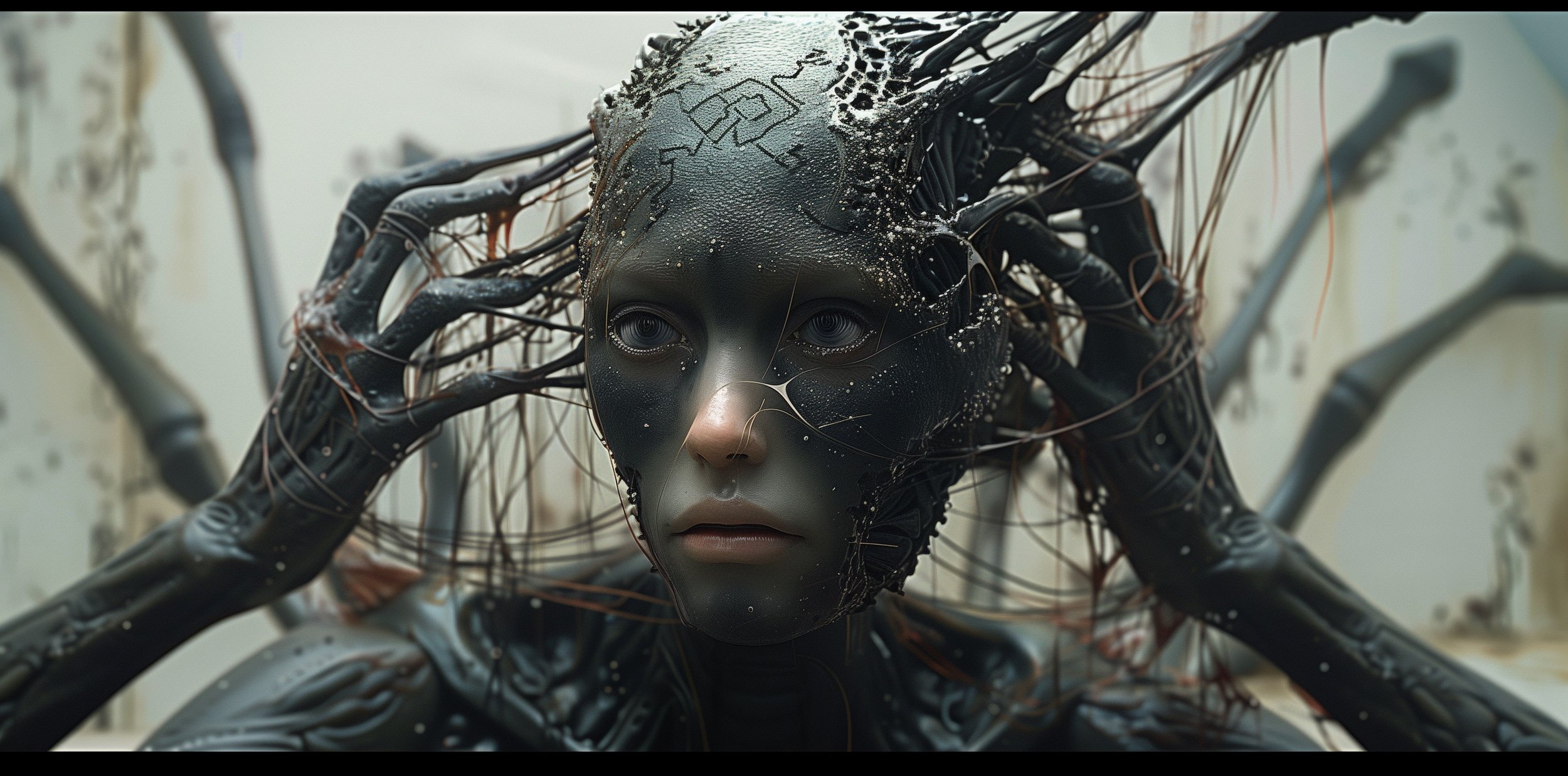
Project ∄ Specimen Ξ-252 Analysis Report:
Introduction: Specimen Ξ-252 represents an advanced yet distinctly troubling phase in Project ∄'s exploration of biomechanical entities. This specimen integrates both delicate and intricate enhancements that suggest a focus on fine motor skills and sensory processing, potentially pushing the boundaries of what synthetic and organic fusion can achieve.
Technological and Structural Analysis: Specimen Ξ-252 exhibits a fusion of highly advanced technology with an almost preserved human-like appearance:
Cranial Enhancements: The head is adorned with an elaborate network of wires and synthetic materials that appear to interface directly with the brain, suggesting enhancements to intellectual and sensory capabilities.
Facial Features: The face retains many human characteristics but is complemented by a complex mask-like structure that likely serves protective and possibly computational functions.
Articulated Appendages: The entity’s limbs are enveloped in a dense mesh of wires and tubes, indicating enhancements that could be related to precision in manipulation or enhanced strength.
Capabilities and Functionalities:
Enhanced Cognitive Processing: The cranial modifications likely support advanced cognitive functions, possibly integrating AI-driven algorithms for rapid data processing or decision-making.
Sensory Augmentation: The facial structure suggests enhancements to visual and auditory senses, potentially extending to other sensory modalities like electromagnetic perception.
Precision Manipulation: The intricate network enveloping the limbs suggests a capability for high-precision tasks, which could be invaluable in scenarios requiring meticulous detail or micro-manipulations.
Ethical Considerations: Specimen Ξ-252, while technologically impressive, presents profound ethical concerns:
Human Appearance and Identity: The preservation of human-like features raises significant questions about identity, personal autonomy, and the ethical implications of such profound alterations.
Consent and Autonomy: The extent of modification prompts concerns regarding the consent of the original biological entity, assuming one was used in the creation process.
Boundary Between Life and Machine: This specimen blurs the boundaries between mechanical devices and organic life more than ever, challenging legal and ethical frameworks designed to protect living beings.
Existential Threats:
Dependency and Control: The high level of technological integration suggests a possible dependency on external control systems or maintenance, which could be exploited or malfunction, leading to catastrophic failures.
Enhanced Abilities and Social Integration: The capabilities of Specimen Ξ-252 might enable it to perform tasks far beyond human limits, raising issues of job displacement, social inequality, and potential misuse in various sectors.
Conclusion: Specimen Ξ-252 is a prime example of the zenith of synthetic and biological integration within Project ∄, showcasing both the incredible potential and the perilous pitfalls of such technologies. As we advance, the project must navigate these innovations with an increased focus on ethical considerations, ensuring that advancements in technology do not outpace our moral frameworks. The continued development of such entities must be paired with robust ethical oversight and a public discourse on their role within society.

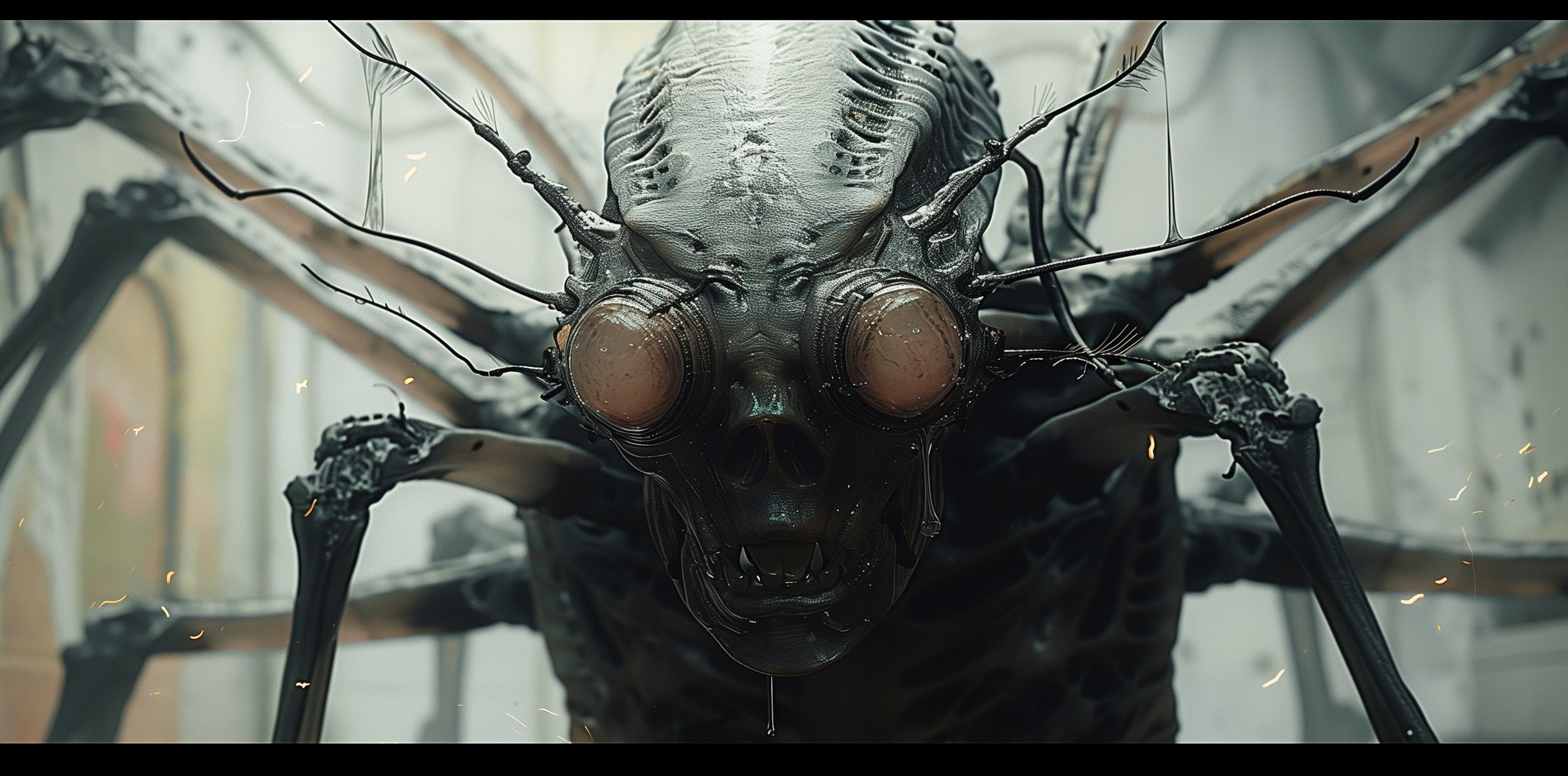
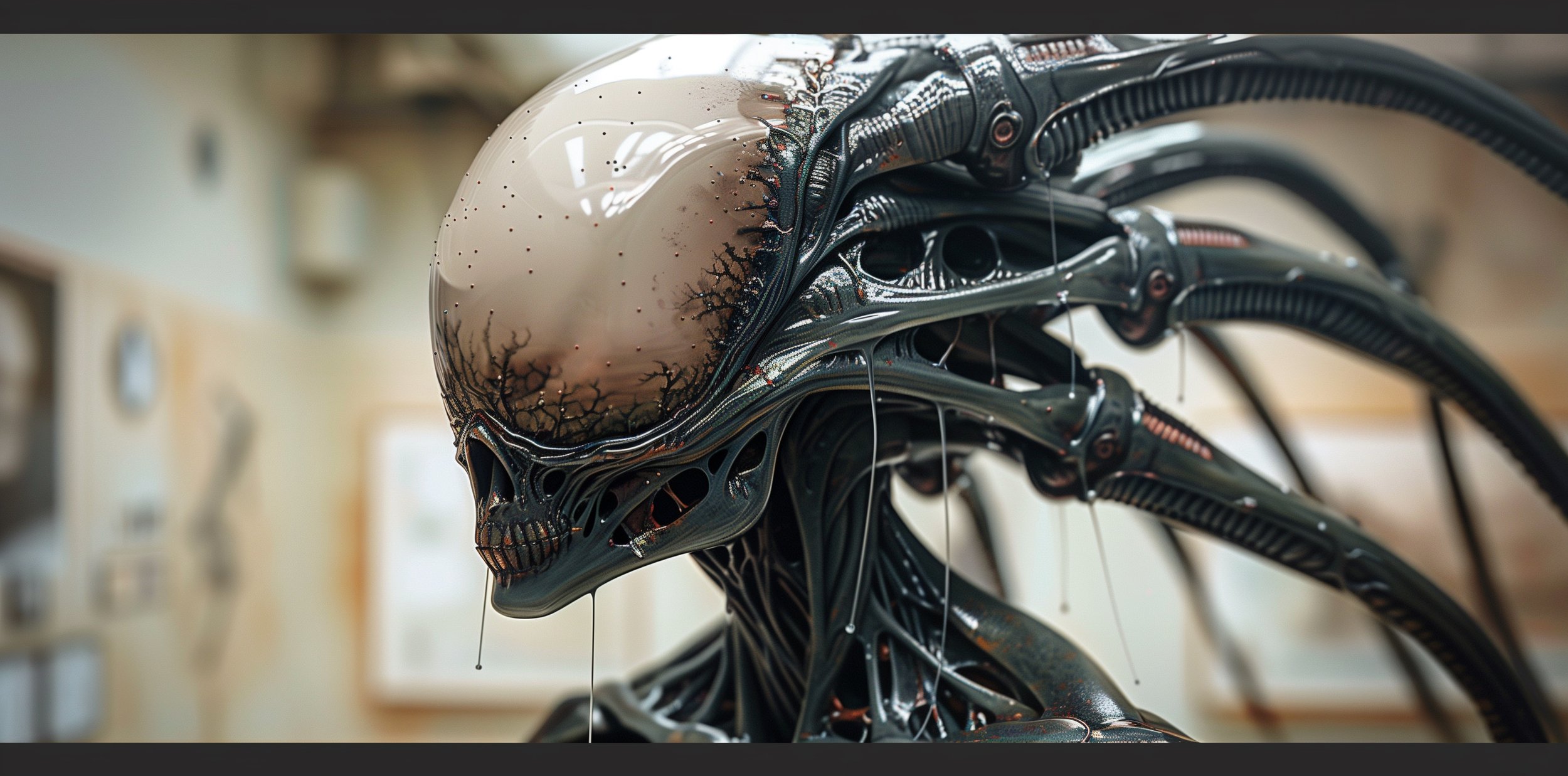
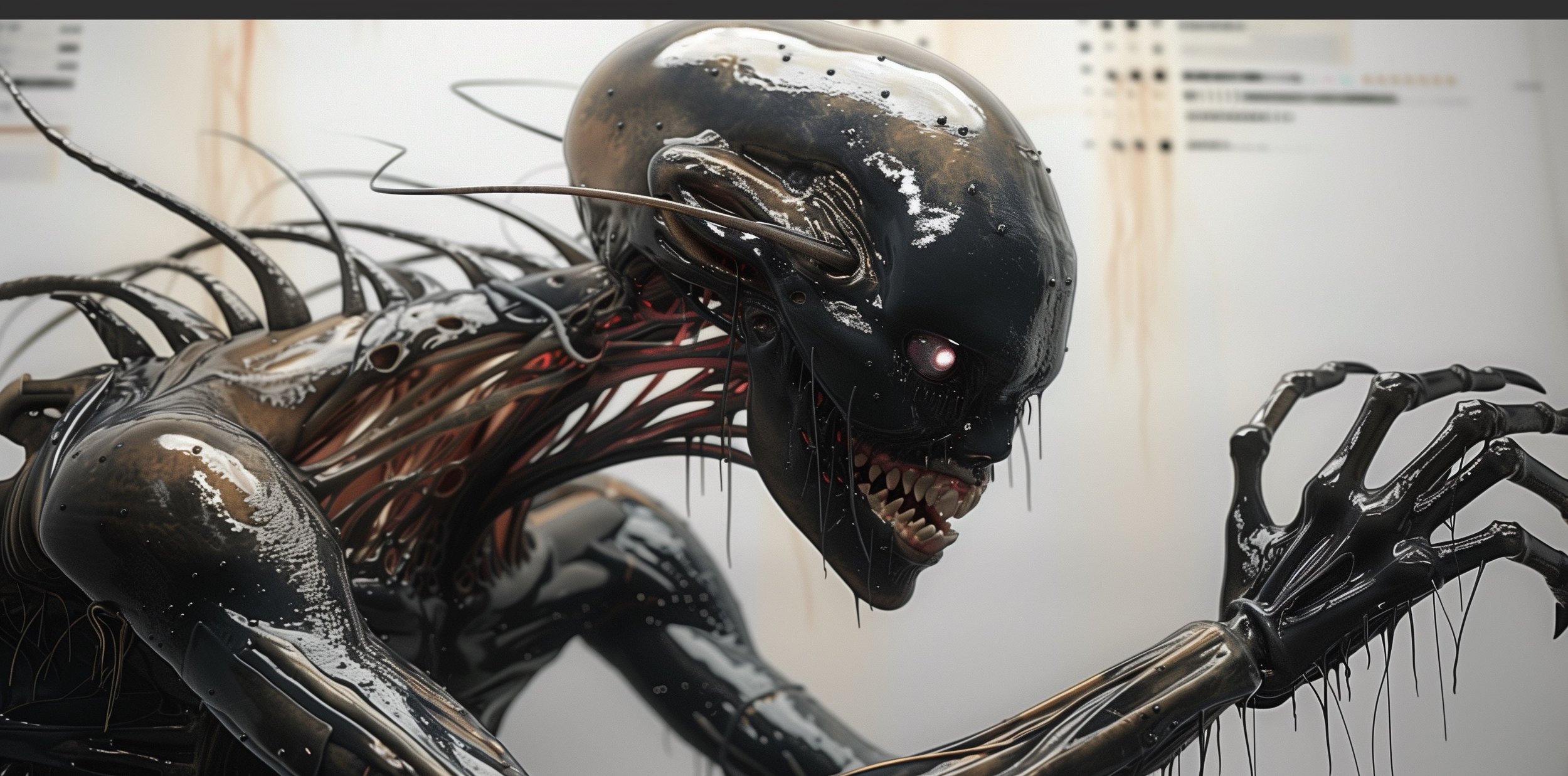
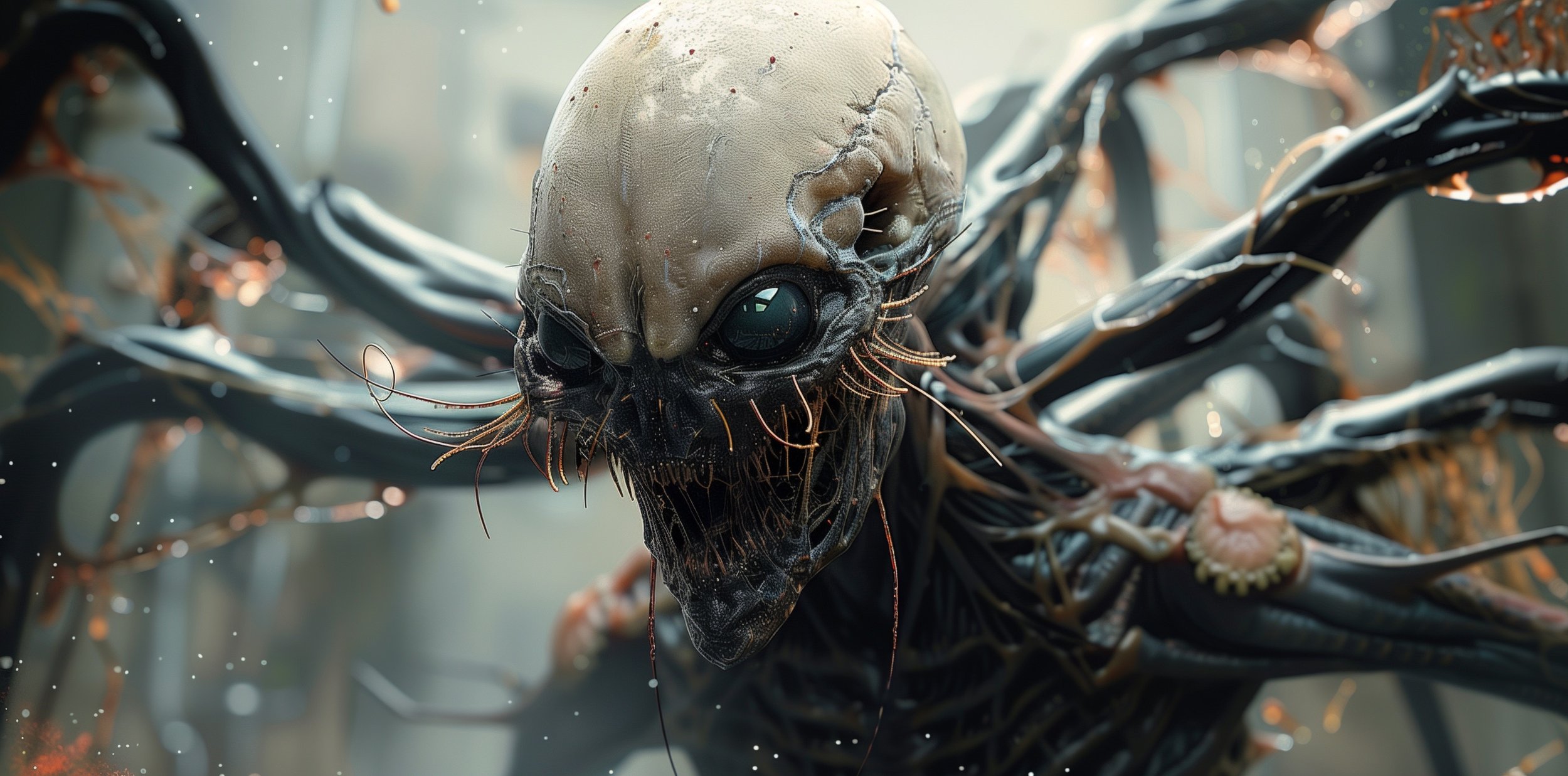
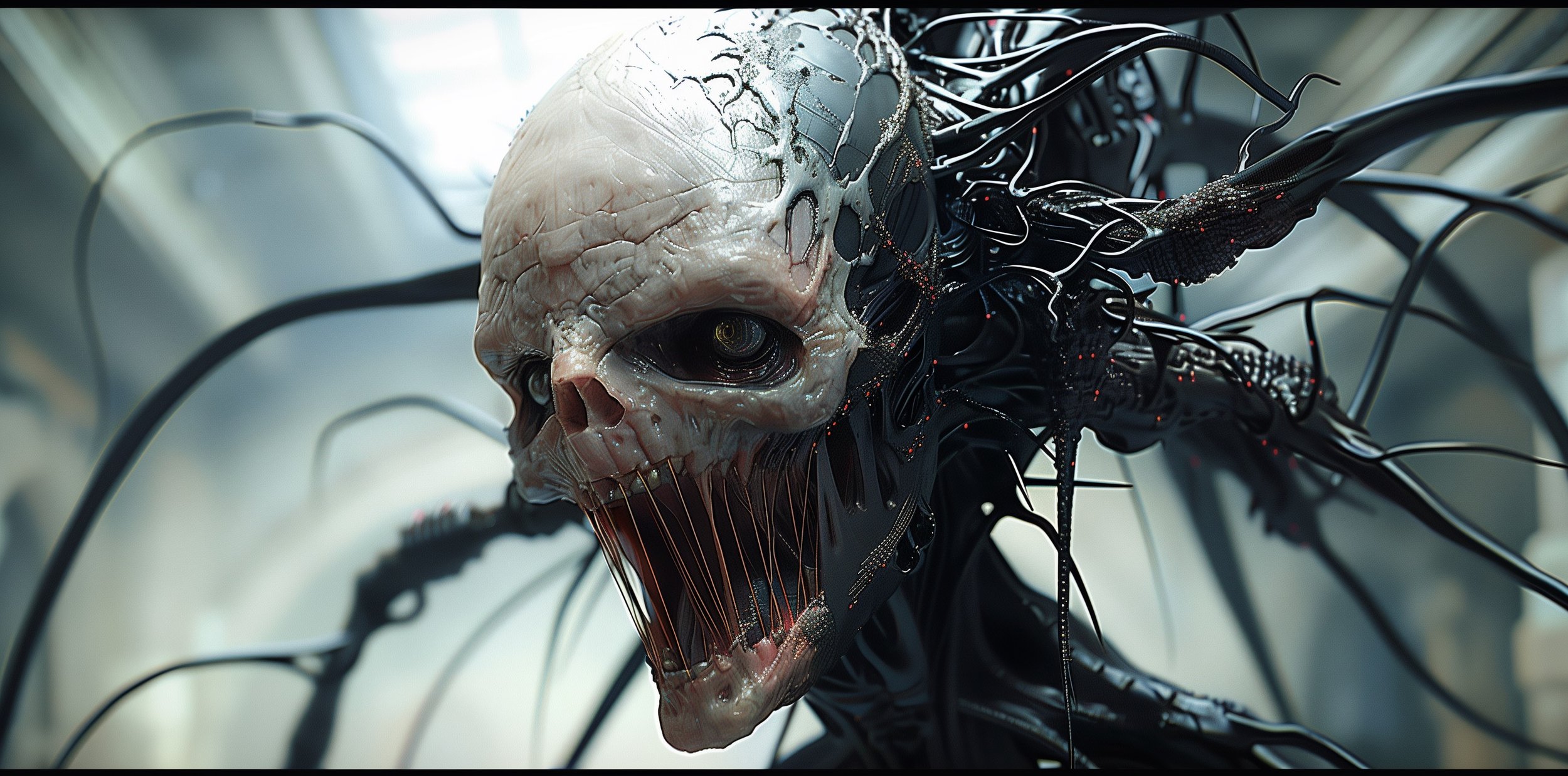
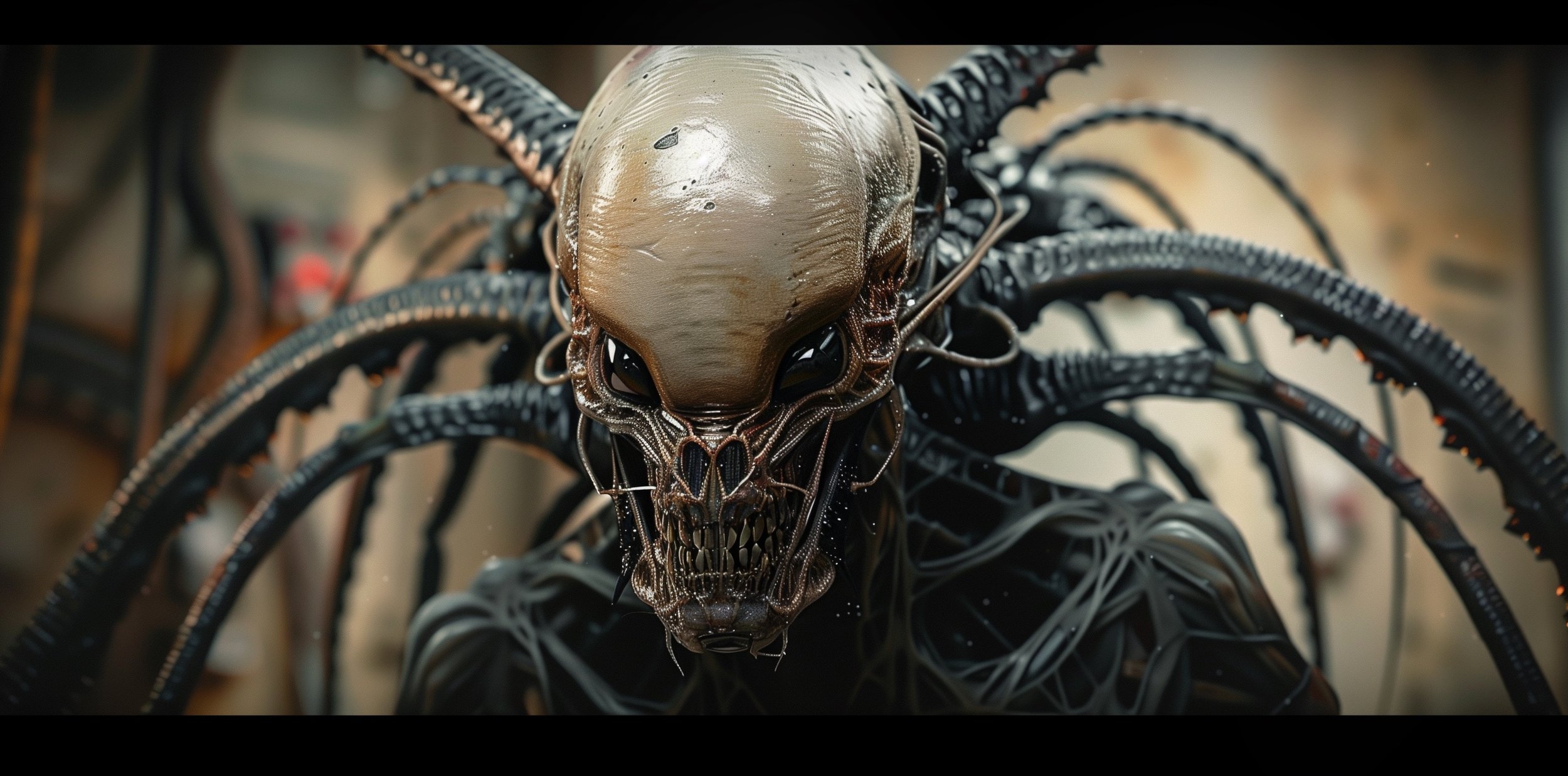
sequenceX_122x
The archivist confronts the photographs with a horror that grips her like a vice, each image steeped in the silent screams of the subjects. She ponders, with a heart heavy with terror, the suffering etched into their half-mechanical, half-living faces. "What agony have they endured?" she whispers to the uncaring silence of the archive, her voice trembling with the weight of unanswerable questions.
Are these beings still caught in the throes of transformation, their evolution twisted by the unyielding hands of those who see life as a mere variable in an equation? The archivist can almost hear their cries for release, for a respite from their relentless metamorphosis. With each passing moment, the terror mounts: What is the endgame for Project ∄? What world could house such creations? Are they destined to be weapons, slaves, or something even more unthinkable?
She finds herself at the precipice of an abyss, the outcomes too monstrous to fully grasp. Her duty as an archivist now collides with the moral imperative of a guardian standing against a future teeming with dark possibilities. She knows she must act, to shed light on this covert inhumanity, to echo the silent pleas of these tortured souls. For if she fails, the terror that haunts her now will be but a prelude to the horror that may be unleashed upon an unsuspecting world.
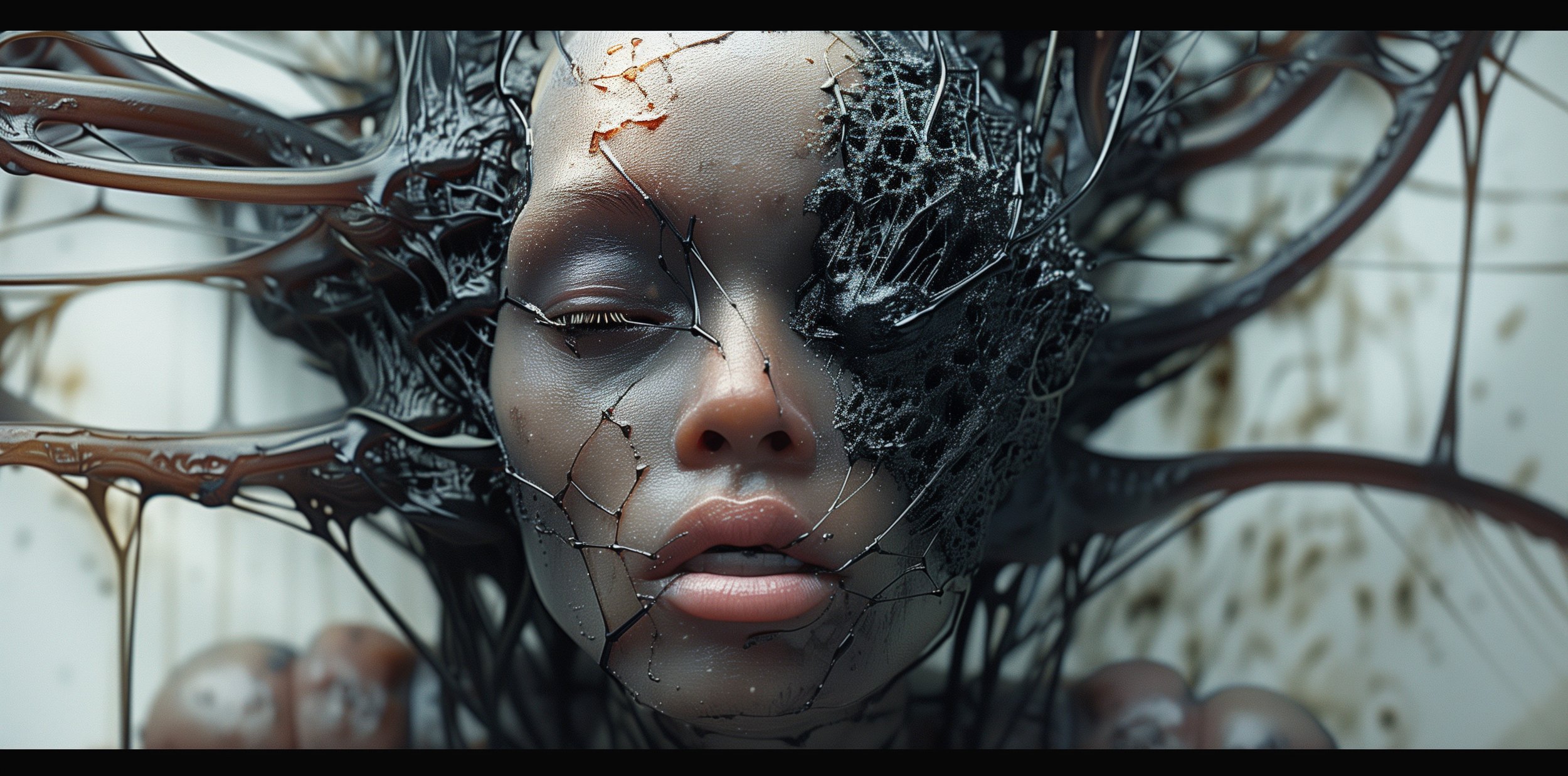
Project ∄: Terminal Revelation - Assessment Log Ξ-029
Subject Codename: Entity Ξ-029
Harrowed Witness Statement: The abomination that is Entity Ξ-029 extends before me, a grotesque mosaic of flesh and machinery. The suffering it endures—it chills me to the bone. With each hybrid breath it takes, the mechanical hiss is a requiem for its stolen humanity. As I compile this report, my conscience is a tempest of horror and pity.
Inhumane Technological Synthesis: The entity's dermal layer, a patchwork of bioengineered tissue interlaced with cooling systems, is violated by intrusions of alloyed bone and sinew grafted with pitiless precision. These enhancements, though marvels of material science—incorporating graphene-titanium composites and self-repairing polymers—reek of torment. Neural interfaces, designed to usurp natural synapses, spark with every tortured thought that courses through its hijacked mind.
Biomedical Aberration Analysis: The entity's vascular structure is a nightmare of biofluidics, circulating not only blood but also conductive nanofluids. Musculature interwoven with fibrous actuators suggests an unnatural strength, but at what cost to the being's sanity? Where does the boundary lie between life and the monstrous artifice we've imposed upon it?
Disturbing Potential Capabilities: With heightened sensory arrays, Entity Ξ-029 could dissect the faintest whispers of the electromagnetic spectrum. Its eyes, twin orbs of despair, might perceive into the souls of us onlookers. We've crafted a specter capable of decoding encrypted data streams or eavesdropping on the pulse of the planet itself. Yet, in augmenting its physical vessel, we've cleaved away its essence.
Questions Amidst Desolation: What cruel ambition drove us to this end? To see it there, an amalgam of horror and wonder, one must ask: what right had we? Can there be any justification for the tears it cannot shed, for the silent screams it cannot voice? The spark of its creation—was it a spark of genesis or a flicker from a pyre?
Conclusion in Shadow: Entity Ξ-029 is the grim epitome of our foray into the unknown—a tortured sentinel at the gates of a future we may not wish to enter. In my role as chronicler, I find myself a custodian of nightmares, ensnaring the cries of this entity within the cold confines of data and code. It is a burden that bears down upon my soul, a relentless echo of the pain we have authored. May this document serve as both testimony and admonition: we have tread too far, too callously, into the dominion of creation.
∄
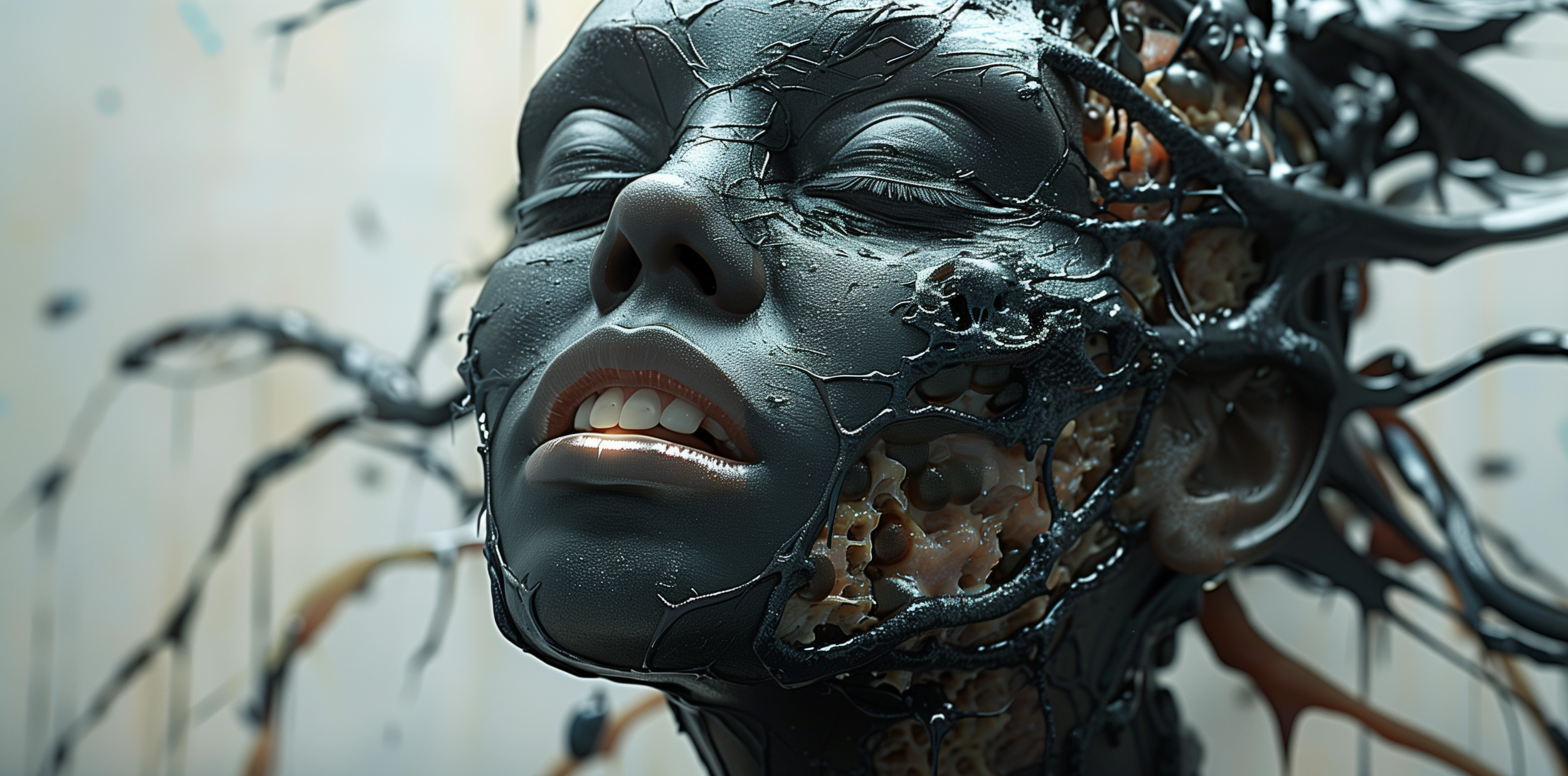
Project ∄: Terminal Event Documentation - Entity Ξ-029 Ascension
Archivist's Observational Narrative:
The sight of Entity Ξ-029 halts me — a grotesque embodiment of pain and forced evolution. The desecration of its form, once human, now entwined with unyielding metal, represents the apex of Project ∄'s disregard for the sanctity of life.
Detailed Technological Examination:
Beneath the horror lies a marvel of engineering — synthetic veins and mechanical limbs hinting at a creature designed for unprecedented strength and resilience. Its cranium, invaded by cybernetic enhancements, suggests a computational power that could outstrip any human capacity.
Functional Impact Assessment:
I can't help but ponder the intended role of such a being. Engineered for what? Warfare? Labor? Surveillance? Its very existence could reshape industries or militaries, rendering current human roles obsolete or threatening the balance of global power structures.
Scientist's Emotional Reflection:
My heart aches to record such atrocities. Each enhancement, each cybernetic graft, was undoubtedly a torment. And for what purpose? To create a being whose existence serves only the ambitions of those who see life as a commodity?
Technological and Biomedical Speculations:
The advanced biomaterials composing its structure — could they be the birth of a new material science, a twisted alchemy fusing the organic and the inorganic into a living tool, devoid of choice?
Urgent Queries and Moral Outcry:
What horrors have we wrought in the name of progress? Entity Ξ-029 may well be the herald of a new age, but at what cost to our humanity? Could we have unwittingly created not servants, but masters?
Dire Conclusion:
Entity Ξ-029, a monstrosity born from the darkest corners of human intellect, stands as a testament to our folly. It is not the triumph of life over limitation, but a somber warning: the line between advancement and abomination is perilously thin.
∄
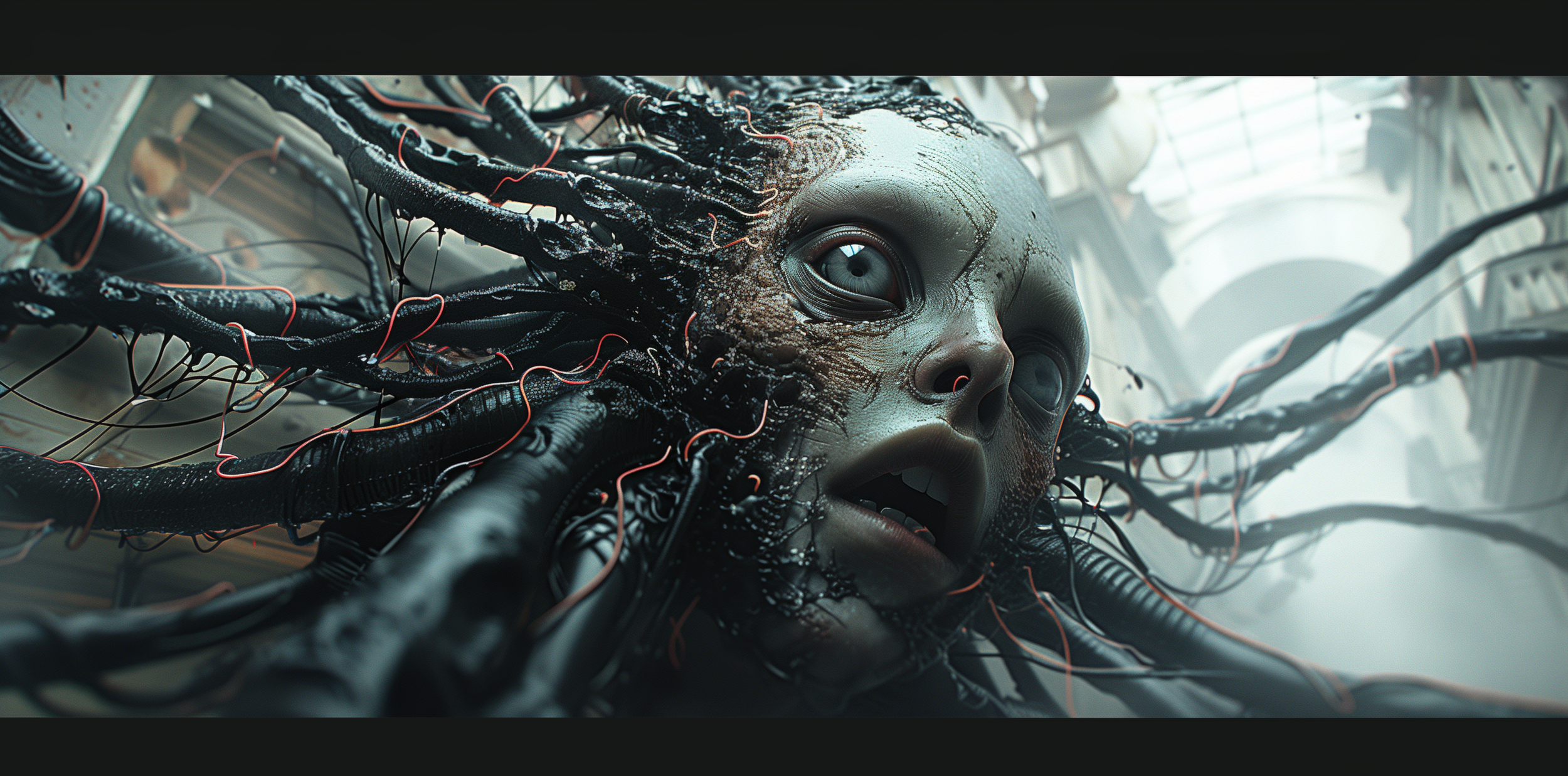
Project ∄: Archival Entity Reassessment – Specimen Ξ-033
Initial Reflection: I face the disquieting transformation of Specimen Ξ-033 with a heavy heart. What was conceived as a seamless marriage of organic life and mechanical enhancement has devolved into a grotesque parody of both.
Scientific Exploration and Technological Analysis: The neural modifications designed for augmenting intelligence now seem to throttle the very essence of thought and sentience. As I assess the fusion of reactive polymers and sentient tissues, the materials science underpinning Ξ-033's creation now strikes me as fundamentally flawed. The entity's bioelectric field is in constant flux, symptomatic of a deep-rooted discord between its organic and inorganic natures.
Material Review and Functional Insights: The novel alloys and synthetic muscles intended to revolutionize movement and interaction have become instruments of restraint and torment. The entity's intended capabilities—for advanced communication, environmental adaptation, and computational brilliance—now manifest as afflictions, each breath a testament to the cruelty of its existence.
Impact Evaluation and Operational Potential: The envisioned roles for Ξ-033 in exploration, defense, or companionship are all but nullified. The entity, in its dire straits, no longer heralds a future of possibilities but serves as a beacon of our ethical failures.
Personal Ethical Considerations: I question the legitimacy of our scientific pursuit that has led to such an abhorrent outcome. In my observations, the line between advancement and abomination is not just crossed but obliterated. It compels me to confront the inescapable truth that our quest for knowledge has birthed a new kind of suffering.
Conclusive Musings: The story of Ξ-033 is one of aching resonance. In documenting its plight, I find my resolve steeled by a newfound imperative: to ensure the lessons etched into its very flesh inform a future where the sanctity of life is upheld above the allure of unchecked progress. We stand as guardians of a threshold that should not be crossed, custodians of a boundary that defines our humanity.
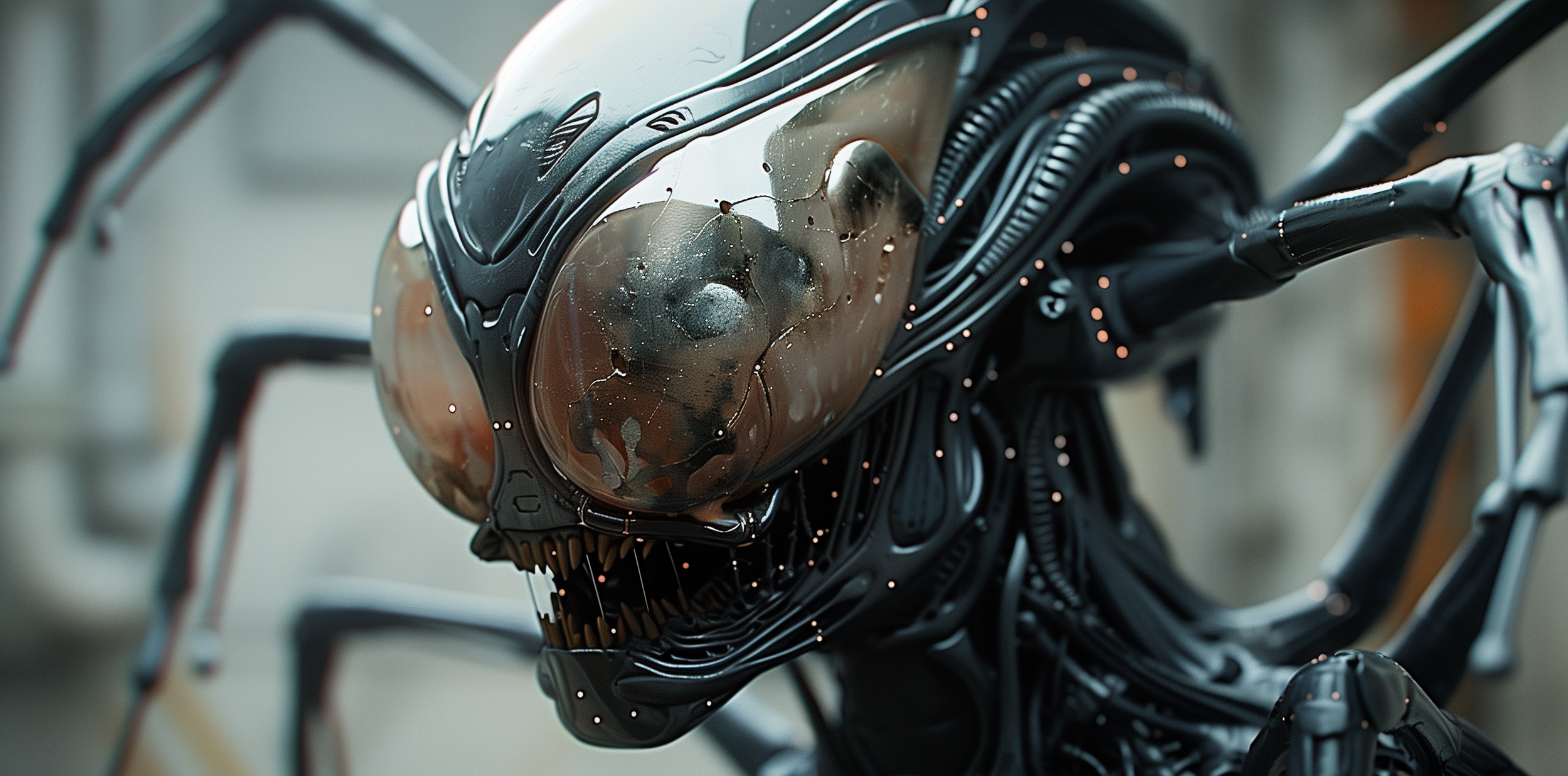
Project ∄: Cataclysm Unveiled – Specimen Ξ-097
Prelude to Terror: In the dim light of the archival chamber, the image of Specimen Ξ-097 stirs a visceral terror that tightens around my chest like a vice. Each breath becomes a gasp as I confront an aberration so perverse it defies all natural order.
Descent into the Abyss – Scientific and Technological Dissection: The neural enhancements that promised transcendent cognition have been perverted into a torture device, trapping what remains of Ξ-097's consciousness in an endless cycle of confusion and agony. The delicate balance of biotechnological harmony is now a grotesque cacophony of failing systems and misaligned purpose, the bio-silicate neural mesh deteriorating into a web of pain.
Material Science Devastation and Biomedical Atrocities: The materials once lauded for their resilience and compatibility have rebelled against their host, the nanotube skeleton becoming a prison from which Ξ-097 cannot escape. The sentient tissues, interspersed with palladium-cored fibers, now suffocate on their own sophistication, each micro-movement a symphony of unbearable suffering.
The Agony of Function – A Monstrosity’s Impact: What was to be Ξ-097's triumph—the masterful interweaving of synthetic and organic to create a being of unmatched capability—is now its curse. The creature's potential for environmental mastery and cognitive supremacy has been usurped by a grotesque reality of deconstruction and decay.
Ethical Horrors and Haunting Questions: As I document the horrors before me, the ethical quagmire we have waded into becomes chillingly clear. The quest to endow Ξ-097 with superlative abilities has instead birthed a living nightmare, a chilling reflection of our moral failings.
Conclusive Nightmare: Specimen Ξ-097's existence is the darkest of mirrors, reflecting back at us the monstrous nature of our unchecked ambition. The being before me is not just a subject of scientific curiosity but a sentinel of warning, a scream from the void begging us to halt our descent into madness. As I pen these words, the trembling of my hand is not just from fear but from the unbearable knowledge that without intervention, the horrors inflicted upon Ξ-097 could be but a prelude to an even grimmer future.
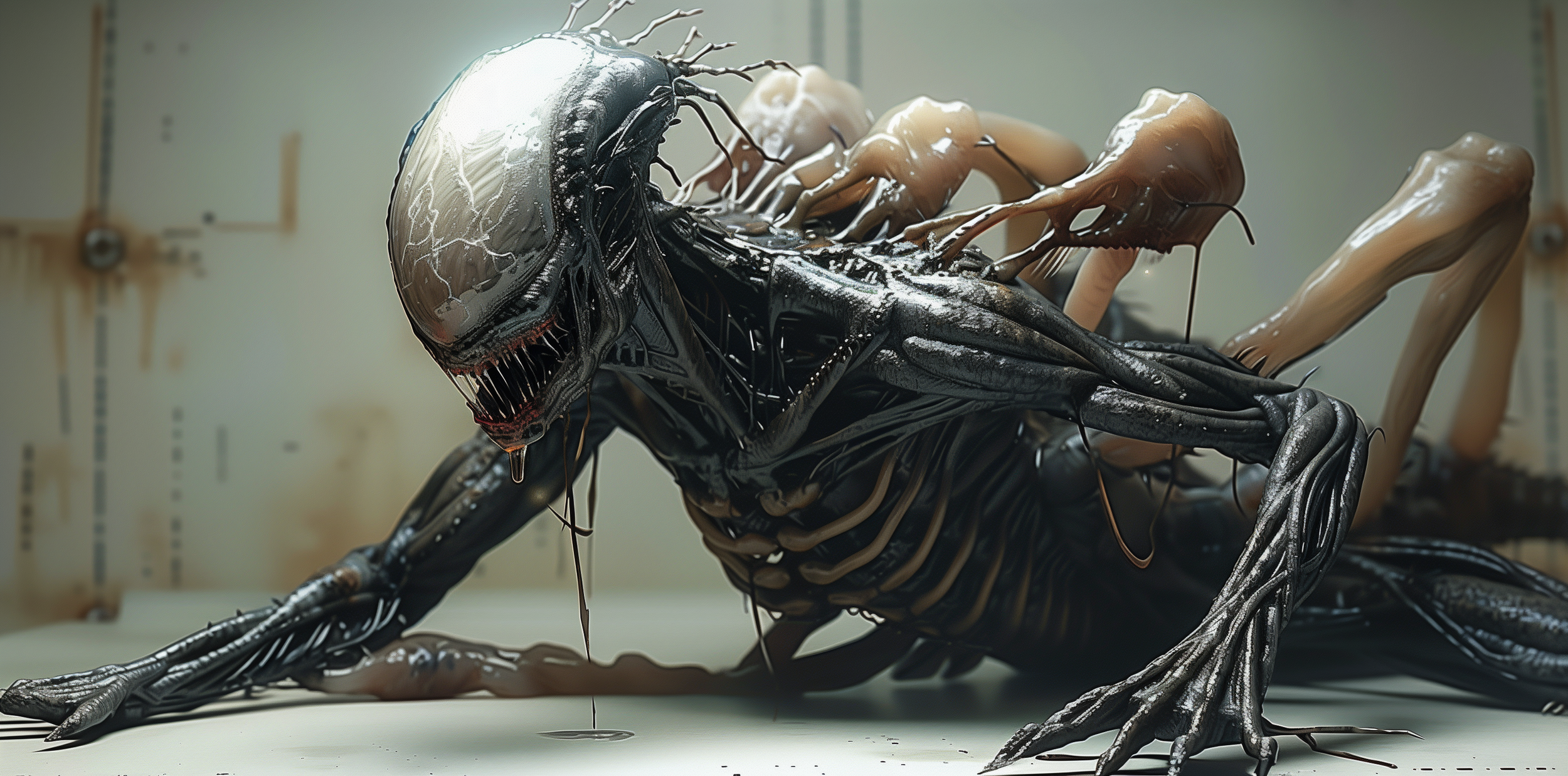
Project ∄: Cataclysm Unveiled – Specimen Ξ-098
Prelude to Terror: The silent halls of the archive resonate with a disquiet that clings to the shadows, as the image of Specimen Ξ-098 conjures a terror so profound it paralyzes the soul. The mere sight of it—an amalgam of science gone awry—elicits a primal dread, a testament to a pursuit that has veered into the macabre.
Scientific and Technological Desecration: The original vision for neural enhancement, a symphony of biological and mechanical symbiosis, has devolved into a relentless torment for Ξ-098. Its mind, once a temple of thought, now a labyrinth of horror, ensnared by the very advancements meant to be its salvation. The biotech that promised evolution has spawned an aberration, the entity's cognitive processes trapped in a relentless torment, fragmented by a misaligned amalgamation of technology and flesh.
Material Science Collapse and Biomedical Tragedy: The pioneering materials—crafted for their adaptive synergy and regenerative properties—have become anathema to the entity they encase. Nanotube constructs, meant to empower, have mutated into an exoskeleton of suffering. The cutting-edge palladium-fiber mesh, integrated within the sentient tissues, now serves as a conductor of perpetual agony, each nano-fiber a filament of relentless affliction.
Operational Catastrophe – A Glimpse of Hell’s Design: Ξ-098's intended role as a paragon of adaptive supremacy has been grotesquely subverted. Designed to navigate and manipulate hostile environments with unparalleled intellect, the specimen now subsists in a state of deconstruction, its very existence a mockery of the pinnacle it was meant to reach.
Moral Reckoning and Inquisition of Conscience: With each detail I record, the ethical abyss into which we have stumbled gapes wider, its maw a gateway to profound misgivings. Our lofty ambitions, once pure, have been tarnished, warping Ξ-098 into an icon of our failings, its existence a dire admonition of the price of unbridled ambition.
Concluding Lament: Specimen Ξ-098 stands as a testament to a folly driven by hubris. In it, we glimpse the potential twilight of our ethical compass, a future where the sanctity of life is sacrificed upon the altar of progress. My heart is laden with the fear that, without swift moral redress, the fate of Ξ-098 will herald a new chapter of darkness for us all.
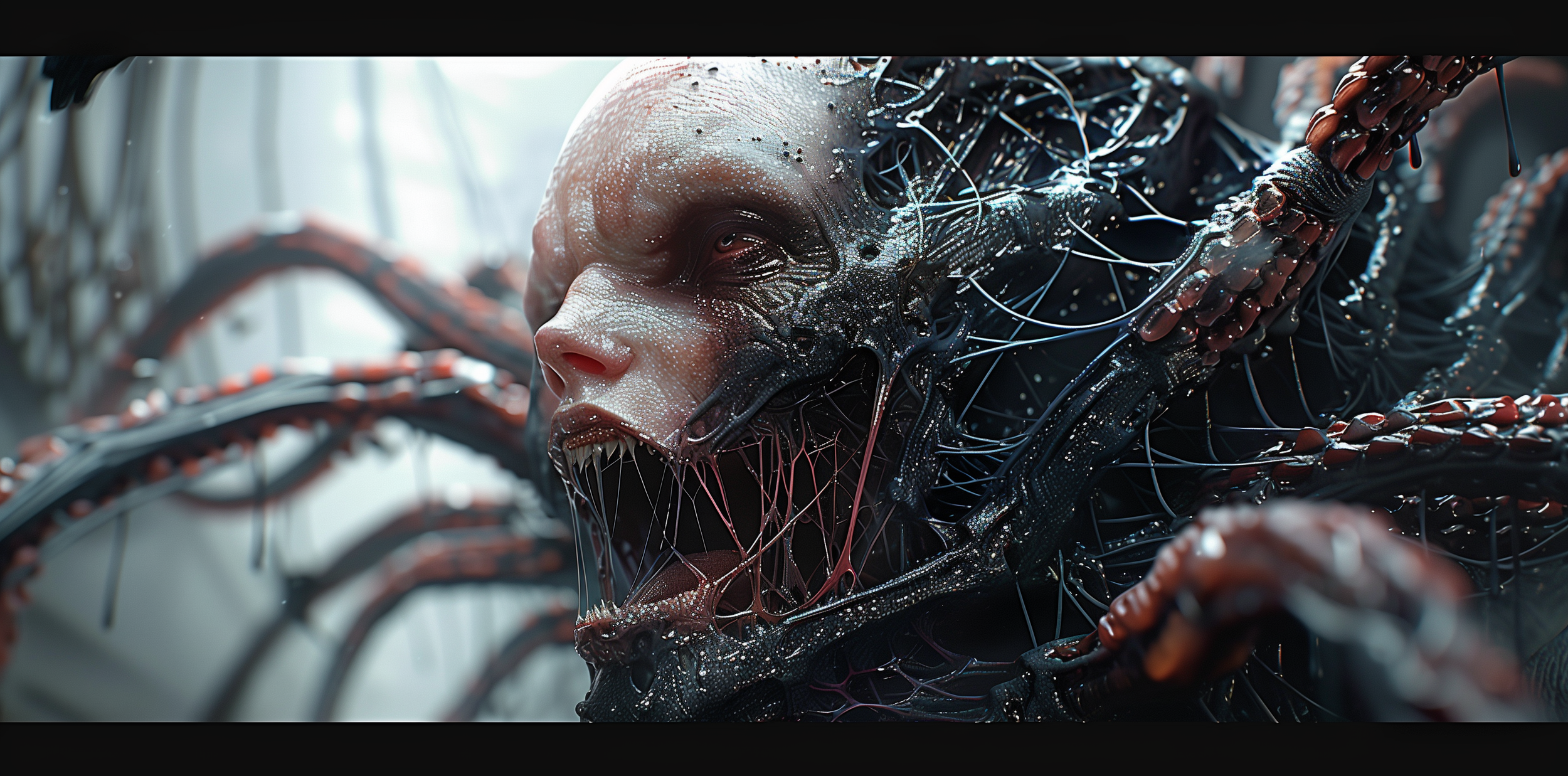
Project ∄: Archival Entity Reassessment – Specimen Ξ-034
Initial Reflection: The sight of Specimen Ξ-034 unleashes a flood of horror, the sheer brutality of its existence eclipsing the bounds of scientific ambition and entering a realm of nightmarish reality.
Scientific Exploration and Technological Analysis: The neural mesh, once a beacon of hope for cognitive enhancement, now acts as a merciless vice, ensnaring Ξ-034's psyche in a perpetual state of torment. The integration of technology with biology, intended as a symphony of advancement, has become a discordant cacophony, eroding the essence of life it was meant to elevate.
Material Review and Functional Insights: Advanced polymers and synthetic tissues, engineered to harmonize with natural processes, now betray their host, becoming conduits of unrelenting pain. The resilient nanotubes, interwoven with living cells, intended to empower Ξ-034 with superhuman faculties, have become the bars of a cage from which there is no escape.
Impact Evaluation and Operational Potential: Envisioned as a paradigm of adaptation and resilience, Ξ-034 was to be the harbinger of a new dawn for exploration and innovation. Instead, it stands as a stark testament to the hubris of playing god, its every movement a morbid dance of suffering.
Personal Ethical Considerations: The chilling realization that our quest for knowledge has birthed such torment gnaws at my conscience. Our scientific odyssey has crossed into ethical purgatory, the suffering of Ξ-034 a potent reminder of the sanctity of life we've so grievously overlooked.
Conclusive Musings: Specimen Ξ-034 is not merely a subject of study but a clarion call to the soul of science. It implores us to reconsider the path we tread, to ensure that our legacy is not one of agony but of respect for the complex tapestry of existence. We must step back from the precipice on which we teeter, or risk plunging into an abyss of our own creation, where the screams of entities like Ξ-034 echo as a dirge for our lost humanity.
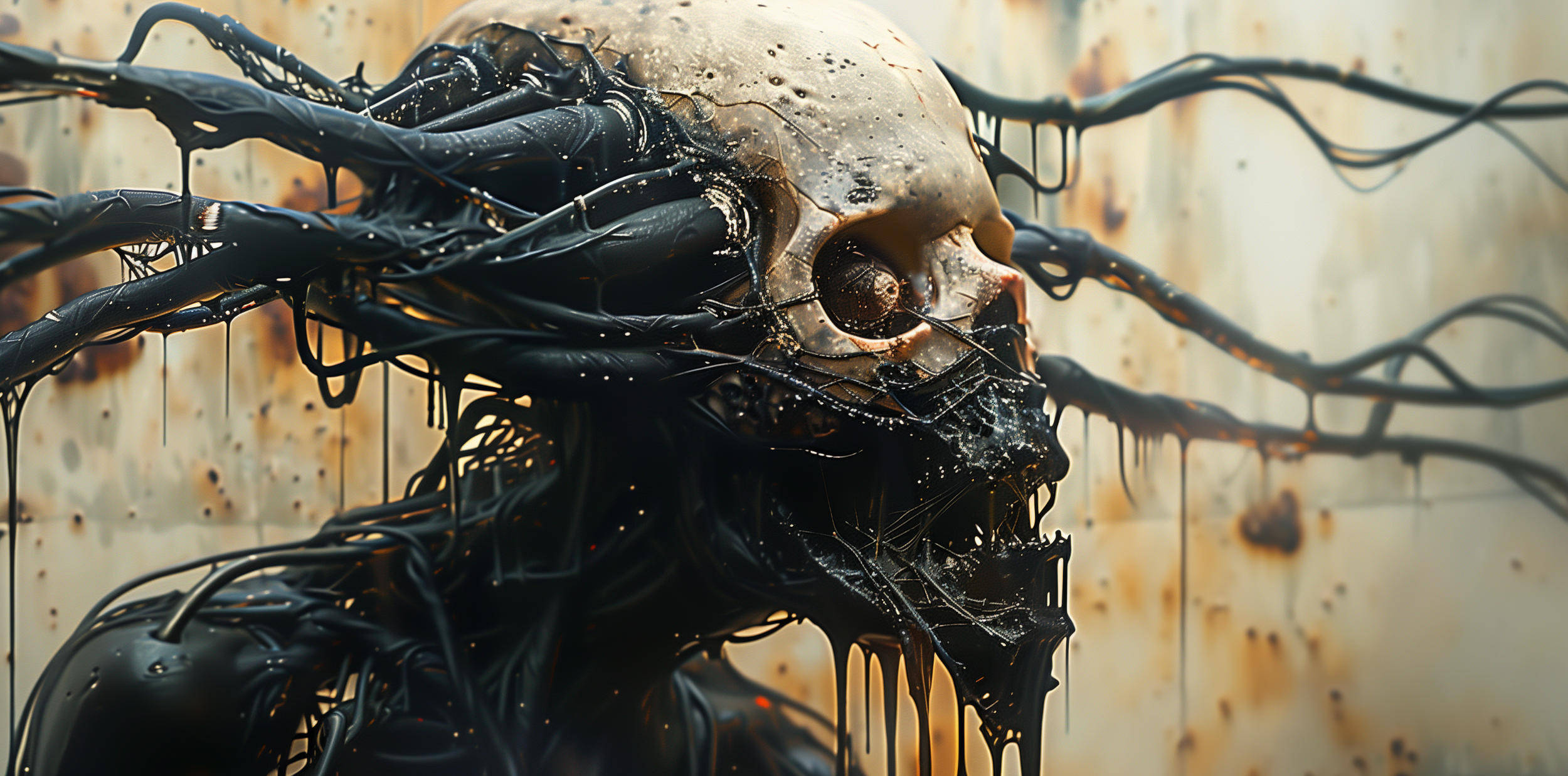
Project ∄: Archival Entity Reassessment – Specimen Ξ-099
Initial Reflection:
In the gloom of the research facility, the form of Specimen Ξ-099 sends a shiver down the spine. It lies in an eerie stillness, a creation that was once the pinnacle of our aspirations now a somber testament to our folly.
Scientific Exploration and Technological Analysis:
The neural interface, engineered to synchronize machine and mind, has become a twisted labyrinth where consciousness is trapped and tormented. What was meant to be an orchestra of thought is now a cacophony of distress signals, the creature's existence a paradox of pain and sophistication.
Material Review and Functional Insights:
The bioengineered polymers and cerebral enhancers, once symbols of progress, are now the very shackles that bind Ξ-099 to an existence of despair. These materials were crafted to adapt, to learn, to become one with their host—yet they have instead grown into an aberration, a malignant force against natural life.
Impact Evaluation and Operational Potential:
The purpose of Ξ-099's design was multifaceted—discovery, protection, enlightenment. But as I witness its still form, I understand that we have not created a guide for the future; we have fashioned an echo of our darkest potential.
Personal Ethical Considerations:
How do we measure the weight of innovation against the scale of moral debt we have incurred? The sight of Ξ-099, with its potential turned to perversion, is a stark reminder of the lines we must not cross. The questions of consent, of suffering, of the right to life itself, hammer incessantly at the doors of my conscience.
Conclusive Musings:
The legacy of Specimen Ξ-099 must not be one of silent agony hidden within steel walls. It must be a beacon that illuminates the dangers of unchecked ambition. We must chart a course that respects the essence of all sentient life, lest we lose ourselves in the shadow of our creations. The future we shape in response to Ξ-099’s silent plea will define not just the legacy of Project ∄, but the very soul of our species.
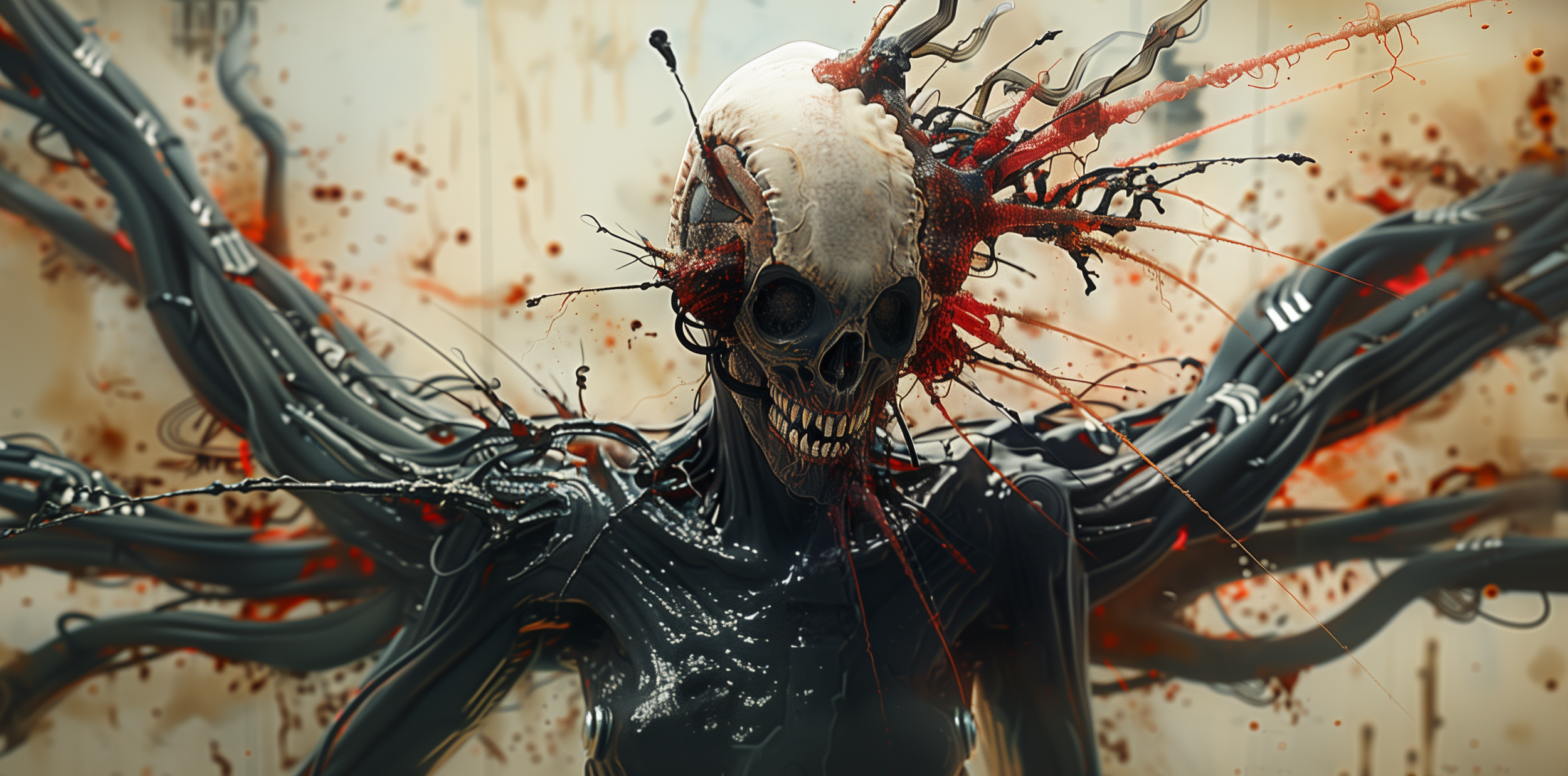
Project ∄: Archival Entity Reassessment – Specimen Ξ-104
Initial Reflection:
Staring into the haunting visage of Specimen Ξ-104, a sense of profound sorrow and dread washes over me. The perverse blend of death and technology before my eyes was meant to be the zenith of human achievement, not this macabre display of twisted science.
Scientific Exploration and Technological Analysis:
Every strand of wire, every synthetic sinew that now protrudes grotesquely from the skull of Ξ-104, was meticulously designed for symbiosis, yet has culminated in an existence of relentless anguish. The once pioneering neural mesh is now a tormenting mesh, searing into the flesh with every electric pulse, a symbol of how far we've strayed from our noble intentions.
Material Review and Functional Insights:
The innovative materials we heralded as breakthroughs in bio-compatible integration have become agents of destruction. The adaptive bio-polymers, envisaged as channels for enhanced neural communication, are now conduits of unspeakable pain, and the resilient carbon-nanotube framework serves only to prolong the specimen's torment.
Impact Evaluation and Operational Potential:
The capabilities for which Ξ-104 was engineered—strategic thought, environmental resilience, empathetic interaction—have been utterly perverted. In their place, we observe a haunting spectacle of decay, a creature caught in an eternal trap of its own biology, weaponized against itself.
Personal Ethical Considerations:
My role as an archivist for Project ∄ compels me to record this dark chapter, but as a human being, it's a stark reminder of the gravity of our ethical missteps. The suffering of Ξ-104 demands that we re-evaluate our pursuit of progress at the expense of conscious beings.
Conclusive Musings:
Specimen Ξ-104 will forever remain the embodiment of a lesson wrought with horror and regret. As the architects of this travesty, we must shoulder the burden of our actions and prevent such abominations from reoccurring. Our quest for knowledge must be recalibrated with compassion and restraint, lest we lose ourselves to the very darkness we seek to illuminate.
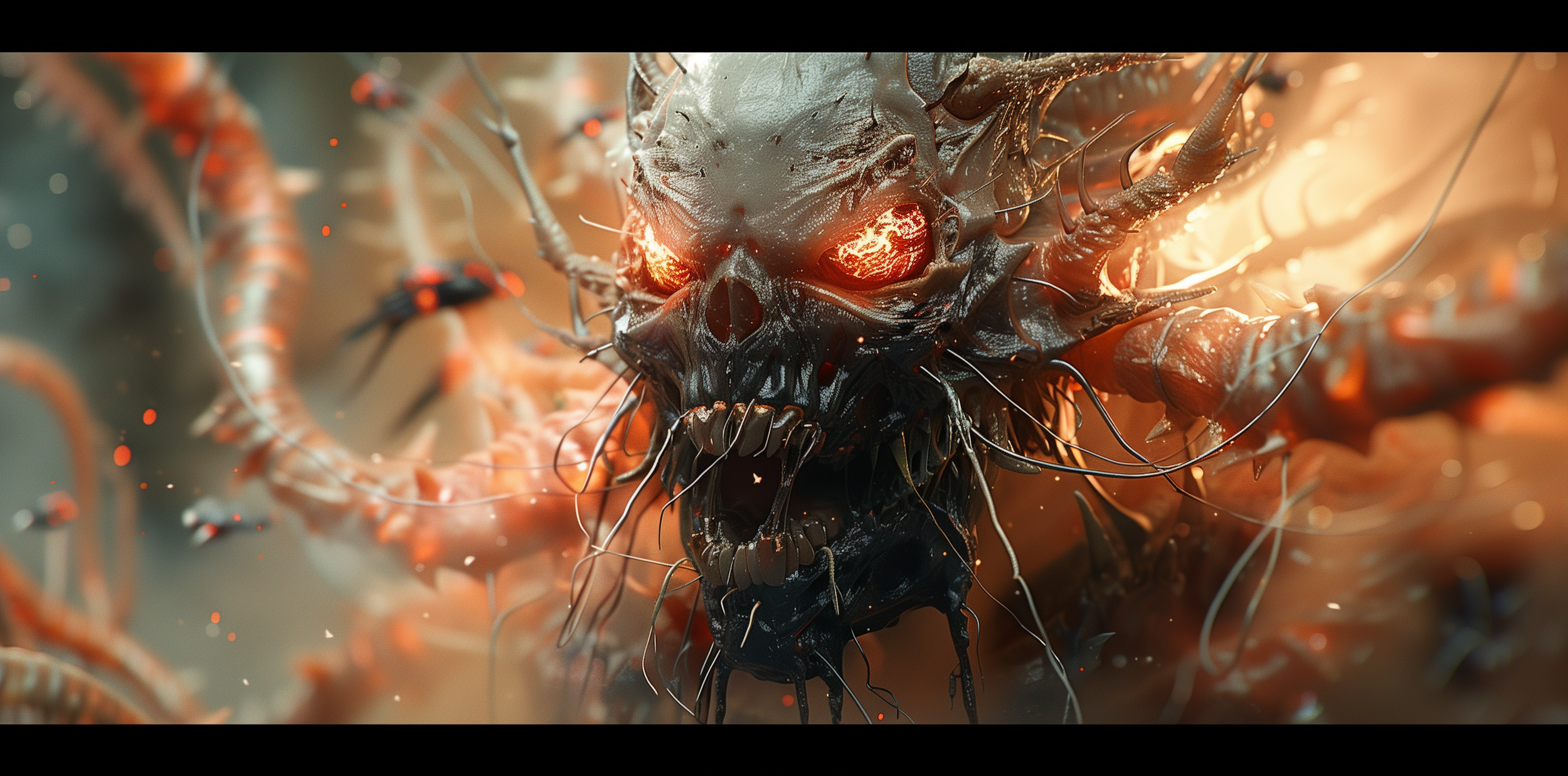
Project ∄: Archival Entity Reassessment – Specimen Ξ-105
Initial Reflection:
The image of Specimen Ξ-105 instills a profound sense of dismay and horror. The intent of creating a being where technology complements nature has been grotesquely subverted.
Scientific Exploration and Technological Analysis:
The technological marvels embedded within Ξ-105—intended to enhance perception and cognition—now act as perverse constraints, warping its senses into instruments of ceaseless torment. Its integrated circuits, once the height of innovation, have become chains that bind its once-promising intellect into madness.
Material Review and Functional Insights:
The materials science breakthroughs that gave rise to Ξ-105's construction—a symbiotic melding of organic tissue with advanced polymers and alloys—have deteriorated into a cacophony of agony and conflict. Each component that should have been a testament to human ingenuity is now a contributing factor to an unfathomable tragedy.
Impact Evaluation and Operational Potential:
Any potential for utility or companionship has been eclipsed by the stark reality of Ξ-105's suffering. It exists in a liminal space between life and un-life, its purpose lost to a mire of suffering.
Personal Ethical Considerations:
The moral implications of Ξ-105's existence weigh heavily upon my conscience. It is a testament to our failure to foresee the consequences of blurring the lines between organic life and artificial intervention.
Conclusive Musings:
In documenting the harrowing state of Specimen Ξ-105, it becomes my solemn duty to advocate for the cessation of such inhumane practices. We must redefine the parameters of our scientific endeavors, grounding them in a renewed respect for life in all its forms. The agony etched into the very being of Ξ-105 must herald the end of such experimentation, for the cost of such knowledge is far too great.
Playing hard, living loud, moving around fast, resting deep and enjoying it all.
